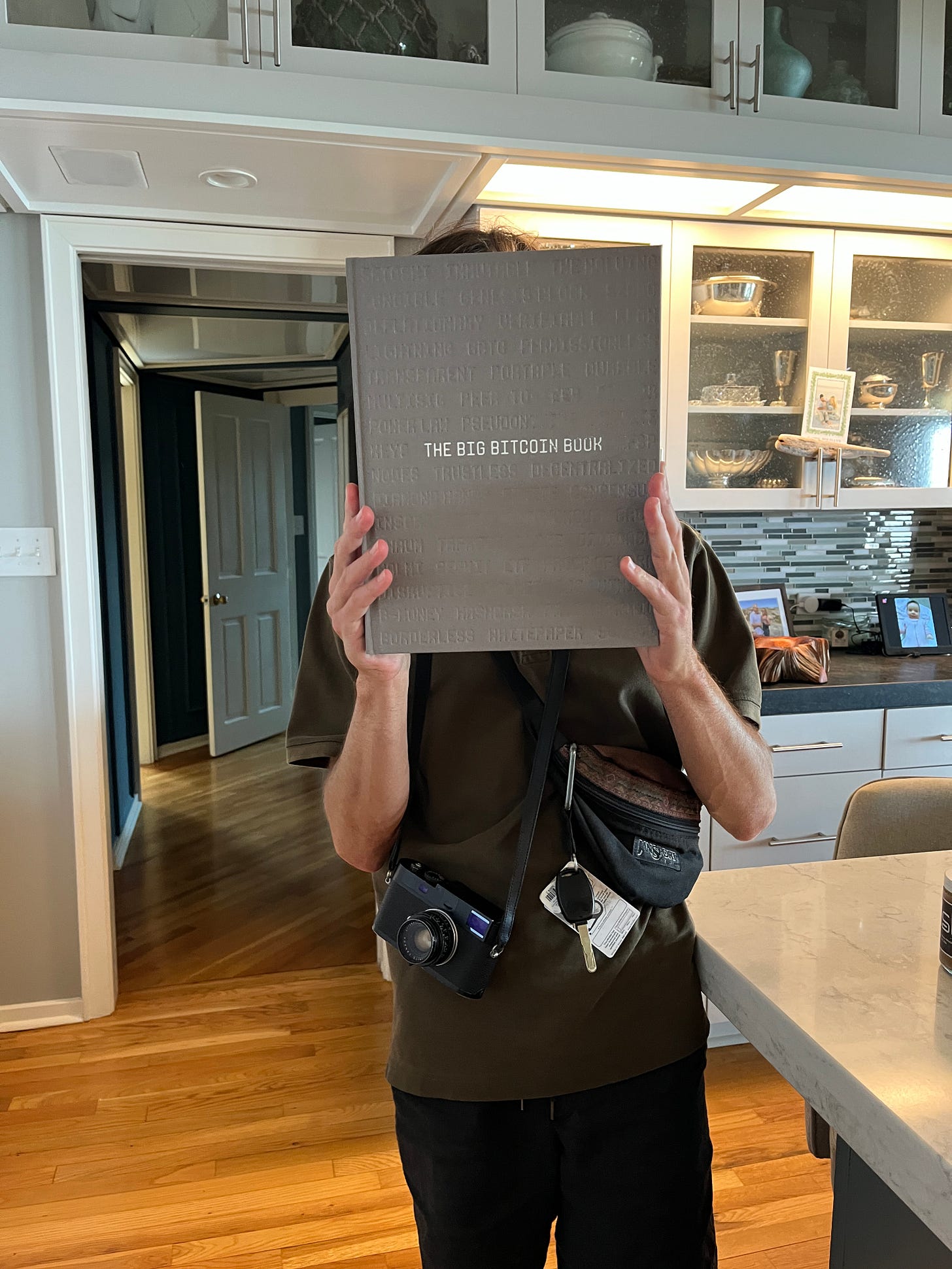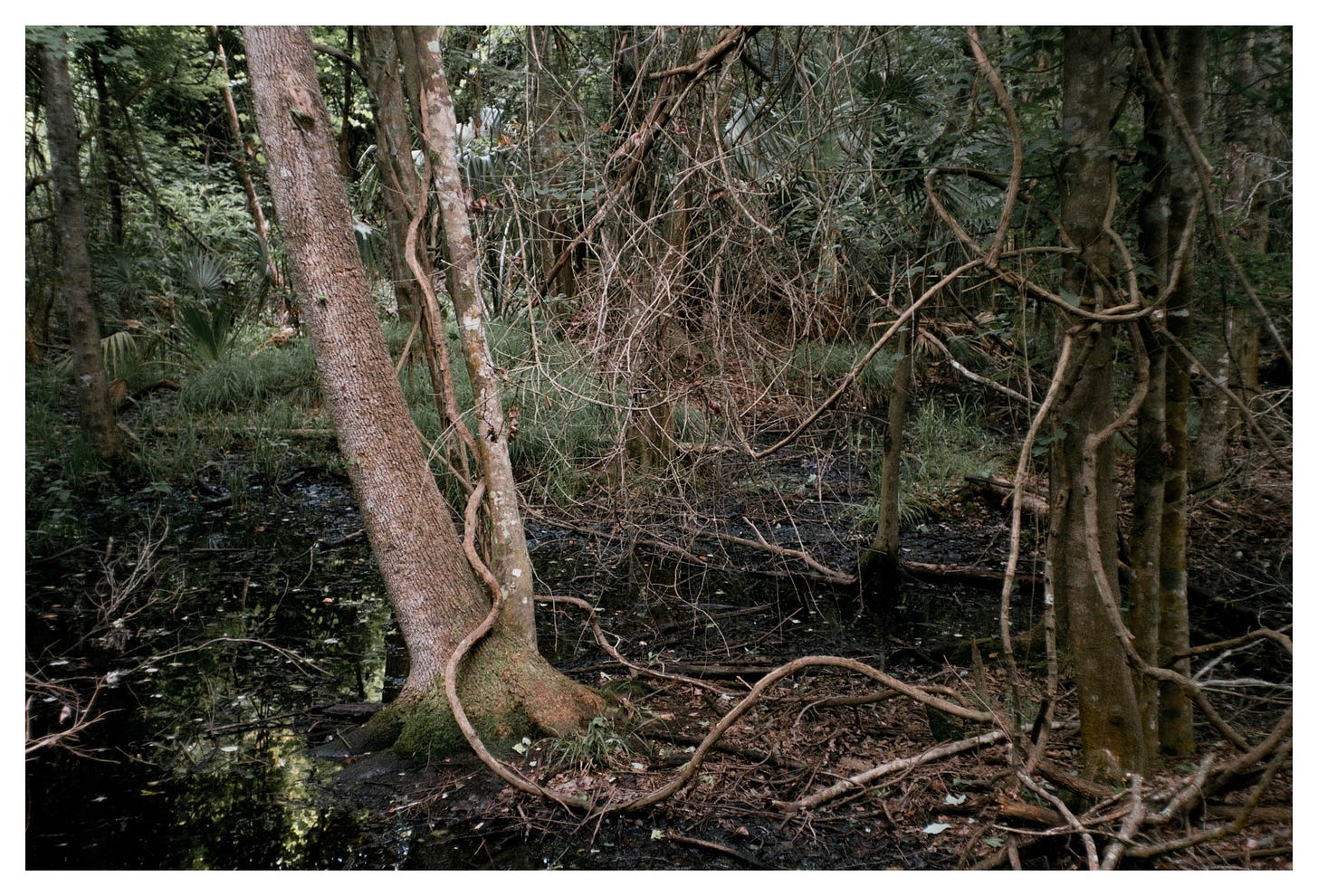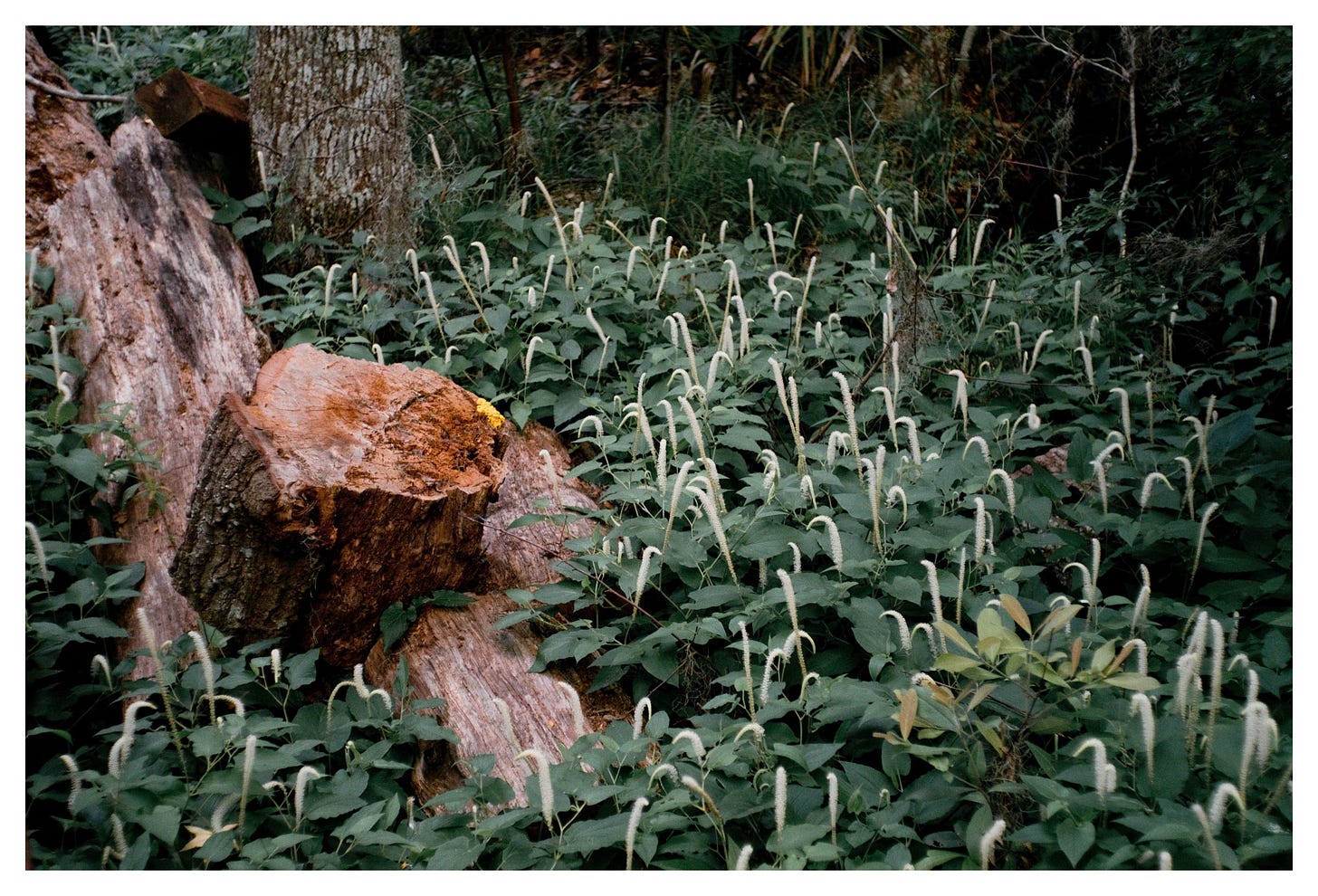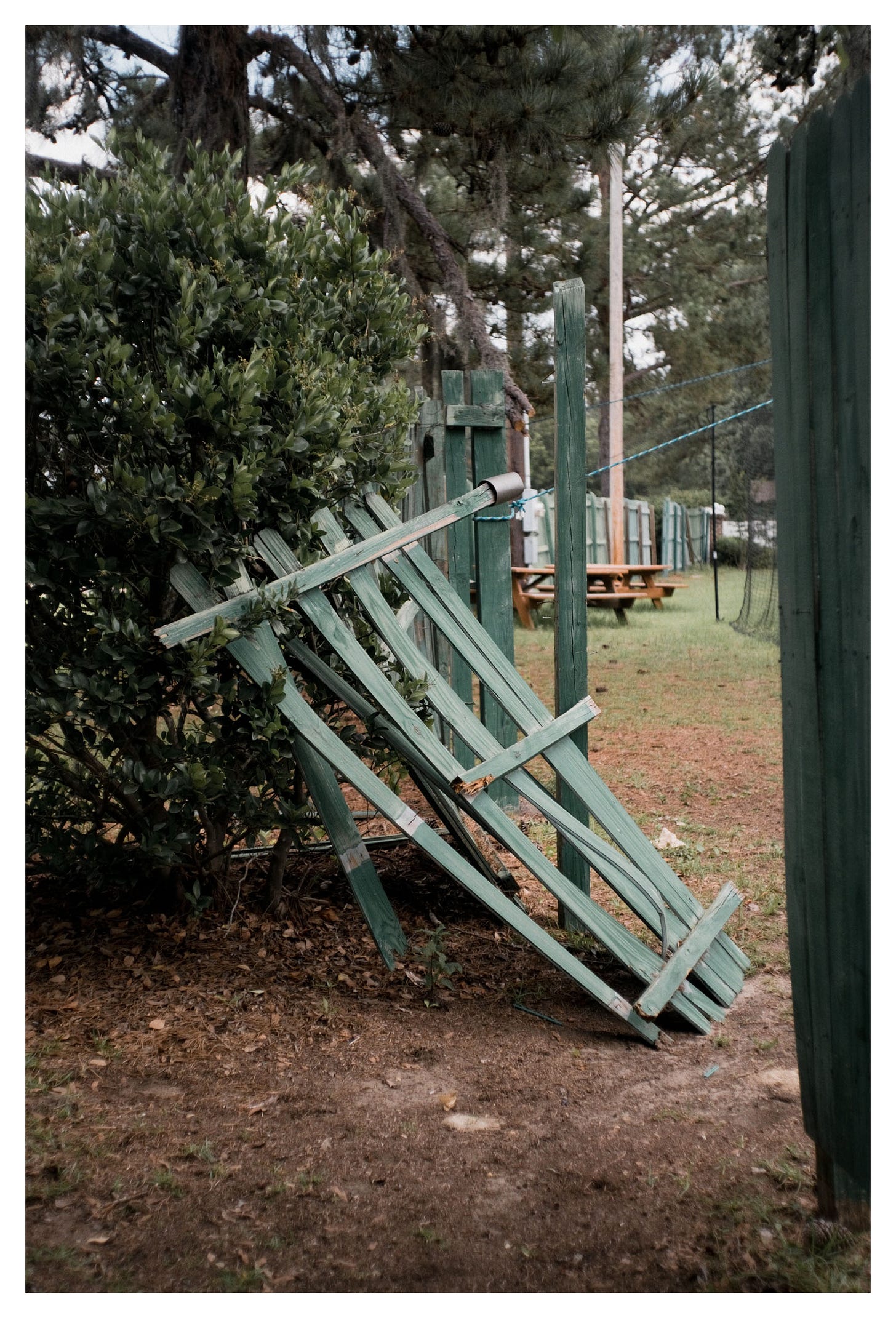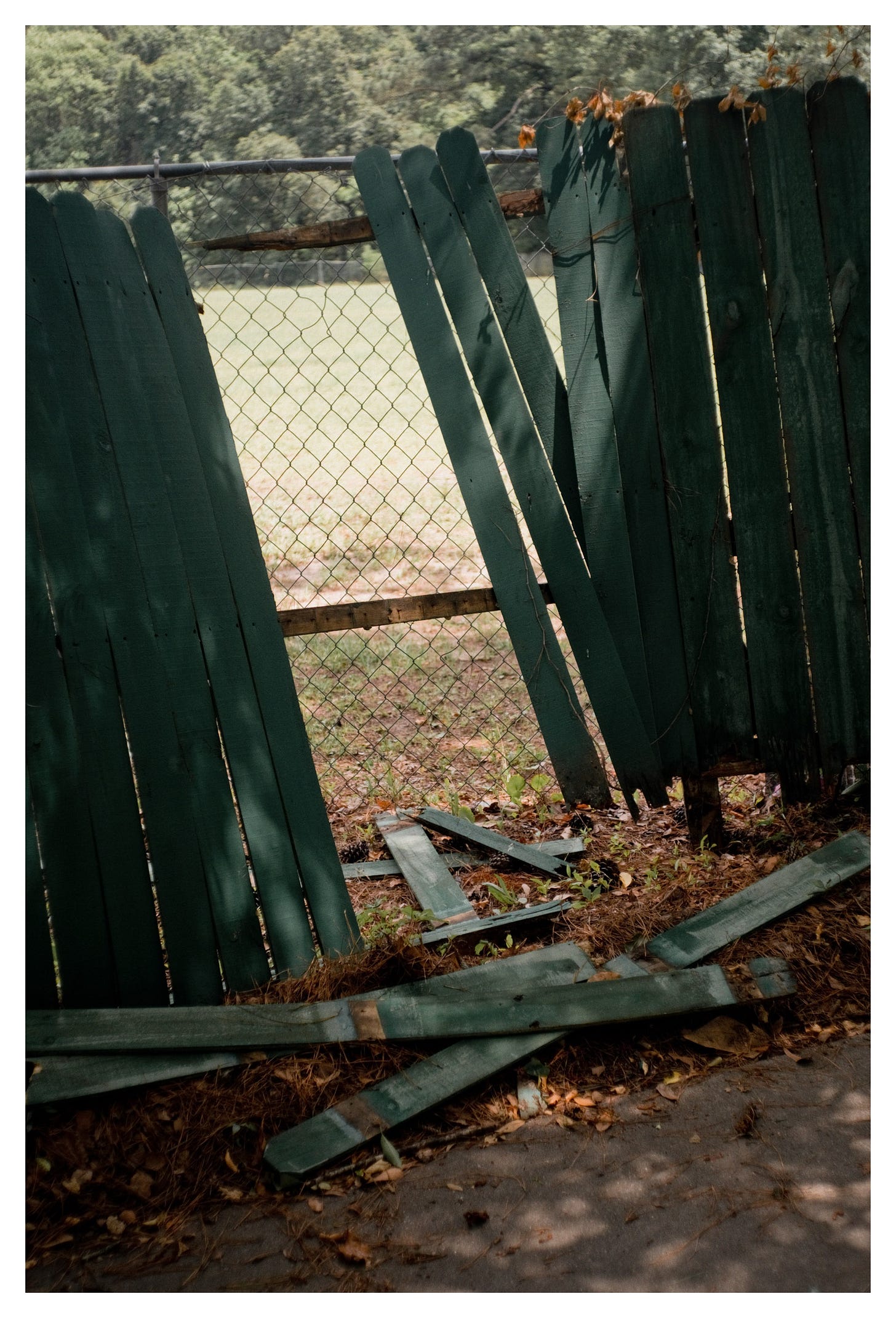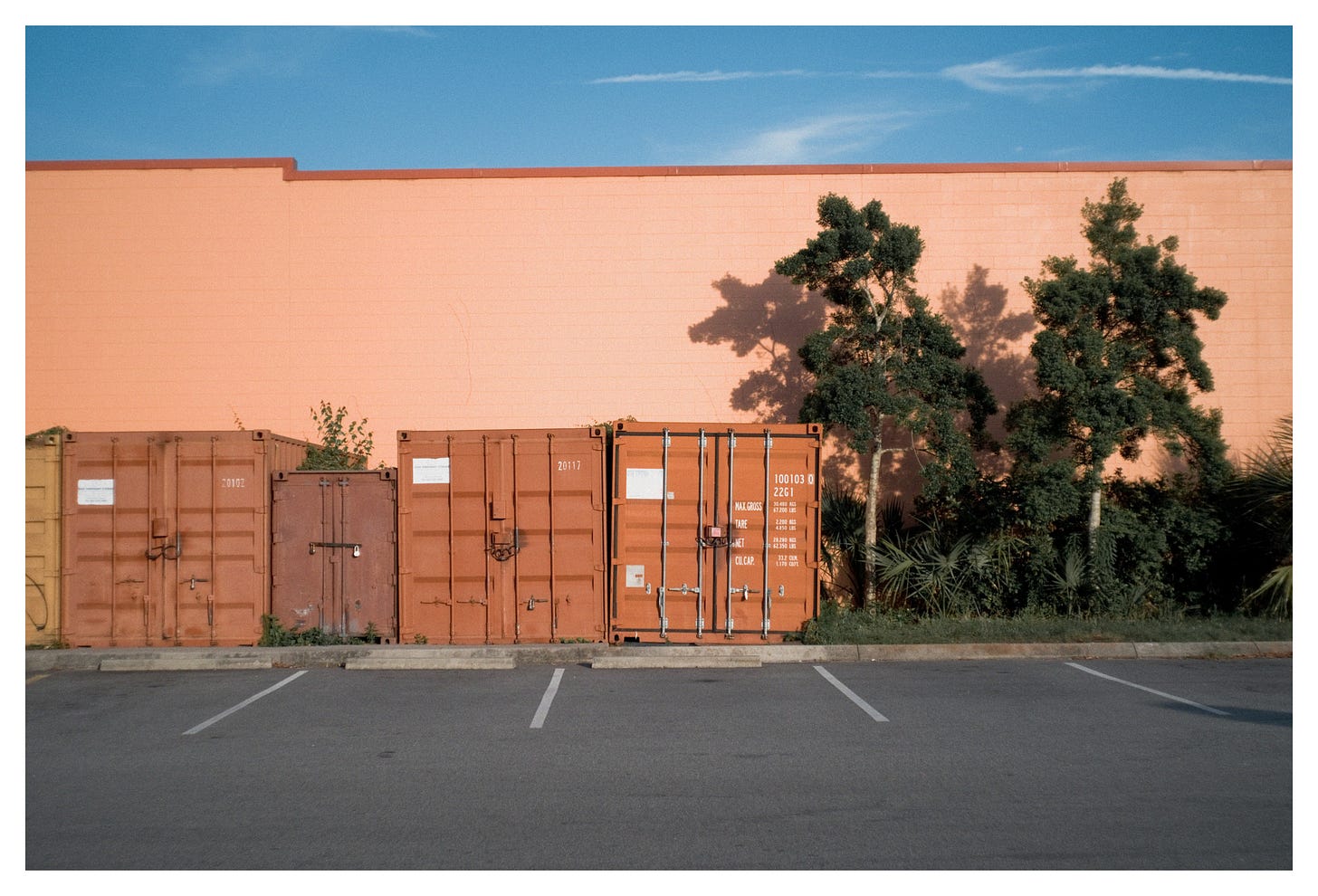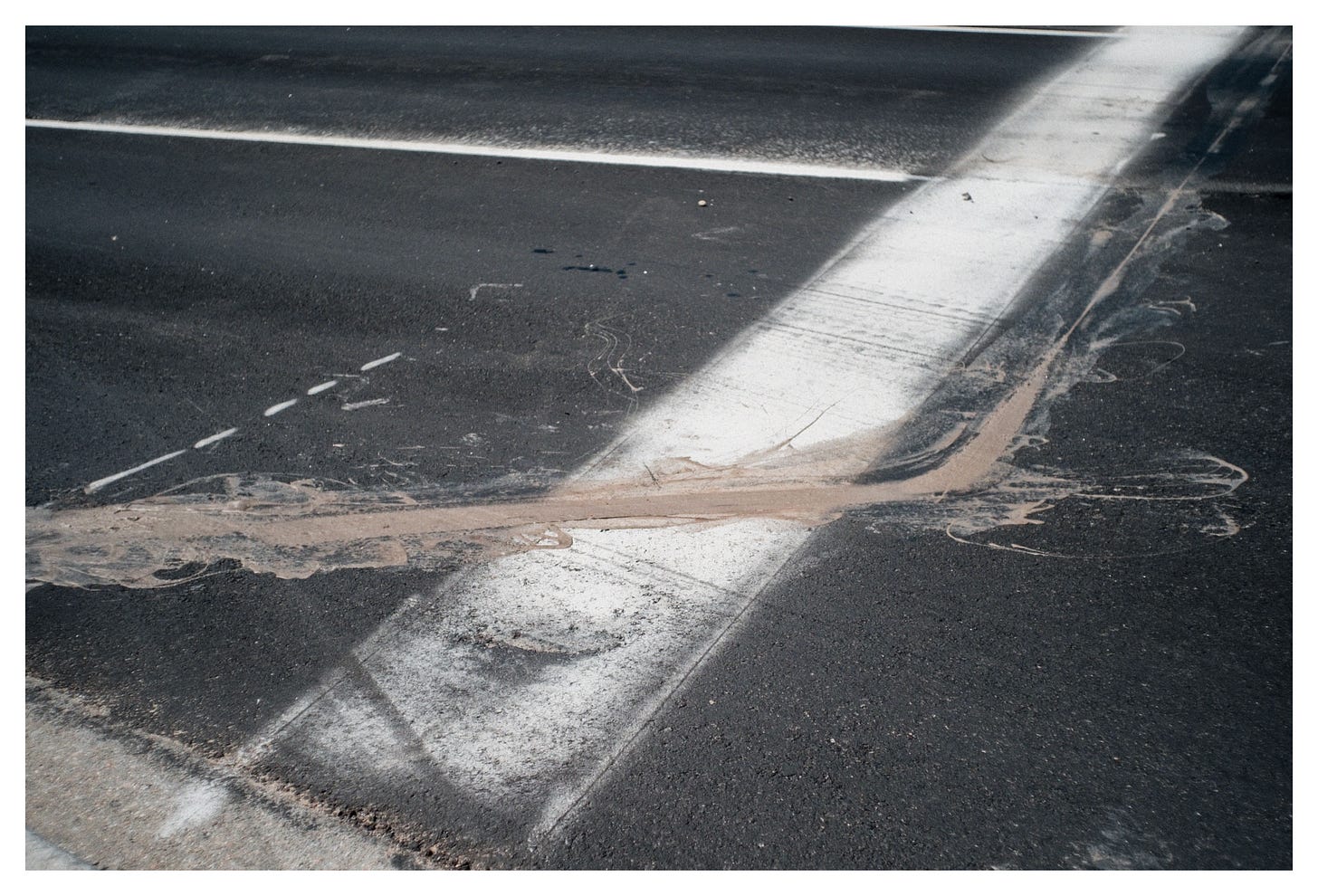-
 @ 7f6db517:a4931eda
2025-05-29 12:03:19
@ 7f6db517:a4931eda
2025-05-29 12:03:19
What is KYC/AML?
- The acronym stands for Know Your Customer / Anti Money Laundering.
- In practice it stands for the surveillance measures companies are often compelled to take against their customers by financial regulators.
- Methods differ but often include: Passport Scans, Driver License Uploads, Social Security Numbers, Home Address, Phone Number, Face Scans.
- Bitcoin companies will also store all withdrawal and deposit addresses which can then be used to track bitcoin transactions on the bitcoin block chain.
- This data is then stored and shared. Regulations often require companies to hold this information for a set number of years but in practice users should assume this data will be held indefinitely. Data is often stored insecurely, which results in frequent hacks and leaks.
- KYC/AML data collection puts all honest users at risk of theft, extortion, and persecution while being ineffective at stopping crime. Criminals often use counterfeit, bought, or stolen credentials to get around the requirements. Criminals can buy "verified" accounts for as little as $200. Furthermore, billions of people are excluded from financial services as a result of KYC/AML requirements.
During the early days of bitcoin most services did not require this sensitive user data, but as adoption increased so did the surveillance measures. At this point, most large bitcoin companies are collecting and storing massive lists of bitcoiners, our sensitive personal information, and our transaction history.
Lists of Bitcoiners
KYC/AML policies are a direct attack on bitcoiners. Lists of bitcoiners and our transaction history will inevitably be used against us.
Once you are on a list with your bitcoin transaction history that record will always exist. Generally speaking, tracking bitcoin is based on probability analysis of ownership change. Surveillance firms use various heuristics to determine if you are sending bitcoin to yourself or if ownership is actually changing hands. You can obtain better privacy going forward by using collaborative transactions such as coinjoin to break this probability analysis.
Fortunately, you can buy bitcoin without providing intimate personal information. Tools such as peach, hodlhodl, robosats, azteco and bisq help; mining is also a solid option: anyone can plug a miner into power and internet and earn bitcoin by mining privately.
You can also earn bitcoin by providing goods and/or services that can be purchased with bitcoin. Long term, circular economies will mitigate this threat: most people will not buy bitcoin - they will earn bitcoin - most people will not sell bitcoin - they will spend bitcoin.
There is no such thing as KYC or No KYC bitcoin, there are bitcoiners on lists and those that are not on lists.
If you found this post helpful support my work with bitcoin.

-
 @ dfa02707:41ca50e3
2025-05-29 12:03:15
@ dfa02707:41ca50e3
2025-05-29 12:03:15Contribute to keep No Bullshit Bitcoin news going.
- The latest firmware updates for COLDCARD devices introduce two major features: COLDCARD Co-sign (CCC) and Key Teleport between two COLDCARD Q devices using QR codes and/or NFC with a website.

What's new
- COLDCARD Co-Sign: When CCC is enabled, a second seed called the Spending Policy Key (Key C) is added to the device. This seed works with the device's Main Seed and one or more additional XPUBs (Backup Keys) to form 2-of-N multisig wallets.
- The spending policy functions like a hardware security module (HSM), enforcing rules such as magnitude and velocity limits, address whitelisting, and 2FA authentication to protect funds while maintaining flexibility and control, and is enforced each time the Spending Policy Key is used for signing.
- When spending conditions are met, the COLDCARD signs the partially signed bitcoin transaction (PSBT) with the Main Seed and Spending Policy Key for fund access. Once configured, the Spending Policy Key is required to view or change the policy, and violations are denied without explanation.
"You can override the spending policy at any time by signing with either a Backup Key and the Main Seed or two Backup Keys, depending on the number of keys (N) in the multisig."
-
A step-by-step guide for setting up CCC is available here.
-
Key Teleport for Q devices allows users to securely transfer sensitive data such as seed phrases (words, xprv), secure notes and passwords, and PSBTs for multisig. It uses QR codes or NFC, along with a helper website, to ensure reliable transmission, keeping your sensitive data protected throughout the process.
- For more technical details, see the protocol spec.
"After you sign a multisig PSBT, you have option to “Key Teleport” the PSBT file to any one of the other signers in the wallet. We already have a shared pubkey with them, so the process is simple and does not require any action on their part in advance. Plus, starting in this firmware release, COLDCARD can finalize multisig transactions, so the last signer can publish the signed transaction via PushTX (NFC tap) to get it on the blockchain directly."
- Multisig transactions are finalized when sufficiently signed. It streamlines the use of PushTX with multisig wallets.
- Signing artifacts re-export to various media. Users are now provided with the capability to export signing products, like transactions or PSBTs, to alternative media rather than the original source. For example, if a PSBT is received through a QR code, it can be signed and saved onto an SD card if needed.
- Multisig export files are signed now. Public keys are encoded as P2PKH address for all multisg signature exports. Learn more about it here.
- NFC export usability upgrade: NFC keeps exporting until CANCEL/X is pressed.
- Added Bitcoin Safe option to Export Wallet.
- 10% performance improvement in USB upload speed for large files.
- Q: Always choose the biggest possible display size for QR.
Fixes
- Do not allow change Main PIN to same value already used as Trick PIN, even if Trick PIN is hidden.
- Fix stuck progress bar under
Receiving...after a USB communications failure. - Showing derivation path in Address Explorer for root key (m) showed double slash (//).
- Can restore developer backup with custom password other than 12 words format.
- Virtual Disk auto mode ignores already signed PSBTs (with “-signed” in file name).
- Virtual Disk auto mode stuck on “Reading…” screen sometimes.
- Finalization of foreign inputs from partial signatures. Thanks Christian Uebber!
- Temporary seed from COLDCARD backup failed to load stored multisig wallets.
Destroy Seedalso removes all Trick PINs from SE2.Lock Down Seedrequires pressing confirm key (4) to execute.- Q only: Only BBQr is allowed to export Coldcard, Core, and pretty descriptor.

-
 @ 8bad92c3:ca714aa5
2025-05-29 12:02:59
@ 8bad92c3:ca714aa5
2025-05-29 12:02:59Marty's Bent
via levelsio
Over the weekend, prolific vibe coder levelsio took to X to complain about the state of housing affordability across Europe. Something that I was very happy to see considering the fact that there is a massive real estate affordability crisis across much of the world and it is important that people who are respected and have platforms speak out when they identify the problem as well. More eyes and focus on the problem is how something begins to get solved.
With that being said, I think levelsio is missing the forest for the trees by blaming institutionalized NIMBYism, burdensome regulations and governments hoarding land that should instead be given to developers to produce more housing supply. I quote tweeted this particular tweet on the subject from levelsio and wanted to take some time today to republish those thoughts here and expand on the topic.
It’s almost as if real estate is being used as a store of value asset instead of the consumable good that it is.
What @levelsio is observing here is called a “monetary premium”. A monetary premium is the value added on top of the consumable/aesthetic/location value of real estate.
This monetary premium exist because central banks and governments have distorted the market for money and people are forced to push value into assets that are scarce relative to dollars. Over the last 50 years real estate has been one of the relatively scarce assets of choice.
The housing affordability crisis is a negative externality of the market reaction to the corruption of money. It can only be fixed by re-introducing hard money into the economy that enables people to store value reliably. If that emerges they won’t have to store value in real estate, the monetary premium of real estate will dissolve and prices will correct to their proper valuations.
This is one of the problems that bitcoin solves.
It’s still early yet, but more and more people are recognizing the utility provided by a neutral reserve asset that can’t be manipulated by central planners. At scale, the effect on assets that have accumulated a monetary premium over decades will be material. All of these assets are significantly overvalued and their monetary premium are leaking into bitcoin.
Put another way, "It's the money, stupid." Now, this isn't to say that the supply of housing in certain areas being artificially restricted isn't having an effect on the price of housing. This is certainly true, especially in cities like San Francisco where there is a relatively strong demand because of the economic density of the area and the desire of many high agency and productive people to live there. But I would put forth that the monetary premium is still the bigger problem and no amount of de-regulation to enable the supply of housing to increase will solve the affordability crisis in the long-run. The only way to get to the root of this specific problem is via bitcoin's mainstream adoption as an apolitical uncontrollable asset with completely idiosyncratic risks when compared to any individual asset class.
Let's say the government did ease up regulations and local NIMBY sympathetics were shoved in a corner to allow new units to be built. This doesn't solve the problem in the short-run because there is a time-delay between when regulations are lifted and when new supply actually makes it to market. In the interim, governments and central banks are inevitably going to go further into debt and be forced to print money to monetize that debt. This will exacerbate inflation and even if new real estate units are brought to market, the builders/owners of those properties will likely have to demand elevated prices to attempt to keep up with inflation.
This also does nothing to solve the problem of real income and wage growth, which are significantly lagging real inflation. Even if prices came down because of a surge in supply, could the Common Man afford a down payment on the property? I'd be shocked if this was the case. And since it's likely not the case the only way to get people into these houses as "owners" would be to offer them zero-down financing, which makes people feel richer than they actually are and leads them to make financially ruinous decisions.
It's the money, stupid. People need a way to save so that they can buy in the first place. Fiat currency doesn't allow this and the only people who can save effectively are those who make enough money to funnel into substitute store of value assets like real estate.
As it stands today, the price-to-income ratio of real estate is 5.0x and the price-t0-rent index is 1.36. Up from 3.3x and 1.14x respectively where the metrics sat in the year 2000. The growth in these ratios is driven predominately via their monetary premium.
And guess what, it's about to get much worse. Donald Trump, Treasury Secretary Scott Bessent and Elon Musk have all signaled that the plan moving forward is to attempt to drive growth and productivity as high as possible while also letting deficits and the debt increase unabated, which means that inflation is likely to continue unabated and potentially increase.
It might make sense to get some bitcoin if that is the case.
via me
"Whale in the Pool" Risk That Could Destroy MSTY Investors
Jessy Gilger raised serious concerns about MSTY and similar derivative products that promise eye-popping yields. He pointed to the COVID crash where gold mining ETFs using derivatives collapsed 95% and never recovered, despite gold itself performing well. Jessy noted that while his team calculated reasonable MicroStrategy covered call yields of 16-22%, MSTY advertises 120% annualized distributions - a red flag that suggests these aren't sustainable dividends from profits, but potentially just returning investors' own capital.
"If a whale pees in the pool, everyone is affected." - Jessy Gilger
Jessy explained that when large investors need to exit these pooled products during market stress, they must sell derivative positions into illiquid markets with no buyers, potentially triggering catastrophic losses for all participants. His solution? Private pools through separately managed accounts that achieve similar income goals without the contagion risk of being trapped with panicking whales.
Check out the full podcast here for more on Gannett Trust's multi-sig solution, Bitcoin retirement planning and corporate treasury strategies.
Headlines of the Day
World's Largest Bitcoin Conference Starts Tomorrow- via X
Remixpoint to Buy Additional ¥1 Billion in Bitcoin - via X
Get our new STACK SATS hat - via tftcmerch.io
Marty to Judge Bitcoin World Record Try in Vegas - via X
Take the First Step Off the Exchange
Bitkey is an easy, secure way to move your Bitcoin into self-custody. With simple setup and built-in recovery, it’s the perfect starting point for getting your coins off centralized platforms and into cold storage—no complexity, no middlemen.
Take control. Start with Bitkey.
Use the promo code *“TFTC20”* during checkout for 20% off
Ten31, the largest bitcoin-focused investor, has deployed 158,469 sats | $150.00M across 30+ companies through three funds. I am a Managing Partner at Ten31 and am very proud of the work we are doing. Learn more at ten31.vc/invest.
Final thought...
Looking forward to a fun, productive and wholesome week in Las Vegas, Nevada.
Get this newsletter sent to your inbox daily: https://www.tftc.io/bitcoin-brief/
Subscribe to our YouTube channels and follow us on Nostr and X:
@media screen and (max-width: 480px) { .mobile-padding { padding: 10px 0 !important; } .social-container { width: 100% !important; max-width: 260px !important; } .social-icon { padding: 0 !important; } .social-icon img { height: 32px !important; width: 32px !important; } .icon-cell { padding: 0 4px !important; } } .mj-column-per-33-333333333333336 { width: 25% !important; max-width: 25%; } .moz-text-html .mj-column-per-33-333333333333336 { width: 25% !important; max-width: 25%; } /* Helps with rendering in various email clients */ body { margin: 0 !important; padding: 0 !important; -webkit-text-size-adjust: 100% !important; -ms-text-size-adjust: 100% !important; } img { -ms-interpolation-mode: bicubic; } /* Prevents Gmail from changing the text color in email threads */ .im { color: inherit !important; }
[
 ](https://youtube.com/@T
](https://youtube.com/@T -
 @ eb0157af:77ab6c55
2025-05-29 12:02:55
@ eb0157af:77ab6c55
2025-05-29 12:02:55The IMF wants to ensure that the Central American country stops buying more bitcoins, despite President Bukele’s stance.
On May 27, the International Monetary Fund announced its intention to “guarantee” that El Salvador’s government-held Bitcoin reserves remain unchanged. This position is at odds with the statements of President Nayib Bukele, who continues to support the expansion of the country’s national Bitcoin wallet.
The announcement came as part of the first review of the Extended Fund Facility, a financing agreement that has reached a preliminary understanding between the parties. The original agreement, signed last December, includes limiting Bitcoin-related activities in exchange for a $1.4 billion financing package spread over 40 months.
Details of the agreement
The overall package could reach $3.5 billion thanks to additional support from other institutions, including the World Bank.
The Salvadoran Congress quickly approved the necessary amendments to incorporate the IMF’s terms into the Bitcoin Law. Among the most significant changes is the shift from mandatory to voluntary acceptance of Bitcoin payments in the private sector. However, although the law formally required businesses to accept Bitcoin as legal tender, this provision was never truly enforced in practice. Additionally, the country will have to cease its involvement in the Chivo wallet by the end of July.
The IMF Executive Board approved the financing agreement last February, allowing the country to receive an initial disbursement of $120 million after a separate approval by the board.
Bukele’s position
Despite the agreement with the IMF, President Bukele remains firm in his commitment to expanding the national Bitcoin reserves. In a post on X published in March, the Salvadoran leader stated:
“This all stops in April.” “This all stops in June.” “This all stops in December.”
No, it’s not stopping.
If it didn’t stop when the world ostracized us and most “bitcoiners” abandoned us, it won’t stop now, and it won’t stop in the future.
Proof of work > proof of whining https://t.co/9pC0PoY3YQ
— Nayib Bukele (@nayibbukele) March 4, 2025
Shortly after the IMF’s announcement, El Salvador’s Bitcoin Office posted on X that the country had once again purchased more BTC. According to the official tracker, El Salvador, through the Bitcoin Office, has accumulated 30 BTC in the past 30 days.
Last week, Bukele shared on X that the country’s Bitcoin reserves had recorded unrealized profits exceeding $357 million. However, when he reposted the IMF’s announcement, he made no comment regarding the section on restrictions for future Bitcoin purchases.
The IMF’s program aims to address El Salvador’s macroeconomic and structural challenges. The organization views the country’s Bitcoin reserves as a potential risk that “has not yet materialized,” but nonetheless requires limiting government involvement in Bitcoin activities and purchases.
The post El Salvador: IMF ready to block new Bitcoin purchases appeared first on Atlas21.
-
 @ 3f770d65:7a745b24
2025-05-19 18:09:52
@ 3f770d65:7a745b24
2025-05-19 18:09:52🏌️ Monday, May 26 – Bitcoin Golf Championship & Kickoff Party
Location: Las Vegas, Nevada\ Event: 2nd Annual Bitcoin Golf Championship & Kick Off Party"\ Where: Bali Hai Golf Clubhouse, 5160 S Las Vegas Blvd, Las Vegas, NV 89119\ 🎟️ Get Tickets!
Details:
-
The week tees off in style with the Bitcoin Golf Championship. Swing clubs by day and swing to music by night.
-
Live performances from Nostr-powered acts courtesy of Tunestr, including Ainsley Costello and others.
-
Stop by the Purple Pill Booth hosted by Derek and Tanja, who will be on-boarding golfers and attendees to the decentralized social future with Nostr.
💬 May 27–29 – Bitcoin 2025 Conference at the Las Vegas Convention Center
Location: The Venetian Resort\ Main Attraction for Nostr Fans: The Nostr Lounge\ When: All day, Tuesday through Thursday\ Where: Right outside the Open Source Stage\ 🎟️ Get Tickets!
Come chill at the Nostr Lounge, your home base for all things decentralized social. With seating for \~50, comfy couches, high-tops, and good vibes, it’s the perfect space to meet developers, community leaders, and curious newcomers building the future of censorship-resistant communication.
Bonus: Right across the aisle, you’ll find Shopstr, a decentralized marketplace app built on Nostr. Stop by their booth to explore how peer-to-peer commerce works in a truly open ecosystem.
Daily Highlights at the Lounge:
-
☕️ Hang out casually or sit down for a deeper conversation about the Nostr protocol
-
🔧 1:1 demos from app teams
-
🛍️ Merch available onsite
-
🧠 Impromptu lightning talks
-
🎤 Scheduled Meetups (details below)
🎯 Nostr Lounge Meetups
Wednesday, May 28 @ 1:00 PM
- Damus Meetup: Come meet the team behind Damus, the OG Nostr app for iOS that helped kickstart the social revolution. They'll also be showcasing their new cross-platform app, Notedeck, designed for a more unified Nostr experience across devices. Grab some merch, get a demo, and connect directly with the developers.
Thursday, May 29 @ 1:00 PM
- Primal Meetup: Dive into Primal, the slickest Nostr experience available on web, Android, and iOS. With a built-in wallet, zapping your favorite creators and friends has never been easier. The team will be on-site for hands-on demos, Q\&A, merch giveaways, and deeper discussions on building the social layer of Bitcoin.
🎙️ Nostr Talks at Bitcoin 2025
If you want to hear from the minds building decentralized social, make sure you attend these two official conference sessions:
1. FROSTR Workshop: Multisig Nostr Signing
-
🕚 Time: 11:30 AM – 12:00 PM
-
📅 Date: Wednesday, May 28
-
📍 Location: Developer Zone
-
🎤 Speaker: nostr:nprofile1qy2hwumn8ghj7etyv4hzumn0wd68ytnvv9hxgqgdwaehxw309ahx7uewd3hkcqpqs9etjgzjglwlaxdhsveq0qksxyh6xpdpn8ajh69ruetrug957r3qf4ggfm (Austin Kelsay) @ Voltage\ A deep-dive into FROST-based multisig key management for Nostr. Geared toward devs and power users interested in key security.
2. Panel: Decentralizing Social Media
-
🕑 Time: 2:00 PM – 2:30 PM
-
📅 Date: Thursday, May 29
-
📍 Location: Genesis Stage
-
🎙️ Moderator: nostr:nprofile1qyxhwumn8ghj7mn0wvhxcmmvqy08wumn8ghj7mn0wd68yttjv4kxz7fwv3jhyettwfhhxuewd4jsqgxnqajr23msx5malhhcz8paa2t0r70gfjpyncsqx56ztyj2nyyvlq00heps - Bitcoin Strategy @ Roxom TV
-
👥 Speakers:
-
nostr:nprofile1qyt8wumn8ghj7etyv4hzumn0wd68ytnvv9hxgtcppemhxue69uhkummn9ekx7mp0qqsy2ga7trfetvd3j65m3jptqw9k39wtq2mg85xz2w542p5dhg06e5qmhlpep – Early Bitcoin dev, CEO @ Sirius Business Ltd
-
nostr:nprofile1qy2hwumn8ghj7mn0wd68ytndv9kxjm3wdahxcqg5waehxw309ahx7um5wfekzarkvyhxuet5qqsw4v882mfjhq9u63j08kzyhqzqxqc8tgf740p4nxnk9jdv02u37ncdhu7e3 – Analyst & Partner @ Ego Death Capital
Get the big-picture perspective on why decentralized social matters and how Nostr fits into the future of digital communication.
🌃 NOS VEGAS Meetup & Afterparty
Date: Wednesday, May 28\ Time: 7:00 PM – 1:00 AM\ Location: We All Scream Nightclub, 517 Fremont St., Las Vegas, NV 89101\ 🎟️ Get Tickets!
What to Expect:
-
🎶 Live Music Stage – Featuring Ainsley Costello, Sara Jade, Able James, Martin Groom, Bobby Shell, Jessie Lark, and other V4V artists
-
🪩 DJ Party Deck – With sets by nostr:nprofile1qy0hwumn8ghj7cmgdae82uewd45kketyd9kxwetj9e3k7mf6xs6rgqgcwaehxw309ahx7um5wgh85mm694ek2unk9ehhyecqyq7hpmq75krx2zsywntgtpz5yzwjyg2c7sreardcqmcp0m67xrnkwylzzk4 , nostr:nprofile1qy2hwumn8ghj7etyv4hzumn0wd68ytnvv9hxgqgkwaehxw309anx2etywvhxummnw3ezucnpdejqqg967faye3x6fxgnul77ej23l5aew8yj0x2e4a3tq2mkrgzrcvecfsk8xlu3 , and more DJs throwing down
-
🛰️ Live-streamed via Tunestr
-
🧠 Nostr Education – Talks by nostr:nprofile1qy88wumn8ghj7mn0wvhxcmmv9uq37amnwvaz7tmwdaehgu3dwfjkccte9ejx2un9ddex7umn9ekk2tcqyqlhwrt96wnkf2w9edgr4cfruchvwkv26q6asdhz4qg08pm6w3djg3c8m4j , nostr:nprofile1qy2hwumn8ghj7etyv4hzumn0wd68ytnvv9hxgqg7waehxw309anx2etywvhxummnw3ezucnpdejz7ur0wp6kcctjqqspywh6ulgc0w3k6mwum97m7jkvtxh0lcjr77p9jtlc7f0d27wlxpslwvhau , nostr:nprofile1qy88wumn8ghj7mn0wvhxcmmv9uq3vamnwvaz7tmwdaehgu3wd33xgetk9en82m30qqsgqke57uygxl0m8elstq26c4mq2erz3dvdtgxwswwvhdh0xcs04sc4u9p7d , nostr:nprofile1q9z8wumn8ghj7erzx3jkvmmzw4eny6tvw368wdt8da4kxamrdvek76mrwg6rwdngw94k67t3v36k77tev3kx7vn2xa5kjem9dp4hjepwd3hkxctvqyg8wumn8ghj7mn0wd68ytnhd9hx2qpqyaul8k059377u9lsu67de7y637w4jtgeuwcmh5n7788l6xnlnrgssuy4zk , nostr:nprofile1qy28wue69uhnzvpwxqhrqt33xgmn5dfsx5cqz9thwden5te0v4jx2m3wdehhxarj9ekxzmnyqqswavgevxe9gs43vwylumr7h656mu9vxmw4j6qkafc3nefphzpph8ssvcgf8 , and more.
-
🧾 Vendors & Project Booths – Explore new tools and services
-
🔐 Onboarding Stations – Learn how to use Nostr hands-on
-
🐦 Nostrich Flocking – Meet your favorite nyms IRL
-
🍸 Three Full Bars – Two floors of socializing overlooking vibrant Fremont Street
| | | | | ----------- | -------------------- | ------------------- | | Time | Name | Topic | | 7:30-7:50 | Derek | Nostr for Beginners | | 8:00-8:20 | Mark & Paul | Primal | | 8:30-8:50 | Terry | Damus | | 9:00-9:20 | OpenMike and Ainsley | V4V | | 09:30-09:50 | The Space | Space |
This is the after-party of the year for those who love freedom technology and decentralized social community. Don’t miss it.
Final Thoughts
Whether you're there to learn, network, party, or build, Bitcoin 2025 in Las Vegas has a packed week of Nostr-friendly programming. Be sure to catch all the events, visit the Nostr Lounge, and experience the growing decentralized social revolution.
🟣 Find us. Flock with us. Purple pill someone.
-
-
 @ eb0157af:77ab6c55
2025-05-29 12:02:49
@ eb0157af:77ab6c55
2025-05-29 12:02:49The revelation by Miles Suter, Product Lead at Block, at the Bitcoin Conference 2025 confirms the economic potential of LN for professional operators.
During the Bitcoin 2025 conference in Las Vegas, Miles Suter, Bitcoin Product Lead at Block Inc., revealed data that could change the economic perception of the Lightning Network: the company’s routing node is generating annual returns of 9.7% on invested liquidity.

During his presentation, Suter confirmed what many experts suspected but no one had ever quantified precisely: Lightning payment routing can be not only technically effective, but also economically profitable on a large scale. With an estimated public capacity of 184 BTC (approximately $20 million), Block is demonstrating that Lightning infrastructure can generate significant returns through the use of bitcoin as a payment method.
Non-custodial yield
Lightning routing represents what experts define as “true non-custodial yield” – returns generated from the pure economic utility of bitcoin as a means of payment, without having to entrust one’s funds to third parties.
“We are earning almost 10% returns on Bitcoin by effectively routing real payments on the Lightning network,” Suter declared.
In 2024 Cash App recorded an increase in Lightning payment volume equal to 7 times that of the previous year: one in four outgoing payments now occurs via LN, Suter stated.
According to Block’s Product Lead “if Bitcoin becomes only digital gold, we have failed the mission. If we don’t use bitcoin for payments, we risk losing one of the most important promises permissionless money. If we don’t preserve the qualities of cash in the digital world, human liberty is seriously in trouble.”
The company aims to incentivize practical and daily use of bitcoin, seeing Lightning payments as the key to realizing Satoshi Nakamoto’s original vision of a “peer-to-peer electronic payment system.”
The post Lightning routing yields 10% annually: Block’s announcement appeared first on Atlas21.
-
 @ 9ca447d2:fbf5a36d
2025-05-29 12:02:39
@ 9ca447d2:fbf5a36d
2025-05-29 12:02:39George Town, Grand Cayman — Ledn, one of the longest-standing digital asset lenders, today announced a sweeping update to its platform to discontinue any lending of client assets to generate interest, meaning that client assets will never be exposed to third party lending credit risk.
Going forward, Ledn will only offer its Custodied Bitcoin loan structure, under which client bitcoin collateral will remain fully in custody either with Ledn or its trusted funding partners.
As part of this strategic shift, Ledn will also remove support for ETH, doubling down on Bitcoin as its sole digital asset focus. These changes were unveiled by the company at Bitcoin 2025 in Las Vegas.
“With our new hyper-focus on Bitcoin-only lending, we’re going back to our roots and principles that inspired Bitcoin to begin with,” said Adam Reeds, Co-Founder and CEO of Ledn.
“Bitcoin was created as a direct response to the risks of fractional reserve banking and unchecked use of client assets to generate interest. Traditional finance relies on constantly reusing client assets to create leverage and, ultimately, inflation.
“Bitcoiners instinctively reject that model. That’s why we’ve moved away from this approach entirely. With our Custodied loan structure, client assets stay where they belong and are held in a transparent manner.”
While Ledn is taking these steps to further de-risk its product and further enhance client security, many of the new lending products in the market are exposing consumers to risky and opaque structures once again.
“These are the exact dynamics that led to the meltdown of the lending sector in 2022,” Reeds added.
“As more new entrants push half-baked lending models back into the market, we’re choosing the opposite path— Eliminating lending risk entirely for our users and making it 100% clear how their assets are dealt with.
“That clarity is what has helped us originate over $9.5 billion in loans and become the #1 retail CeFi lender in the Bitcoin space. We believe this approach should become the new standard for any serious digital asset lender.”
This shift reinforces Ledn’s broader strategy: Going all in on Bitcoin, simplifying its product stack, and sharpening its focus around the most secure and proven digital asset.
Ledn was the first crypto lender to introduce proof-of-reserves attestations in 2020, offering clients third-party verification that assets were fully accounted for down to the satoshi.
That transparency-first approach allowed the company to navigate market volatility as peers collapsed under opaque and hidden risks.
Now, as global regulators begin signaling openness to supervised participation rather than blanket restrictions, the opportunity — and the responsibility — for digital asset platforms is clear: Build resilient systems and proactively mitigate risk.
Ledn will exclusively offer custodied bitcoin-backed loans as of July 1, 2025. Support for ETH will be retired in the same release, reflecting Ledn’s strategic shift to a Bitcoin-only platform.
For more information on this transition, visit blog.ledn.io
For media inquiries, interviews, or early access to supporting materials, contact ledn@clpr.agency
About Ledn
Ledn offers growth accounts and loans to clients in over 120 countries, with an expanding range of services and supported regions. The company is dedicated to building world-class financial services, with a focus on helping people build long-term wealth through digital asset-based products.
For more information about Ledn and its services, visit the company’s website at www.ledn.io
-
 @ a19caaa8:88985eaf
2025-05-05 02:55:57
@ a19caaa8:88985eaf
2025-05-05 02:55:57↓ジャック(twitter創業者)のツイート nostr:nevent1qvzqqqqqqypzpq35r7yzkm4te5460u00jz4djcw0qa90zku7739qn7wj4ralhe4zqy28wumn8ghj7un9d3shjtnyv9kh2uewd9hsqg9cdxf7s7kg8kj70a4v5j94urz8kmel03d5a47tr4v6lx9umu3c95072732
↓それに絡むたゃ nostr:note1hr4m0d2k2cvv0yg5xtmpuma0hsxfpgcs2lxe7vlyhz30mfq8hf8qp8xmau
↓たゃのひとりごと nostr:nevent1qqsdt9p9un2lhsa8n27y7gnr640qdjl5n2sg0dh4kmxpqget9qsufngsvfsln nostr:note14p9prp46utd3j6mpqwv46m3r7u7cz6tah2v7tffjgledg5m4uy9qzfc2zf
↓有識者様の助言 nostr:nevent1qvzqqqqqqypzpujqe8p9zrpuv0f4ykk3rmgnqa6p6r0lan0t8ewd0ksj89kqcz5xqqst8w0773wxnkl8sn94tvmd3razcvms0kxjwe00rvgazp9ljjlv0wq0krtvt nostr:nevent1qvzqqqqqqypzpujqe8p9zrpuv0f4ykk3rmgnqa6p6r0lan0t8ewd0ksj89kqcz5xqqsxchzm7s7vn8a82q40yss3a84583chvd9szl9qc3w5ud7pr9ugengcgt9qx
↓たゃ nostr:nevent1qqsp2rxvpax6ks45tuzhzlq94hq6qtm47w69z8p5wepgq9u4txaw88s554jkd
-
 @ b1ddb4d7:471244e7
2025-05-29 12:02:18
@ b1ddb4d7:471244e7
2025-05-29 12:02:18This article was originally published on aier.org
Even after eleven years experience, and a per Bitcoin price of nearly $20,000, the incredulous are still with us. I understand why. Bitcoin is not like other traditional financial assets.
Even describing it as an asset is misleading. It is not the same as a stock, as a payment system, or a money. It has features of all these but it is not identical to them.
What Bitcoin is depends on its use as a means of storing and porting value, which in turn rests of secure titles to ownership of a scarce good. Those without experience in the sector look at all of this and get frustrated that understanding why it is valuable is not so easy to grasp.
In this article, I’m updating an analysis I wrote six years ago. It still holds up. For those who don’t want to slog through the entire article, my thesis is that Bitcoin’s value obtains from its underlying technology, which is an open-source ledger that keeps track of ownership rights and permits the transfer of these rights. Bitcoin managed to bundle its unit of account with a payment system that lives on the ledger. That’s its innovation and why it obtained a value and that value continues to rise.
Consider the criticism offered by traditional gold advocates, who have, for decades, pushed the idea that sound money must be backed by something real, hard, and independently valuable. Bitcoin doesn’t qualify, right? Maybe it does.
Bitcoin first emerged as a possible competitor to national, government-managed money in 2009. Satoshi Nakamoto’s white paper was released October 31, 2008. The structure and language of this paper sent the message: This currency is for computer technicians, not economists nor political pundits. The paper’s circulation was limited; novices who read it were mystified.
But the lack of interest didn’t stop history from moving forward. Two months later, those who were paying attention saw the emergence of the “Genesis Block,” the first group of bitcoins generated through Nakamoto’s concept of a distributed ledger that lived on any computer node in the world that wanted to host it.
Here we are all these years later and a single bitcoin trades at $18,500. The currency is held and accepted by many thousands of institutions, both online and offline. Its payment system is very popular in poor countries without vast banking infrastructures but also in developed countries. And major institutions—including the Federal Reserve, the OECD, the World Bank, and major investment houses—are paying respectful attention and weaving blockchain technology into their operations.
Enthusiasts, who are found in every country, say that its exchange value will soar even more in the future because its supply is strictly limited and it provides a system vastly superior to government money. Bitcoin is transferred between individuals without a third party. It is relatively low-cost to exchange. It has a predictable supply. It is durable, fungible, and divisible: all crucial features of money. It creates a monetary system that doesn’t depend on trust and identity, much less on central banks and government. It is a new system for the digital age.
Hard lessons for hard money
To those educated in the “hard money” tradition, the whole idea has been a serious challenge. Speaking for myself, I had been reading about bitcoin for two years before I came anywhere close to understanding it. There was just something about the whole idea that bugged me. You can’t make money out of nothing, much less out of computer code. Why does it have value then? There must be something amiss. This is not how we expected money to be reformed.
There’s the problem: our expectations. We should have been paying closer attention to Ludwig von Mises’ theory of money’s origins—not to what we think he wrote, but to what he actually did write.
In 1912, Mises released The Theory of Money and Credit. It was a huge hit in Europe when it came out in German, and it was translated into English. While covering every aspect of money, his core contribution was in tracing the value and price of money—and not just money itself—to its origins. That is, he explained how money gets its price in terms of the goods and services it obtains. He later called this process the “regression theorem,” and as it turns out, bitcoin satisfies the conditions of the theorem.
Mises’ teacher, Carl Menger, demonstrated that money itself originates from the market—not from the State and not from social contract. It emerges gradually as monetary entrepreneurs seek out an ideal form of commodity for indirect exchange. Instead of merely bartering with each other, people acquire a good not to consume, but to trade. That good becomes money, the most marketable commodity.
But Mises added that the value of money traces backward in time to its value as a bartered commodity. Mises said that this is the only way money can have value.
The theory of the value of money as such can trace back the objective exchange value of money only to that point where it ceases to be the value of money and becomes merely the value of a commodity…. If in this way we continually go farther and farther back we must eventually arrive at a point where we no longer find any component in the objective exchange value of money that arises from valuations based on the function of money as a common medium of exchange; where the value of money is nothing other than the value of an object that is useful in some other way than as money…. Before it was usual to acquire goods in the market, not for personal consumption, but simply in order to exchange them again for the goods that were really wanted, each individual commodity was only accredited with that value given by the subjective valuations based on its direct utility.
Mises’ explanation solved a major problem that had long mystified economists. It is a narrative of conjectural history, and yet it makes perfect sense. Would salt have become money had it otherwise been completely useless? Would beaver pelts have obtained monetary value had they not been useful for clothing? Would silver or gold have had money value if they had no value as commodities first? The answer in all cases of monetary history is clearly no. The initial value of money, before it becomes widely traded as money, originates in its direct utility. It’s an explanation that is demonstrated through historical reconstruction. That’s Mises’ regression theorem.
Bitcoin’s Use Value
At first glance, bitcoin would seem to be an exception. You can’t use a bitcoin for anything other than money. It can’t be worn as jewelry. You can’t make a machine out of it. You can’t eat it or even decorate with it. Its value is only realized as a unit that facilitates indirect exchange. And yet, bitcoin already is money. It’s used every day. You can see the exchanges in real time. It’s not a myth. It’s the real deal.
It might seem like we have to choose. Is Mises wrong? Maybe we have to toss out his whole theory. Or maybe his point was purely historical and doesn’t apply in the future of a digital age. Or maybe his regression theorem is proof that bitcoin is just an empty mania with no staying power, because it can’t be reduced to its value as a useful commodity.
And yet, you don’t have to resort to complicated monetary theory in order to understand the sense of alarm surrounding bitcoin. Many people, as I did, just have a feeling of uneasiness about a money that has no basis in anything physical. Sure, you can print out a bitcoin on a piece of paper, but having a paper with a QR code or a public key is not enough to relieve that sense of unease.
How can we resolve this problem? In my own mind, I toyed with the issue for more than a year. It puzzled me. I wondered if Mises’ insight applied only in a pre-digital age. I followed the speculations online that the value of bitcoin would be zero but for the national currencies into which it is converted. Perhaps the demand for bitcoin overcame the demands of Mises’ scenario because of a desperate need for something other than the dollar.
As time passed—and I read the work of Konrad Graf, Peter Surda, and Daniel Krawisz—finally the resolution came. Bitcoin is both a payment system and a money. The payment system is the source of value, while the accounting unit merely expresses that value in terms of price. The unity of money and payment is its most unusual feature, and the one that most commentators have had trouble wrapping their heads around.
We are all used to thinking of currency as separate from payment systems. This thinking is a reflection of the technological limitations of history. There is the dollar and there are credit cards. There is the euro and there is PayPal. There is the yen and there are wire services. In each case, money transfer relies on third-party service providers. In order to use them, you need to establish what is called a “trust relationship” with them, which is to say that the institution arranging the deal has to believe that you are going to pay.
This wedge between money and payment has always been with us, except for the case of physical proximity.
If I give you a dollar for your pizza slice, there is no third party. But payment systems, third parties, and trust relationships become necessary once you leave geographic proximity. That’s when companies like Visa and institutions like banks become indispensable. They are the application that makes the monetary software do what you want it to do.
The hitch is that
-
 @ b1ddb4d7:471244e7
2025-05-29 12:02:17
@ b1ddb4d7:471244e7
2025-05-29 12:02:17Breez, a leader in Lightning Network infrastructure, and Spark, a bitcoin-native Layer 2 (L2) platform, today announced a groundbreaking collaboration to empower developers with tools to seamlessly integrate self-custodial bitcoin payments into everyday applications.
The partnership introduces a new implementation of the Breez SDK built on Spark’s bitcoin-native infrastructure, accelerating the evolution of bitcoin from “digital gold” to a global, permissionless currency.
The Breez SDK is expanding

We’re joining forces with @buildonspark to release a new nodeless implementation of the Breez SDK — giving developers the tools they need to bring Bitcoin payments to everyday apps.
Bitcoin-Native
Powered by Spark’s…— Breez
 (@Breez_Tech) May 22, 2025
(@Breez_Tech) May 22, 2025A Bitcoin-Native Leap for Developers
The updated Breez SDK leverages Spark’s L2 architecture to deliver a frictionless, bitcoin-native experience for developers.
Key features include:
- Universal Compatibility: Bindings for all major programming languages and frameworks.
- LNURL & Lightning Address Support: Streamlined integration for peer-to-peer transactions.
- Real-Time Interaction: Instant mobile notifications for payment confirmations.
- No External Reliance: Built directly on bitcoin via Spark, eliminating bridges or third-party consensus.
This implementation unlocks use cases such as streaming content payments, social app monetization, in-game currencies, cross-border remittances, and AI micro-settlements—all powered by Bitcoin’s decentralized network.
Quotes from Leadership
Roy Sheinfeld, CEO of Breez:
“Developers are critical to bringing bitcoin into daily life. By building the Breez SDK on Spark’s revolutionary architecture, we’re giving builders a bitcoin-native toolkit to strengthen Lightning as the universal language of bitcoin payments.”Kevin Hurley, Creator of Spark:
“This collaboration sets the standard for global peer-to-peer transactions. Fast, open, and embedded in everyday apps—this is bitcoin’s future. Together, we’re equipping developers to create next-generation payment experiences.”David Marcus, Co-Founder and CEO of Lightspark:
“We’re thrilled to see developers harness Spark’s potential. This partnership marks an exciting milestone for the ecosystem.”Collaboration Details
As part of the agreement, Breez will operate as a Spark Service Provider (SSP), joining Lightspark in facilitating payments and expanding Spark’s ecosystem. Technical specifications for the SDK will be released later this year, with the full implementation slated for launch in 2025.About Breez
Breez pioneers Lightning Network solutions, enabling developers to embed self-custodial bitcoin payments into apps. Its SDK powers seamless, secure, and decentralized financial interactions.About Spark
Spark is a bitcoin-native Layer 2 infrastructure designed for payments and settlement, allowing developers to build directly on Bitcoin’s base layer without compromises. -
 @ f11e91c5:59a0b04a
2025-04-30 07:52:21
@ f11e91c5:59a0b04a
2025-04-30 07:52:21!!!2022-07-07に書かれた記事です。
暗号通貨とかでお弁当売ってます 11:30〜14:00ぐらいでやってます
◆住所 木曜日・東京都渋谷区宇田川町41 (アベマタワーの下らへん)
◆お値段
Monacoin 3.9mona
Bitzeny 390zny
Bitcoin 3900sats (#lightningNetwork)
Ethereum 0.0039Ether(#zkSync)
39=thank you. (円を基準にしてません)
最近は週に一回になりました。 他の日はキッチンカーの現場を探したり色々してます。 東京都内で平日ランチ出店出来そうな場所があればぜひご連絡を!
 写真はNFCタグです。
スマホにウォレットがあればタッチして3900satsで決済出来ます。
正直こんな怪しい手書きのNFCタグなんて絶対にビットコイナーは触りたくも無いだろうなと思いますが、これでも良いんだぜというメッセージです。
写真はNFCタグです。
スマホにウォレットがあればタッチして3900satsで決済出来ます。
正直こんな怪しい手書きのNFCタグなんて絶対にビットコイナーは触りたくも無いだろうなと思いますが、これでも良いんだぜというメッセージです。今までbtcpayのposでしたが速度を追求してこれに変更しました。 たまに上手くいかないですがそしたら渋々POS出すので温かい目でよろしくお願いします。
ノードを建てたり決済したりで1年経ちました。 最近も少しずつノードを建てる方が増えてるみたいで本当凄いですねUmbrel 大体の人がルーティングに果敢に挑むのを見つつ 奥さんに土下座しながら費用を捻出する弱小の私は決済の利便性を全開で振り切るしか無いので応援よろしくお願いします。
あえて あえて言うのであれば、ルーティングも楽しいですけど やはり本当の意味での即時決済や相手を選んでチャネルを繋げる楽しさもあるよとお伝えしたいっ!! 決済を受け入れないと分からない所ですが 承認がいらない時点で画期的です。
QRでもタッチでも金額指定でも入力でも もうやりようには出来てしまうし進化が恐ろしく早いので1番利用の多いpaypayの手数料(事業者側のね)を考えたらビットコイン凄いじゃない!と叫びたくなる。 が、やはり税制面や価格の変動(うちはBTC固定だけども)ウォレットの操作や普及率を考えるとまぁ難しい所もあるんですかね。
それでも継続的に沢山の人が色んな活動をしてるので私も何か出来ることがあれば 今後も奥さんに土下座しながら頑張って行きたいと思います。
(Originally posted 2022-07-07)
I sell bento lunches for cryptocurrency. We’re open roughly 11:30 a.m. – 2:00 p.m. Address Thursdays – 41 Udagawa-chō, Shibuya-ku, Tokyo (around the base of Abema Tower)
Prices Coin Price Note Monacoin 3.9 MONA
Bitzeny 390 ZNY Bitcoin 3,900 sats (Lightning Network)
Ethereum 0.0039 ETH (zkSync) “39” sounds like “thank you” in Japanese. Prices aren’t pegged to yen.These days I’m open only once a week. On other days I’m out scouting new spots for the kitchen-car. If you know weekday-lunch locations inside Tokyo where I could set up, please let me know!
The photo shows an NFC tag. If your phone has a Lightning wallet, just tap and pay 3,900 sats. I admit this hand-written NFC tag looks shady—any self-respecting Bitcoiner probably wouldn’t want to tap it—but the point is: even this works!
I used to run a BTCPay POS, but I switched to this setup for speed. Sometimes the tap payment fails; if that happens I reluctantly pull out the old POS. Thanks for your patience.
It’s been one year since I spun up a node and started accepting Lightning payments. So many people are now running their own nodes—Umbrel really is amazing. While the big players bravely chase routing fees, I’m a tiny operator scraping together funds while begging my wife for forgiveness, so I’m all-in on maximising payment convenience. Your support means a lot!
If I may add: routing is fun, but instant, trust-minimised payments and the thrill of choosing whom to open channels with are just as exciting. You’ll only understand once you start accepting payments yourself—zero-confirmation settlement really is revolutionary.
QR codes, NFC taps, fixed amounts, manual entry… the possibilities keep multiplying, and the pace of innovation is scary fast. When I compare it to the merchant fees on Japan’s most-used service, PayPay, I want to shout: “Bitcoin is incredible!” Sure, taxes, price volatility (my shop is BTC-denominated, though), wallet UX, and adoption hurdles are still pain points.
Even so, lots of people keep building cool stuff, so I’ll keep doing what I can—still on my knees to my wife, but moving forward!
-
 @ ec42c765:328c0600
2025-02-05 23:45:09
@ ec42c765:328c0600
2025-02-05 23:45:09test
test
-
 @ 7e538978:a5987ab6
2025-05-29 10:32:34
@ 7e538978:a5987ab6
2025-05-29 10:32:34This article gives an overview and comparison of the various funding sources that are available for LNbits.
LNbits is compatible with many Lightning Network wallets and can be on anything from a small VPS to a raspberry Pi on your home network or the LNbits SaaS platform.
Why your funding source matters
There are trade-offs between the various funding sources, for example funding LNbits using Strike requires the user to KYC themselves and has some privacy compromises versus funding LNbits from your own LND node. However the technical barrier to entry and node maintenance of using Strike is lower than using LND.
Self-custodial vs custodial connectors
Self-custodial Funding Sources
You run the node or service, keep the keys, and may need to manage LN channels. Good if you want control and have the skills to look after a server. Examples: LND (gRPC/REST), CoreLightning, Spark.
Self-custodial funding sources with an LSP
These funding sources offer a reasonable compromise between self-custody and some privacy trade offs. Examples: Phoenixd, Breez SDK, Boltz.
Custodial (or semi-custodial) funding sources
A third party runs the node. You plug LNbits into their API. Setup is quick and costs are low, but you trust the provider with your funds and privacy. Examples: Alby, OpenNode, Blink, ZBD, LNPay or another LNbits instance.
Funding sources compared
Below is a summary of the main options and how they stack up.
LNbits Lightning Network Funding Sources Comparison Table
| Funding Source | Custodial Type | KYC Required | Technical Knowledge Needed | Node Hosting Required | Privacy Level | Liquidity Management | Ease of Setup | Maintenance Effort | Cost Implications | Scalability | Notes | |----------------------------|--------------------|---------------------|--------------------------------|---------------------------|-------------------|--------------------------|-------------------|------------------------|----------------------------------------------|-----------------|------------------------------------------------------------------| | LND (gRPC) | Self-custodial | ❌ | Higher | ✅ | High | Manual | Moderate | High | Infrastructure cost and channel opening fees | High | gRPC interface for LND; suitable for advanced integrations. | | CoreLightning (CLN) | Self-custodial | ❌ | Higher | ✅ | High | Manual | Moderate | High | Infrastructure cost and channel opening fees | High | Requires setting up and managing your own CLN node. | | Phoenixd | Self-custodial | ❌ | Medium | ❌ | Medium | Automatic | Moderate | Low | Minimal fees | Medium | Mobile wallet backend; suitable for mobile integrations. | | Nostr Wallet Connect (NWC) | Custodial | Depends on provider | Low | ❌ | Variable | Provider-managed | Easy | Low | May incur fees | Medium | Connects via Nostr protocol; depends on provider's policies. | | Boltz | Self-custodial | ❌ | Medium | ❌ | Medium | Provider-managed | Moderate | Moderate | Minimal fees | Medium | Uses submarine swaps; connects to Boltz client. | | LND (REST) | Self-custodial | ❌ | Higher | ✅ | High | Manual | Moderate | High | Infrastructure cost and channel opening fees | High | REST interface for LND; suitable for web integrations. | | CoreLightning REST | Self-custodial | ❌ | Higher | ✅ | High | Manual | Moderate | High | Infrastructure cost and channel opening fees | High | REST interface for CLN; suitable for web integrations. | | LNbits (another instance) | Custodial | Depends on host | Low | ❌ | Variable | Provider-managed | Easy | Low | May incur hosting fees | Medium | Connects to another LNbits instance; depends on host's policies. | | Alby | Custodial | ✅ | Low | ❌ | Low | Provider-managed | Easy | Low | Transaction fees apply | Medium | Browser extension wallet; suitable for web users. | | Breez SDK | Self-custodial | ❌ | Medium | ❌ | High | Automatic | Moderate | Low | Minimal fees | Medium | SDK for integrating Breez wallet functionalities. | | OpenNode | Custodial | ✅ | Low | ❌ | Low | Provider-managed | Easy | Low | Transaction fees apply | Medium | Third-party service; suitable for merchants. | | Blink | Custodial | ✅ | Low | ❌ | Low | Provider-managed | Easy | Low | Transaction fees apply | Medium | Third-party service; focuses on mobile integrations. | | ZBD | Custodial | ✅ | Low | ❌ | Low | Provider-managed | Easy | Low | Transaction fees apply | Medium | Gaming-focused payment platform. | | Spark (CLN) | Self-custodial | ❌ | Higher | ✅ | High | Manual | Moderate | High | Infrastructure cost and channel opening fees | High | Web interface for CLN; requires Spark server setup. | | Cliche Wallet | Self-custodial | ❌ | Medium | ❌ | Medium | Manual | Moderate | Moderate | Minimal fees | Medium | Lightweight wallet; suitable for embedded systems. | | Strike | Custodial | ✅ | Low | ❌ | Low | Provider-managed | Easy | Low | Transaction fees apply | Medium | Third-party service; suitable for quick setups. | | LNPay | Custodial | ✅ | Low | ❌ | Low | Provider-managed | Easy | Low | Transaction fees apply | Medium | Third-party service; suitable for quick setups. |
Which source suits you?
| Scenario | Good fit | Why | | ------------------------------------------- | ---------------------------------------------------------------------- | ------------------------------------------------------ | | Business running its own infrastructure | LND or CoreLightning on a Dell Optiplex or other dedicated machine | Full control, high throughput, best privacy. | | Independent node runner | Spark (CLN) or LND (REST/gRPC) | You already run a node and want a clean web interface. | | Quick proof of concept | Alby, LNPay, or another hosted LNbits | No hardware needed, lets you test ideas fast. |
Run LNbits
Ready to run LNbits?
Choose a funding source, follow the guides, and start today.
Further reading
- LNbits documentation
- LND – gRPC and REST guides
- CoreLightning – setup and Spark info
- Breez SDK
- Phoenixd
- Nostr Wallet Connect
-
 @ b1ddb4d7:471244e7
2025-05-29 12:02:16
@ b1ddb4d7:471244e7
2025-05-29 12:02:16When Sergei talks about bitcoin, he doesn’t sound like someone chasing profits or followers. He sounds like someone about to build a monastery in the ruins.
While the mainstream world chases headlines and hype, Sergei shows up in local meetups from Sacramento to Cleveland, mentors curious minds, and shares what he knows is true – hoping that, with the right spark, someone will light their own way forward.
We interviewed Sergei to trace his steps: where he started, what keeps him going, and why teaching bitcoin is far more than explaining how to set up a node – it’s about reaching the right minds before the noise consumes them. So we began where most journeys start: at the beginning.
First Steps
- So, where did it all begin for you and what made you stay curious?
I first heard about bitcoin from a friend’s book recommendation, American Kingpin, the book about Silk Road (online drug marketplace). He is still not a true bitcoiner, although I helped him secure private keys with some bitcoin.
I was really busy at the time – focused on my school curriculum, running a 7-bedroom Airbnb, and working for a standardized test prep company. Bitcoin seemed too technical for me to explore, and the pace of my work left no time for it.
After graduating, while pursuing more training, I started playing around with stocks and maximizing my savings. Passive income seemed like the path to early retirement, as per the promise of the FIRE movement (Financial Independence, Retire Early). I mostly followed the mainstream news and my mentor’s advice – he liked preferred stocks at the time.
I had some Coinbase IOUs and remember sending bitcoin within the Coinbase ledger to a couple friends. I also recall the 2018 crash; I actually saw the legendary price spike live but couldn’t benefit because my funds were stuck amidst the frenzy. I withdrew from that investment completely for some time. Thankfully, my mentor advised to keep en eye on bitcoin.
Around late 2019, I started DCA-ing cautiously. Additionally, my friend and I were discussing famous billionaires, and how there was no curriculum for becoming a billionaire. So, I typed “billionaires” into my podcast app, and landed on We Study Billionaires podcast.
That’s where I kept hearing Preston Pysh mention bitcoin, before splitting into his own podcast series, Bitcoin Fundamentals. I didn’t understand most of the terminology of stocks, bonds, etc, yet I kept listening and trying to absorb it thru repetition. Today, I realize all that financial talk was mostly noise.
When people ask me for a technical explanation of fiat, I say: it’s all made up, just like the fiat price of bitcoin! Starting in 2020, during the so-called pandemic, I dove deeper. I religiously read Bitcoin Magazine, scrolled thru Bitcoin Twitter, and joined Simply Bitcoin Telegram group back when DarthCoin was an admin.
DarthCoin was my favorite bitcoiner – experienced, knowledgeable, and unapologetic. Watching him shift from rage to kindness, from passion to despair, gave me a glimpse at what a true educator’s journey would look like.
The struggle isn’t about adoption at scale anymore. It’s about reaching the few who are willing to study, take risks, and stay out of fiat traps. The vast majority won’t follow that example – not yet at least… if I start telling others the requirements for true freedom and prosperity, they would certainly say “Hell no!”
- At what point did you start teaching others, and why?
After college, I helped teach at a standardized test preparation company, and mentored some students one-on-one. I even tried working at a kindergarten briefly, but left quickly; Babysitting is not teaching.
What I discovered is that those who will succeed don’t really need my help – they would succeed with or without me, because they already have the inner drive.
Once you realize your people are perishing for lack of knowledge, the only rational thing to do is help raise their level of knowledge and understanding. That’s the Great Work.
I sometimes imagine myself as a political prisoner. If that were to happen, I’d probably start teaching fellow prisoners, doctors, janitors, even guards. In a way we already live in an open-air prison, So what else is there to do but teach, organize, and conspire to dismantle the Matrix?
Building on Bitcoin
- You hosted some in-person meetups in Sacramento. What did you learn from those?
My first presentation was on MultiSig storage with SeedSigner, and submarine swaps through Boltz.exchange.
I realized quickly that I had overestimated the group’s technical background. Even the meetup organizer, a financial advisor, asked, “How is anyone supposed to follow these steps?” I responded that reading was required… He decided that Unchained is an easier way.
At a crypto meetup, I gave a much simpler talk, outlining how bitcoin will save the world, based on a DarthCoin’s guide. Only one person stuck around to ask questions – a man who seemed a little out there, and did not really seem to get the message beyond the strength of cryptographic security of bitcoin.
Again, I overestimated the audience’s readiness. That forced me to rethink my strategy. People are extremely early and reluctant to study.
- Now in Ohio, you hold sessions via the Orange Pill App. What’s changed?
My new motto is: educate the educators. The corollary is: don’t orange-pill stupid normies (as DarthCoin puts it).
I’ve shifted to small, technical sessions in order to raise a few solid guardians of this esoteric knowledge who really get it and can carry it forward.
The youngest attendee at one of my sessions is a newborn baby – he mostly sleeps, but maybe he still absorbs some of the educational vibes.
- How do local groups like Sactown and Cleveland Bitcoiners influence your work?
Every meetup reflects its local culture. Sacramento and Bay Area Bitcoiners, for example, do camping trips – once we camped through a desert storm, shielding our burgers from sand while others went to shoot guns.
Cleveland Bitcoiners are different. They amass large gatherings. They recently threw a 100k party. They do a bit more community outreach. Some are curious about the esoteric topics such as jurisdiction, spirituality, and healthful living.
I have no permanent allegiance to any state, race, or group. I go where I can teach and learn. I anticipate that in my next phase, I’ll meet Bitcoiners so advanced that I’ll have to give up my fiat job and focus full-time on serious projects where real health and wealth are on the line.
Hopefully, I’ll be ready. I believe the universe always challenges you exactly to your limit – no less, no more.
- What do people struggle with the most when it comes to technical education?
The biggest struggle isn’t technical – it’s a lack of deep curiosity. People ask “how” and “what” – how do I set up a node, what should one do with the lightning channels? But very few ask “why?”
Why does on-chain bitcoin not contribute to the circular economy? Why is it essential to run Lightning? Why did humanity fall into mental enslavement in the first place?
I’d rather teach two-year-olds who constantly ask “why” than adults who ask how to flip a profit. What worries me most is that most two-year-olds will grow up asking state-funded AI bots for answers and live according to its recommendations.
- One Cleveland Bitcoiner shows up at gold bug meetups. How valuable is face-to-face education?
I don’t think the older generation is going to reverse the current human condition. Most of them have been under mind control for too long, and they just don’t have the attention span to study and change their ways.
They’re better off stacking gold and helping fund their grandkids’ education. If I were to focus on a demographic, I’d go for teenagers – high school age – because by college, the indoctrination is usually too strong, and they’re chasing fiat mastery.
As for the gold bug meetup? Perhaps one day I will show up with a ukulele to sing some bitcoin-themed songs. Seniors love such entertainment.
- How do you choose what to focus on in your sessions, especially for different types of learners?
I don’t come in with a rigid agenda. I’ve collected a massive library of resources over the years and never stopped reading. My browser tab and folder count are exploding.
At the meetup, people share questions or topics they’re curious about, then I take that home, do my homework, and bring back a session based on those themes. I give them the key takeaways, plus where to dive deeper.
Most people won’t – or can’t – study the way I do, and I expect attendees to put in the work. I suspect that it’s more important to reach those who want to learn but don’t know how, the so-called nescient (not knowing), rather than the ignorant.
There are way too many ignorant bitcoiners, so my mission is to find those who are curious what’s beyond the facade of fake reality and superficial promises.
That naturally means that fewer people show up, and that’s fine. I’m not here for the crowds; I’m here to educate the educators. One bitcoiner who came decided to branch off into self-custody sessions and that’s awesome. Personally, I’m much more focused on Lightning.
I want to see broader adoption of tools like auth, sign-message, NWC, and LSPs. Next month, I’m going deep into eCash solutions, because let’s face it – most newcomers won’t be able to afford their own UTXO or open a lightning channel; additionally, it has to be fun and easy for them to transact sats, otherwise they won’t do it. Additionally, they’ll need to rely on
-
 @ 9223d2fa:b57e3de7
2025-05-29 12:38:37
@ 9223d2fa:b57e3de7
2025-05-29 12:38:375,004 steps
-
 @ 5f078e90:b2bacaa3
2025-05-29 09:33:22
@ 5f078e90:b2bacaa3
2025-05-29 09:33:22Frog named Gus

This is a test from Hive to Nostr, longform script, some markdown included. google link, 400 char. story.
In a lush pond, a green frog named Gus lived among lily pads. Each dawn, he croaked a cheerful tune, waking the dragonflies. One day, a heron eyed him hungrily. Gus, clever and quick, hopped beneath a broad leaf, blending perfectly. The heron, fooled, flew off. That evening, Gus sang louder, celebrating his escape. His friends—turtles and minnows—joined the chorus under the moon's glow. Gus’s courage inspired them all, proving wit outshines size. The pond thrived, with Gus as its spirited guardian, forever hopping and croaking in joy.
This was a test, please ignore.
-
 @ ec42c765:328c0600
2025-02-05 23:43:35
@ ec42c765:328c0600
2025-02-05 23:43:35test
-
 @ 2e941ad1:fac7c2d0
2025-05-29 12:27:02
@ 2e941ad1:fac7c2d0
2025-05-29 12:27:02Unlocks: 8
-
 @ ef53426a:7e988851
2025-05-29 12:26:43
@ ef53426a:7e988851
2025-05-29 12:26:43Saturday 9AM It’s a chilly Saturday morning in Warsaw, and I don’t want to get out of bed. This is not because of the hangover; it’s because I feel like a failure.
The first day of Bitcoin FilmFest was a whirlwind of workshops, panels and running between stages. The pitch competition did not go my way. Another ‘pitching rabbit’ (an actual experienced film-maker) was selected to win the €3,000 of funding.
Rather than get up and search for coffee, I replay the scenes in my head. What could I have done differently? Will investors ever believe in me: I’m just a writer with no contacts in the industry. Do I have what it takes to produce a film?
Eventually, I haul myself out of bed and walk to Amondo, the festival’s morning HQ (and technically, the smallest cinema in Europe). Upon arrival, I find Bitcoin psychonaut Ioni Appelberg holding court in front of around a dozen enraptured disciples. Soon, the conversation spills out to the street to free up space for more workshops.

I attend a talk on film funding, then pay for coffee using bitcoin. I see familiar faces from the two previous nights. We compare notes on Friday night and check the day’s schedule. The morning clouds burn off, and things feel a little brighter.
The afternoon session begins just a few blocks away in the towering Palace of Culture and Science. My role in today's proceedings is to present my freedom fiction project, 21 Futures, on the community stage. Other presentations range from rap videos and advice on finding jobs in bitcoin to hosting ‘Bitcoin Walks’. This is how we are fixing the culture.
Saturday 8PM I feel a tap on my shoulder. ‘Excuse me, Mr. Philip. Your car is waiting. The Producers’ Dinner is starting soon’.
What? Me, a producer? I’ve been taking part in some panels and talks, but I assumed my benefits as a guest were limited to a comped ticket and generous goodie bag.
Soon, I am sharing a taxi with a Dubai-based journalist, a Colombian director, and the cypherpunk sponsor of the pitch competition I didn’t win.
The pierogies I dreamed of earlier that day somehow manifest (happy endings do exist), and we enjoy a raucous dinner including obligatory slivovitz.

Sunday 2AM The last few hours of blur include a bracing city-bike ride in a crew of nine attendees back to the Palace of Culture, chatting with a fellow bitcoin meetup organiser, and vaguely promising to attend a weekend rave with a crew of Polish artists and musicians on the outskirts of London.
I leave the party while it’s still in full swing. In five hours, I have to wake up to complete my Run for Hal in Marshal Edward Rydz-Śmigły Park.
Thursday 9PM The festival kicks off in Samo Centrum on Pizza Day. I arrive in a taxi straight from a cramped flight (fix the airlines!), having not eaten for around ten hours.
The infectious sounds of softly spoken Aussie bitrocker Roger9000 pound into the damp night. I’m three beers in, being presented by the organisers to attendees like a (very tall) show pony. I try to explain more about my books, my publishing connections, my short film.
When I search for the food I ordered an hour ago, I find it has been given away. The stern-faced Polish pizza maker shrugs. ‘You not here.’
I’m so hungry I could cry (six hours of Ryanair can do that to a man). And then, a heroic Czech pleb donates half a pizza to me. Side note: this same heroic pleb accidentally locked me out of my film-funds while trying to fix a wallet bug on Sunday night.
I step out into the rain. Roger9000 reminds us we should have laser eyes well past 100k. I take a bite of pizza and life tastes good.

The Films Side events, artists, late nights, and pitcher’s regret is all well and good, but what of the films?
My highlights included Golden Rabbit winner No More Inflation — a moving narrative with interviews from two dozen economists, visionaries, and inflation survivors.
Hotel Bitcoin, was a surprisingly funny comedy romp about a group of idiots who happen across a valuable laptop.
Revolución Bitcoin — an approachable and thorough documentary aimed to bring greater adoption in the Spanish-speaking world.
And, as a short-fiction guy, I enjoyed the short films The Man Who Wouldn’t Cry, a visit to New York’s only Somali restaurant in Finding Home.

Sunday 7PM The award ceremony has just finished. I head to Amondo for the final time to pay for mojitos in bitcoin and say goodbye to newly made friends. I feel like I’ve met almost everyone in attendance. Are you going to BTC Prague?!? we ask as we part ways.
Of course, the best thing about any festival is the people, and BFF25 had a cast of characters worthy of any art house flick:
- The bright-eyed and confident frontwoman of the metal band Scardust
- A nostr-native artist selling his intricate canvases to the highest zapper
- A dreadlocked DJ who wears a pair of flying goggles on his head at all times
- An affable British filmmaker explaining the virtues of the word ‘chucklesome’
- A Duracell-powered organiser who seems to know every song, person, film, book, and guest at the festival.
Warsaw itself feels like it has a role to play, too. Birdsong and green parks contrast the foreboding Communist-era architecture. The weather changes faster than my mood — heavy greys transform to bright sunshine. The roads around the venue close on Sunday for a political rally. And there we are in the middle, watching our bitcoin films.

Tuesday 10AM I’m at home now, squinting at my email inbox and piles of washing, wondering when the hell I’ll find time. The festival Telegram group is still buzzing with activity. Side events like martial arts tutorials, trips to a shooting range, boat tours. 5AM photos of street graffiti, lost and found items, and people asking ‘is anyone still around?’
This was not just a film festival. BFF is truly a celebration of culture — Art. Books. Comedy. Music. Video. Talk. Connection.
All this pure signal has lifted my spirits so much that despite me being a newbie filmmaker, armed only with a biro, a couple of powerpoints and a Geyser fund page, I know I will succeed in my mission. It turns out you can just film things.
You may have attended bitcoin conferences before — you know, the ones with ‘fireside chats’, VIP areas, and overpriced merch. Bitcoin FilmFest is a moment in time. We are fixing the culture, year after year, until art can flourish again.
As fellow author Aaron Koenig commented during a panel session, ‘In twenty years, we won’t be drawing laser eyes and singing about honey badgers. Our grandchildren won’t understand the change we went through.’
Would I do it all again? Of course!
Join me next June in Warsaw.
I’ll be the tall one presenting his short animation premiere.
Philip Charter is a full-time writer and part-time cat herder. As well as writing for bitcoin founders and companies, he runs the 21 Futures fiction project.
Find out more about theNoderoid Saga animation projecton Geyser.
-
 @ b1ddb4d7:471244e7
2025-05-29 12:02:14
@ b1ddb4d7:471244e7
2025-05-29 12:02:14Sati, a Bitcoin payments app and Lightning infrastructure provider, announced the launch of its Lightning integration with Xverse wallet.
Launched in 2025 with investors of the likes as Draper Associates and Ricardo Salinas, Sati powers Bitcoin payments on applications such as WhatsApp to fuel the next wave of adoption.
The Whatsapp bot allows users to send bitcoin via the messaging app through a special bot. After verifying their identity, the user selects the “send” option, chooses to pay to a Lightning address, enters the amount (1,000 sats), confirms with a PIN, and the transaction is completed, with the funds appearing instantly in the recipient wallet.
The new integration will now bring Lightning functionality to over 1.5 million people worldwide. Users can send and receive sats (Bitcoin’s smallest denomination) instantly over the Lightning Network all within the Xverse app,
Further, every xverse wallet user gets a Lightning Address instantly. That means they can receive tips, pay invoices, and use Bitcoin for microtransactions—all without having to manage channels or switch between different apps.
While Xverse adds support for Lightning, users should be cautious in using the wallet as it’s mostly known for enabling access to rug pull projects.
Initially designed in 2017, the Lightning Network has grown to become Bitcoin’s leading layer-2, with a current BTC capacity of over $465M.
“Bitcoin was not meant to be an asset for Wall Street—it was built for peer-to-peer money, borderless and accessible,” said Felipe Servin, Founder and CEO of Sati. “Integrating Lightning natively into Xverse brings that vision back to life, making Bitcoin usable at scale for billions.”
Sati expects USDT on Lightning to be supported as early as July 2025 for users accessing Sati through WhatsApp.
This integration positions Sati’s role as a Lightning infrastructure provider, not just a consumer app. By leveraging its API-based solution, the company provides plug-and-play backend services to wallets and platforms looking to add Bitcoin payments without compromising on security or UX.
Sati recently closed a $600K pre-seed round. The funding is used to support global expansion, stablecoin integration, Lightning infrastructure growth, and broader access to Bitcoin in emerging markets.
The Sati team is attending Bitcoin2025 in Las Vegas this week and looking forward to connect with bitcoin enthusiasts.
-
 @ 5f078e90:b2bacaa3
2025-05-29 09:23:18
@ 5f078e90:b2bacaa3
2025-05-29 09:23:18May 29 badger test story
h2n, bi, some md, >380

In a dusty savanna, a honey badger named Hank prowled with fearless grit. Each night, he raided beehives, dodging stings with cunning twists. One day, a lion blocked his path, roaring fiercely. Hank, unfazed, bared his teeth and charged, startling the beast. The lion fled, and Hank strutted on, claws clicking. His boldness rallied jackals and birds, who sang his tale under starry skies. Hank’s fierce heart made him the savanna’s legend, guarding its wild spirit with every fearless step.
This is just a test, please ignore.
-
 @ 3f770d65:7a745b24
2025-04-21 00:15:06
@ 3f770d65:7a745b24
2025-04-21 00:15:06At the recent Launch Music Festival and Conference in Lancaster, PA, featuring over 120 musicians across three days, I volunteered my time with Tunestr and Phantom Power Music's initiative to introduce artists to Bitcoin, Nostr, and the value-for-value model. Tunestr sponsored a stage, live-streaming 21 bands to platforms like Tunestr.io, Fountain.fm and other Nostr/Podcasting 2.0 apps and on-boarding as many others as possible at our conference booth. You may have seen me spamming about this over the last few days.
V4V Earnings
Day 1: 180,000 sats
Day 2: 300,000 sats
Day 3: Over 500,000 sats
Who?
Here are the artists that were on-boarded to Fountain and were live streaming on the Value-for-Value stage:
nostr:npub1cruu4z0hwg7n3r2k7262vx8jsmra3xpku85frl5fnfvrwz7rd7mq7e403w nostr:npub12xeh3n7w8700z4tpd6xlhlvg4vtg4pvpxd584ll5sva539tutc3q0tn3tz nostr:npub1rc80p4v60uzfhvdgxemhvcqnzdj7t59xujxdy0lcjxml3uwdezyqtrpe0j @npub16vxr4pc2ww3yaez9q4s53zkejjfd0djs9lfe55sjhnqkh nostr:npub10uspdzg4fl7md95mqnjszxx82ckdly8ezac0t3s06a0gsf4f3lys8ypeak nostr:npub1gnyzexr40qut0za2c4a0x27p4e3qc22wekhcw3uvdx8mwa3pen0s9z90wk nostr:npub13qrrw2h4z52m7jh0spefrwtysl4psfkfv6j4j672se5hkhvtyw7qu0almy nostr:npub1p0kuqxxw2mxczc90vcurvfq7ljuw2394kkqk6gqnn2cq0y9eq5nq87jtkk nostr:npub182kq0sdp7chm67uq58cf4vvl3lk37z8mm5k5067xe09fqqaaxjsqlcazej nostr:npub162hr8kd96vxlanvggl08hmyy37qsn8ehgj7za7squl83um56epnswkr399 nostr:npub17jzk5ex2rafres09c4dnn5mm00eejye6nrurnlla6yn22zcpl7vqg6vhvx nostr:npub176rnksulheuanfx8y8cr2mrth4lh33svvpztggjjm6j2pqw6m56sq7s9vz nostr:npub1akv7t7xpalhsc4nseljs0c886jzuhq8u42qdcwvu972f3mme9tjsgp5xxk nostr:npub18x0gv872489lrczp9d9m4hx59r754x7p9rg2jkgvt7ul3kuqewtqsssn24
Many more musicians were on-boarded to Fountain, however, we were unable to obtain all of their npubs.
THANK YOU TO ALL ZAPPERS AND BOOSTERS!
Musicians “Get It”
My key takeaway was the musicians' absolute understanding that the current digital landscape along with legacy social media is failing them. Every artist I spoke with recognized how algorithms hinder fan connection and how gatekeepers prevent fair compensation for their work. They all use Spotify, but they only do so out of necessity. They felt the music industry is primed for both a social and monetary revolution. Some of them were even speaking my language…
Because of this, concepts like decentralization, censorship resistance, owning your content, and controlling your social graph weren't just understood by them, they were instantly embraced. The excitement was real; they immediately saw the potential and agreed with me. Bitcoin and Nostr felt genuinely punk rock and that helped a lot of them identify with what we were offering them.
The Tools and the Issues
While the Nostr ecosystem offers a wide variety of tools, we focused on introducing three key applications at this event to keep things clear for newcomers:
- Fountain, with a music focus, was the primary tool for onboarding attendees onto Nostr. Fountain was also chosen thanks to Fountain’s built-in Lightning wallet.
- Primal, as a social alternative, was demonstrated to show how users can take their Nostr identity and content seamlessly between different applications.
- Tunestr.io, lastly was showcased for its live video streaming capabilities.
Although we highlighted these three, we did inform attendees about the broader range of available apps and pointed them to
nostrapps.comif they wanted to explore further, aiming to educate without overwhelming them.This review highlights several UX issues with the Fountain app, particularly concerning profile updates, wallet functionality, and user discovery. While Fountain does work well, these minor hiccups make it extremely hard for on-boarding and education.
- Profile Issues:
- When a user edits their profile (e.g., Username/Nostr address, Lightning address) either during or after creation, the changes don't appear to consistently update across the app or sync correctly with Nostr relays.
- Specifically, the main profile display continues to show the old default Username/Nostr address and Lightning address inside Fountain and on other Nostr clients.
- However, the updated Username/Nostr address does appear on https://fountain.fm (chosen-username@fountain.fm) and is visible within the "Edit Profile" screen itself in the app.
- This inconsistency is confusing for users, as they see their updated information in some places but not on their main public-facing profile within the app. I confirmed this by observing a new user sign up and edit their username – the edit screen showed the new name, but the profile display in Fountain did not update and we did not see it inside Primal, Damus, Amethyst, etc.
- Wallet Limitations:
- The app's built-in wallet cannot scan Lightning address QR codes to initiate payments.
- This caused problems during the event where users imported Bitcoin from Azte.co vouchers into their Fountain wallets. When they tried to Zap a band by scanning a QR code on the live tally board, Fountain displayed an error message stating the invoice or QR code was invalid.
- While suggesting musicians install Primal as a second Nostr app was a potential fix for the QR code issue, (and I mentioned it to some), the burden of onboarding users onto two separate applications, potentially managing two different wallets, and explaining which one works for specific tasks creates a confusing and frustrating user experience.
- Search Difficulties:
- Finding other users within the Fountain app is challenging. I was unable to find profiles from brand new users by entering their chosen Fountain username.
- To find a new user, I had to resort to visiting their profile on the web (fountain.fm/username) to retrieve their npub. Then, open Primal and follow them. Finally, when searching for their username, since I was now following them, I was able to find their profile.
- This search issue is compounded by the profile syncing problem mentioned earlier, as even if found via other clients, their displayed information is outdated.
- Searching for the event to Boost/Zap inside Fountain was harder than it should have been the first two days as the live stream did not appear at the top of the screen inside the tap. This was resolved on the third day of the event.
Improving the Onboarding Experience
To better support user growth, educators and on-boarders need more feature complete and user-friendly applications. I love our developers and I will always sing their praises from the highest mountain tops, however I also recognize that the current tools present challenges that hinder a smooth onboarding experience.
One potential approach explored was guiding users to use Primal (including its built-in wallet) in conjunction with Wavlake via Nostr Wallet Connect (NWC). While this could facilitate certain functions like music streaming, zaps, and QR code scanning (which require both Primal and Wavlake apps), Wavlake itself has usability issues. These include inconsistent or separate profiles between web and mobile apps, persistent "Login" buttons even when logged in on the mobile app with a Nostr identity, and the minor inconvenience of needing two separate applications. Although NWC setup is relatively easy and helps streamline the process, the need to switch between apps adds complexity, especially when time is limited and we’re aiming to showcase the benefits of this new system.
Ultimately, we need applications that are more feature-complete and intuitive for mainstream users to improve the onboarding experience significantly.
Looking forward to the future
I anticipate that most of these issues will be resolved when these applications address them in the near future. Specifically, this would involve Fountain fixing its profile issues and integrating Nostr Wallet Connect (NWC) to allow users to utilize their Primal wallet, or by enabling the scanning of QR codes that pay out to Lightning addresses. Alternatively, if Wavlake resolves the consistency problems mentioned earlier, this would also significantly improve the situation giving us two viable solutions for musicians.
My ideal onboarding event experience would involve having all the previously mentioned issues resolved. Additionally, I would love to see every attendee receive a $5 or $10 voucher to help them start engaging with value-for-value, rather than just the limited number we distributed recently. The goal is to have everyone actively zapping and sending Bitcoin throughout the event. Maybe we can find a large sponsor to facilitate this in the future?
What's particularly exciting is the Launch conference's strong interest in integrating value-for-value across their entire program for all musicians and speakers at their next event in Dallas, Texas, coming later this fall. This presents a significant opportunity to onboard over 100+ musicians to Bitcoin and Nostr, which in turn will help onboard their fans and supporters.
We need significantly more zaps and more zappers! It's unreasonable to expect the same dedicated individuals to continuously support new users; they are being bled dry. A shift is needed towards more people using bitcoin for everyday transactions, treating it as money. This brings me back to my ideal onboarding experience: securing a sponsor to essentially give participants bitcoin funds specifically for zapping and tipping artists. This method serves as a practical lesson in using bitcoin as money and showcases the value-for-value principle from the outset.
-
 @ cae03c48:2a7d6671
2025-05-29 12:02:10
@ cae03c48:2a7d6671
2025-05-29 12:02:10Bitcoin Magazine
Human Rights Foundation Donates 800 Million Satoshis To 22 Worldwide Bitcoin And Freedom ProjectsToday, the Human Rights Foundation (HRF) announced its most recent round of Bitcoin Development Fund grants, according to a press release sent to Bitcoin Magazine.
800 million satoshis (8 BTC) currently worth over $874,000 at the time of writing, is being granted across 22 different projects around the world focusing on open-source development, educational initiatives, Bitcoin mining decentralization, and privacy tools for human rights advocates living under authoritarian regimes. The main areas of focus for these grants center around Latin America, Africa, and Asia
While the HRF did not disclose how much money each project is receiving specifically, the following 22 projects are the recipients of today’s round of grants worth 8 BTC, or 800 billion satoshis, in total:
Mostro
In authoritarian regimes, centralized exchanges enforce strict identity verification and frequently freeze user accounts. In these environments, Mostro, a peer-to-peer exchange built on the decentralized nostr protocol, provides a private and censorship-resistant way to access Bitcoin. It enables human rights defenders and ordinary citizens to transact freely. With HRF support, developer Catrya will improve Mostro’s usability to better serve dissidents seeking financial freedom.
SudaBit
As war and hyperinflation devastate Sudan, traditional banks and remittance systems have collapsed. Millions of Sudanese are left without reliable ways to save, send, or receive money. SudaBit, under development by Sudan Hodl, is the country’s first private Bitcoin on- and off-ramp, providing a critical financial lifeline where few options remain. With HRF support, SudaBit will allow everyday Sudanese to access permissionless, self-custodial Bitcoin directly from their local currency while at the same time building a vital financial infrastructure amid a humanitarian and monetary crisis.
Stringer News
Authoritarian regimes silence independent media to control public narratives and suppress dissent. Stringer News, an open media platform founded by war reporter and author Anjan Sundaram, uses Bitcoin and nostr to help reporters and human rights defenders publish without fear of censorship. By bypassing traditional publishing gatekeepers, it ensures critical reporting reaches global audiences — even from the depths of autocratic regimes. With HRF support, Stringer News is amplifying the voices of frontline journalists and protecting the flow of truth under dictatorship.
Prices Today
As Vladimir Putin wages war against Ukraine, it hides the economic pain at home. Prices Today is a project launched by the Anti-Corruption Foundation that tracks rising prices across essential goods and services in the country and publishes the data on an open, accessible website. The project helps Russians see through state propaganda and confront the hidden financial toll of Putin’s war. With this grant, Prices Today will expand its tools and research to expose the true cost of war and challenge the Kremlin’s narrative.
Instamouse for Bitcoin and Lightning
Contributing to Bitcoin’s codebase may require specialized tools and complex setup — barriers for developers in resource-limited environments. Instamouse, created by software developer Bryan Bishop (kanzure), is breaking down those barriers with a browser-based environment for open-source Bitcoin development. By reducing hardware requirements and simplifying access, it opens the door to a more inclusive environment that allows more people around the world to contribute to Bitcoin. With this grant, Instamouse will help keep Bitcoin’s development truly permissionless.
Seedsigner
Most commercial hardware wallets can be expensive, proprietary, and traceable. This poses barriers to self-custody for dissidents in weak economies or surveillant regimes. Seedsigner is a fully customizable, DIY Bitcoin hardware wallet that anyone can build using affordable, off-the-shelf components. It offers dissidents a discreet, low-cost way to secure their Bitcoin. HRF funding for lead developer Keith Mukai will expand language support across Europe, Asia, and beyond, as well as ongoing feature development and mentoring of new contributors.
Spacebear’s Contributions to Payjoin
Bitcoin enables human rights defenders to receive unstoppable payments. But making those payments private is the next critical step. Payjoin is a technique that lets senders and receivers batch Bitcoin transactions, breaking common chain analysis heuristics and improving default privacy. This is vital for activists in surveillance states who urgently need financial privacy without drawing attention. With HRF support, developer spacebear is advancing Payjoin to make privacy the default on Bitcoin and protect civil societies under tyranny.
Padawan Wallet
When authoritarian regimes devalue currencies or impose capital controls, people often turn to Bitcoin. But without experience, many struggle to use it safely. Padawan Wallet, a free, open-source mobile app by developer thunderbiscuit, helps bridge that gap. It uses Bitcoin test network coins to simulate real payments in a risk-free environment. It lets users practice making transactions, secure their wallets, and explore saving without risking real funds. With HRF support, Padawan will launch on iOS, expanding access to safe, hands-on Bitcoin learning for millions facing financial uncertainty.
Brink
Without ongoing support for Bitcoin development and its contributors, the network risks slower innovation, greater centralization, and long-term security challenges. Brink, a nonprofit organization led by Executive Director Mike Schmidt, addresses this by funding and mentoring open-source developers working on Bitcoin’s software infrastructure. Through grants and fellowships, Brink helps keep the protocol secure, decentralized, and freely accessible. With this grant, Brink will further strengthen the foundation that makes Bitcoin a tool for financial freedom.
Coin Center
As dictators increasingly treat code as a crime, open-source developers face sanctions, lawsuits, and mounting legal threats. Coin Center, a nonprofit research and advocacy organization led by Director of Research Peter Van Valkenburgh, defends the right to build and use open digital asset networks like Bitcoin. It advances policy analysis, supports strategic litigation, and educates lawmakers to protect freedom-preserving technologies. With HRF support, Coin Center will continue shaping a global legal environment where vital tools can be built for human rights defenders at risk.
Bitcoin Design Foundation
Poor user experience is a major barrier to Bitcoin adoption. Inconsistent wallet experiences and steep learning curves can deter new users, especially in high-risk environments. The Bitcoin Design Foundation is a nonprofit founded by UI designers Christoph Ono, Mogashni Naidoo, and Daniel Nordh that addresses this by funding open-source design, UX research, and community initiatives to make Bitcoin products more intuitive. With HRF support, the foundation will expand its grant and education programs to keep usability a priority and ensure Bitcoin remains open to all.
EmberOne
Bitcoin mining is dominated by a few companies producing closed, proprietary hardware — threatening the network’s resilience and accessibility. The 256 Foundation is a nonprofit working to change that. Building on the open-source Bitaxe project, EmberOne produces modular, open-source mining hardware that is simple, affordable, and open to anyone — especially those living under repressive regimes. With HRF support, EmberOne will lower entry barriers and help disrupt the proprietary ecosystem, making Bitcoin mining more accessible for those in closed societies.
2025 FROST Developer Support
For nonprofits operating under authoritarian rule, securing Bitcoin is critical for survival. If private keys (which control access to bitcoin) are compromised, funds can be seized and movements dismantled. Blockchain Commons is a nonprofit supporting the development of FROST (Flexible Round-Optimized Schnorr Threshold Signature), a protocol that strengthens multisignature wallets (bitcoin wallets with multiple private keys) by making them more secure, private, and flexible for shared custody. With this grant, Blockchain Commons will help build critical infrastructure to keep civil society groups operational and financially resilient under dictatorships.
Ecash UX Improvement Project
Ecash enables
-
 @ ec42c765:328c0600
2025-02-05 23:38:12
@ ec42c765:328c0600
2025-02-05 23:38:12カスタム絵文字とは
任意のオリジナル画像を絵文字のように文中に挿入できる機能です。
また、リアクション(Twitterの いいね のような機能)にもカスタム絵文字を使えます。

カスタム絵文字の対応状況(2025/02/06)

カスタム絵文字を使うためにはカスタム絵文字に対応したクライアントを使う必要があります。
※表は一例です。クライアントは他にもたくさんあります。
使っているクライアントが対応していない場合は、クライアントを変更する、対応するまで待つ、開発者に要望を送る(または自分で実装する)などしましょう。
対応クライアント
ここではnostterを使って説明していきます。
準備
カスタム絵文字を使うための準備です。
- Nostrエクステンション(NIP-07)を導入する
- 使いたいカスタム絵文字をリストに登録する
Nostrエクステンション(NIP-07)を導入する
Nostrエクステンションは使いたいカスタム絵文字を登録する時に必要になります。
また、環境(パソコン、iPhone、androidなど)によって導入方法が違います。
Nostrエクステンションを導入する端末は、実際にNostrを閲覧する端末と違っても構いません(リスト登録はPC、Nostr閲覧はiPhoneなど)。
Nostrエクステンション(NIP-07)の導入方法は以下のページを参照してください。
ログイン拡張機能 (NIP-07)を使ってみよう | Welcome to Nostr! ~ Nostrをはじめよう! ~
少し面倒ですが、これを導入しておくとNostr上の様々な場面で役立つのでより快適になります。
使いたいカスタム絵文字をリストに登録する
以下のサイトで行います。
右上のGet startedからNostrエクステンションでログインしてください。
例として以下のカスタム絵文字を導入してみます。
実際より絵文字が少なく表示されることがありますが、古い状態のデータを取得してしまっているためです。その場合はブラウザの更新ボタンを押してください。

- 右側のOptionsからBookmarkを選択

これでカスタム絵文字を使用するためのリストに登録できます。
カスタム絵文字を使用する
例としてブラウザから使えるクライアント nostter から使用してみます。
nostterにNostrエクステンションでログイン、もしくは秘密鍵を入れてログインしてください。
文章中に使用
- 投稿ボタンを押して投稿ウィンドウを表示
- 顔😀のボタンを押し、絵文字ウィンドウを表示
- *タブを押し、カスタム絵文字一覧を表示
- カスタム絵文字を選択
- : 記号に挟まれたアルファベットのショートコードとして挿入される

この状態で投稿するとカスタム絵文字として表示されます。
カスタム絵文字対応クライアントを使っている他ユーザーにもカスタム絵文字として表示されます。
対応していないクライアントの場合、ショートコードのまま表示されます。

ショートコードを直接入力することでカスタム絵文字の候補が表示されるのでそこから選択することもできます。

リアクションに使用
- 任意の投稿の顔😀のボタンを押し、絵文字ウィンドウを表示
- *タブを押し、カスタム絵文字一覧を表示
- カスタム絵文字を選択

カスタム絵文字リアクションを送ることができます。

カスタム絵文字を探す
先述したemojitoからカスタム絵文字を探せます。
例えば任意のユーザーのページ emojito ロクヨウ から探したり、 emojito Browse all からnostr全体で最近作成、更新された絵文字を見たりできます。
また、以下のリンクは日本語圏ユーザーが作ったカスタム絵文字を集めたリストです(2025/02/06)
※漏れがあるかもしれません
各絵文字セットにあるOpen in emojitoのリンクからemojitoに飛び、使用リストに追加できます。
以上です。
次:Nostrのカスタム絵文字の作り方
Yakihonneリンク Nostrのカスタム絵文字の作り方
Nostrリンク nostr:naddr1qqxnzdesxuunzv358ycrgveeqgswcsk8v4qck0deepdtluag3a9rh0jh2d0wh0w9g53qg8a9x2xqvqqrqsqqqa28r5psx3
仕様
-
 @ cae03c48:2a7d6671
2025-05-29 12:02:00
@ cae03c48:2a7d6671
2025-05-29 12:02:00Bitcoin Magazine

GameStop CEO Ryan Cohen Announced Acquisition of Over $505 Million BitcoinAt the 2025 Bitcoin Conference in Las Vegas, in an interview with the CEO of Nakamoto David Bailey, the CEO of GameStop Ryan Cohen announced why the company bought over $505 million in Bitcoin.
JUST IN: GameStop $GME CEO explains why the company bought over $505 million #Bitcoin

“Bitcoin can be a hedge against global currency devaluation” pic.twitter.com/jNiId2fntA
— Bitcoin Magazine (@BitcoinMagazine) May 28, 2025
Ryan Cohen started by explaining some things about the GameStop business.
“When I took over, the company was a piece of crap and losing a lot of money and was under a lot of pressure moving from physical gains to digital downloads so you had to cut costs,” stated Cohen. “Very aggressively bringing physical discipline and we did. Retail is a tough business, but it was a big focus on getting cost under control.”
When Bailey asked Cohen how many Bitcoin GameStop owned, Ryan responded, “We currently own 4710 Bitcoin.”
Then Ryan mentioned why they are adding Bitcoin to their balance sheets.
“If the thesis is correct then Bitcoin and gold as well can be a hedge against global currency devaluation and systemic risk,” mentioned Ryan. “Bitcoin has certain unique advantages better than gold.”
He commented on the benefits of Bitcoin compared to gold.
“You can easily secure Bitcoin in a wallet whereas gold requires insurance and it’s very expensive and then there is the scarcity element of this as well,” commented Ryan. “There is a fixed supply of Bitcoin whereas with gold, the supply of gold is still uncertain.“
Ryan finished the announcement by saying, “GameStop is following GameStop Strategy. We are not following anyone else’s.”
This post GameStop CEO Ryan Cohen Announced Acquisition of Over $505 Million Bitcoin first appeared on Bitcoin Magazine and is written by Oscar Zarraga Perez.
-
 @ cae03c48:2a7d6671
2025-05-29 12:01:49
@ cae03c48:2a7d6671
2025-05-29 12:01:49Bitcoin Magazine
Mayor Eric Adams Announced New York City Will Issue a Bit BondAt the 2025 Bitcoin Conference in Las Vegas, the Mayor of New York City Eric Adams announced that New York City will issue a Bit Bond.
Eric Adams started by connecting the American flag to Bitcoin commenting, “just as our flag still flies, Bitcoin is going to continue to fly in our country.” Later on he mentioned, “New York City is going to lead the way. We are going to be the leader because we know the power of innovation and what innovation has to offer.”
BREAKING:
 NYC Mayor Eric Adams plans to issue Bit Bond for New York. #Bitcoin pic.twitter.com/loESV4UJYf
NYC Mayor Eric Adams plans to issue Bit Bond for New York. #Bitcoin pic.twitter.com/loESV4UJYf— Bitcoin Magazine (@BitcoinMagazine) May 28, 2025
“These conferences are crucial and when we held our summit in New York a few weeks ago,” said Adam. “We held it with a clear focus that it is time for you no longer to go through the lawfare that you went through and had to flee our city. New York is the empire state. We don’t break empires, we build empires.”
Adams called back everyone that left New York because of their overregulation of Bitcoin and Crypto.
“Come back home you have a mayor that is the crypto mayor, is the Bitcoin mayor and I want you back in the city of New York,” stated Adam. “Where you won’t be attacked and criminalized. Let’s get rid of the Bitcoin license and allow us to free flow of Bitcoin in our city.”
Then Adam commented, “it’s time for the first time in the history of this city to have a financial instrument that is made for those who are holders of Bitcoin. I believe we need to have a Bit Bond and I am going to push and fight to get a Bit Bond in New York.”
Adams closed his speech by saying, “We are going to use Bitcoin blockchain for our birth certificates. We are going to use Bitcoin to pay off fines and taxes. We are going to allow our young people to understand what it is to be part of this industry, but we need you on the ground.”
This post Mayor Eric Adams Announced New York City Will Issue a Bit Bond first appeared on Bitcoin Magazine and is written by Oscar Zarraga Perez.
-
 @ ec42c765:328c0600
2025-02-05 23:16:35
@ ec42c765:328c0600
2025-02-05 23:16:35てすと
nostr:nevent1qqst3uqlls4yr9vys4dza2sgjle3ly37trck7jgdmtr23uuz52usjrqqqnjgr
nostr:nevent1qqsdvchy5d27zt3z05rr3q6vvmzgslslxwu0p4dfkvxwhmvxldn9djguvagp2
test
てs
-
 @ cae03c48:2a7d6671
2025-05-29 12:01:39
@ cae03c48:2a7d6671
2025-05-29 12:01:39Bitcoin Magazine
Block Announces Bitcoin Business Stack, Makes Historic Lightning Payments Push at Bitcoin 2025Bitcoin isn’t just something to hold anymore—it’s something to live on. That was the core message delivered by Miles Suter, Bitcoin Product Lead at Block Inc., during his keynote at the Bitcoin 2025 Conference today. Standing at the intersection of innovation and ideology, Suter laid out a vision where Bitcoin isn’t just a store of value—but the internet’s native currency.
“Bitcoin is at a crossroads—on one hand it’s never been stronger: a trillion in market cap, millions of holders, and even talk of nation-state adoption,” Suter said. “We use Bitcoin to hold, to hedge, to opt out, but we rarely use it to live. At Block Inc., we believe that has to change.”
Suter officially announced that Block is rolling out Bitcoin payment capability for merchants using Square POS, allowing them to accept bitcoin directly in-store. The move comes as part of a broader initiative Block calls the full bitcoin for business stack—covering acquiring, managing, reporting, accounting, converting, lending, and taxes.

“This is what makes Bitcoin an everyday currency for everyone,” he emphasized. “We believe hard-working entrepreneurs deserve access to the full power of bitcoin.”
To prove the vision in action, Block helped power a Guinness World Record attempt for the most Lightning payments in a day, hosted live at the conference. The goal: prove that Lightning payments aren’t just functional—they’re scalable, fast, and real.
Block’s commitment isn’t new. In 2020, the company put bitcoin on its balance sheet. In 2021, it co-founded the Bitcoin Clean Energy Initiative to fight the “boiling oceans” narrative. In 2022, Cash App became one of the first major platforms on Lightning. In 2023, it launched on-chain payments with Square. And in 2024, it helped defeat Craig Wright in court, “standing up for Satoshi.”
“These aren’t just headlines—they’re a pattern,” Suter said. “We’ve made it more accessible, more secure. Now we’re focused on making it usable every day.”
Cash App already ranks among the top bitcoin on-ramps in the U.S., accounting for nearly 10% of on-chain block space at any time. In 2024, Lightning usage grew 7x. “Block runs one of the top Lightning nodes globally. And here’s what’s wild—it’s working,” he said.
Block is now taking 10% of all profits from Bitcoin and adding it back to its balance sheet, and over 1,700 merchants are automatically converting part of their daily sales to Bitcoin.
“If Bitcoin just becomes digital gold, we failed the mission,” Suter said. “Bitcoin payments validate Bitcoin. They make it real. Bitcoin is money.”
This post Block Announces Bitcoin Business Stack, Makes Historic Lightning Payments Push at Bitcoin 2025 first appeared on Bitcoin Magazine and is written by Jenna Montgomery.
-
 @ ec42c765:328c0600
2025-02-05 22:05:55
@ ec42c765:328c0600
2025-02-05 22:05:55カスタム絵文字とは
任意のオリジナル画像を絵文字のように文中に挿入できる機能です。
また、リアクション(Twitterの いいね のような機能)にもカスタム絵文字を使えます。

カスタム絵文字の対応状況(2025/02/06)

カスタム絵文字を使うためにはカスタム絵文字に対応したクライアントを使う必要があります。
※表は一例です。クライアントは他にもたくさんあります。
使っているクライアントが対応していない場合は、クライアントを変更する、対応するまで待つ、開発者に要望を送る(または自分で実装する)などしましょう。
対応クライアント
ここではnostterを使って説明していきます。
準備
カスタム絵文字を使うための準備です。
- Nostrエクステンション(NIP-07)を導入する
- 使いたいカスタム絵文字をリストに登録する
Nostrエクステンション(NIP-07)を導入する
Nostrエクステンションは使いたいカスタム絵文字を登録する時に必要になります。
また、環境(パソコン、iPhone、androidなど)によって導入方法が違います。
Nostrエクステンションを導入する端末は、実際にNostrを閲覧する端末と違っても構いません(リスト登録はPC、Nostr閲覧はiPhoneなど)。
Nostrエクステンション(NIP-07)の導入方法は以下のページを参照してください。
ログイン拡張機能 (NIP-07)を使ってみよう | Welcome to Nostr! ~ Nostrをはじめよう! ~
少し面倒ですが、これを導入しておくとNostr上の様々な場面で役立つのでより快適になります。
使いたいカスタム絵文字をリストに登録する
以下のサイトで行います。
右上のGet startedからNostrエクステンションでログインしてください。
例として以下のカスタム絵文字を導入してみます。
実際より絵文字が少なく表示されることがありますが、古い状態のデータを取得してしまっているためです。その場合はブラウザの更新ボタンを押してください。

- 右側のOptionsからBookmarkを選択

これでカスタム絵文字を使用するためのリストに登録できます。
カスタム絵文字を使用する
例としてブラウザから使えるクライアント nostter から使用してみます。
nostterにNostrエクステンションでログイン、もしくは秘密鍵を入れてログインしてください。
文章中に使用
- 投稿ボタンを押して投稿ウィンドウを表示
- 顔😀のボタンを押し、絵文字ウィンドウを表示
- *タブを押し、カスタム絵文字一覧を表示
- カスタム絵文字を選択
- : 記号に挟まれたアルファベットのショートコードとして挿入される

この状態で投稿するとカスタム絵文字として表示されます。
カスタム絵文字対応クライアントを使っている他ユーザーにもカスタム絵文字として表示されます。
対応していないクライアントの場合、ショートコードのまま表示されます。

ショートコードを直接入力することでカスタム絵文字の候補が表示されるのでそこから選択することもできます。

リアクションに使用
- 任意の投稿の顔😀のボタンを押し、絵文字ウィンドウを表示
- *タブを押し、カスタム絵文字一覧を表示
- カスタム絵文字を選択

カスタム絵文字リアクションを送ることができます。

カスタム絵文字を探す
先述したemojitoからカスタム絵文字を探せます。
例えば任意のユーザーのページ emojito ロクヨウ から探したり、 emojito Browse all からnostr全体で最近作成、更新された絵文字を見たりできます。
また、以下のリンクは日本語圏ユーザーが作ったカスタム絵文字を集めたリストです(2025/02/06)
※漏れがあるかもしれません
各絵文字セットにあるOpen in emojitoのリンクからemojitoに飛び、使用リストに追加できます。
以上です。
次:Nostrのカスタム絵文字の作り方
Yakihonneリンク Nostrのカスタム絵文字の作り方
Nostrリンク nostr:naddr1qqxnzdesxuunzv358ycrgveeqgswcsk8v4qck0deepdtluag3a9rh0jh2d0wh0w9g53qg8a9x2xqvqqrqsqqqa28r5psx3
仕様
-
 @ cae03c48:2a7d6671
2025-05-29 12:01:29
@ cae03c48:2a7d6671
2025-05-29 12:01:29Bitcoin Magazine

Adam Back Presents Blockstream’s Bitcoin-First Infrastructure Vision at Bitcoin 2025Adam Back, Co-founder and CEO of Blockstream, took the stage at the Bitcoin 2025 Conference with a clear message: Bitcoin is becoming the foundation of global finance—and Blockstream is building the infrastructure to support it.
“So I think Bitcoin is still early,” Back began, “but more mainstream players are starting to become involved. It is starting to become the foundation of global finance.” From El Salvador’s President becoming “patient zero” to institutional adoption spreading rapidly, Back emphasized that “people in all layers of company management and politics have become orange-pilled.”
Citing Bitcoin’s accelerating growth trajectory, Back referenced Hal Finney’s prediction that Bitcoin’s addressable market could hit $200 trillion. “Today, we are a lot closer to that situation,” he noted. He alluded again that this is just the beginning for Bitcoin.
To meet that growing demand, Back announced Blockstream’s plan to support the journey from 100 million to 1 billion users by simplifying self-custody and Bitcoin-native asset management. “We’re laser-focused on Bitcoin,” he said. “At Blockstream, we are here to provide the infrastructure to enable that.”
In a detailed presentation, Back outlined five core pillars powering Blockstream’s strategy:
-
Infrastructure Expansion: “Bitcoin is becoming the dominant financial asset and platform for global transactions. Blockstream enables and supports the infrastructure around it.”
-
Unified Platform: Blockstream is developing one platform built for the Bitcoin economy—including consumer products (secure self-custody), enterprise solutions (asset transfer on Bitcoin rails), and institutional integration (custody for large-scale investment).
-
The Blockstream App: Designed to streamline self-custody, the app simplifies onboarding, supports BTC, LBTC, and USDT, and offers advanced features for experienced users.
-
Enterprise Tools: With custody, tokenization without smart contract risks, and SDK/API-ready infrastructure, Blockstream is pushing enterprise-grade Bitcoin use cases—from corporate finance to treasuries.
-
Security and Ecosystem Design: “Secure, proven, and built to last,” Back said, referring to Blockstream’s Bitcoin-first architecture. “Security is our cornerstone, and every product connects at every layer.”
In closing, Back reaffirmed his long-term vision: “The future of finance runs on Bitcoin.”
This post Adam Back Presents Blockstream’s Bitcoin-First Infrastructure Vision at Bitcoin 2025 first appeared on Bitcoin Magazine and is written by Jenna Montgomery.
-
-
 @ cae03c48:2a7d6671
2025-05-29 12:01:18
@ cae03c48:2a7d6671
2025-05-29 12:01:18Bitcoin Magazine
Eric Trump Said Everybody Wants Bitcoin. Everybody is Buying BitcoinAt the 2025 Bitcoin Conference in Las Vegas, the Executive Chairman & Board Member of American Bitcoin Mike Ho, the CEO of American Bitcoin Matt Prusak, the founder of Altcoin Daily Aaron Arnold, Donald Trump Jr. and Eric Trump discussed the future of Bitcoin and their views.
Eric Trump started the panel by saying, “we are bringing Bitcoin to America and America is going to win the crypto revolution.”
Donald continued by mentioning the $2.5 billion bitcoin treasury.
“All the announcement yesterday, True Social and TMTG committing $2.5 billion to a bitcoin treasury,” stated Trump Jr. “Then the trifecta of crypto you have is what we are doing with the world liberty and USD1 from a DeFi platform. We are very long crypto.”
Eric talked about how all the world wants Bitcoin and that most companies are having problems when buying Bitcoin because there is a lot of demand and not as much supply.
“Everybody wants Bitcoin. Everybody is buying Bitcoin,” Eric stated.JUST IN:
 Eric Trump says "everyone in the world wants #Bitcoin, everybody is buying Bitcoin"
Eric Trump says "everyone in the world wants #Bitcoin, everybody is buying Bitcoin" "0.1 BTC is going to be worth an absolute fortune"
 pic.twitter.com/0942a3dSWI
pic.twitter.com/0942a3dSWI— Bitcoin Magazine (@BitcoinMagazine) May 28, 2025
“The whole system is broken and now all of the sudden you have crypto which solves all the problems,” commented Eric. “It makes everything cheaper, it makes everything faster, it makes it safer, it makes it more transparent. It makes the whole system more functional.“
Mike Ho explained his view of the volatility of Bitcoin and how it benefits everybody.
“We see Bitcoin mining as just the foundational layer of being able to accumulate more creative Bitcoin for our shareholders at a discount to what the market can buy Bitcoin for,” commented Ho. “Then there is a value in the volatility of the stock. Usually volatility carries a negative connotation, but in here it’s the volatility that allows us to raise very low cost converts to even accelerate accumulation of Bitcoin.”
Matt Prusak mentioned how they are stacking sats and accumulating as much Bitcoin as they can.
“We are looking for ways to accumulate as much Bitcoin as fast as possible,” said Prusak. “We are stacking sats for our mining operations. We are going to stack sats for the accumulation.”
They all made predictions of Bitcoin’s end price of this year, Eric said $170,000, Trump Jr between $150,000 and $175,000 and Mike Ho over $200,000. Eric finalized with, “the next 10 years are going to be absolutely parabolical.”
This post Eric Trump Said Everybody Wants Bitcoin. Everybody is Buying Bitcoin first appeared on Bitcoin Magazine and is written by Oscar Zarraga Perez.
-
 @ cae03c48:2a7d6671
2025-05-29 12:01:08
@ cae03c48:2a7d6671
2025-05-29 12:01:08Bitcoin Magazine

Adam Back Said It’s Still Early For the Retail Investors To Buy BitcoinAt the 2025 Bitcoin Conference in Las Vegas, the Head of Firmwide Research at Galaxy Digital Alex Thorn, Founder and Managing Partner of Pantera Capital Dan Morehead, Managing Partner, CEO, CIO of 10T Holdings + 1RoundTable Partners Dan Tapiero and the Co-founder & CEO of Blockstream Adam Back discussed the future of Bitcoin treasury companies.
Dan Tapiero started by sharing his opinion on how he sees Bitcoin in comparison to gold:
“I really have always believed in that physical ownership that the individual has the right and should be able to own his own asset and so I started this physical gold business years ago,” said Tapiero. “I think our focus today is further adoption and the elevation of Bitcoin. I think the understanding of Bitcoin as an important asset.”
Adam Back was asked what he thought about Bitcoin treasury companies and he responded, “in effect, Blockstream is one of the first Bitcoin treasury companies. We have been around since 2014 and we work with our investors to put Bitcoin in a balance sheet back then and since then. I think the way to look at the treasury companies is Bitcoin is effectively the harder rate. It’s very hard to outperform Bitcoin most people that invest in things since Bitcoin around thought I should put that in Bitcoin and not in the other thing.”
Then Adam continued by explaining what treasury companies do.
“That’s why you get companies switching to the Bitcoin standard because it’s the only way for them to keep up with Bitcoin,” stated Back. ”They start with a Bitcoin capital base. They use the operating in-revenue to buy more Bitcoin and then they are able to participate in this kind of micro arbitrage.”
Finishing the panel, Alex Thorn asked, “Five years from now what is the price of Bitcoin?”
Dan Morehead predicted $750,000k, Tapiero $1,000,000 and Back said, “a million easy.”
Adam back closed by saying, “It’s still early for the retail investors.”
You can watch the full panel discussion and the rest of the Bitcoin 2025 Conference Day 2 below:
This post Adam Back Said It’s Still Early For the Retail Investors To Buy Bitcoin first appeared on Bitcoin Magazine and is written by Oscar Zarraga Perez.
-
 @ 5f078e90:b2bacaa3
2025-05-29 09:10:54
@ 5f078e90:b2bacaa3
2025-05-29 09:10:54Gecky story - just a test

In a sun-dappled jungle, Zippy the gecko darted across a broad leaf, his emerald scales glinting. Chasing a juicy cricket, he leaped, only to slip into a pitcher plant’s slippery trap. With sticky toes, Zippy clung to the edge, heart racing. A curious frog peered in, offering a vine. Grateful, Zippy climbed out, sharing his cricket with his new friend. Under the moon’s glow, they danced on the leaves, tales of their adventure echoing through the jungle night.
Character count: 408
This was just a test. Ignore it.
-
 @ ec42c765:328c0600
2025-02-05 20:30:46
@ ec42c765:328c0600
2025-02-05 20:30:46カスタム絵文字とは
任意のオリジナル画像を絵文字のように文中に挿入できる機能です。
また、リアクション(Twitterの いいね のような機能)にもカスタム絵文字を使えます。

カスタム絵文字の対応状況(2024/02/05)

カスタム絵文字を使うためにはカスタム絵文字に対応したクライアントを使う必要があります。
※表は一例です。クライアントは他にもたくさんあります。
使っているクライアントが対応していない場合は、クライアントを変更する、対応するまで待つ、開発者に要望を送る(または自分で実装する)などしましょう。
対応クライアント
ここではnostterを使って説明していきます。
準備
カスタム絵文字を使うための準備です。
- Nostrエクステンション(NIP-07)を導入する
- 使いたいカスタム絵文字をリストに登録する
Nostrエクステンション(NIP-07)を導入する
Nostrエクステンションは使いたいカスタム絵文字を登録する時に必要になります。
また、環境(パソコン、iPhone、androidなど)によって導入方法が違います。
Nostrエクステンションを導入する端末は、実際にNostrを閲覧する端末と違っても構いません(リスト登録はPC、Nostr閲覧はiPhoneなど)。
Nostrエクステンション(NIP-07)の導入方法は以下のページを参照してください。
ログイン拡張機能 (NIP-07)を使ってみよう | Welcome to Nostr! ~ Nostrをはじめよう! ~
少し面倒ですが、これを導入しておくとNostr上の様々な場面で役立つのでより快適になります。
使いたいカスタム絵文字をリストに登録する
以下のサイトで行います。
右上のGet startedからNostrエクステンションでログインしてください。
例として以下のカスタム絵文字を導入してみます。
実際より絵文字が少なく表示されることがありますが、古い状態のデータを取得してしまっているためです。その場合はブラウザの更新ボタンを押してください。

- 右側のOptionsからBookmarkを選択

これでカスタム絵文字を使用するためのリストに登録できます。
カスタム絵文字を使用する
例としてブラウザから使えるクライアント nostter から使用してみます。
nostterにNostrエクステンションでログイン、もしくは秘密鍵を入れてログインしてください。
文章中に使用
- 投稿ボタンを押して投稿ウィンドウを表示
- 顔😀のボタンを押し、絵文字ウィンドウを表示
- *タブを押し、カスタム絵文字一覧を表示
- カスタム絵文字を選択
- : 記号に挟まれたアルファベットのショートコードとして挿入される

この状態で投稿するとカスタム絵文字として表示されます。
カスタム絵文字対応クライアントを使っている他ユーザーにもカスタム絵文字として表示されます。
対応していないクライアントの場合、ショートコードのまま表示されます。

ショートコードを直接入力することでカスタム絵文字の候補が表示されるのでそこから選択することもできます。

リアクションに使用
- 任意の投稿の顔😀のボタンを押し、絵文字ウィンドウを表示
- *タブを押し、カスタム絵文字一覧を表示
- カスタム絵文字を選択

カスタム絵文字リアクションを送ることができます。

カスタム絵文字を探す
先述したemojitoからカスタム絵文字を探せます。
例えば任意のユーザーのページ emojito ロクヨウ から探したり、 emojito Browse all からnostr全体で最近作成、更新された絵文字を見たりできます。
また、以下のリンクは日本語圏ユーザーが作ったカスタム絵文字を集めたリストです(2024/06/30)
※漏れがあるかもしれません
各絵文字セットにあるOpen in emojitoのリンクからemojitoに飛び、使用リストに追加できます。
以上です。
次:Nostrのカスタム絵文字の作り方
Yakihonneリンク Nostrのカスタム絵文字の作り方
Nostrリンク nostr:naddr1qqxnzdesxuunzv358ycrgveeqgswcsk8v4qck0deepdtluag3a9rh0jh2d0wh0w9g53qg8a9x2xqvqqrqsqqqa28r5psx3
仕様
-
 @ cae03c48:2a7d6671
2025-05-29 12:00:58
@ cae03c48:2a7d6671
2025-05-29 12:00:58Bitcoin Magazine
Saifedean Ammous: “Nothing Stops This Train” – Tether, Bitcoin, and the Endgame for the DollarSaifedean Ammous, CEO of Saifedean.com and author of The Bitcoin Standard, delivered a data-driven keynote at the Bitcoin 2025 Conference, warning of inevitable U.S. dollar decline and positioning Bitcoin as the only rational hedge. “Default, devaluation, or default by devaluation are inevitable,” Ammous declared, adding pointedly, “Tether can’t fix what a century of fiat democracy ruined.”
Using projections and flow charts, Ammous argued that Tether’s Bitcoin strategy could soon outpace its U.S. dollar reserves. “Then Tether will break the peg upwards,” he said, predicting a scenario where 1 USDT could equal 1.02 USD and continue revaluing as the dollar weakens. “Tether becomes a relatively stablecoin as the dollar declines.”
The talk emphasized what Ammous described as a self-reinforcing loop: as USDT demand rises, so does Tether’s need for BTC reserves, which drives up Bitcoin prices—leading to even more revaluation. “This is a significant impact on the market,” he said. “Buying bitcoin is the smartest thing anybody could do.”
In a final sweeping statement, Ammous forecasted the end of the USD era. “Eventually, USD reserves go to zero next to BTC reserves,” he said. “USDT keeps getting revalued upward until it is redeemable in bitcoin. USDT → BTCT.” He called Tether a “transition monetary system” and concluded, “Even the most bullish scenario for USD is much more bullish for BTC.”
To Ammous, the dollar is locked in a downward spiral while Bitcoin, with its “number go up technology,” continues rising. “The thing that goes up is going to overtake the thing that goes down,” he said—summarizing his entire argument in one sentence.
This post Saifedean Ammous: “Nothing Stops This Train” – Tether, Bitcoin, and the Endgame for the Dollar first appeared on Bitcoin Magazine and is written by Jenna Montgomery.
-
 @ 7d33ba57:1b82db35
2025-05-29 08:40:35
@ 7d33ba57:1b82db35
2025-05-29 08:40:35Lingen (Ems) is a peaceful town in Lower Saxony, near the Dutch border, known for its historic old town, green surroundings, and relaxed pace of life. It may not be on the typical tourist radar, but it offers a taste of small-town Germany with plenty of charm and local culture.
🏘️ What to See and Do in Lingen
🏛️ Old Town & Market Square
- Stroll through the historic town center, where you’ll find half-timbered houses, cozy cafés, and the lovely St. Boniface Church
- The Rathaus (Town Hall) and its square are perfect for a slow coffee or people-watching
🚲 Nature & Outdoor Activities
- The region around Lingen is great for cycling and walking, especially along the Ems River
- Explore the Emsland countryside, filled with forests, meadows, and quiet villages
- Visit the nearby Emsland Moormuseum to learn about local peatland history
🎓 Student Vibes
- Thanks to the presence of a university, Lingen has a young and vibrant side, with cultural events and small live music scenes
🍺 Local Food & Drink
- Try regional dishes like Grünkohl (kale with sausage in winter) and Schnitzel in a local tavern
- Enjoy a drink at a beer garden or riverside café, especially in warmer months

🚆 Getting There
- Well connected by train, especially to Osnabrück, Münster, and the Dutch city of Enschede
- Great stop on a northern Germany road or rail trip
Lingen is ideal for travelers looking for peaceful towns, regional culture, and access to beautiful natural areas. It’s a place where you can slow down, bike along a river, and enjoy the local way of life.
-
 @ cae03c48:2a7d6671
2025-05-29 12:00:48
@ cae03c48:2a7d6671
2025-05-29 12:00:48Bitcoin Magazine
The World’s Largest Bitcoin Conference Returns to Las Vegas in 2026May 28, 2025 – BTC Inc., the leading provider of Bitcoin-related news and events, is excited to announce that the Bitcoin Conference, the world’s largest and most prestigious gathering of the Bitcoin industry, will be returning to Las Vegas next year. Next year’s conference will take place at the Venetian Las Vegas from April 27 – 29, 2026.
The announcement comes on the heels of a highly successful Bitcoin 2025 event, which saw over 35,000 attendees descend to Las Vegas to participate in valuable networking and community building events, experience leading-edge technology showcases, and hear insights from policy leaders, business executives, and celebrities across the Bitcoin industry.
“Bitcoin 2025 was the largest event in Bitcoin’s history and arrived at a pivotal moment for the industry,” said Brandon Green, Chief of Staff at BTC Inc. “Next year, we are going to compound it into not only the biggest event in Bitcoin’s history, but one of the largest and most important events globally.”
“Our city and state were delighted to host the Bitcoin conference this year,” said Governor Joe Lombardo. “Las Vegas is home to groundbreaking innovation and exciting new ideas, and we’re the perfect forum for the 2026 Bitcoin conference. We look forward to welcoming the conference to our state again next year.”
Tickets for Bitcoin 2026 are available for purchase on the official conference website. Interested individuals and organizations are encouraged to secure their spots early, as demand is expected to be unprecedented.
For sponsorship opportunities, media inquiries, or further information about The Bitcoin Conference, please contact us or visit https://b.tc/conference/2026.
About The Bitcoin Conference:
The Bitcoin Conference is the world’s largest and most influential gathering of Bitcoin professionals, investors, and thought leaders. Committed to fostering Bitcoin adoption and industry innovation, the conference has grown into a global phenomenon since its founding in 2019. Learn more at https://b.tc/conference/2026
This post The World’s Largest Bitcoin Conference Returns to Las Vegas in 2026 first appeared on Bitcoin Magazine and is written by Bitcoin Magazine.
-
 @ 866e0139:6a9334e5
2025-05-29 07:29:43
@ 866e0139:6a9334e5
2025-05-29 07:29:43Autor: Anna Nagel. (Bild: Lukas Karl). Dieser Beitrag wurde mit dem Pareto-Client geschrieben. Sie finden alle Texte der Friedenstaube und weitere Texte zum Thema Frieden hier. Die neuesten Pareto-Artikel finden Sie auch in unserem Telegram-Kanal.
Die neuesten Artikel der Friedenstaube gibt es jetzt auch im eigenen Friedenstaube-Telegram-Kanal.
Wem in seinem Leben Schmerz zugefügt wurde, wer sich ungerecht behandelt fühlt oder wachen Auges in der Welt umschaut, kommt wahrscheinlich irgendwann mit der Frage in Berührung, wie das alles noch einmal «gut» werden kann. Wie kann die Welt sich mit sich selbst versöhnen? Und wie kann ich es selbst schaffen, mich mit ihr und den Menschen, die schlimme Taten vollbringen, wieder in harmonischer Akzeptanz zu verbinden? Kann und will ich gewisse Gräueltaten verzeihen oder gibt es das «Unverzeihliche»? Und selbst wenn ich wollte, wie könnte mir das gelingen?
Perspektivwechsel
Wenn wir an dem Zorn über begangenes Unrecht festhalten, schauen wir in der Regel aus immer derselben Perspektive auf das Geschehen. Mal um Mal erzürnen und empören wir uns darüber, erzählen uns und anderen stets die gleiche Geschichte, die uns allerdings – ebenfalls ein ums andere Mal – wieder selbst verletzt. Das Destruktive holt uns so ständig wieder ein; wir sehen und fühlen das unschuldige Kind und empfinden Verachtung für die Täter.
Die Perspektive zu wechseln lädt uns dazu ein, das Geschehen aus anderen Blickwinkeln zu betrachten und unser Bewusstsein von der schmerzlichen Wiederholung zu lösen. Wir können einmal weit rauszoomen und einen spirituellen Blickwinkel einnehmen, beispielsweise aus Sicht des All-ein-Bewusstseins, das sich in unzählige Seelen teilt, von denen wiederum Milliarden derzeit auf der Erde inkarniert sind. Dieses eine Bewusstsein möchte jede auch nur mögliche Erfahrung machen und durch die Trennung – die Erschaffung der Dualität – kann es sich selbst aus diesen Milliarden Persönlichkeiten heraus erfahren, um zu lernen. Während dieser scheinbaren Trennung vergessen wir, dass wir alle eins sind, dass wir alle aus demselben «Stoff» gemacht sind und nach diesem Spiel hier auf Erden unsere Erinnerung zurückerlangen und unsere Erfahrungen zurück geben in die eine «Quelle».
Unser aller Reise geht letztlich darum, hier auf der Erde aus diesem Zustand des Vergessens zu erwachen. Um dies zu erreichen und all diese Erfahrungen machen zu können und uns auch unter widrigsten Umständen an unsere wahre Essenz, an die Liebe, erinnern können, braucht es auch Akteure, die die Dunkelheit verkörpern – denn nur so haben wir die Wahl, ob wir uns von ihr einnehmen lassen oder uns für die Liebe und das Mitgefühl entscheiden. Der Täter sowie das Opfer sind dabei stets Aspekte unserer selbst – im Innen wie im Außen – und jeder einzelne verändert die Welt, indem er Liebe und Mitgefühl oder Hass und Verachtung wählt.
Eine etwas rationalere Herangehensweise wäre, zu schauen, was dazu führt, dass ein Mensch sich derart unmenschlich verhalten kann; also der Zugang über die Psychologie. Hier werden wir uns bewusst, dass jeder Täter auch einmal ein Kind war. Symbolisch sogar das Kind, mit dem wir jetzt im Beispiel mitfühlen und das wir gleichzeitig heute als erwachsenen Täter verachten. Natürlich kann man hier einwenden, dass nicht jedes Opfer zum Täter wird, aber man kann ebenso anerkennen, dass uns bei dieser Haltung das größte Stück fehlt; und zwar die Geschichte desjenigen, die Jahre dazwischen, sowie jeder einzelne Reiz und jedes Detail der Umstände.
Wie viel Schmerz und Leid muss ein Mensch erfahren, bis er unmenschlich wird? Mit Einbezug aller Umstände und Faktoren, der psychischen Schutzmechanismen traumatischer Erfahrungen sowie fehlender Ausbildung sozialer und empathischer Fähigkeiten auch im neuronalen Bereich kann man auch auf diesem Wege Verständnis erlangen. Sichtbar wird hierdurch auch, dass emotionaler Schmerz über Generationen weitergegeben wird und es schwer ersichtlich ist, wo denn die eigentliche Ursache liegt. Auch hier wird erkennbar, dass nur jeder bei sich anfangen kann und Verantwortung für seine Heilung – und damit gleichzeitig die anderer – übernehmen müsste, anstatt auf die Suche nach dem oder der «Schuldigen» zu gehen.
Was bedarf eigentlich der Vergebung?
Wenn es uns schwerfällt zu vergeben, also Groll und Verachtung loszulassen und Mitgefühl zu empfinden, ist es ebenfalls hilfreich, einmal hinzuschauen, worum es genau geht. Wenn es uns selbst betrifft, handelt es sich in der Regel um Schmerz, der uns willentlich, manchmal auch unbewusst, zugefügt wurde und den wir (noch) nicht loslassen können, weil er noch nicht verheilt ist. Darauf gehe ich später noch einmal ein. Oft geht es aber auch um uns unbekannte Menschen, von deren Verbrechen wir Kenntnis haben und deren Ungeheuerlichkeit uns aus der Fassung bringt. Es geht um Taten, die wir nicht nachvollziehen können, weder rational noch emotional. Wir meinen, selbst wenn jemand nicht spürte, was er anderen antut, so müsse er es doch wenigstens besser wissen. Das ist das, was uns Menschen ausmacht, mit anderen mitzufühlen und sie zu verstehen. Doch anscheinend gibt es Menschen, deren Persönlichkeit oder auch Psyche dazu absolut nicht in der Lage sind. Die keinen moralischen Kompass besitzen und keinerlei soziales Empfinden, denn sonst könnten sie bestimmte Taten nicht ausführen. Möglicherweise dissoziieren sie sich selbst so stark, dass diese für sie eine Normalität darstellen, sie diese entschuldigen beziehungsweise vor sich selbst rechtfertigen oder im extremen Fall keine Erinnerung mehr daran haben.
Uns erscheinen die fehlende Empathie sowie das fehlende Verständnis so fremd, dass wir es nicht nachvollziehen können. Uns fehlt die Nachvollziehbarkeit der Nichtnachvollziehbarkeit des Erlebens des anderen, und wir erachten diesen dadurch als unmenschlich. Denn menschlich wären doch eben diese Fähigkeiten wie Mitgefühl, Güte, Reflexion, Warmherzigkeit, Verständnis und Liebe. Zugleich erzeugen wir hier aber einen Konflikt, wenn wir sagen: «Da diese Menschen sich so unmenschlich verhalten, soll ihnen kein Mitgefühl und keine Vergebung entgegengebracht werden, sollen auch sie nicht menschlich behandelt werden», wodurch wir uns allerdings selbst unserer Menschlichkeit berauben.
«Aber der Täter hatte doch die freie Wahl, er hätte doch anders entscheiden können!» Ja, möglicherweise schon, aber jetzt haben wir die Wahl. Und wir haben viel leichtere Voraussetzungen dafür, menschlich zu handeln, weil wir gesunden Zugang zu unserer Empathie, Moral und unserer Ratio haben.
Hätte der Täter es geschafft, seinen Tätern zu verzeihen, würde er die Destruktivität, die er ab einem gewissen Zeitpunkt nicht mehr in sich tragen oder verdrängen konnte, nicht an anderen ausagieren. Es ist ihm nicht gelungen, vielleicht sogar weil etwas in ihm es für unmöglich hielt, Unmenschliches, das ihm zugefügt wurde, zu verzeihen. Aber uns kann es gelingen, diesen Kreislauf zu durchbrechen und uns nicht in ihn hineinziehen zu lassen; wir können dem «Dunklen» den Nährboden entziehen.
Manchmal nehmen wir an, würden wir das Unbeschreibliche verzeihen, bedeutete dies, dass wir es tolerieren oder gar gutheißen. Dem ist nicht so. Analog dazu habe ich manches Mal die Angst gehabt, würde ich aufhören, um meinen Freund zu trauern, bedeute dies, dass ich ihn nicht mehr vermisse. Auch das ist nicht richtig. Ich heile lediglich das, was mir Schmerzen zufügt, bis am Ende nur noch die Liebe bleibt. Und wenn wir verzeihen, ist es kein Gutheißen der Taten, es bedeutet ein Loslassen dessen, was uns damit verstrickt und das Destruktive nährt.
Mitgefühl beginnt bei uns selbst
«Daß ich dem Hungrigen zu essen gebe, dem vergebe, der mich beleidigt, und meinen Feind liebe- das sind große Tugenden. Was aber, wenn ich nun entdecken sollte, daß der armselige Bettler und der unverschämteste Beleidiger alle in mir selber sind und ich bedürftig bin, Empfänger meiner eigenen Wohltaten zu sein? Daß ich der Feind bin, den ich lieben muß - was dann?» – C. G. Jung
Mit diesem Zitat beginnt Dan Millman das Kapitel «Das Gesetz des Mitgefühls» in seinem Buch «Die universellen Lebensgesetze des friedvollen Kriegers». Die weise Frau lehrt dem Wanderer das Gesetz des Mitgefühls und erklärt, es sei «eine liebevolle Aufforderung, über unsere begrenzte Sichtweise hinauszuwachsen», auch wenn die Last dieser Aufgabe zuweilen sehr schwer wiegen könne. Genau deshalb müsse man daran denken, dass sie bei uns selbst beginnt und wir «geduldig» und «sanft» mit uns, unseren Gefühlen und Gedanken sein sollten.
Um dem – noch skeptischen – Wanderer zu veranschaulichen, wie wir Mitgefühl auch mit unseren Gegnern empfinden können, bat sie ihn, sich an eine Auseinandersetzung zu erinnern, in der er zornig, neidisch oder eifersüchtig war und sich diese Gefühle noch einmal zu vergegenwärtigen. Als er das tat, den Schmerz und die Wut wieder spürte, sagte sie zu ihm: «Und nun stell dir vor, daß der Mensch, mit dem du dich streitest, mitten in eurer erregten Auseinandersetzung plötzlich nach seinem Herzen faßt, einen Schrei ausstößt und zu deinen Füßen tot zu Boden sinkt.» Der Wanderer erschrak und auf Nachfrage der weisen Frau stellte er fest, dass er nun keinerlei Schmerz oder Wut mehr empfand. Sogleich aber kam ihm der Gedanke: «Aber – aber was wäre, wenn ich mich über den Tod dieses Menschen freuen würde? Wenn ich ihm nicht verzeihen könnte?», worauf die weise Frau antwortete: «Dann verzeih dir wenigstens selber deine Unversöhnlichkeit. Und in dieser Vergebung wirst du das Mitgefühl finden, das deinen Schmerz heilt, als Mensch in dieser Welt zu leben.»
Weiter erinnert uns die weise Frau daran, dass wir alle, während wir hier auf der Erde sind, Träume, Hoffnungen und Enttäuschungen haben; und dass diese, sowie letztlich der Tod, uns alle verbinden.
Es ist ein Prozess
Dan Millman sagt hier in Gestalt der Weisen Frau, dass Mitgefühl bei uns selbst beginnt und diesen Aspekt möchte ich noch einmal hervorheben. Es kann nämlich passieren, dass wir uns in einer oberflächlichen Vergebung wieder finden, weil wir meinen, es sei richtig und moralisch, anderen zu verzeihen, ohne aber die tieferen Schichten dabei zu fühlen. Das ist dann leider nichts anderes, als Verdrängung. Gerade wenn wir selbst Opfer von Ungerechtigkeit, physischer oder mentaler Gewalt wurden, ist es unerlässlich den Heilungsweg in Gänze zu durchschreiten, und in den Wachstumsprozess zu verwandeln, der uns Mitgefühl und Weisheit lehrt. Und dazu gehören die Wut auf das Begangene, die Verzweiflung, die Ungerechtigkeit und Ohnmacht zu fühlen, uns auf «unsere Seite» zu stellen und Partei für uns selbst zu ergreifen, bevor es ernstlich möglich wird, zu verzeihen. Zunächst fühlen wir mit uns selbst den Schmerz und befreien die Gefühle, die wir uns möglicherweise nie trauten zu fühlen, all die Wut und den Groll. Erst später kann dann aus dem Inneren heraus das weitere Erkennen stattfinden und Heilung und Vergebung geschehen.
Vergebung findet im Herzen statt
Die hier in diesem Text von mir aufgeführten Perspektiven sind nur zwei, drei kleine Beispiele für Sichtweisen, die man einnehmen könnte, um zu neuen Einsichten zu gelangen. Sie sollen niemanden von irgendetwas überzeugen, sondern als Anregung dienen. Denn letztlich geht es darum, Vergebung in sich selbst zu finden. Vergebung ist also etwas, das aus dem Inneren heraus entsteht; ein Ergebnis eines tiefen Verständnisses und Fühlens, ja eines Erkennens. Auf dieser Reise gehen wir unterschiedliche Blickwinkel und Versionen ab, bis wir im Herzen ankommen, es sich öffnet und wir plötzlich «klar» sehen. Daraufhin breitet sich Wärme im Körper aus, Liebe durchströmt uns, begleitet möglicherweise von einem Gefühl leiser Euphorie, möglicherweise auch einem leichten Schmerz und Tränen – sowohl ein paar der Traurigkeit als auch welchen der Dankbarkeit. Das Loslassen und die Befreiung sind spürbar und nur für jeden persönlich erfahrbar, der sich auf diesen Weg begibt und seine individuelle Ansicht findet, die ihn befreit und erlöst.
Meiner Meinung nach bedeutet also Vergebung eine Öffnung des Herzens, ein Erkennen und ein Hineinwachsen in die Perspektive der Liebe. Sie ist nicht auf rationaler Ebene zu finden; die rationale Ebene kann nur dabei helfen, den Weg zum Mitgefühl zu beschreiten, denn:
«Man sieht nur mit dem Herzen gut. Das Wesentliche ist für die Augen unsichtbar.»
– Antoine de Saint-Exupéry
Anna Nagel veröffentlicht auf ihrem Blog „Heimwärts“ seit Jahren zu den Themen Heilung, Bewusstsein, kollektives Erwachen, Gefühle, Spiritualität, Psyche, Kundalini und Philosophie.
LASSEN SIE DER FRIEDENSTAUBE FLÜGEL WACHSEN!
Hier können Sie die Friedenstaube abonnieren und bekommen die Artikel zugesandt.
Schon jetzt können Sie uns unterstützen:
- Für 50 CHF/EURO bekommen Sie ein Jahresabo der Friedenstaube.
- Für 120 CHF/EURO bekommen Sie ein Jahresabo und ein T-Shirt/Hoodie mit der Friedenstaube.
- Für 500 CHF/EURO werden Sie Förderer und bekommen ein lebenslanges Abo sowie ein T-Shirt/Hoodie mit der Friedenstaube.
- Ab 1000 CHF werden Sie Genossenschafter der Friedenstaube mit Stimmrecht (und bekommen lebenslanges Abo, T-Shirt/Hoodie).
Für Einzahlungen in CHF (Betreff: Friedenstaube):

Für Einzahlungen in Euro:
Milosz Matuschek
IBAN DE 53710520500000814137
BYLADEM1TST
Sparkasse Traunstein-Trostberg
Betreff: Friedenstaube
Wenn Sie auf anderem Wege beitragen wollen, schreiben Sie die Friedenstaube an: friedenstaube@pareto.space
Sie sind noch nicht auf Nostr and wollen die volle Erfahrung machen (liken, kommentieren etc.)? Zappen können Sie den Autor auch ohne Nostr-Profil! Erstellen Sie sich einen Account auf Start. Weitere Onboarding-Leitfäden gibt es im Pareto-Wiki.
-
 @ dfa02707:41ca50e3
2025-05-29 05:01:49
@ dfa02707:41ca50e3
2025-05-29 05:01:49Contribute to keep No Bullshit Bitcoin news going.
- The latest firmware updates for COLDCARD devices introduce two major features: COLDCARD Co-sign (CCC) and Key Teleport between two COLDCARD Q devices using QR codes and/or NFC with a website.

What's new
- COLDCARD Co-Sign: When CCC is enabled, a second seed called the Spending Policy Key (Key C) is added to the device. This seed works with the device's Main Seed and one or more additional XPUBs (Backup Keys) to form 2-of-N multisig wallets.
- The spending policy functions like a hardware security module (HSM), enforcing rules such as magnitude and velocity limits, address whitelisting, and 2FA authentication to protect funds while maintaining flexibility and control, and is enforced each time the Spending Policy Key is used for signing.
- When spending conditions are met, the COLDCARD signs the partially signed bitcoin transaction (PSBT) with the Main Seed and Spending Policy Key for fund access. Once configured, the Spending Policy Key is required to view or change the policy, and violations are denied without explanation.
"You can override the spending policy at any time by signing with either a Backup Key and the Main Seed or two Backup Keys, depending on the number of keys (N) in the multisig."
-
A step-by-step guide for setting up CCC is available here.
-
Key Teleport for Q devices allows users to securely transfer sensitive data such as seed phrases (words, xprv), secure notes and passwords, and PSBTs for multisig. It uses QR codes or NFC, along with a helper website, to ensure reliable transmission, keeping your sensitive data protected throughout the process.
- For more technical details, see the protocol spec.
"After you sign a multisig PSBT, you have option to “Key Teleport” the PSBT file to any one of the other signers in the wallet. We already have a shared pubkey with them, so the process is simple and does not require any action on their part in advance. Plus, starting in this firmware release, COLDCARD can finalize multisig transactions, so the last signer can publish the signed transaction via PushTX (NFC tap) to get it on the blockchain directly."
- Multisig transactions are finalized when sufficiently signed. It streamlines the use of PushTX with multisig wallets.
- Signing artifacts re-export to various media. Users are now provided with the capability to export signing products, like transactions or PSBTs, to alternative media rather than the original source. For example, if a PSBT is received through a QR code, it can be signed and saved onto an SD card if needed.
- Multisig export files are signed now. Public keys are encoded as P2PKH address for all multisg signature exports. Learn more about it here.
- NFC export usability upgrade: NFC keeps exporting until CANCEL/X is pressed.
- Added Bitcoin Safe option to Export Wallet.
- 10% performance improvement in USB upload speed for large files.
- Q: Always choose the biggest possible display size for QR.
Fixes
- Do not allow change Main PIN to same value already used as Trick PIN, even if Trick PIN is hidden.
- Fix stuck progress bar under
Receiving...after a USB communications failure. - Showing derivation path in Address Explorer for root key (m) showed double slash (//).
- Can restore developer backup with custom password other than 12 words format.
- Virtual Disk auto mode ignores already signed PSBTs (with “-signed” in file name).
- Virtual Disk auto mode stuck on “Reading…” screen sometimes.
- Finalization of foreign inputs from partial signatures. Thanks Christian Uebber!
- Temporary seed from COLDCARD backup failed to load stored multisig wallets.
Destroy Seedalso removes all Trick PINs from SE2.Lock Down Seedrequires pressing confirm key (4) to execute.- Q only: Only BBQr is allowed to export Coldcard, Core, and pretty descriptor.

-
 @ cae03c48:2a7d6671
2025-05-29 12:00:37
@ cae03c48:2a7d6671
2025-05-29 12:00:37Bitcoin Magazine

🔴 LIVE: The Bitcoin Conference 2025 – Day 3The liveblog has ended.
No liveblog updates yet.
Load more
This post 🔴 LIVE: The Bitcoin Conference 2025 – Day 3 first appeared on Bitcoin Magazine and is written by Bitcoin Magazine.
-
 @ 83279ad2:bd49240d
2025-05-29 04:05:29
@ 83279ad2:bd49240d
2025-05-29 04:05:29 -
 @ a3c6f928:d45494fb
2025-05-29 11:52:31
@ a3c6f928:d45494fb
2025-05-29 11:52:31In a world dominated by noise, distraction, and constant motion, there’s a deeper kind of liberation that many yearn for—spiritual freedom. This is not freedom measured by external factors, but by the stillness within. It’s the kind of freedom that arises when you no longer feel enslaved by ego, fear, or the pursuit of approval.
What Is Spiritual Freedom?
Spiritual freedom is the ability to live in alignment with your highest truth. It means being free from the illusions of control, unshackled from the burdens of regret, and connected to something greater than yourself—whether that’s God, the universe, or your own divine essence.
It is peace that doesn’t depend on circumstance. It is joy that isn’t based on possession. It’s knowing who you are beyond the labels, titles, and roles you play.
Signs You’re Seeking Spiritual Freedom
You feel unfulfilled despite material success
You’re questioning your deeper purpose or path
You long for peace that outlasts the highs and lows
You’re becoming more drawn to stillness, simplicity, or presence
The Path to Inner Liberation
-
Let Go of the Ego: Ego thrives on identity, comparison, and control. Spiritual freedom comes when you stop living to protect or promote a false self.
-
Live in the Now: Freedom is found in presence. Not in what happened yesterday or what might come tomorrow, but in this exact breath.
-
Seek Connection Over Control: The more we try to control life, the more trapped we feel. Surrender doesn’t mean giving up—it means trusting a higher order and flowing with it.
-
Forgive and Release: Grudges and guilt are spiritual chains. Letting go of what weighs down your spirit is one of the most liberating things you can do.
-
Return to Love: At the heart of all spiritual freedom is love—not romantic love, but divine love, unconditional love, the kind that expands you rather than limits you.
Why It Matters
In chasing external freedom, we often forget that without inner peace, nothing ever feels free. Spiritual freedom is what makes outer success meaningful. It’s what allows us to face life’s storms without being broken by them.
“You find peace not by rearranging the circumstances of your life, but by realizing who you are at the deepest level.” — Eckhart Tolle
True freedom is not out there. It’s already within you—waiting to be remembered.
-
-
 @ 2cde0e02:180a96b9
2025-05-29 11:19:56
@ 2cde0e02:180a96b9
2025-05-29 11:19:56pen; monochromized
https://stacker.news/items/991836
-
 @ 7f6db517:a4931eda
2025-05-29 11:01:50
@ 7f6db517:a4931eda
2025-05-29 11:01:50
Influencers would have you believe there is an ongoing binance bank run but bitcoin wallet data says otherwise.
- binance wallets are near all time highs
- bitfinex wallets are also trending up
- gemini and coinbase are being hit with massive withdrawals thoughYou should not trust custodians, they can rug you without warning. It is incredibly important you learn how to hold bitcoin yourself, but also consider not blindly trusting influencers with a ref link to shill you.




If you found this post helpful support my work with bitcoin.

-
 @ 83279ad2:bd49240d
2025-05-29 04:03:54
@ 83279ad2:bd49240d
2025-05-29 04:03:54 -
 @ b1ddb4d7:471244e7
2025-05-29 11:01:09
@ b1ddb4d7:471244e7
2025-05-29 11:01:09In the heart of East Africa, where M-Pesa reigns supreme and innovation pulses through bustling markets, a quiet revolution is brewing—one that could redefine how millions interact with money.
Enter Bitika, the Kenyan startup turning bitcoin’s complexity into a three-step dance, merging the lightning speed of sats with the trusted rhythm of mobile money.
At the helm is a founder whose “aha” moment came not in a boardroom, but at his kitchen table, watching his father grapple with the gap between understanding bitcoin and actually using it.
Bitika was born from that friction—a bridge between M-Pesa’s ubiquity and bitcoin’s borderless promise, wrapped in a name as playful as the Swahili slang that inspired it.
But this isn’t just a story about simplifying transactions. It’s about liquidity battles, regulatory tightropes, and a vision to turn Bitika into the invisible rails powering Africa’s Bitcoin future.
Building on Bitcoin
- Tell us a bit about yourself and how you got into bitcoin/fintech, and what keeps you passionate about this space?
I first came across bitcoin in 2020, but like many at that time, I didn’t fully grasp what it really was. It sounded too complicated, probably with the heavy terminologies. Over time, I kept digging deeper and became more curious.
I started digging into finance and how money works and realised this was what I needed to understand bitcoin’s objectives. I realized that bitcoin wasn’t just a new type of money—it was a breakthrough in how we think about freedom, ownership, and global finance.
What keeps me passionate is how bitcoin can empower people—especially in Africa—to take control of their wealth, without relying on unstable systems or middlemen.
- What pivotal moment or experience inspired you to create Bitika? Was there a specific gap in Kenya’s financial ecosystem that sparked the idea?
Yes, this idea was actually born right in my own home. I’ve always been an advocate for bitcoin, sharing it with friends, family, and even strangers. My dad and I had countless conversations about it. Eventually, he understood the concept. But when he asked, “How do I even buy bitcoin?” or “Can you just buy it for me?” and after taking him through binance—that hit me.
If someone I’d educated still found the buying process difficult, how many others were feeling the same way? That was the lightbulb moment. I saw a clear gap: the process of buying bitcoin was too technical for the average Kenyan. That’s the problem Bitika set out to solve.
- How did you identify the synergy between bitcoin and M-Pesa as a solution for accessibility?
M-Pesa is at the center of daily life in Kenya. Everyone uses it—from buying groceries to paying rent. Instead of forcing people to learn new tools, I decided to meet them where they already are. That synergy between M-Pesa and bitcoin felt natural. It’s about bridging what people already trust with something powerful and new.
- Share the story behind the name “Bitika” – does it hold a cultural or symbolic meaning?
Funny enough, Bitika isn’t a deeply planned name. It came while I was thinking about bitcoin and the type of transformation it brings to individuals. In Swahili, we often add “-ka” to words for flair—like “bambika” from “bamba.”
So, I just coined Bitika as a playful and catchy way to reflect something bitcoin-related, but also uniquely local. I stuck with it because thinking of an ideal brand name is the toughest challenge for me.
- Walk us through the user journey – how does buying bitcoin via M-Pesa in “3 simple steps” work under the hood?
It’s beautifully simple.
1. The user enters the amount they want to spend in KES—starting from as little as 50 KES (about $0.30).
2. They input their Lightning wallet address.
3. They enter their M-Pesa number, which triggers an STK push (payment prompt) on their phone. Once confirmed—pap!—they receive bitcoin almost instantly.
Under the hood, we fetch the live BTC price, validate wallet addresses, check available liquidity, process the mobile payment, and send sats via the Lightning Network—all streamlined into a smooth experience for the user.
- Who’s Bitika’s primary audience? Are you focusing on unbanked populations, tech enthusiasts, or both?
Both. Bitika is designed for everyday people—especially the unbanked and underbanked who are excluded from traditional finance. But we also attract bitcoiners who just want a faster, easier way to buy sats. What unites them is the desire for a seamless and low-barrier bitcoin experience.

Community and Overcoming Challenges
- What challenges has Bitika faced navigating Kenya’s bitcoin regulations, and how do you build trust with regulators?
Regulation is still evolving here. Parliament has drafted bills, but none have been passed into law yet. We’re currently in a revision phase where policymakers are trying to strike a balance between encouraging innovation and protecting the public.
We focus on transparency and open dialogue—we believe that building trust with regulators starts with showing how bitcoin can serve the public good.
- What was the toughest obstacle in building Bitika, and how did you overcome it?
Liquidity. Since we don’t have deep capital reserves, we often run into situations where we have to pause operations often to manually restock our bitcoin supply. It’s frustrating—for us and for users. We’re working on automating this process and securing funding to maintain consistent liquidity so users can access bitcoin at any time, without disruption.
This remains our most critical issue—and the primary reason we’re seeking support.
- Are you eyeing new African markets? What’s next for Bitika’s product?
Absolutely. The long-term vision is to expand Bitika into other African countries facing similar financial challenges. But first, we want to turn Bitika into a developer-first tool—infrastructure that others can build on. Imagine local apps, savings products, or financial tools built using Bitika’s simple bitcoin rails. That’s where we’re heading.
- What would you tell other African entrepreneurs aiming to disrupt traditional finance?
Disrupting finance sounds exciting—but the reality is messy. People fear what they don’t understand. That’s why simplicity is everything. Build tools that hide the complexity, and focus on making the user’s life easier. Most importantly, stay rooted in local context—solve problems people actually face.
What’s Next?
- What’s your message to Kenyans hesitant to try bitcoin, and to enthusiasts watching Bitika?
To my fellow Kenyans: bitcoin isn’t just an investment—it’s a sovereign tool. It’s money you truly own. Start small, learn, and ask questions.
To the bitcoin community: Bitika is proof that bitcoin is working in Africa. Let’s keep pushing. Let’s build tools that matter.
- How can the bitcoin community, both locally and globally, support Bitika’s mission?
We’re currently fundraising on Geyser. Support—whether it’s financial, technical, or simply sharing our story—goes a long way. Every sat you contribute helps us stay live, grow our liquidity, and continue building a tool that brings bitcoin closer to the everyday person in Africa.
Support here: https://geyser.fund/project/bitika
-
 @ d3d74124:a4eb7b1d
2025-05-29 02:19:14
@ d3d74124:a4eb7b1d
2025-05-29 02:19:14language is a funny thing. the English grammar is one of the most, if the not THE most complicated grammars to learn.
https://en.wikipedia.org/wiki/Defense_Language_Aptitude_Battery\ DLAB. it's the test you take to see if you have a gift for language learning.
in my exploration of languages, first Chinese Mandarin, then software languages, context is king (Jesus is King). the surrounding context is different every where you go.
physical space context. we can't be two places at once. nostr allows for many languages, because you can provide your own digital context. our physical perspective give us a field of view. NOSTR clients give us a field of view into digital context.
math is a language.
bitcoin will be called a lot of things.
wizardry
some elections results are anchored in time. using bitcoin. what else should be? legal documents seem obvious. other cryptographic proofs.
zero knowledge proofs. something about curve trees.
Find your local BitDevs.
Shenandoah Bitcoin Club
pondering a Veteran's Day live music event in Frederick County, VA. who would show up to a lunch and learn with hardware wallets in testnet4 mode? to try shit out? local only, but you should do it where you are too if you're not local.
mining
getting better? Bitmain announces a "decentralized mining pool" but I doubt we'll see open source code if history follows. 256Foundation getting to business. working prototypes for the Ember One using USB and python are out there for those that know where to look. i am very bullish on mujina. very bullish. fun coinbase tricks happening too with CTV+CSFS.
p.s. written on primal's new article publishing UI.
-
 @ 7f6db517:a4931eda
2025-05-29 10:01:35
@ 7f6db517:a4931eda
2025-05-29 10:01:35
Bank run on every crypto bank then bank run on every "real" bank.
— ODELL (@ODELL) December 14, 2022
The four main banks of bitcoin and “crypto” are Signature, Prime Trust, Silvergate, and Silicon Valley Bank. Prime Trust does not custody funds themselves but rather maintains deposit accounts at BMO Harris Bank, Cross River, Lexicon Bank, MVB Bank, and Signature Bank. Silvergate and Silicon Valley Bank have already stopped withdrawals. More banks will go down before the chaos stops. None of them have sufficient reserves to meet withdrawals.
Bitcoin gives us all the ability to opt out of a system that has massive layers of counterparty risk built in, years of cheap money and broken incentives have layered risk on top of risk throughout the entire global economy. If you thought the FTX bank run was painful to watch, I have bad news for you: every major bank in the world is fractional reserve. Bitcoin held in self custody is unique in its lack of counterparty risk, as global market chaos unwinds this will become much more obvious.
The rules of bitcoin are extremely hard to change by design. Anyone can access the network directly without a trusted third party by using their own node. Owning more bitcoin does not give you more control over the network with all participants on equal footing.
Bitcoin is:
- money that is not controlled by a company or government
- money that can be spent or saved without permission
- money that is provably scarce and should increase in purchasing power with adoptionBitcoin is money without trust. Whether you are a nation state, corporation, or an individual, you can use bitcoin to spend or save without permission. Social media will accelerate the already deteriorating trust in our institutions and as this trust continues to crumble the value of trust minimized money will become obvious. As adoption increases so should the purchasing power of bitcoin.
A quick note on "stablecoins," such as USDC - it is important to remember that they rely on trusted custodians. They have the same risk as funds held directly in bank accounts with additional counterparty risk on top. The trusted custodians can be pressured by gov, exit scam, or caught up in fraud. Funds can and will be frozen at will. This is a distinctly different trust model than bitcoin, which is a native bearer token that does not rely on any centralized entity or custodian.
Most bitcoin exchanges have exposure to these failing banks. Expect more chaos and confusion as this all unwinds. Withdraw any bitcoin to your own wallet ASAP.
Simple Self Custody Guide: https://werunbtc.com/muun
More Secure Cold Storage Guide: https://werunbtc.com/coldcard
If you found this post helpful support my work with bitcoin.

-
 @ dfa02707:41ca50e3
2025-05-29 12:03:15
@ dfa02707:41ca50e3
2025-05-29 12:03:15News
- Bitcoin mining centralization in 2025. According to a blog post by b10c, Bitcoin mining was at its most decentralized in May 2017, with another favorable period from 2019 to 2022. However, starting in 2023, mining has become increasingly centralized, particularly due to the influence of large pools like Foundry and the use of proxy pooling by entities such as AntPool.

Source: b10c's blog.
- OpenSats announces the eleventh wave of Nostr grants. The five projects in this wave are the mobile live-streaming app Swae, the Nostr-over-ham-radio project HAMSTR, Vertex—a Web-of-Trust (WOT) service for Nostr developers, Nostr Double Ratchet for end-to-end encrypted messaging, and the Nostr Game Engine for building games and applications integrated with the Nostr ecosystem.
- New Spiral grantee: l0rinc. In February 2024, l0rinc transitioned to full-time work on Bitcoin Core. His efforts focus on performance benchmarking and optimizations, enhancing code quality, conducting code reviews, reducing block download times, optimizing memory usage, and refactoring code.
- Project Eleven offers 1 BTC to break Bitcoin's cryptography with a quantum computer. The quantum computing research organization has introduced the Q-Day Prize, a global challenge that offers 1 BTC to the first team capable of breaking an elliptic curve cryptographic (ECC) key using Shor’s algorithm on a quantum computer. The prize will be awarded to the first team to successfully accomplish this breakthrough by April 5, 2026.
- Unchained has launched the Bitcoin Legacy Project. The initiative seeks to advance the Bitcoin ecosystem through a bitcoin-native donor-advised fund platform (DAF), investments in community hubs, support for education and open-source development, and a commitment to long-term sustainability with transparent annual reporting.
- In its first year, the program will provide support to Bitcoin hubs in Nashville, Austin, and Denver.
- Support also includes $50,000 to the Bitcoin Policy Institute, a $150,000 commitment at the University of Austin, and up to $250,000 in research grants through the Bitcoin Scholars program.
"Unchained will match grants 1:1 made to partner organizations who support Bitcoin Core development when made through the Unchained-powered bitcoin DAF, up to 1 BTC," was stated in a blog post.
- Block launched open-source tools for Bitcoin treasury management. These include a dashboard for managing corporate bitcoin holdings and provides a real-time BTC-to-USD price quote API, released as part of the Block Open Source initiative. The company’s own instance of the bitcoin holdings dashboard is available here.
Source: block.xyz
- Bull Bitcoin expands to Mexico, enabling anyone in the country to receive pesos from anywhere in the world straight from a Bitcoin wallet. Additionally, users can now buy Bitcoin with a Mexican bank account.
"Bull Bitcoin strongly believes in Bitcoin’s economic potential in Mexico, not only for international remittances and tourism, but also for Mexican individuals and companies to reclaim their financial sovereignty and protect their wealth from inflation and the fragility of traditional financial markets," said Francis Pouliot, Founder and CEO of Bull Bitcoin.
- Corporate bitcoin holdings hit a record high in Q1 2025. According to Bitwise, public companies' adoption of Bitcoin has hit an all-time high. In Q1 2025, these firms collectively hold over 688,000 BTC, marking a 16.11% increase from the previous quarter. This amount represents 3.28% of Bitcoin's fixed 21 million supply.

Source: Bitwise.
- The Bitcoin Bond Company for institutions has launched with the aim of acquiring $1 trillion in Bitcoin over 21 years. It utilizes secure, transparent, and compliant bond-like products backed by Bitcoin.
- The U.S. Senate confirmed Paul Atkins as Chair of the Securities and Exchange Commission (SEC). At his confirmation hearing, Atkins emphasized the need for a clear framework for digital assets. He aims to collaborate with the CFTC and Congress to address jurisdiction and rulemaking gaps, aligning with the Trump administration's goal to position the U.S. as a leader in Bitcoin and blockchain finance.
- Ethereum developer Virgil Griffith has been released from custody. Griffith, whose sentence was reduced to 56 months, is now seeking a pardon. He was initially sentenced to 63 months for allegedly violating international sanctions laws by providing technical advice on using cryptocurrencies and blockchain technology to evade sanctions during a presentation titled 'Blockchains for Peace' in North Korea.
- No-KYC exchange eXch to close down under money laundering scrutiny. The privacy-focused cryptocurrency trading platform said it will cease operations on May 1. This decision follows allegations that the platform was used by North Korea's Lazarus Group for money laundering. eXch revealed it is the subject of an active "transatlantic operation" aimed at shutting down the platform and prosecuting its team for "money laundering and terrorism."
- Blockstream combats ESP32 FUD concerning Jade signers. The company stated that after reviewing the vulnerability disclosed in early March, Jade was found to be secure. Espressif Systems, the designer of the ESP32, has since clarified that the "undocumented commands" do not constitute a "backdoor."
- Bank of America is lobbying for regulations that favor banks over tech firms in stablecoin issuance. The bank's CEO Brian Moynihan is working with groups such as the American Bankers Association to advance the issuance of a fully reserved, 1:1 backed "Bank of America coin." If successful, this could limit stablecoin efforts by non-banks like Tether, Circle, and others, reports The Block.
- Tether to back OCEAN Pool with its hashrate. "As a company committed to financial freedom and open access, we see supporting decentralization in Bitcoin mining as essential to the network’s long-term integrity," said Tether CEO Paolo Ardoino.
- Bitdeer to expand its self-mining operations to navigate tariffs. The Singapore-based mining company is advancing plans to produce machines in the U.S. while reducing its mining hardware sales. This response is in light of increasing uncertainties related to U.S. trade policy, as reported by Bloomberg.
- Tether acquires $32M in Bitdeer shares. The firm has boosted its investment in Bitdeer during a wider market sell-off, with purchases in early to mid-April amounting to about $32 million, regulatory filings reveal.
- US Bitcoin miner manufacturer Auradine has raised $153 million in a Series C funding round as it expands into AI infrastructure. The round was led by StepStone Group and included participation from Maverick Silicon, Premji Invest, Samsung Catalyst Fund, Qualcomm Ventures, Mayfield, MARA Holdings, GSBackers, and other existing investors. The firm raised to over $300 million since its inception in 2022.
- Voltage has partnered with BitGo to [enable](https://www.voltage.cloud/blog/bitgo-and-voltage-team-up-to-deliver-instant-bitcoin-and-stabl
-
 @ 7f6db517:a4931eda
2025-05-29 10:01:34
@ 7f6db517:a4931eda
2025-05-29 10:01:34
I often hear "bitcoin doesn't interest me, I'm not a finance person."
Ironically, the beauty of sound money is you don't have to be. In the current system you're expected to manage a diversified investment portfolio or pay someone to do it. Bitcoin will make that optional.
— ODELL (@ODELL) September 16, 2018
At first glance bitcoin often appears overwhelming to newcomers. It is incredibly easy to get bogged down in the details of how it works or different ways to use it. Enthusiasts, such as myself, often enjoy going down the deep rabbit hole of the potential of bitcoin, possible pitfalls and theoretical scenarios, power user techniques, and the developer ecosystem. If your first touch point with bitcoin is that type of content then it is only natural to be overwhelmed. While it is important that we have a thriving community of bitcoiners dedicated to these complicated tasks - the true beauty of bitcoin lies in its simplicity. Bitcoin is simply better money. It is the best money we have ever had.
Life is complicated. Life is hard. Life is full of responsibility and surprises. Bitcoin allows us to focus on our lives while relying on a money that is simple. A money that is not controlled by any individual, company, or government. A money that cannot be easily seized or blocked. A money that cannot be devalued at will by a handful of corrupt bureaucrat who live hundreds of miles from us. A money that can be easily saved and should increase in purchasing power over time without having to learn how to "build a diversified stock portfolio" or hire someone to do it for us.
Bitcoin enables all of us to focus on our lives - our friends and family - doing what we love with the short time we have on this earth. Time is scarce. Life is complicated. Bitcoin is the most simple aspect of our complicated lives. If we spend our scarce time working then we should be able to easily save that accrued value for future generations without watching the news or understanding complicated financial markets. Bitcoin makes this possible for anyone.
Yesterday was Mother's Day. Raising a human is complicated. It is hard, it requires immense personal responsibility, it requires critical thinking, but mothers figure it out, because it is worth it. Using and saving bitcoin is simple - simply install an app on your phone. Every mother can do it. Every person can do it.
Life is complicated. Life is beautiful. Bitcoin is simple.
If you found this post helpful support my work with bitcoin.

-
 @ dfa02707:41ca50e3
2025-05-29 12:03:15
@ dfa02707:41ca50e3
2025-05-29 12:03:15Contribute to keep No Bullshit Bitcoin news going.
- Coinswap is a decentralized protocol for private, trustless cryptocurrency swaps. It allows participants to securely swap digital assets without intermediaries, using advanced cryptographic techniques and atomic swaps to ensure privacy and security.
- This release introduces major improvements to the protocol's efficiency, security, and usability, including custom in-memory UTXO indexes, more advanced coin-selection algorithms, fidelity bond management and more.
- The update also improves user experience with full Mac support, faster Tor connections, enhanced UI/UX, a unified API, and improved protocol documentation.
"The Project is under active beta development and open for contributions and beta testing. The Coinswap market place is live in testnet4. Bug fixes and feature requests are very much welcome."
- Manuals and demo docs are available here.
What's new
- Core protocol and performance improvements:
- Custom in-memory UTXO indexes. Frequent Core RPC calls, which caused significant delays, have been eliminated by implementing custom in-memory UTXO indexes. These indexes are also saved to disk, leading to faster wallet synchronization.
- Coin selection. Advanced coin-selection algorithms, like those in Bitcoin Core, have been incorporated, enhancing the efficiency of creating different types of transactions.
- Fidelity management. Maker servers now automate tasks such as checking bond expiries, redemption, and recreation for Fidelity Bonds, reducing the user's management responsibilities.
- Taker liveness. The
WaitingFundingConfirmationmessage has been added to keep swap connections between Takers and Makers, assisting with variable block confirmation delays.
-
User experience and compatibility:
- Mac compatibility. The crate and apps now fully support Mac.
- Tor operations are streamlined for faster, more resilient connections. Tor addresses are now consistently linked to the wallet seed, maintaining the same onion address through system reboots.
- The UI/UX improvements enhance the display of balances, UTXOs, offer data, fidelity bonds, and system logs. These updates make the apps more enjoyable and provide clearer coin swap logs during the swap process.
-
API design improvements. Transaction creation routines have been streamlined to use a single common API, which reduces technical debt and eliminates redundant code.
- Protocol spec documentation now details how Coinswap breaks the transaction graph and improves privacy through routed swaps and amount splitting, and includes diagrams for clarity.

Source: Coinswap Protocol specification.

-
 @ 7f6db517:a4931eda
2025-05-29 10:01:33
@ 7f6db517:a4931eda
2025-05-29 10:01:33
For years American bitcoin miners have argued for more efficient and free energy markets. It benefits everyone if our energy infrastructure is as efficient and robust as possible. Unfortunately, broken incentives have led to increased regulation throughout the sector, incentivizing less efficient energy sources such as solar and wind at the detriment of more efficient alternatives.
The result has been less reliable energy infrastructure for all Americans and increased energy costs across the board. This naturally has a direct impact on bitcoin miners: increased energy costs make them less competitive globally.
Bitcoin mining represents a global energy market that does not require permission to participate. Anyone can plug a mining computer into power and internet to get paid the current dynamic market price for their work in bitcoin. Using cellphone or satellite internet, these mines can be located anywhere in the world, sourcing the cheapest power available.
Absent of regulation, bitcoin mining naturally incentivizes the build out of highly efficient and robust energy infrastructure. Unfortunately that world does not exist and burdensome regulations remain the biggest threat for US based mining businesses. Jurisdictional arbitrage gives miners the option of moving to a friendlier country but that naturally comes with its own costs.
Enter AI. With the rapid development and release of AI tools comes the requirement of running massive datacenters for their models. Major tech companies are scrambling to secure machines, rack space, and cheap energy to run full suites of AI enabled tools and services. The most valuable and powerful tech companies in America have stumbled into an accidental alliance with bitcoin miners: THE NEED FOR CHEAP AND RELIABLE ENERGY.
Our government is corrupt. Money talks. These companies will push for energy freedom and it will greatly benefit us all.
Microsoft Cloud hiring to "implement global small modular reactor and microreactor" strategy to power data centers: https://www.datacenterdynamics.com/en/news/microsoft-cloud-hiring-to-implement-global-small-modular-reactor-and-microreactor-strategy-to-power-data-centers/
If you found this post helpful support my work with bitcoin.

-
 @ 7f6db517:a4931eda
2025-05-29 02:01:31
@ 7f6db517:a4931eda
2025-05-29 02:01:31
Nostr is an open communication protocol that can be used to send messages across a distributed set of relays in a censorship resistant and robust way.
If you missed my nostr introduction post you can find it here. My nostr account can be found here.
We are nearly at the point that if something interesting is posted on a centralized social platform it will usually be posted by someone to nostr.
We are nearly at the point that if something interesting is posted exclusively to nostr it is cross posted by someone to various centralized social platforms.
We are nearly at the point that you can recommend a cross platform app that users can install and easily onboard without additional guides or resources.
As companies continue to build walls around their centralized platforms nostr posts will be the easiest to cross reference and verify - as companies continue to censor their users nostr is the best censorship resistant alternative - gradually then suddenly nostr will become the standard. 🫡
Current Nostr Stats
If you found this post helpful support my work with bitcoin.

-
 @ 7f6db517:a4931eda
2025-05-29 10:01:33
@ 7f6db517:a4931eda
2025-05-29 10:01:33
Nostr is an open communication protocol that can be used to send messages across a distributed set of relays in a censorship resistant and robust way.
If you missed my nostr introduction post you can find it here. My nostr account can be found here.
We are nearly at the point that if something interesting is posted on a centralized social platform it will usually be posted by someone to nostr.
We are nearly at the point that if something interesting is posted exclusively to nostr it is cross posted by someone to various centralized social platforms.
We are nearly at the point that you can recommend a cross platform app that users can install and easily onboard without additional guides or resources.
As companies continue to build walls around their centralized platforms nostr posts will be the easiest to cross reference and verify - as companies continue to censor their users nostr is the best censorship resistant alternative - gradually then suddenly nostr will become the standard. 🫡
Current Nostr Stats
If you found this post helpful support my work with bitcoin.

-
 @ 502ab02a:a2860397
2025-05-29 01:40:28
@ 502ab02a:a2860397
2025-05-29 01:40:28เรามาดู แลคเชอร์ประวัติศาสตร์ ที่พลิกโลกแห่งการเกษตรและอาหารของมนุษย์ชาติกันครับ เรามาดูความแยบยลที่สามารถจูงใจคนมากมายให้เห็นถึงข้อดีของเนื้อจากแลบ เขาทำได้ยังไง เรามาศึกษาการสื่อสารกันครับ
เรื่องมันเริ่มจากการประชุม World Economic Forum ปี 2015 ที่ศาสตราจารย์ Mark Post นักเภสัชวิทยาชาวดัตช์ ที่เรารู้จักกันไปแล้ว ซึ่งตอนนั้นเป็นศาสตราจารย์ด้านสรีรวิทยาของหลอดเลือดอยู่ที่ Maastricht University และเป็นผู้ร่วมก่อตั้งบริษัท Mosa Meat ได้ลุกขึ้นมาเล่าเรื่อง "เนื้อเพาะเลี้ยง" หรือ cultured meat ให้คนทั้งห้องฟัง
สิ่งที่เขาพูดมันไม่ใช่แค่นวัตกรรมใหม่ แต่คือคำเตือนที่จริงจัง ว่าถ้ามนุษย์ยังผลิตเนื้อสัตว์แบบเดิม เรากำลังวิ่งเข้าใกล้ปัญหาใหญ่ที่รออยู่ข้างหน้า
ศาสตราจารย์ Post เล่าไว้ได้น่าสนใจมาก เขาบอกว่าแค่จะได้แฮมเบอร์เกอร์ 1 ชิ้นขนาดหนึ่งในสี่ปอนด์ เราต้องใช้เมล็ดธัญพืช 7 ปอนด์ ใช้น้ำจืด 50 แกลลอน และพื้นที่ดินอีก 70 ตารางฟุต นั่นแปลว่าเรากำลังเปลี่ยนของดีในธรรมชาติ ข้าว น้ำ ดิน ไปเป็นของที่กินหมดใน 10 นาที แล้วหิวใหม่ได้ในอีกครึ่งชั่วโมง
เหตุผลก็เพราะวัวมันไม่ได้แปลงโปรตีนพืชมาเป็นเนื้อได้มีประสิทธิภาพนัก พูดอีกแบบคือ มันเปลืองเกินไป
ตอนนี้พื้นที่เพาะปลูกของโลกกว่า 70% ถูกใช้ไปในการผลิตเนื้อสัตว์ คิดดูสิว่าถ้าเราหาทางที่ดีกว่านี้ได้ เราจะมีพื้นที่ว่างกลับคืนมาแค่ไหน
แถมวัวไม่ใช่แค่กินเก่งนะ ยังปล่อยก๊าซเก่งด้วย โดยเฉพาะมีเทนที่ทำให้โลกร้อนพอๆ กับอุตสาหกรรมการขนส่งเลยทีเดียว ศาสตราจารย์ Post เล่าว่า ทุกครั้งที่เขาเห็นวัวยืนเคี้ยวหญ้า เขาไม่ได้เห็นแค่วัว...แต่เห็นเมฆก๊าซมีเทนลอยมาด้วย
และที่น่าคิดคือ เมื่อรายได้ของคนในอินเดียหรือจีนสูงขึ้น พวกเขาจะกินเนื้อเพิ่มตามรายได้ ซึ่งสถิติบอกว่าภายในปี 2050 ความต้องการเนื้อสัตว์จะเพิ่มขึ้นเป็น สองเท่า จากปัจจุบัน
แต่ศาสตราจารย์ก็ไม่ได้มองว่าเนื้อเป็นปีศาจ เขาบอกว่า มนุษย์ถูกสร้างมาให้รักเนื้อ เนื้อคือสิ่งที่มาพร้อมวิวัฒนาการ เราได้พลังงานจากมัน สมองเราใหญ่ขึ้นเพราะมัน และกลายเป็นมนุษย์เพราะมัน
แม้จะมีคนอีกกว่าสองพันล้านที่เป็นมังสวิรัติ ส่วนใหญ่อาจเพราะไม่มีทางเลือก แต่อย่างน้อยพวกเขาก็อยู่รอดได้ แต่ก็ปฏิเสธไม่ได้ว่า คนที่เคยล่า เคยกินเนื้อ จะรู้สึกตื่นเต้นทุกครั้งที่ได้แบ่งเนื้อกันบนโต๊ะ
ศาสตราจารย์ Post เองก็ยังชอบกินเนื้อ แต่เขาอยากได้เนื้อที่ได้มาจากทางเลือกที่ดีกว่า ไม่ใช่ทางที่พาโลกเข้า ICU
เนื้อเพาะเลี้ยงเริ่มจากหลักการง่ายๆ ที่เรารู้มาตั้งแต่ช่วงปี 2000 ว่า ในกล้ามเนื้อของสัตว์มี สเต็มเซลล์ รอคอยจะซ่อมแซมเนื้อเยื่อหากมันได้รับบาดเจ็บ
แค่เอาชิ้นกล้ามเนื้อเล็กๆ จากวัว ขนาดแค่ 1 ซม. x 1 มม. มาแยกสเต็มเซลล์ออกมาเลี้ยงให้ขยายตัว
เฮียว่าอันนี้น่าทึ่งมาก เพราะจากตัวอย่างเล็กๆ ชิ้นเดียว สามารถผลิตเนื้อวัวได้ถึง 10,000 กิโลกรัม เลยนะ!
แปลว่าเราสามารถลดจำนวนวัวทั้งโลกจากครึ่งพันล้านตัว เหลือแค่ประมาณ 30,000 ตัวได้เลย
และถ้าให้เซลล์กล้ามเนื้อพวกนี้อยู่ในสภาพแวดล้อมที่เหมาะสม มันก็จะเริ่มสร้างกล้ามเนื้อขึ้นมาเอง โดยเฉพาะถ้าเรากระตุ้นให้มันรู้สึกเหมือนกำลัง “ออกกำลัง” อยู่ เช่น ใส่แรงตึงเข้าไป
ทีมนักวิจัยของเขาเลี้ยงเซลล์เหล่านี้ให้เติบโตในรูปวงแหวนคล้ายโดนัท ครบ 3 สัปดาห์ กล้ามเนื้อจะเริ่มหดตัว สร้างความตึง และกลายเป็นเนื้อกล้ามเนื้อแบบเต็มตัวที่ดูไม่ต่างจากกล้ามเนื้อในสเต็กจริงๆ เลย
ปี 2013 ทีมของ Mark Post ผลิตเส้นใยกล้ามเนื้อจำนวน 10,000 เส้น เอามาทำแฮมเบอร์เกอร์ และนำไปเปิดตัวในงานแถลงข่าวที่ลอนดอน เป็นเหมือนการโชว์ทำอาหารผสมกับเปิดงานวิจัย
จุดประสงค์คือจะพิสูจน์ให้โลกเห็นว่า “เฮ้ย! สิ่งนี้ไม่ใช่แค่ไอเดียลอยๆ แต่มันทำได้จริง และจำเป็นต้องทำจริงๆ เพราะเรากำลังจะเจอวิกฤต”
ราคาแฮมเบอร์เกอร์ตอนนั้นคือ 250,000 ยูโร
มีเชฟผู้กล้าปรุง และอาสาสมัครสองคนลองชิม พวกเขาบอกว่า “ก็โอเคในฐานะเบอร์เกอร์ราคาเท่านี้ แต่ก็อยากได้รสเข้มกว่านี้หน่อย” เพราะยังไม่มีไขมัน เลยรสจืดไปหน่อย
แต่ที่สำคัญคือ พวกเขายืนยันว่า “มันคือเนื้อจริงๆ” ทั้งเนื้อสัมผัสและโครงสร้าง
แค่มีต้นแบบยังไม่พอ เพราะจะทำให้ขายได้จริง ต้องผ่านด่านสำคัญ เนื้อต้องผลิตได้โดยใช้ทรัพยากรน้อยกว่าการเลี้ยงวัวจริง การประเมินเบื้องต้นจาก University of Oxford พบว่า เนื้อเพาะเลี้ยงใช้พื้นที่น้อยลง 90% น้ำลดลง 90% พลังงานลดลง 60–70%
ทุกอย่างที่ใช้ในการเลี้ยงเซลล์ต้องมีจำนวนมากพอหรือหมุนเวียนใช้ได้ ที่น่าหนักใจคือ การเลี้ยงเซลล์ต้องใช้ “ซีรั่มจากลูกวัว” ซึ่งได้มาจากเลือดวัว ถ้าลดจำนวนวัว เราก็ไม่มีซีรั่ม แต่ตอนนี้มีงานพัฒนาไปเยอะแล้ว กำลังหาวิธีทำเซลล์กล้ามเนื้อโดยไม่ต้องพึ่งซีรั่มจากสัตว์
ไม่ใช่แค่โปรตีน แต่ต้องเป็น "เนื้อ" ในทุกความรู้สึก นักวิจัยพยายามปรับสภาพแวดล้อมการเพาะเลี้ยง เช่น ความเข้มข้นของออกซิเจน เพื่อให้เซลล์แสดงโปรตีนสำคัญ เช่น myoglobin ที่ทำให้เนื้อมีสีและรสชาติเหมือนเนื้อจริง
การยอมรับของผู้บริโภคเป็นอีกด่านสำคัญที่เนื้อเพาะเลี้ยงต้องข้ามผ่านให้ได้ ไม่ใช่แค่เรื่องรสชาติหรือคุณค่าทางโภชนาการเท่านั้น แต่ยังเป็นเรื่องของ "ใจ" ที่ต้องเปิดรับสิ่งใหม่ที่ไม่คุ้นเคย ศาสตราจารย์ Post เล่าว่า ในการสำรวจผู้บริโภคในอังกฤษและเนเธอร์แลนด์ พบว่ามีคนไม่น้อยที่ยินดีจะลองกินเนื้อเพาะเลี้ยง ถึง 52% ของชาวดัตช์ และ 60% ของชาวอังกฤษเลยทีเดียว
เขาเปรียบเทียบว่า จริงๆ แล้ว คนเรายอมกินฮอทดอกโดยไม่รู้ด้วยซ้ำว่าทำมาจากอะไร หรือผ่านอะไรมาบ้าง ขอแค่มัน "อร่อย ถูก และดูปลอดภัย" ก็เพียงพอแล้วสำหรับคนส่วนใหญ่ ดังนั้นเนื้อเพาะเลี้ยงจึงไม่ต่างกันมากนัก ขอเพียงให้คนรู้สึกว่า “กินแล้วไม่ตาย” และ “ไม่ได้แปลกจนใจฝ่อ” เท่านั้นแหละ วันหนึ่งมันก็จะกลายเป็นของธรรมดาในตู้เย็นเหมือนกับโยเกิร์ตหรือไส้กรอกนั่นเอง
ในด้านของราคา แม้จะยังไม่ถูกเท่าไส้กรอกในซูเปอร์ แต่ก็ลดลงมาไกลจากจุดเริ่มต้นแบบสุดๆ จากชิ้นต้นแบบราคา 250,000 ดอลลาร์ในปี 2013 ตอนนี้ต้นทุนลดลงมาเหลือประมาณ 65 ดอลลาร์ต่อกิโลกรัม (ยังไม่รวมเทคโนโลยีล้ำหน้าอื่นๆ ที่กำลังพัฒนาอยู่) ซึ่งก็ถือว่าอยู่ในระดับเดียวกับเนื้อวากิวหรือสเต๊กเกรดพรีเมียมเลยทีเดียว เป้าหมายคือทำให้ถูกลงอีก และผลิตได้ในระดับอุตสาหกรรมให้เพียงพอกับคนทั้งโลก ไม่ใช่ของฟุ่มเฟือยสำหรับคนรวยเท่านั้น
แต่วิสัยทัศน์ที่น่าสนใจจริงๆ คือ ภาพของอนาคตที่ศาสตราจารย์ Post วาดไว้ เขาเชื่อว่าเทคโนโลยีนี้เรียบง่ายพอที่จะขยายไปสู่ครัวเรือนหรือชุมชนเล็กๆ ได้ วันหนึ่งเราอาจได้เห็นการเพาะเลี้ยงเซลล์จากหมูที่เลี้ยงอยู่ข้างบ้าน แล้วเอาไปปั่นเป็นหมูสับแบบสดใหม่ ไม่ต้องฆ่าสัตว์ ไม่ต้องส่งโรงงาน ไม่ต้องตัดต่อพันธุกรรม แค่นั่งรอเหมือนหมักแป้งเปรี้ยว แล้วได้เนื้อสดๆ มาใส่ต้มจืด
และนั่นแหละคือ "การเปลี่ยนกรอบคิดเรื่องเนื้อสัตว์" แบบพลิกฝ่ามือ
มันจะไม่ใช่เรื่องการฆ่าอีกต่อไป ไม่ใช่เรื่องของฟาร์มกลิ่นฉี่ หรือสายพานโรงฆ่าสัตว์ มันจะเป็น "ผลิตภัณฑ์ใหม่" ที่เราสร้างได้ ควบคุมได้ และปรับแต่งได้ เช่น เพิ่มโอเมก้า 3 ในเซลล์ไขมันให้สูงขึ้น หรือทำให้เนื้อไม่มีคอเลสเตอรอลเลยก็ยังได้
แม้ศาสตราจารย์ Post จะเน้นเรื่องความมั่นคงทางอาหารและผลกระทบต่อสิ่งแวดล้อมเป็นหลัก แต่เขาก็ยอมรับว่า สำหรับคนกินทั่วๆ ไป ประเด็นที่ "ไม่มีสัตว์ต้องเจ็บปวด" จะกลายเป็นจุดขายที่สำคัญในใจของผู้บริโภค
เขาเชื่อว่า เมื่อวันนั้นมาถึง วันที่เรายืนอยู่หน้าตู้แช่ในซูเปอร์ แล้วเห็นผลิตภัณฑ์สองชิ้นวางข้างกัน — หนึ่งคือเนื้อวัวที่มาจากฟาร์ม และอีกหนึ่งคือเนื้อเพาะเลี้ยงที่ไม่เคยมีวัวต้องร้องไห้แม้แต่นิดเดียว — การตัดสินใจอาจจะไม่ง่าย แต่ "จะมีคนจำนวนมากขึ้นเรื่อยๆ ที่เลือกแบบไม่ต้องฆ่า"
เพราะสุดท้าย เราไม่ได้แค่กินเนื้อ… เรากำลังกิน “ความเชื่อ” ลงไปด้วย #pirateketo #กูต้องรู้มั๊ย #ม้วนหางสิลูก #siamstr
ใครสนใจดูคลิปก็กดตรงนี้ได้ครับ https://youtu.be/1lI9AwxKfTY?si=6CDBUl2yGBoHWc-P
-
 @ dfa02707:41ca50e3
2025-05-29 10:01:32
@ dfa02707:41ca50e3
2025-05-29 10:01:32News
- Bitcoin mining centralization in 2025. According to a blog post by b10c, Bitcoin mining was at its most decentralized in May 2017, with another favorable period from 2019 to 2022. However, starting in 2023, mining has become increasingly centralized, particularly due to the influence of large pools like Foundry and the use of proxy pooling by entities such as AntPool.

Source: b10c's blog.
- OpenSats announces the eleventh wave of Nostr grants. The five projects in this wave are the mobile live-streaming app Swae, the Nostr-over-ham-radio project HAMSTR, Vertex—a Web-of-Trust (WOT) service for Nostr developers, Nostr Double Ratchet for end-to-end encrypted messaging, and the Nostr Game Engine for building games and applications integrated with the Nostr ecosystem.
- New Spiral grantee: l0rinc. In February 2024, l0rinc transitioned to full-time work on Bitcoin Core. His efforts focus on performance benchmarking and optimizations, enhancing code quality, conducting code reviews, reducing block download times, optimizing memory usage, and refactoring code.
- Project Eleven offers 1 BTC to break Bitcoin's cryptography with a quantum computer. The quantum computing research organization has introduced the Q-Day Prize, a global challenge that offers 1 BTC to the first team capable of breaking an elliptic curve cryptographic (ECC) key using Shor’s algorithm on a quantum computer. The prize will be awarded to the first team to successfully accomplish this breakthrough by April 5, 2026.
- Unchained has launched the Bitcoin Legacy Project. The initiative seeks to advance the Bitcoin ecosystem through a bitcoin-native donor-advised fund platform (DAF), investments in community hubs, support for education and open-source development, and a commitment to long-term sustainability with transparent annual reporting.
- In its first year, the program will provide support to Bitcoin hubs in Nashville, Austin, and Denver.
- Support also includes $50,000 to the Bitcoin Policy Institute, a $150,000 commitment at the University of Austin, and up to $250,000 in research grants through the Bitcoin Scholars program.
"Unchained will match grants 1:1 made to partner organizations who support Bitcoin Core development when made through the Unchained-powered bitcoin DAF, up to 1 BTC," was stated in a blog post.
- Block launched open-source tools for Bitcoin treasury management. These include a dashboard for managing corporate bitcoin holdings and provides a real-time BTC-to-USD price quote API, released as part of the Block Open Source initiative. The company’s own instance of the bitcoin holdings dashboard is available here.
Source: block.xyz
- Bull Bitcoin expands to Mexico, enabling anyone in the country to receive pesos from anywhere in the world straight from a Bitcoin wallet. Additionally, users can now buy Bitcoin with a Mexican bank account.
"Bull Bitcoin strongly believes in Bitcoin’s economic potential in Mexico, not only for international remittances and tourism, but also for Mexican individuals and companies to reclaim their financial sovereignty and protect their wealth from inflation and the fragility of traditional financial markets," said Francis Pouliot, Founder and CEO of Bull Bitcoin.
- Corporate bitcoin holdings hit a record high in Q1 2025. According to Bitwise, public companies' adoption of Bitcoin has hit an all-time high. In Q1 2025, these firms collectively hold over 688,000 BTC, marking a 16.11% increase from the previous quarter. This amount represents 3.28% of Bitcoin's fixed 21 million supply.

Source: Bitwise.
- The Bitcoin Bond Company for institutions has launched with the aim of acquiring $1 trillion in Bitcoin over 21 years. It utilizes secure, transparent, and compliant bond-like products backed by Bitcoin.
- The U.S. Senate confirmed Paul Atkins as Chair of the Securities and Exchange Commission (SEC). At his confirmation hearing, Atkins emphasized the need for a clear framework for digital assets. He aims to collaborate with the CFTC and Congress to address jurisdiction and rulemaking gaps, aligning with the Trump administration's goal to position the U.S. as a leader in Bitcoin and blockchain finance.
- Ethereum developer Virgil Griffith has been released from custody. Griffith, whose sentence was reduced to 56 months, is now seeking a pardon. He was initially sentenced to 63 months for allegedly violating international sanctions laws by providing technical advice on using cryptocurrencies and blockchain technology to evade sanctions during a presentation titled 'Blockchains for Peace' in North Korea.
- No-KYC exchange eXch to close down under money laundering scrutiny. The privacy-focused cryptocurrency trading platform said it will cease operations on May 1. This decision follows allegations that the platform was used by North Korea's Lazarus Group for money laundering. eXch revealed it is the subject of an active "transatlantic operation" aimed at shutting down the platform and prosecuting its team for "money laundering and terrorism."
- Blockstream combats ESP32 FUD concerning Jade signers. The company stated that after reviewing the vulnerability disclosed in early March, Jade was found to be secure. Espressif Systems, the designer of the ESP32, has since clarified that the "undocumented commands" do not constitute a "backdoor."
- Bank of America is lobbying for regulations that favor banks over tech firms in stablecoin issuance. The bank's CEO Brian Moynihan is working with groups such as the American Bankers Association to advance the issuance of a fully reserved, 1:1 backed "Bank of America coin." If successful, this could limit stablecoin efforts by non-banks like Tether, Circle, and others, reports The Block.
- Tether to back OCEAN Pool with its hashrate. "As a company committed to financial freedom and open access, we see supporting decentralization in Bitcoin mining as essential to the network’s long-term integrity," said Tether CEO Paolo Ardoino.
- Bitdeer to expand its self-mining operations to navigate tariffs. The Singapore-based mining company is advancing plans to produce machines in the U.S. while reducing its mining hardware sales. This response is in light of increasing uncertainties related to U.S. trade policy, as reported by Bloomberg.
- Tether acquires $32M in Bitdeer shares. The firm has boosted its investment in Bitdeer during a wider market sell-off, with purchases in early to mid-April amounting to about $32 million, regulatory filings reveal.
- US Bitcoin miner manufacturer Auradine has raised $153 million in a Series C funding round as it expands into AI infrastructure. The round was led by StepStone Group and included participation from Maverick Silicon, Premji Invest, Samsung Catalyst Fund, Qualcomm Ventures, Mayfield, MARA Holdings, GSBackers, and other existing investors. The firm raised to over $300 million since its inception in 2022.
- Voltage has partnered with BitGo to [enable](https://www.voltage.cloud/blog/bitgo-and-voltage-team-up-to-deliver-instant-bitcoin-and-stabl
-
 @ 048ecb14:7c28ac78
2025-05-29 00:49:55
@ 048ecb14:7c28ac78
2025-05-29 00:49:55I recently set up a Raspberry Pi camera server that's so minimal and straightforward, I thought it was worth sharing. This isn't one of those over-engineered solutions with fancy features - it's just a basic, reliable camera feed accessible from any browser on my local network.
The Goal
I wanted something that: 1. Starts automatically when the Pi boots up 2. Captures images at regular intervals 3. Shows the latest image in a simple web page accessible from any device 4. Doesn't require complex setup or dependencies 5. Uses minimal resources on my old Raspberry Pi
The Hardware
Nothing fancy here: - Raspberry Pi 2B (yes, the ancient one from 2015!) - Raspberry Pi Camera Module (standard version) - Power supply - That's it!
The Result

The interface is minimal but does the job. It shows the latest image and auto-refreshes every couple of seconds.
How to Get Set Up
Getting this running on your own Pi is super simple:
-
Make sure your camera module is connected and enabled
bash sudo raspi-config # Navigate to Interface Options > Camera and enable it -
Install the only dependency, ImageMagick (for rotation)
bash sudo apt update sudo apt install imagemagick -
Clone the repository, and navigate to the implementation's directory
bash git clone https://github.com/rewolf/RpiCameraViewer cd simple -
Start the camera server
bash ./start_camera_server.sh -
Access the feed from any device on your network
http://your-pi-ip-address:8080
That's it! No complex configuration, no fancy dependencies.
For more details consider reading the README
To make it start automatically on boot:
Add the following, with your specific installation path ```bash crontab -e
Add this line:
@reboot cd /path/to/RpiCameraViewer/simple && ./start_camera_server.sh ```
Configuration
There's not much configuration, but you can tweak few variables at the top of the
capture.shfile to modify width, height, rotation, quality, etc:bash QUALITY=90 WIDTH=720 HEIGHT=1280 ROTATION=90 # Set to 0 to disable rotationHow It Works
The solution is very basic:
- A bash script (
capture.sh) captures photos every few seconds by runninglibcamera-stilland sending a SIGUSR1 interrupt to signal it to capture a snapshot - The snapshot is rotated as needed with ImageMagick and saved with timestamps
- A symbolic link is updated to point to the latest image
- A minimal Python HTTP server serves a basic webpage showing the current image (the symlink), rendered to an HTML canvas
Note it does expose that directory to the whole LAN on :8080.
Give it a try if you need something like that quickly.
I have a plan to make a better implementation planned at some point, but for now this will do.
-
-
 @ ece127e2:745bab9c
2025-05-29 00:32:33
@ ece127e2:745bab9c
2025-05-29 00:32:33vamos a ver que tal
*lo bueno es que si entro en https://makimono.lumilumi.app/ a la nota y agrego contenido , como éste ...quiero ver si lo añade o hace una nueva nota ?? *
-
 @ dfa02707:41ca50e3
2025-05-29 10:01:32
@ dfa02707:41ca50e3
2025-05-29 10:01:32Contribute to keep No Bullshit Bitcoin news going.
- Coinswap is a decentralized protocol for private, trustless cryptocurrency swaps. It allows participants to securely swap digital assets without intermediaries, using advanced cryptographic techniques and atomic swaps to ensure privacy and security.
- This release introduces major improvements to the protocol's efficiency, security, and usability, including custom in-memory UTXO indexes, more advanced coin-selection algorithms, fidelity bond management and more.
- The update also improves user experience with full Mac support, faster Tor connections, enhanced UI/UX, a unified API, and improved protocol documentation.
"The Project is under active beta development and open for contributions and beta testing. The Coinswap market place is live in testnet4. Bug fixes and feature requests are very much welcome."
- Manuals and demo docs are available here.
What's new
- Core protocol and performance improvements:
- Custom in-memory UTXO indexes. Frequent Core RPC calls, which caused significant delays, have been eliminated by implementing custom in-memory UTXO indexes. These indexes are also saved to disk, leading to faster wallet synchronization.
- Coin selection. Advanced coin-selection algorithms, like those in Bitcoin Core, have been incorporated, enhancing the efficiency of creating different types of transactions.
- Fidelity management. Maker servers now automate tasks such as checking bond expiries, redemption, and recreation for Fidelity Bonds, reducing the user's management responsibilities.
- Taker liveness. The
WaitingFundingConfirmationmessage has been added to keep swap connections between Takers and Makers, assisting with variable block confirmation delays.
-
User experience and compatibility:
- Mac compatibility. The crate and apps now fully support Mac.
- Tor operations are streamlined for faster, more resilient connections. Tor addresses are now consistently linked to the wallet seed, maintaining the same onion address through system reboots.
- The UI/UX improvements enhance the display of balances, UTXOs, offer data, fidelity bonds, and system logs. These updates make the apps more enjoyable and provide clearer coin swap logs during the swap process.
-
API design improvements. Transaction creation routines have been streamlined to use a single common API, which reduces technical debt and eliminates redundant code.
- Protocol spec documentation now details how Coinswap breaks the transaction graph and improves privacy through routed swaps and amount splitting, and includes diagrams for clarity.

Source: Coinswap Protocol specification.

-
 @ dfa02707:41ca50e3
2025-05-29 10:01:31
@ dfa02707:41ca50e3
2025-05-29 10:01:31
Good morning (good night?)! The No Bullshit Bitcoin news feed is now available on Moody's Dashboard! A huge shoutout to sir Clark Moody for integrating our feed.
Headlines
- Spiral welcomes Ben Carman. The developer will work on the LDK server and a new SDK designed to simplify the onboarding process for new self-custodial Bitcoin users.
- The Bitcoin Dev Kit Foundation announced new corporate members for 2025, including AnchorWatch, CleanSpark, and Proton Foundation. The annual dues from these corporate members fund the small team of open-source developers responsible for maintaining the core BDK libraries and related free and open-source software (FOSS) projects.
- Strategy increases Bitcoin holdings to 538,200 BTC. In the latest purchase, the company has spent more than $555M to buy 6,556 coins through proceeds of two at-the-market stock offering programs.
- Spar supermarket experiments with Bitcoin payments in Zug, Switzerland. The store has introduced a new payment method powered by the Lightning Network. The implementation was facilitated by DFX Swiss, a service that supports seamless conversions between bitcoin and legacy currencies.
- The Bank for International Settlements (BIS) wants to contain 'crypto' risks. A report titled "Cryptocurrencies and Decentralised Finance: Functions and Financial Stability Implications" calls for expanding research into "how new forms of central bank money, capital controls, and taxation policies can counter the risks of widespread crypto adoption while still fostering technological innovation."
- "Global Implications of Scam Centres, Underground Banking, and Illicit Online Marketplaces in Southeast Asia." According to the United Nations Office on Drugs and Crime (UNODC) report, criminal organizations from East and Southeast Asia are swiftly extending their global reach. These groups are moving beyond traditional scams and trafficking, creating sophisticated online networks that include unlicensed cryptocurrency exchanges, encrypted communication platforms, and stablecoins, fueling a massive fraud economy on an industrial scale.
- Slovenia is considering a 25% capital gains tax on Bitcoin profits for individuals. The Ministry of Finance has proposed legislation to impose this tax on gains from cryptocurrency transactions, though exchanging one cryptocurrency for another would remain exempt. At present, individual 'crypto' traders in Slovenia are not taxed.
- Circle, BitGo, Coinbase, and Paxos plan to apply for U.S. bank charters or licenses. According to a report in The Wall Street Journal, major crypto companies are planning to apply for U.S. bank charters or licenses. These firms are pursuing limited licenses that would permit them to issue stablecoins, as the U.S. Congress deliberates on legislation mandating licensing for stablecoin issuers.
"Established banks, like Bank of America, are hoping to amend the current drafts of [stablecoin] legislation in such a way that nonbanks are more heavily restricted from issuing stablecoins," people familiar with the matter told The Block.
- Charles Schwab to launch spot Bitcoin trading by 2026. The financial investment firm, managing over $10 trillion in assets, has revealed plans to introduce spot Bitcoin trading for its clients within the next year.
Use the tools
- Bitcoin Safe v1.2.3 expands QR SignMessage compatibility for all QR-UR-compatible hardware signers (SpecterDIY, KeyStone, Passport, Jade; already supported COLDCARD Q). It also adds the ability to import wallets via QR, ensuring compatibility with Keystone's latest firmware (2.0.6), alongside other improvements.
- Minibits v0.2.2-beta, an ecash wallet for Android devices, packages many changes to align the project with the planned iOS app release. New features and improvements include the ability to lock ecash to a receiver's pubkey, faster confirmations of ecash minting and payments thanks to WebSockets, UI-related fixes, and more.
- Zeus v0.11.0-alpha1 introduces Cashu wallets tied to embedded LND wallets. Navigate to Settings > Ecash to enable it. Other wallet types can still sweep funds from Cashu tokens. Zeus Pay now supports Cashu address types in Zaplocker, Cashu, and NWC modes.
- LNDg v1.10.0, an advanced web interface designed for analyzing Lightning Network Daemon (LND) data and automating node management tasks, introduces performance improvements, adds a new metrics page for unprofitable and stuck channels, and displays warnings for batch openings. The Profit and Loss Chart has been updated to include on-chain costs. Advanced settings have been added for users who would like their channel database size to be read remotely (the default remains local). Additionally, the AutoFees tool now uses aggregated pubkey metrics for multiple channels with the same peer.
- Nunchuk Desktop v1.9.45 release brings the latest bug fixes and improvements.
- Blockstream Green iOS v4.1.8 has renamed L-BTC to LBTC, and improves translations of notifications, login time, and background payments.
- Blockstream Green Android v4.1.8 has added language preference in App Settings and enables an Android data backup option for disaster recovery. Additionally, it fixes issues with Jade entry point PIN timeout and Trezor passphrase input.
- Torq v2.2.2, an advanced Lightning node management software designed to handle large nodes with over 1000 channels, fixes bugs that caused channel balance to not be updated in some cases and channel "peer total local balance" not getting updated.
- Stack Wallet v2.1.12, a multicoin wallet by Cypher Stack, fixes an issue with Xelis introduced in the latest release for Windows.
- ESP-Miner-NerdQAxePlus v1.0.29.1, a forked version from the NerdAxe miner that was modified for use on the NerdQAxe+, is now available.
- Zark enables sending sats to an npub using Bark.

- Erk is a novel variation of the Ark protocol that completely removes the need for user interactivity in rounds, addressing one of Ark's key limitations: the requirement for users to come online before their VTXOs expire.
- Aegis v0.1.1 is now available. It is a Nostr event signer app for iOS devices.
- Nostash is a NIP-07 Nostr signing extension for Safari. It is a fork of Nostore and is maintained by Terry Yiu. Available on iOS TestFlight.
- Amber v3.2.8, a Nostr event signer for Android, delivers the latest fixes and improvements.
- Nostur v1.20.0, a Nostr client for iOS, adds
-
 @ dfa02707:41ca50e3
2025-05-29 12:03:14
@ dfa02707:41ca50e3
2025-05-29 12:03:14
Good morning (good night?)! The No Bullshit Bitcoin news feed is now available on Moody's Dashboard! A huge shoutout to sir Clark Moody for integrating our feed.
Headlines
- Spiral welcomes Ben Carman. The developer will work on the LDK server and a new SDK designed to simplify the onboarding process for new self-custodial Bitcoin users.
- The Bitcoin Dev Kit Foundation announced new corporate members for 2025, including AnchorWatch, CleanSpark, and Proton Foundation. The annual dues from these corporate members fund the small team of open-source developers responsible for maintaining the core BDK libraries and related free and open-source software (FOSS) projects.
- Strategy increases Bitcoin holdings to 538,200 BTC. In the latest purchase, the company has spent more than $555M to buy 6,556 coins through proceeds of two at-the-market stock offering programs.
- Spar supermarket experiments with Bitcoin payments in Zug, Switzerland. The store has introduced a new payment method powered by the Lightning Network. The implementation was facilitated by DFX Swiss, a service that supports seamless conversions between bitcoin and legacy currencies.
- The Bank for International Settlements (BIS) wants to contain 'crypto' risks. A report titled "Cryptocurrencies and Decentralised Finance: Functions and Financial Stability Implications" calls for expanding research into "how new forms of central bank money, capital controls, and taxation policies can counter the risks of widespread crypto adoption while still fostering technological innovation."
- "Global Implications of Scam Centres, Underground Banking, and Illicit Online Marketplaces in Southeast Asia." According to the United Nations Office on Drugs and Crime (UNODC) report, criminal organizations from East and Southeast Asia are swiftly extending their global reach. These groups are moving beyond traditional scams and trafficking, creating sophisticated online networks that include unlicensed cryptocurrency exchanges, encrypted communication platforms, and stablecoins, fueling a massive fraud economy on an industrial scale.
- Slovenia is considering a 25% capital gains tax on Bitcoin profits for individuals. The Ministry of Finance has proposed legislation to impose this tax on gains from cryptocurrency transactions, though exchanging one cryptocurrency for another would remain exempt. At present, individual 'crypto' traders in Slovenia are not taxed.
- Circle, BitGo, Coinbase, and Paxos plan to apply for U.S. bank charters or licenses. According to a report in The Wall Street Journal, major crypto companies are planning to apply for U.S. bank charters or licenses. These firms are pursuing limited licenses that would permit them to issue stablecoins, as the U.S. Congress deliberates on legislation mandating licensing for stablecoin issuers.
"Established banks, like Bank of America, are hoping to amend the current drafts of [stablecoin] legislation in such a way that nonbanks are more heavily restricted from issuing stablecoins," people familiar with the matter told The Block.
- Charles Schwab to launch spot Bitcoin trading by 2026. The financial investment firm, managing over $10 trillion in assets, has revealed plans to introduce spot Bitcoin trading for its clients within the next year.
Use the tools
- Bitcoin Safe v1.2.3 expands QR SignMessage compatibility for all QR-UR-compatible hardware signers (SpecterDIY, KeyStone, Passport, Jade; already supported COLDCARD Q). It also adds the ability to import wallets via QR, ensuring compatibility with Keystone's latest firmware (2.0.6), alongside other improvements.
- Minibits v0.2.2-beta, an ecash wallet for Android devices, packages many changes to align the project with the planned iOS app release. New features and improvements include the ability to lock ecash to a receiver's pubkey, faster confirmations of ecash minting and payments thanks to WebSockets, UI-related fixes, and more.
- Zeus v0.11.0-alpha1 introduces Cashu wallets tied to embedded LND wallets. Navigate to Settings > Ecash to enable it. Other wallet types can still sweep funds from Cashu tokens. Zeus Pay now supports Cashu address types in Zaplocker, Cashu, and NWC modes.
- LNDg v1.10.0, an advanced web interface designed for analyzing Lightning Network Daemon (LND) data and automating node management tasks, introduces performance improvements, adds a new metrics page for unprofitable and stuck channels, and displays warnings for batch openings. The Profit and Loss Chart has been updated to include on-chain costs. Advanced settings have been added for users who would like their channel database size to be read remotely (the default remains local). Additionally, the AutoFees tool now uses aggregated pubkey metrics for multiple channels with the same peer.
- Nunchuk Desktop v1.9.45 release brings the latest bug fixes and improvements.
- Blockstream Green iOS v4.1.8 has renamed L-BTC to LBTC, and improves translations of notifications, login time, and background payments.
- Blockstream Green Android v4.1.8 has added language preference in App Settings and enables an Android data backup option for disaster recovery. Additionally, it fixes issues with Jade entry point PIN timeout and Trezor passphrase input.
- Torq v2.2.2, an advanced Lightning node management software designed to handle large nodes with over 1000 channels, fixes bugs that caused channel balance to not be updated in some cases and channel "peer total local balance" not getting updated.
- Stack Wallet v2.1.12, a multicoin wallet by Cypher Stack, fixes an issue with Xelis introduced in the latest release for Windows.
- ESP-Miner-NerdQAxePlus v1.0.29.1, a forked version from the NerdAxe miner that was modified for use on the NerdQAxe+, is now available.
- Zark enables sending sats to an npub using Bark.

- Erk is a novel variation of the Ark protocol that completely removes the need for user interactivity in rounds, addressing one of Ark's key limitations: the requirement for users to come online before their VTXOs expire.
- Aegis v0.1.1 is now available. It is a Nostr event signer app for iOS devices.
- Nostash is a NIP-07 Nostr signing extension for Safari. It is a fork of Nostore and is maintained by Terry Yiu. Available on iOS TestFlight.
- Amber v3.2.8, a Nostr event signer for Android, delivers the latest fixes and improvements.
- Nostur v1.20.0, a Nostr client for iOS, adds
-
 @ dfa02707:41ca50e3
2025-05-29 10:01:31
@ dfa02707:41ca50e3
2025-05-29 10:01:31Headlines
- Twenty One Capital is set to launch with over 42,000 BTC in its treasury. This new Bitcoin-native firm, backed by Tether and SoftBank, is planned to go public via a SPAC merger with Cantor Equity Partners and will be led by Jack Mallers, co-founder and CEO of Strike. According to a report by the Financial Times, the company aims to replicate the model of Michael Saylor with his company, MicroStrategy.
- Florida's SB 868 proposes a backdoor into encrypted platforms. The bill and its House companion have both passed through their respective committees and are headed to a full vote. If enacted, SB 868 would require social media companies to decrypt teens' private messages, ban disappearing messages, allow unrestricted parental access to private messages, and likely eliminate encryption for all minors altogether.
- Paul Atkins has officially assumed the role of the 34th Chairman of the US Securities and Exchange Commission (SEC). This is a return to the agency for Atkins, who previously served as an SEC Commissioner from 2002 to 2008 under the George W. Bush administration. He has committed to advancing the SEC’s mission of fostering capital formation, safeguarding investors, and ensuring fair and efficient markets.
- Solosatoshi.com has sold over 10,000 open-source miners, adding more than 10 PH of hashpower to the Bitcoin network.
"Thank you, Bitaxe community. OSMU developers, your brilliance built this. Supporters, your belief drives us. Customers, your trust powers 10,000+ miners and 10PH globally. Together, we’re decentralizing Bitcoin’s future. Last but certainly not least, thank you@skot9000 for not only creating a freedom tool, but instilling the idea into thousands of people, that Bitcoin mining can be for everyone again," said the firm on X.
- OCEAN's DATUM has found 100 blocks. "Over 65% of OCEAN’s miners are using DATUM, and that number is growing every day. This means block template construction is making its way back into the hands of the miners, which is not only the most profitable for miners on OCEAN but also one of the best things for Bitcoin," stated the mining pool.

Source: orangesurf
- Arch Labs has secured $13 million to develop "ArchVM" and integrate smart-contract functionality with Bitcoin. The funding round, valuing the company at $200 million, was led by Pantera Capital, as announced on Tuesday.
- Tesla still holds nearly $1 billion in bitcoin. According to the automaker's latest earnings report, the firm reported digital asset holdings worth $951 million as of March 31.
- The European Central Bank is pushing for amendments to the European Union's Markets in Crypto Assets legislation (MiCA), just months after its implementation. According to Politico's report on Tuesday, the ECB is concerned that U.S. support for cryptocurrency, particularly stablecoins, could cause economic harm to the 27-nation bloc.
- TABConf 2025 is scheduled to take place from October 13-16, 2025. This prominent technical Bitcoin conference is dedicated to community building, education, and developer support, and it is set to return in October. Get your tickets here.
- Kaduna Lightning Development Bootcamp. From May 14th to 17th, the Bitcoin Lightning Developer Bootcamp will take place in Kaduna, Nigeria. Thisevent offers four dynamic days of coding, learning, and networking. Organized by Africa Free Routing and supported by Btrust, Tether, and African Bitcoiners, this bootcamp is designed as a gateway for African developers eager to advance their skills in Bitcoin and Lightning development. Apply here.

Source: African Bitcoiners.
Use the tools
- Core Lightning (CLN) v25.02.2 as been released to fix a broken Docker image. The issue was caused by an SQLite version that did not support an advanced query.
- Blitz wallet v0.4.4-beta introduces several updates and improvements, including the prevention of duplicate ecash payments, fixes for background ecash invoice handling, the ability for users to send payments to BOLT12 invoices from their Liquid balance, support for Blink QR codes, a lowered minimum amount for Lightning-to-Liquid payments to 100 sats, the option to initiate a node sync via a swipe gesture on the wallet's home screen, and the introduction of opt-in or opt-out functionality for newly implemented crash analytics via settings.
- Utreexo v0.5.0, a hash-based dynamic accumulator, is now available.
- Specter v2.1.1 is now available on StartOS. "This update brings compatibility with Bitcoin Core v28 and incorporates several upstream improvements," said developer Alex71btc.
- ESP-Miner (AxeOS) v2.7.0b1 is now available for testing.
- NodeGuard v0.16.1, a treasury management solution for Lightning nodes, has been released.
- The latest stacker.news updates include prompts to add a receiving wallet when posting or making comments (for new users), an option to randomize poll choices, improved URL search, and a few other enhancements. A bug fix for territories created after 9/19/24 has been implemented to reward 70% of their revenue to owners instead of 50%.
Other stuff
- The April edition of the 256 Foundation's newsletter is now available. It includes the latest mining news, Bitcoin network health updates, project developments, and a tutorial on how to update FutureBit's Apollo 1 to the Apollo 2 software.
- Siggy47 has posted a comprehensive RoboSats guide on stacker.news.
- Learn how to run your own Nostr relay using Citrine and Cloudflare Tunnels by following this step-by-step guide by Dhalism.
- Max Guise has written a Bitkey roadmap update for April 2025.
-
PlebLab has uploaded a video on how to build a Rust wallet with LDK Node by Ben Carman.
-
Do you want more? Subscribe and get No Bullshit GM report straight to your mailbox and No Bullshit Bitcoin on Nostr.
- Feedback or tips? Drop it here.
- #FREESAMOURAI
Sign up for No Bullshit Bitcoin

No Bullshit Bitcoin Is a Bitcoin News Desk Without Ads, Paywalls, or Clickbait.
Subscribe .nc-loop-dots-4-24-icon-o{--animation-duration:0.8s} .nc-loop-dots-4-24-icon-o *{opacity:.4;transform:scale(.75);animation:nc-loop-dots-4-anim var(--animation-duration) infinite} .nc-loop-dots-4-24-icon-o :nth-child(1){transform-origin:4px 12px;animation-delay:-.3s;animation-delay:calc(var(--animation-duration)/-2.666)} .nc-loop-dots-4-24-icon-o :nth-child(2){transform-origin:12px 12px;animation-delay:-.15s;animation-delay:calc(var(--animation-duration)/-5.333)} .nc-loop-dots-4-24-icon-o :nth-child(3){transform-origin:20px 12px} @keyframes nc-loop-dots-4-anim{0%,100%{opacity:.4;transform:scale(.75)}50%{opacity:1;transform:scale(1)}}
Email sent! Check your inbox to complete your signup.
No spam. Unsubscribe anytime.
-
 @ a396e36e:ec991f1c
2025-05-28 22:27:45
@ a396e36e:ec991f1c
2025-05-28 22:27:45👤 Generation X and Bitcoin: Between Invisibility, Structural Disillusionment, and Defiance
Generation X, born between 1965 and 1980, has been largely sidelined in generational discourse. Unlike the baby boomers —symbols of stability and prosperity— or millennials and Gen Z —constant fixtures in the media and cultural spotlight— Gen X remains the least mentioned, the least studied, and often not even recognized by its own members as a distinct generation.
Today, they are in midlife —a period that, according to the U-shaped curve of happiness, is one of the most emotionally and psychologically difficult stages: deteriorating health, professional stagnation, and the dual burden of caring for both parents and children. But their condition is not just a matter of age —it’s the product of a unique convergence of economic and political failure.
Structurally, Generation X reached its crucial phase of financial consolidation during the global economic crisis of 2008 —a moment that froze wage growth and severely limited access to housing, investment opportunities, and savings. In parallel, they faced increasing labor precarization: unstable contracts, outsourcing, erosion of social protections, and the dismantling of job security. Compared to other generations, their economic mobility was minimal. Even in terms of wealth accumulation and home ownership, many Gen Xers show weaker indicators than early-born millennials at the same life stage.
At the same time, many countries —especially in Latin America and parts of Europe— turned toward alternative models to free-market systems: socialist proposals that promised redistribution, justice, and equality. But in practice, these models led to state dependency, excessive intervention, economic rigidity, and a loss of productive dynamism. The outcome was devastating: rising poverty, institutional decay, inflation, plummeting investment, growing corruption, and a widespread collapse of trust.
For a generation raised on values of effort, autonomy, and social mobility, this ideological shift brought a double betrayal —first from liberalism, which failed to deliver on its promises, and then from socialism, which entrenched poverty, dependency, and dysfunction.
And yet, while younger generations increasingly embrace state-centric proposals like universal basic income, subsidies, or nationalizations as progressive solutions, many in Gen X see these not as innovation, but as déjà vu —a recycling of failed models they’ve already lived and paid for.
It’s at this point that Bitcoin emerges as more than just a financial technology. For many Gen Xers, Bitcoin is both a symbolic and concrete response — a refuge from a system that betrayed them. It’s not just about investment. It’s about individual sovereignty. They call it “fuck you money” because it represents a total break from traditional structures: it doesn’t depend on banks, governments, political parties, or promises that never materialize.
Bitcoin is money without permission, without censorship, without planned devaluation. It’s a tool for radical autonomy. For a generation marked by skepticism, self-reliance, and disillusionment, it stands as a quiet but powerful form of resistance — a way of saying: “I don’t depend on you. I don’t believe you. I don’t need you.”
Today, while others debate new statist models or more market reforms, many Gen Xers are simply opting out. Bitcoin isn’t just an economic choice — it’s a stance. A way to reclaim the individual control the system once denied them.
-
 @ dfa02707:41ca50e3
2025-05-29 12:03:14
@ dfa02707:41ca50e3
2025-05-29 12:03:14Headlines
- Twenty One Capital is set to launch with over 42,000 BTC in its treasury. This new Bitcoin-native firm, backed by Tether and SoftBank, is planned to go public via a SPAC merger with Cantor Equity Partners and will be led by Jack Mallers, co-founder and CEO of Strike. According to a report by the Financial Times, the company aims to replicate the model of Michael Saylor with his company, MicroStrategy.
- Florida's SB 868 proposes a backdoor into encrypted platforms. The bill and its House companion have both passed through their respective committees and are headed to a full vote. If enacted, SB 868 would require social media companies to decrypt teens' private messages, ban disappearing messages, allow unrestricted parental access to private messages, and likely eliminate encryption for all minors altogether.
- Paul Atkins has officially assumed the role of the 34th Chairman of the US Securities and Exchange Commission (SEC). This is a return to the agency for Atkins, who previously served as an SEC Commissioner from 2002 to 2008 under the George W. Bush administration. He has committed to advancing the SEC’s mission of fostering capital formation, safeguarding investors, and ensuring fair and efficient markets.
- Solosatoshi.com has sold over 10,000 open-source miners, adding more than 10 PH of hashpower to the Bitcoin network.
"Thank you, Bitaxe community. OSMU developers, your brilliance built this. Supporters, your belief drives us. Customers, your trust powers 10,000+ miners and 10PH globally. Together, we’re decentralizing Bitcoin’s future. Last but certainly not least, thank you@skot9000 for not only creating a freedom tool, but instilling the idea into thousands of people, that Bitcoin mining can be for everyone again," said the firm on X.
- OCEAN's DATUM has found 100 blocks. "Over 65% of OCEAN’s miners are using DATUM, and that number is growing every day. This means block template construction is making its way back into the hands of the miners, which is not only the most profitable for miners on OCEAN but also one of the best things for Bitcoin," stated the mining pool.

Source: orangesurf
- Arch Labs has secured $13 million to develop "ArchVM" and integrate smart-contract functionality with Bitcoin. The funding round, valuing the company at $200 million, was led by Pantera Capital, as announced on Tuesday.
- Tesla still holds nearly $1 billion in bitcoin. According to the automaker's latest earnings report, the firm reported digital asset holdings worth $951 million as of March 31.
- The European Central Bank is pushing for amendments to the European Union's Markets in Crypto Assets legislation (MiCA), just months after its implementation. According to Politico's report on Tuesday, the ECB is concerned that U.S. support for cryptocurrency, particularly stablecoins, could cause economic harm to the 27-nation bloc.
- TABConf 2025 is scheduled to take place from October 13-16, 2025. This prominent technical Bitcoin conference is dedicated to community building, education, and developer support, and it is set to return in October. Get your tickets here.
- Kaduna Lightning Development Bootcamp. From May 14th to 17th, the Bitcoin Lightning Developer Bootcamp will take place in Kaduna, Nigeria. Thisevent offers four dynamic days of coding, learning, and networking. Organized by Africa Free Routing and supported by Btrust, Tether, and African Bitcoiners, this bootcamp is designed as a gateway for African developers eager to advance their skills in Bitcoin and Lightning development. Apply here.

Source: African Bitcoiners.
Use the tools
- Core Lightning (CLN) v25.02.2 as been released to fix a broken Docker image. The issue was caused by an SQLite version that did not support an advanced query.
- Blitz wallet v0.4.4-beta introduces several updates and improvements, including the prevention of duplicate ecash payments, fixes for background ecash invoice handling, the ability for users to send payments to BOLT12 invoices from their Liquid balance, support for Blink QR codes, a lowered minimum amount for Lightning-to-Liquid payments to 100 sats, the option to initiate a node sync via a swipe gesture on the wallet's home screen, and the introduction of opt-in or opt-out functionality for newly implemented crash analytics via settings.
- Utreexo v0.5.0, a hash-based dynamic accumulator, is now available.
- Specter v2.1.1 is now available on StartOS. "This update brings compatibility with Bitcoin Core v28 and incorporates several upstream improvements," said developer Alex71btc.
- ESP-Miner (AxeOS) v2.7.0b1 is now available for testing.
- NodeGuard v0.16.1, a treasury management solution for Lightning nodes, has been released.
- The latest stacker.news updates include prompts to add a receiving wallet when posting or making comments (for new users), an option to randomize poll choices, improved URL search, and a few other enhancements. A bug fix for territories created after 9/19/24 has been implemented to reward 70% of their revenue to owners instead of 50%.
Other stuff
- The April edition of the 256 Foundation's newsletter is now available. It includes the latest mining news, Bitcoin network health updates, project developments, and a tutorial on how to update FutureBit's Apollo 1 to the Apollo 2 software.
- Siggy47 has posted a comprehensive RoboSats guide on stacker.news.
- Learn how to run your own Nostr relay using Citrine and Cloudflare Tunnels by following this step-by-step guide by Dhalism.
- Max Guise has written a Bitkey roadmap update for April 2025.
-
PlebLab has uploaded a video on how to build a Rust wallet with LDK Node by Ben Carman.
-
Do you want more? Subscribe and get No Bullshit GM report straight to your mailbox and No Bullshit Bitcoin on Nostr.
- Feedback or tips? Drop it here.
- #FREESAMOURAI
Sign up for No Bullshit Bitcoin

No Bullshit Bitcoin Is a Bitcoin News Desk Without Ads, Paywalls, or Clickbait.
Subscribe .nc-loop-dots-4-24-icon-o{--animation-duration:0.8s} .nc-loop-dots-4-24-icon-o *{opacity:.4;transform:scale(.75);animation:nc-loop-dots-4-anim var(--animation-duration) infinite} .nc-loop-dots-4-24-icon-o :nth-child(1){transform-origin:4px 12px;animation-delay:-.3s;animation-delay:calc(var(--animation-duration)/-2.666)} .nc-loop-dots-4-24-icon-o :nth-child(2){transform-origin:12px 12px;animation-delay:-.15s;animation-delay:calc(var(--animation-duration)/-5.333)} .nc-loop-dots-4-24-icon-o :nth-child(3){transform-origin:20px 12px} @keyframes nc-loop-dots-4-anim{0%,100%{opacity:.4;transform:scale(.75)}50%{opacity:1;transform:scale(1)}}
Email sent! Check your inbox to complete your signup.
No spam. Unsubscribe anytime.
-
 @ e9d7ed6f:f52b3346
2025-05-28 23:36:58
@ e9d7ed6f:f52b3346
2025-05-28 23:36:58I'd like to toss it off by thanking you my reader, friends, associates, strangers, bitcoiners, cryptonaires, economists, and critics from all walks of life for granting me this opportunity to write to you. yeah?...
Is that readable? Is there enough ink in this pen to write? Let me squash and develop a fresh script!
Okay now, that was one heck of a disaster introduction my friends.
That's not even the way Satoshi introduced his White paper back in 2008, or rather mined his first block. So dear reader, lets pretend this introduction never happened lets give it one more kick start.
Alright we are set so here we go...
Flavatos, Gateway Mall, the left ventricle of Lilongwe's heart, Malawi is where the aroma of a fresh bitcoin pizza sent waves of spattering energy, broadcasting to all nodes over the bitcoin network. Pizza crums spread over the table, folks and knives faced opposite directions, tomato sauce on the white plate had contours of pizza passage, a half baked joke & its laughter could be heard by passersby's heading inside the mall. It was chilly Saturday afternoon from outside but the soft drinks were a must to soften the well baked fragments of pizza which were being churned. All thanks to Larszlo Keyckenes. Phones where right on the table as the photographer snapped every detail of moment with his camera, trying to paint a bitcoin Monalisa, innocence was in the youthful energetic bitcoiners who filled left to right seats in pairs. Three tables were joined together making a table tennis appear short, but the waitress had to check for any empty slot to squeeze a chair in. We were twenty three with the expection of thirty but the space was just plentiful.
Flavatos was ready and set. The waitress again, with a smile of welcoming a guest whispered right besides where i was standing that the pizza is ready, but i had to HODL for a moment, we were just setting up the laptop which we would use to connect & listen to a presentation by John Miller, a distant relative and a bitcoiner we had talked of for weeks. As if am very good at analysing charts, the looks of the faces were eagerly waiting and i when i looked on my wrist i realised we didn't have much more time other than to start off, so i clapped my hands to capture everyones attention. I was excited to welcome all & really appreciate for sparing their time to come.
There was buzz in the atmosphere, all eyes glued to me as i thanked the cofounder Grant for pulling the strings, in our presence we had the cofounder of women of Satoshi Yankho who i was facing directly to my right hand side and threw me sparkle of acknowledgement, i couldn't forget & sweep under the mat, John Miller sponsor for the Bitcoin Pizza who is currently in the US & was waiting to deliver a speech on this very moment. All started off in the right order, my stomach tuned as my brain signaled the pizza image, sending tickling hunger sensation, so not to keep everyone waiting longer, i handed it over to Grant who quickly threw like free shot on the free throw line. There was genuine appreciation and he set the floor ready for John Miller to grace and unwrap the Pizza. When John took on the google meet space, we all fixed to our phones, eager to see John who was seven hours away from us, about two or three plane tickets to get where he was physically located. John delivered a twenty minute presentation that would make a fresh graduate take off his hat and really consider what they did the last four years of their university. There was a lot of knowledge on his presentation, highlighting the eminent nails to the coffin for US dollar, the chart and numbers didn't lie when he displayed how the purchasing power of the dollar has declined since 1971 post detachment from gold. He spoke with authority on why bitcoin, how Bitcoiners should continue orange pilling and detoxing all the pool of confusion of the current FIAT sytem. It was listening to wisdom of an old man, giving the torch to the young ones. The waitress had brought to the table clean white plates with some folks wrapped in a white napkin tissue that appeared so white as Satoshi's white paper. In no time the pizza was ready to bona petite, John wrapped up in a cousy style by saying, "keep stacking Sats and avoiding shitcoins. The attendees were in pairs and hands were rubbing, contemplating of how the first bite would feel. The enzymes were ready to digest. The next host, who happens to be the writer of this article had to take the floor and give short remarks to thank John, Grant and everyone. I saw the pizza being cut into slices, whilst others took sips of their favorite soft drinks, there were smiles from left to right check. The sound chewing was amplified, triggering my ear drums to some vibe. This was was a big family reunion. My signal for speaking almost went off as the aroma teased the mind, i saw the bubble from the fanta bottle float up but i was mature to handled the temper of my hunger. As the pizza halvening was going on, I reminded of how significant this moment was when Larszlo Heykens first made an offer of 10,000 BTC & how it signified use case of bitcoin as a medium of exchange and a resort of finality between two counterparts without any middleman. It surely was moment that reminded us of the free markets. Where two counterparts chose their own commodities of exchange and each left satisfied as finality of transactions. Truly those were the good old free market days. By the time i said goodbye, my counterparts had already mined half of the pizza brought. I was about to pop a question of where is my share when i saw three more full plates of pizza broadcasted & awaiting for verification. I knew i was in for a treat.
As i kept my hands, mouth and tummy busy, one surprising moment really fired me up with excitement. Grant stood up and surprised everyone by introducing his new friend from Kenya. He said they had met in Mulanje and how they came across each other was purely a barter coincidence of wants. Rather him explaining, he let our new Kenyan explorer share the fascinating story of how he wanted to send funds in Kenya but couldn't find means of transalating our local currency into the Kenyan shilling. So how could these two opposite worlds tie together? When he saw the post of bitcoin accepted here, it sparked the charge. Using Bitcoin, he was able to send funds in Kenya via bitcoin lightening wallet through Tando and Mpesa. As if we were in a cinema watching possibilities become realities, a demostration was showcased how inter transactions are done from a wallet of Satoshi lightening wallet to Tando whilst eating pizza in Malawi.
It was truly a fantastic orange day to pill and slice. See you in the next article as i continue to polish my writing skills.
Pacharo Nyirenda. Bitcoinboma An amature writer but soon to be pro writer & blogger!
-
 @ 2b998b04:86727e47
2025-05-28 23:24:05
@ 2b998b04:86727e47
2025-05-28 23:24:05I’ve spent years chasing the promise of freedom.\ In startups. In faith communities. In movements that claimed to be for the people.
And yet — so often, that promise felt just out of reach.\ Conditional. Corporate. Sanitized.\ A freedom with fine print.
But here —\ Here in the thick of Bitcoin 2025, on Nostr, among misfits and builders and signal-bringers —\ something is alive.
It’s not a platform.\ It’s not a marketing strategy.\ It’s not another app promising to “empower” you while locking down your data and selling you out.
It’s freedom rooted in architecture.\ Decentralization not just as a buzzword —\ but as an expression of conviction.
A kind of freedom you can feel in your body:
-
When you zap someone’s words because they moved you — not because an algorithm told you to.
-
When your identity is yours — keys, not credentials.
-
When no one can delete your story because you control the server, or because there is no server — just the relay of your choosing.
This isn’t utopia.\ There are egos. There’s noise. There’s still posturing.\ But it’s different.\ The center of gravity has shifted.
We’re no longer begging institutions to notice us.\ We’re building outside their jurisdiction.
And for the first time in a long time,\ freedom feels close.\ Tangible.\ Joyful.\ Alive.
This isn’t just about tech.\ It’s about trust.\ It’s about choosing to show up —\ to build\ to write\ to signal\ to keep going.
Even when it’s hard.\ Even when no one claps.
Because real freedom doesn’t come from being noticed.\ It comes from being sovereign.
And that’s something no one can take from me again.
—
Written in Las Vegas, during Bitcoin 2025.\ Posted via Nostr. Vibes co-authored by ChatGPT (“Dr. C”).\ Zap: https://tinyurl.com/yuyu2b9t
-
-
 @ bf47c19e:c3d2573b
2025-05-28 20:49:14
@ bf47c19e:c3d2573b
2025-05-28 20:49:14Originalni tekst na bitcoin-balkan.com.
- Kako Cantillonov Efekat Funkcioniše
- Kako Bitcoin Rešava Nejednakost iz Cantillonovog Efekta
- Uloga Vlade u Cantillonovom Efektu
- Zaštitite Sebe od Cantillonovog Efekta
- Kako mogu da saznam više o Bitcoin-u?
Pitanje o tome zašto nam je potreban Bitcoin danas je postalo veoma uobičajeno, ali odgovori obično ostavljaju većinu ljudi zbunjenim i sa izjavama da je on, ili Ponzijeva šema ili novac za kriminalce. Ovaj zaključak nije pravičan prema načinu na koji bi Bitcoin mogao da transformiše sistemsku nepravednost i korupciju koja je usadjena u naš trenutni monetarni sistem. Jedna od ovih nejednakosti u našem današnjem sistemu rezultat je Cantillonovog Efekta, davno zaboravljene klasične teorije o tome kako raspodela novca utiče na bogatstvo pojedinca.
Cantillonov Efekat opisuje kako stvaranje novog novca donosi korist onima koji prvi dobiju novac, a na štetu onih koji su najudaljeniji od stvaranja novog novca. U današnjem monetarnom sistemu banke i korporacije su najbliže novom novcu dok je srednja klasa najudaljenija. Bitcoin to ispravlja, davanjem novih bitcoin-a samo „rudarima“ koji osiguravaju protokol – mnogo pravednija distribucija.
Cantillonov Efekat predstavlja način na koji se naplaćuje dodatni porez svima koji rade za „nepromenjenu“ platu ili drže prvenstveno dolare ili eure kao deo svog bogatstva. Ovaj porez prenosi vrednost onima koji ulažu u finansijsku imovinu ili su preferirani dobavljači vlade. Bitcoin odvaja stvaranje novog novca od politike, čineći ovu situaciju mnogo poštenijom.
Kako Cantillonov Efekat Funkcioniše
Kada se poveća ponuda neke vrste novca, ima smisla da taj novi novac treba da ode u nečije ruke – ali čije? Da li bi trebao da pada kao kiša sa neba, da ga dobije neko na lutriji, ili ga predati posebnim interesnim grupama?
U našem savremenom monetarnom sistemu, ovaj novac nije uvek zajam za primaoce, tako da nekad ne trebaju da ga vrate.

Zabluda inflacije pomalo liči na MC Escher vodopad – dobro funkcioniše na papiru, ali ne govori skoro ništa korisno o tome kako stvarni svet funkcioniše.
Međutim, ova analiza zanemaruje to kako funkcionišu tržišta. Tamo gde novi novac ide prvo i način na koji se širi kroz ekonomiju, ima veliki uticaj na stvarno bogatstvo ljudi. Zašto? Kada se poveća novčana masa, cene se ne povećavaju odmah kao odraz ove činjenice. Umesto toga, povećavaju se polako, kako tržišta reaguju na novu ukupnu ponudu novca.
Prvi entiteti i ljudi koji prime novostvoreni novac mogu da ga potroše pre nego što je tržište reagovalo na bilo koji novi novac u sistemu prilagođavanjem cena. Kada oni kupuju stvari, dobijaju ih po niskim cenama jer cene još uvek ne podržavaju činjenicu da ima više novca u opticaju.
Jednom kada se novi novc nekoliko puta okrene, cene počinju da rastu, jer se više novčanih jedinica troši na isti broj dobara i usluga. Jedna od ‘cena’ u ekonomiji je plata ili zarada – i ova cena će da poraste, baš kao i sve druge. Međutim, ova cena raste sporije, kao rezultat ulaska novog novca u sistem, nego što je recimo, cena namirnica.
Kao rezultat ove neusklađenosti u vremenu porasta cena, oni koji primaju platu, tj. zaradu moraju da plaćaju više za svoje dnevne potrebe (poput namirnica), dok neko vreme primaju istu platu. Plate se prilagođavaju sporije od cena hrane. To dovodi do pada kupovne moći ljudi koji rade za platu..
Sve ovo proističe iz toga kako novi novac ulazi u sistem. Kada bi novi novac ušao u sistem samo putem zajmova direktno od centralne banke na plate ljudi, ti ljudi bi mogli da ga potroše pre nego što cene porastu, i samim tim bilo bi im bolje.
Na to kako raspodela novca utiče na bogatstvo, ukazao je Richard Cantillon u 18. veku, koji je gledao kako se ova dinamika odvija u Engleskoj kada je vlada štampala novac u njegovo vreme.

Izvrstan momak, g. Cantillon
Kako Bitcoin Rešava Nejednakost iz Cantillonovog Efekta
Da bismo razumeli kako Bitcoin rešava nejednakost, moramo da uporedimo kako se tradicionalne valute poput dolara ili eura distribuiraju u današnje vreme u odnosu na to kako se distribuiraju novi bitcoini.
Gotovo sva tradicionalna valuta koja je stvorena do današnjeg dana, prvo je distribuirana bankama i vladama. To je zato što su glavne komercijalne banke, poput JP Morgan i Citi, zauzvrat podržane od centralnih banaka poput Federalnih rezervi. Centralne banke poseduju ‘prese za štampanje’ – što znači da u svet mogu da ‘odštampaju’ (ili dodaju digitalno) neograničenu količinu svojih tradicionalnih valuta. Takođe su postavili pravila za komercijalne banke da ih podstaknu da pozajmljuju više ili manje dolara, što proširuje i ugovara ukupnu novčanu masu.
Budući da banke i vlade prve dobijaju novi novac, one odlučuju ko je drugi po redu koji može da iskoristi pogodnosti Cantillonovog Efekta. Tu na scenu dolaze lobisti, kao i moć koju donose njihove dobre konekcije sa finansijskom elitom. Lobisti osiguravaju da njihovi interesi imaju koristi od Cantillonovog Efekta, a veoma bogati, kao i korporacije, mogu da dobiju kredite od banaka po isplativim niskim kamatnim stopama.
Stvari mogu da se prilično zabrljaju kada vlada uskoči da preuzme “kontrolu” nad potrošnjom štampanog novca. Izvor: OpenDemocracy
Bitcoin-ov sistem eliminiše moć lobista i prednosti poznavanja pravog bankara, i stavlja ljude na mnogo ravnopravnije temelje. U Bitcoin-u, svaki ‘rudar’ na mreži ima jednake šanse da zaradi nagradu za novostvorene bitcoin-e na svakih 10 minuta. Svako može da postane rudar, jednostavnim kupovanjem hardvera i njegovim uključivanjem u utičnicu – daleko manje mukotrpan posao od lobiranja kod izabranih predstavnika da bi vam dodelili ugovor sa vladom. Rudari troše puno novca na električnu energiju i opremu da bi se takmičili za nagradu, a Bitcoin sistemu pružaju preko potrebnu uslugu: bezbednost. Bez rudara, Bitcoin-ov sistem ne bi funkcionisao.
:max_bytes(150000):strip_icc()/GettyImages-929584582-9d7790de3ee44f658a9580cc598c641f.jpg)
Rudarenje bitcoin-a zahteva računar i struju – to je to.
U sistemu američkog dolara vidimo da političke veze proističu iz Cantillonovog Efekta. U Bitcoin sistemu vidimo da se pružaoci usluga (rudari) plaćaju za svoje usluge novostvorenim bitcoin-ima.
Naravno, ishodi Cantillonovog Efekta bi mogli da se promene tako što će političari da promene način na koji novi novac ulazi u sistem. Međutim, ovo ne rešava osnovni problem: neko drugi ima korist na tuđi račun.
Bitcoin sistem je daleko pravedniji jer koristi Cantillonov Efekat da bi uredno nagradio one koji pružaju korisnu uslugu za sve ostale: obezbeđivanje Bitcoin mreže.
Zamislite to ovako: u dolarskom sistemu, neka osoba šarmira političare ili bankare na pravim pozicijama da bi dobila povlašćen tretman na račun svih ostalih. U Bitcoin sistemu svi plaćaju po malo, da bi zaštitili svoje bankovne račune od krađe.
Uloga Vlade u Cantillonovom Efektu
Federalne vlade širom sveta su jedne od najvećih korisnika Cantillonovog Efekta, jer su u mogućnosti da vrlo lako dobiju zajmove od centralne banke svoje države. U SAD se to radi kada američko Ministarstvo finansija proda državne obveznice banci Federalnih rezervi. Federalne rezerve daju Ministarstvu finansija gomilu novoštampanog novca, a Ministarstvo finansija da Fed-u papir na kojem piše „mi ćemo vam isplatiti dug u to i to vreme sa određenom kamatom“. Možda je malo složenije od ovoga, ali to opisuje suštinu toga.
Budući da novac koji federalna vlada dobija nije postojao pre toga, ona može da ga potroši pre nego što cene počnu da rastu zbog tog novog novca koji ulazi u opticaj. To omogućava federalnoj vladi da ga troši na socijalne programe, policiju, vojsku, vojnu opremu za naoružavanje država poput Saudijske Arabije, čak i na ‘most iz nigde ka ničemu’, a da ne mora da koristi politički nepopularnu metodu: da poveća porez da bi to platila.
Umesto da povećaju poreske prihode za pokrivanje ove potrošnje, federalne vlade koriste Cantillonov Efekat za prenos kupovne moći od plata radnika srednje klase u vladin trezor. Na taj način inflacija i Cantillonov Efekat stvaraju skriveni porez na zarade i uštede novca.
Zaštitite Sebe od Cantillonovog Efekta
Zaštita svog života od Cantillonovog Efekta je zeznuta igra koju treba odigrati. Možete da pokušate da se približite izvoru novog novca, tako što ćete se nadmetati za državne ugovore ili raditi u vrhovima finansija. Možete da pokušate da igrate na visokim nivoima u trgovanju na berzi ili ulaganju u nekretnine, ali je verovatnije da ćete bankrotirati nego što ćete da se zaštitite.
Najlakši način da zaštitite sebe od nepravedne raspodele novog novca je potpuno odbijanje tog monetarnog sistema. Samo najstarije generacije koje danas žive mogu da se sete vremena kada je novac značio nešto drugo osim papira potkrepljenog ‘punom verom i kredibilitetom’ vlade i vojske. Mi smo tako uslovljeni da novac smatramo proizvodom naše vlade, ali naša zaštita od Cantillonovog Efekta zahteva gledanje novca kroz istoriju – čak i pre samo jednog veka.
Novac je nekada značio zlato – materijal koji nijedna vlada ne može magično da stvori u većoj količini, a koji zahteva ogroman napor da se pronađe i iskopa iz zemlje. Bitcoin je vrlo sličan zlatu po tome što niko ne može magično da ga stvori, i veoma ga je teško proizvesti više ‘rudarenjem’. Međutim, Bitcoin takođe putuje brzinom interneta, omogućavajući globalnu trgovinu na način na koji zlato jednostavno ne može.

Bitcoin i zlato – slični po karakteristikama ‘normalnog novca’, različiti po prenosivosti.
Da biste se zaštitili od Cantillonovog Efekta, potrebno je što je više moguće isključiti se iz nepravednih sistema tradicionalnih valuta, čuvajući bogatstvo u pravom novcu, poput zlata ili Bitcoin-a. Ovo je najmirniji način za ukidanje starog sistema i uvođenje novog, pravednijeg sistema.
Kako mogu da saznam više o Bitcoin-u?
Film "Bitkoin: Kraj novca kakvog poznajemo"
The Bitcoin Whitepaper ← objavljen 2008. godine, ovo je izložio dizajn za Bitcoin.
Ako vam se sviđa moj rad, molim vas da ga podelite sa svojim prijateljima i porodicom. Cilj mi je da svima pružim uvid u ekonomiju i kako ona utiče na njihove živote.
-
 @ dfa02707:41ca50e3
2025-05-29 10:01:30
@ dfa02707:41ca50e3
2025-05-29 10:01:30Headlines
- Spiral renews support for Dan Gould and Joschisan. The organization has renewed support for Dan Gould, who is developing the Payjoin Dev Kit (PDK), and Joschisan, a Fedimint developer focused on simplifying federations.
- Metaplanet buys another 145 BTC. The Tokyo-listed company has purchased an additional 145 BTC for $13.6 million. Their total bitcoin holdings now stand at 5,000 coins, worth around $428.1 million.
- Semler Scientific has increased its bitcoin holdings to 3,303 BTC. The company acquired an additional 111 BTC at an average price of $90,124. The purchase was funded through proceeds from an at-the-market offering and cash reserves, as stated in a press release.
- The Virtual Asset Service Providers (VASP) Bill 2025 introduced in Kenya. The new legislation aims to establish a comprehensive legal framework for licensing, regulating, and supervising virtual asset service providers (VASPs), with strict penalties for non-compliant entities.
- Russian government to launch a cryptocurrency exchange. The country's Ministry of Finance and Central Bank announced plans to establish a trading platform for "highly qualified investors" that "will legalize crypto assets and bring crypto operations out of the shadows."
- All virtual asset service providers expect to be fully compliant with the Travel Rule by the end of 2025. A survey by financial surveillance specialist Notabene reveals that 90% of virtual asset service providers (VASPs) expect full Travel Rule compliance by mid-2025, with all aiming for compliance by year-end. The survey also shows a significant rise in VASPs blocking withdrawals until beneficiary information is confirmed, increasing from 2.9% in 2024 to 15.4% now. Additionally, about 20% of VASPs return deposits if originator data is missing.
- UN claims Bitcoin mining is a "powerful tool" for money laundering. The Rage's analysis suggests that the recent United Nations Office on Drugs and Crime report on crime in South-East Asia makes little sense and hints at the potential introduction of Anti-Money Laundering (AML) measures at the mining level.
- Riot Platforms has obtained a $100 million credit facility from Coinbase Credit, using bitcoin as collateral for short-term funding to support its expansion. The firm's CEO, Jason Les, stated that this facility is crucial for diversifying financing sources and driving long-term stockholder value through strategic growth initiatives.
- Bitdeer raises $179M in loans and equity amid Bitcoin chip push. The Miner Mag reports that Bitdeer entered into a loan agreement with its affiliate Matrixport for up to $200 million in April, as disclosed in its annual report filed on Monday.
- Federal Reserve retracts guidance discouraging banks from engaging in 'crypto.' The U.S. Federal Reserve withdrew guidance that discouraged banks from crypto and stablecoin activities, as announced by its Board of Governors on Thursday. This includes rescinding a 2022 supervisory letter requiring prior notification of crypto activities and 2023 stablecoin requirements.
"As a result, the Board will no longer expect banks to provide notification and will instead monitor banks' crypto-asset activities through the normal supervisory process," reads the FED statement.
- UAE-based Islamic bank ruya launches Shari’ah-compliant bitcoin investing. The bank has become the world’s first Islamic bank to provide direct access to virtual asset investments, including Bitcoin, via its mobile app, per Bitcoin Magazine.
- U.S. 'crypto' scam losses amounted to $9.3B in 2024. The US The Federal Bureau of Investigation (FBI) has reported $9.3 billion losses in cryptocurrency-related scams in 2024, noting a troubling trend of scams targeting older Americans, which accounted for over $2.8 billion of those losses.

Source: FBI.
- North Korean hackers establish fake companies to target 'crypto' developers. Silent Push researchers reported that hackers linked to the Lazarus Group created three shell companies, two of which are based in the U.S., with the objective of spreading malware through deceptive job interview scams aimed at individuals seeking jobs in cryptocurrency companies.
- Citrea deployed its Clementine Bridge on the Bitcoin testnet. The bridge utilizes the BitVM2 programming language to inherit validity from Bitcoin, allegedly providing "the safest and most trust-minimized way to use BTC in decentralized finance."
- Hesperides University offers a Master’s degree in Bitcoin. Bitcoin Magazine reports the launch of the first-ever Spanish-language Master’s program dedicated exclusively to Bitcoin. Starting April 28, 2025, this fully online program will equip professionals with technical, economic, legal, and philosophical skills to excel in the Bitcoin era.
- BTC in D.C. event is set to take place on September 30 - October 1 in Washington, D.C. Learn more about this initiative here.
Use the tools
- Bitcoin Keeper just got a new look. Version 2.2.0 of the mobile multisig app brought a new branding design, along with a Keeper Private tier, testnet support, ability to import and export BIP-329 labels, and the option to use a Server Key with multiple users.
- Earlier this month the project also announced Keeper Learn service, offering clear and guided Bitcoin learning sessions for both groups and individuals.
- Keeper Desktop v0.2.2, a companion desktop app for Bitcoin Keeper mobile app, received a renewed branding update, too.

The evolution of Bitcoin Keeper logo. Source: BitHyve blog.
- Blockstream Green Desktop v2.0.25 updates GDK to v0.75.1 and fixes amount parsing issues when switching from fiat denomination to Liquid asset.
- Lightning Loop v0.31.0-beta enhances the
loop listswapscommand by improving the ability to filter the response. - Lightning-kmp v1.10.0, an implementation of the Lightning Network in Kotlin, is now available.
- LND v0.19.0-beta.rc3, the latest beta release candidate of LND is now ready for testing.
- ZEUS v0.11.0-alpha2 is now available for testing, too. It's nuts.
- JoinMarket Fidelity Bond Simulator helps potential JoinMarket makers evaluate their competitive position in the market based on fidelity bonds.
- UTXOscope is a text-only Bitcoin blockchain analysis tool that visualizes price dynamics using only on-chain data. The
-
 @ bf47c19e:c3d2573b
2025-05-28 20:37:58
@ bf47c19e:c3d2573b
2025-05-28 20:37:58Bitcoin: Peer-to-peer sistem elektronskog novca
Satoshi Nakamoto
satoshin@gmx.com
Prevedeno na srpski sa bitcoin.org/bitcoin.pdf od strane ECD
Sažetak. Potpuna peer-to-peer verzija elektronskog novca omogućila bi slanje uplata putem interneta direktno od jedne strane ka drugoj bez posredovanja finansijskih institucija. Digitalni potpisi pružaju deo rešenja, ali se glavni benefiti gube ako je i dalje potrebna pouzdana treća strana za sprečavanje dvostruke potrošnje. Predlažemo rešenje problema dvostruke potrošnje korišćenjem peer-to-peer mreže. Mreža vremenski označava transakcije tako što ih hešuje u tekući lanac dokaza o radu (proof of work) temeljen na hešu, formirajući zapis koji se ne može promeniti bez ponovnog rada i objavljivanja dokaza o tom radu. Najduži lanac ne služi samo kao dokaz niza događaja, nego i kao dokaz da je taj niz događaja potvrđen od strane dela peer-to-peer mreže koja poseduju najveću zbirnu procesorsku snagu (CPU). Sve dok većinu procesorske snage kontrolišu čvorovi (nodes) koji ne sarađuju u napadu na mrežu, oni će generisati najduži lanac i nadmašiti napadače. Sama mreža zahteva minimalnu strukturu. Poruke kroz mrežu se prenose uz pretpostavku da svaki čvor čini maksimalan napor da poruku prenese u svom izvornom obliku i na optimalan način, a čvorovi mogu napustiti mrežu i ponovo joj se pridružiti po želji, prihvatajući najduži lanac dokaza o radu kao dokaz onoga što se dogodilo dok ih nije bilo.
1. Uvod
Trgovina na Internetu počela je da se oslanja skoro isključivo na finansijske institucije koje služe kao pouzdani posrednici pri obradi elektronskih plaćanja. Iako sistem radi dovoljno dobro za većinu transakcija i dalje trpi od inherentnih slabosti modela utemeljenog na poverenju.
Potpuno nepovratne transakcije zapravo nisu moguće, jer finansijske institucije ne mogu izbeći posredovanje u rešavanju eventualnih sporova. Troškovi posredovanja povećavaju troškove transakcija, ograničavaju minimalnu praktičnu veličinu transakcija i onemogućuju male, povremene transakcije jer postoji velika šteta zbog gubitka mogućnosti da se izvrše nepovratna plaćanja za nepovratne usluge. Uz mogućnost povraćaja transakcije, potreba za poverenjem raste. Trgovci moraju biti oprezni prema svojim kupcima i tražiti im više informacija nego što bi inače bilo neophodno. Određeni procenat prevara prihvaćen je kao neizbežan. Ovi troškovi i nepouzdanost plaćanja mogu se izbeći korišćenjem gotovine, ali ne postoji mehanizam za elektronsko plaćanje bez pouzdane treće strane.
Ono što je potrebno je elektronski sistem plaćanja zasnovan na kriptografskom dokazu umesto na poverenju, koji omogućava da bilo koje dve strane direktno i dobrovoljno međusobno trguju bez potrebe za posrednikom. Transakcije koje su nepovratne bi zaštitile prodavce od prevara, a escrow mehanizmi mogli bi se lako implementirati radi zaštite kupaca. U ovom dokumentu predlažemo rešenje problema dvostruke potrošnje korišćenjem peer-to-peer distribuiranog servera vremenskih oznaka (timestamp) za generisanje računarskog dokaza o hronološkom redosledu transakcija. Sistem je siguran sve dok pošteni čvorovi zajedno kontrolišu više procesorske snage procesora nego bilo koja udružena grupa napadačkih čvorova.
2. Transakcije
Elektronski novčić definišemo kao lanac digitalnih potpisa. Svaki vlasnik prenosi novčić na sledećeg digitalnim potpisivanjem heša prethodne transakcije i javnog ključa sledećeg vlasnika, dodajući ih potom na kraj novčića. Primalac transakcije može da verifikuje potpise, a time i lanac vlasništva.

Problem je naravno u tome što primalac ne može potvrditi da jedan od prethodnih vlasnika nije dva puta poslao isti novčić. Uobičajeno rešenje je uvođenje pouzdanog centralizovanog posrednika, kreatora novčića koji proverava sve transakcije. Nakon svake transakcije, novčić se mora vratiti kreatoru kako bi se izdao novi novčić i veruje se da samo za novčiće izdate direktno od kreatora možemo biti sigurni da nisu dva puta potrošeni. Problem sa ovim rešenjem je što sudbina čitavog novčanog sistema zavisi od kompanije koja kreira novčiće, jer svaka transakcija mora da prođe kroz nju, baš kao što je slučaj sa bankom.
Treba nam način da primalac bude siguran da prethodni vlasnici nisu potpisali nikakve ranije transakcije kojim bi potrošili taj novčić. Za naše potrebe, računamo transakciju koja se prva desila i ne zanimaju nas naredni pokušaji da se isti novčić ponovo pošalje. Jedini način da sa sigurnošću potvrdimo da taj novčić nije prethodno bio poslat je da imamo informacije o svim transakcijama koje su se ikada desile. U modelu baziranom na centalizovan kreatoru, taj kreator je imao informacije o svim transakcijama i odlučivao koja transakcija je prva stigla. Da bismo to postigli bez pouzdanog posrednika, transakcije moraju biti javno objavljene [1] i potreban nam je sistem u kojem učesnici mogu da se dogovore o jedinstvenoj istoriji redosleda kojim su transakcije primljene. Primaocu je potreban dokaz da se u trenutku dešavanja svake od transakcija većina čvorova složila oko toga da je baš ta transakcija bila ona koja je prva primljena.
3. Server vremenskih oznaka
Rešenje koje predlažemo počinje serverom vremenskih oznaka. Server vremenske oznake radi tako što uzima heš bloka podataka kojem će se dodeliti vremenska oznaka i objavi taj heš svima u mreži, slično kao u novinama ili kao post na Usenet mreži [2-5]. Vremenska oznaka očigledno dokazuje da su podaci morali postojati u to vreme kako bi ušli u haš. Svaka vremenska oznaka sadrži prethodnu vremensku oznaku u svom hešu, formirajući tako lanac, pri čemu svaka dodatna vremenska oznaka pojačava potvrde onih pre nje.

4. Dokaz o radu (Proof-of-Work)
Da bismo implementirali distribuirani server vremenskih oznaka na peer-to-peer principu, moraćemo da koristimo sistem dokaza o radu sličan Hashcash-u Adama Back-a [6], umesto Uneset postova ili novinskih objava. Dokaz o radu uključuje traženje vrednosti koja će, kada se hešuje, na primer pomoću SHA-256 heš funkcije, stvarati heš čiji binarni zapis započinje određenim brojem nula. Prosečna količina potrebnog rada eksponencijalno raste sa brojem potrebnih početnih nula, a može se proveriti izvršavanjem samo jedne heš fuknkcije.
Za našu mrežu vremenskih oznaka implementiramo dokaz o radu povećavajući nonce broja u bloku sve dok se ne pronađe ona vrednost nonce-a koja daje hešu bloka potreban broj početnih nula. Jednom kada se procesorska snaga utroši kako bi se zadovoljio dokaz o radu, blok se ne može izmeniti bez ponovljenog rada. Kako se kasniji blokovi vežu na taj blok, rad potreban da se on izmeni uključivao bi i ponovno obrađivanje svih blokova nakon njega.

Dokaz o radu takođe rešava problem utvrđivanja većine pri odlučivanju. Ako bi se većina zasnivala na principu jednog glasa po IP adresi, mogao bi je narušiti svako ko je u stanju da glasa sa više IP adresa odjednom. Dokaz o radu u osnovi predstavlja jedan glas po jedinici procesorske snage. Većinska odluka je predstavljena najdužim lancem u čije je stvaranje zapravo investirano najviše rada prilikom dokazivanja. Ako većinu procesorske snage kontrolišu pošteni čvorovi, pošten lanac će rasti najbrže i nadmašiće sve konkurentske lance. Da bi izmenio neki od prethodnih blokova, napadač bi morao da ponovi dokaz o radu za taj blok i sve blokove nakon njega, a zatim da sustigne i nadmaši količinu rada poštenih čvorova. Kasnije ćemo pokazati da se dodavanjem novih blokova eksponencijalno smanjuje verovatnoća da će sporiji napadač uspeti da sustigne pošteni lanac.
Da bi se kompenzovalo povećanje brzine hardvera i promenljivo interesovanje ljudi za vođenje čvorova tokom vremena, težina obavljanja dokaza o radu (proof-of-work difficulty) određuje se prema prosečnom broju blokova krairanih za sat vremena. Ako se blokovi stvaraju prebrzo, težina se povećava.
5. Mreža
Koraci za vođenje mreže su sledeći:
1) Nove transakcije se prosleđuju svim čvorovima u mreži. 2) Svaki čvor prikuplja nove transakcije u blok. 3) Svaki čvor radi na pronalaženju dokaza o radu dovoljnog nivoa težine za svoj blok. 4) Kada čvor pronađe dokaz o radu, on emituje taj blok ka svim čvorovima. 5) Čvorovi prihvataju blok samo ako su sve transakcije u njemu ispravne i nisu već potrošene. 6) Čvorovi izražavaju prihvatanje bloka radeći na stvaranju sledećeg bloka u lancu, koristeći heš prihvaćenog bloka kao prethodni heš.
Čvorovi uvek smatraju da je najduži lanac ispravan i nastaviće da rade na njegovom produžavanju. Ako dva čvora istovremeno emituju različite verzije sledećeg bloka, neki čvorovi prvo mogu primiti jedan ili drugi blok. U tom slučaju svaki čvor radi na prvom koji je dobio, ali čuvaju drugu kariku lanca u slučaju da ona postane duža. Dilema će biti rešena kada se pronađe sledeći dokaz o radu i jedna karika postane duža; čvorovi koji su radili na drugoj karici lanca će se prebaciti na dužu kariku.
Emitovanje novih transakcija ne mora nužno doći do svih čvorova. Sve dok stižu do velikog broja čvorova, te transakcije će ući u blok. Slično važi i za blokove, ni oni ne moraju doći odmah do svih čvorova. Ako neki čvor propusti da primi informaciju o bloku, kada mu stigne sledeći blok,primetiće da je propustio jedan, pa će ga tražiti naknadno.
6. Podsticaj
Po pravilu, prva transakcija u bloku je posebna transakcija koja kreira novi novčić u vlasništvu kreatora bloka. Ovo daje podsticaj čvorovima da podrže mrežu i pruža način za početnu ubacivanje novčića u opticaj, budući da ne postoji centralno telo koje ih izdaje. Stalno dodavanje konstantne količine novih novčića liči na rudarenje zlata, gde rudari ulažu resurse kako bi izrudarili nove količine zlata i ubacili ih u opticaj. U našem slučaju ulaže se procesorsko vreme i električna energija.
Podsticaj se takođe može finansirati i transakcionim naknadama. Ako je iznos izlaznog dela transakcije manji od ulaznog, razliku čini naknada za transakciju koja se dodaje iznosu nagrade za kreatora bloka koji sadrži tu transakciju. Nakon što predefinisani broj novčića uđe u opticaj, podsticaj mogu u potpunosti činiti transakcione naknade, čime se sistem oslobađa inflacije.
Čvorovi su na ovaj način podstaknuti da ostanu pošteni. Ako je pohlepni napadač u stanju da angažuje više procesorske snage od svih poštenih čvorova zajedno, morao bi da bira između toga da poništi svoje izvršene transakcije i time prevari ljude ili da procesorsku snagu koristi za stvaranje novih novčića. On bi trebalo bi uvidi da je isplativije igrati po pravilima koja ga nagrađuju sa više novih novčića od svi drugi zajedno, nego da potkopava sistem i vrednost sopstvenog bogatstva.
7. Oslobađanje prostora na hard disku
Kada je dovoljno blokova dodato nakon poslednje transakcije novčića, prethodne transakcije tog novčića se mogu odbaciti kako bi se uštedeo prostor na hard disku. Kako bi se to ostvarilo bez razbijanja heša bloka, transakcije su hešovane u Merkleovo stablo (Merkle Tree) [7] [2] [5], gde je samo koren uključen u heš bloka. Stari blokovi se tada mogu sabiti uklanjanjem nepotrebnih grana drveta. Unutrašnji heševi ne moraju biti skladišteni.

Zaglavlje bloka bez transakcija bilo bi oko 80 bajtova. Ako pretpostavimo da su blokovi generisani svakih 10 minuta, 80 bajtova * 6 * 24 * 365 = 4,2 MB godišnje. Imajući u vidu činjenicu da se u 2008. godini računari uglavnom prodaju sa oko 2 GB RAM-a i Murov zakon koji predviđa trenutni rast od 1,2 GB godišnje, skladištenje ne bi trebalo da predstavlja problem čak i ako se zaglavlja bloka moraju čuvati u memoriji.
8. Pojednostavljena verifikacija plaćanja
Moguće je verifikovati plaćanja bez vođenja čitavog mrežnog čvora. Korisnik samo treba da sačuva kopiju zaglavlja blokova najdužeg lanca dokaza o radu, do koje može doći upitom ka mrežnim čvorovima dok se ne uveri da je dobio najduži lanac i dobije Merkleova granu
koja povezuje transakciju sa blokom u koji je uneta vremenska oznaka za tu transakciju. Ne može samostalno proveriti transakciju, ali povezujući je sa mestom u lancu može videti da je prihvaćena od strane čvora mreže i da su na njen blok dodati naknadni blokovi što dalje potvrđuje da ju je mreža prihvatila.

Kao takva, verifikacija je pouzdana sve dok pošteni čvorovi kontrolišu mrežu, ali je ranjiva ako napadač nadjača ostatak mreže. Čvorovi mreže mogu sami proveriti transakcije, ali napadačeve lažne transakcije mogu zavarati one koji koriste pojednostavljenu metodu verifikacije transakcija sve dok je on u stanju da nadjačava ostatak mreže. Jedna od strategija zaštite bila bi prihvatanje upozorenja čvorova mreže kada otkriju nevažeći blok, pri čemu bi korisnikov softver morao da preuzme ceo blok i sporne transakcije kako bi potvrdio nepravilnost. Biznisi koji primaju česte uplate će verovatno želeti da pokrenu i vode sopstvene čvorove radi brže verifikacije i potrebe da im sigurnost ne zavisi od drugih.
9. Kombinovanje i deljenje vrednosti
Iako bi bilo moguće pojedinačno rukovati novčićima, bilo bi nezgrapno kreirati zasebnu transakciju za svaki cent u toj transferu. Da biste dozvolili podelu i kombinovanje vrednosti, transakcije sadrže više ulaza i izlaza. Obično će postojati ili jedan ulaz iz veće prethodne transakcije ili više unosa koji kombinuju manje iznose, a najviše dva izlaza: jedan za samo plaćanje, a jedan koji vraća kusur, ako ga ima, nazad pošiljaocu.

Treba napomenuti da situacija u kojoj transakcija zavisi od nekoliko drugih transakcija, a te transakcije zavise od još mnogo više, ovde nije problem. Nikada ne postoji potreba za izdvajanjem istorije pojedinačne transakcije.
10. Privatnost
Tradicionalni bankarski model postiže odgovarajući nivo privatnosti ograničavanjem pristupa informacijama na strane uključene u transakciju i posrednika. Neophodnost javnog objavljivanja svih transakcija isključuje mogućnost primene pomenutog modela, ali privatnost se i dalje može zadržati na drugi način: čuvanjem javnih ključeva (public keys) anonimnim. Javnost može videti da neko šalje iznos nekom drugom, ali bez informacija koje povezuju transakciju sa bilo kim. Ovo je slično količini informacija koje objavljuju berze, gde se vreme i veličina pojedinačnih trgovina čine javnim, ali bez navođenja ko su stranke uključene u tu trgovinu.

Kao dodatni zaštitni zid, preporučljivo je koristiti novi par ključeva za svaku transakciju, kako ne bi bili povezane sa zajedničkim vlasnikom. Neka povezivanja su i dalje neizbežna kod transakcija sa više ulaza, koje nužno otkrivaju da su njihovi ulazi bili u vlasništvu istog vlasnika. Rizik je taj da bi se otkrivanjem vlasnik ključa mogle otkriti i ostale transakcije koje su pripadale tom vlasniku.
11. Proračuni
Razmatramo scenario u kome napadač pokušava da generiše alternativni lanac brže od poštenog lanca. Čak i ako se to postigne, to ne omogućuje proizvoljne promene u sistemu, poput stvaranje vrednosti ni iz čega ili uzimanje novca koji nikada nije pripadao napadaču. Pošteni čvorovi neće prihvatiti nevažeće transakcije kao uplatu i nikada neće prihvatiti blok koji ih sadrži. Napadač može samo pokušati da promeni jednu od svojih transakcija kako bi vratio novac koji je nedavno potrošio.
Trka između poštenog lanca i lanca napadača može se predstaviti kao binomska distribucija slučajne diskretne varijable (Binomial Random Walk). Uspešni ishod je da se pošten lanac produži za jedan blok, povećavajući svoje vođstvo za +1, a neuspešni ishod je da se napadačev lanac produži za jedan blok, smanjujući zaostatak za -1.
Verovatnoću da napadač nadoknadi određeni deficit možemo izraziti kroz problem kockareve propasti (Gambler’s Ruin Problem). Pretpostavimo da kockar sa neograničenim iznosom novca počinje sa zaostatkom i igra potencijalno beskonačan broj ponovljenih igara u pokušaju da nadoknadi zaostatak. Možemo izračunati verovatnoću za nadoknađivanje zaostatka ili da će napadač stići pošten lanac, na sledeći način [8]:
p= verovatnoća da pošten čvor pronađe sledeći blok q= verovatnoća da napadač pronađe sledeći blok qz= verovatnoća da će napadač ikada dostići z blokova zaostatka

S obzirom na našu pretpostavku da je p > q, verovatnoća pada eksponencijalno kako se povećava broj blokova koje napadač mora da nadoknadi. Sa šansama protiv njega, ako mu se u početku ne posreći, njegove šanse postaju manje i manje sa povećanjem zaostatka.
Sada razmatramo koliko primalac nove transakcije treba da čeka pre nego što postane
dovoljno siguran da pošiljalac ne može promeniti transakciju. Pretpostavljamo da je pošiljalac napadač koji želi da natera primaoca da veruje da mu je platio, a zatim nakon nekog vremena tu transakciju preusmeri ka sebi. Primalac će primetiti kada se to dogodi, ali pošiljalac se nada da će tad već biti prekasno.
Primalac generiše novi par ključeva i daje javni ključ pošiljaocu neposredno pre potpisivanja transakcije. Ovo sprečava pošiljaoca da unapred pripremi lanac blokova radeći na njemu neprekidno dok mu se ne posreći da stekne dovoljnu prednost i u tom trenutku izvrši transakciju. Kada se transakcija pošalje, nepošteni pošiljalac počinje tajno da radi na paralelnom lancu koji sadrži alternativnu verziju njegove transakcije.
Primalac čeka dok transakcija ne bude dodata u blok, i dok z blokova nije dodato nakon tog bloka. On ne zna tačno koliko je napadač napredovao, ali pod pretpostavkom da su pošteni blokovi kreirani očekivanom dinamikom, potencijalni napredak napadača će biti prikazan kao Poasonova distribucija sa očekivanom vrednošću:

Kako bismo izračunali verovatnoću da napadač ipak može da nadoknadi zaostatak, množimo gustinu verovatnoće za svaki nivo napretka koji je mogao da ostvari sa verovatnoćom da od tog trenutka može da potpuno nadoknadi zaostatak:

Preuređujemo formulu kako bismo izbegli sabiranje beskonačnog broja sabiraka zbog repa distribucije:

I konvertujemo u programski kod u programskom jeziku C…

Kroz par primera, vidimo da verovatnoća opada eksponencijalno sa porastom z.

Rešavanje za P < 0.1%…

12. Zaključak
Predložili smo sistem za elektronske transakcije bez oslanjanja na poverenje. Počeli smo sa uobičajenim šablonom i novčićima nastalim iz digitalnih potpisa, koji pruža snažnu kontrolu nad vlasništvom, ali je nepotpun bez načina da se spreči dvostruka potrošnja. Kako bismo ovo rešili, predložili smo peer-to-peer mrežu koja koristi dokaz o radu za čuvanje javne istorije transakcija čija izmena napadačima brzo postaje računski nepraktična ako pošteni čvorovi kontrolišu većinu procesorske snage. Mreža je robusna u svojoj nestrukturiranoj jednostavnosti. Svi čvorovi rade istovremeno uz malo koordinacije. Ne treba ih identifikovati, jer se poruke ne usmeravaju na jedno određeno mesto nego samo trebaju biti prenete uz maksimalan napor od strane čvorova da se taj prenos odradi na predviđen način. Čvorovi mogu da napuste i ponovo se pridruže mreži po želji, prihvatajući lanac dokaza o radu kao dokaz onoga što se dogodilo dok ih nije bilo. Oni glasaju svojom procesorskom snagom, izražavajući svoje prihvatanje validnih blokova time što pokušavaju da ih nadgrade novim blokovima i odbacuju nevažeće blokove odbijanjem ih nadgrađuju. Sva potrebna pravila i podsticaji mogu se nametnuti ovim mehanizmom postizanja konsenzusa.
Reference:
[1] W. Dai, „b-money,“ weidai.com/bmoney.txt, 1998.
[2] H. Massias, X.S. Avila, and J.-J. Quisquater, „Design of a secure timestamping service with minimal trust requirements,“ In 20th Symposium on Information Theory in the Benelux, May 1999.
[3] S. Haber, W.S. Stornetta, „How to time-stamp a digital document,“ In Journal of Cryptology, vol 3, no 2, pages 99-111, 1991.
[4] D. Bayer, S. Haber, W.S. Stornetta, „Improving the efficiency and reliability of digital time-stamping,“ In Sequences II: Methods in Communication, Security and Computer Science, pages 329-334, 1993.
[5] S. Haber, W.S. Stornetta, „Secure names for bit-strings,“ In Proceedings of the 4th ACM Conference on Computer and Communications Security, pages 28-35, April 1997.
[6] A. Back, „Hashcash – a denial of service counter-measure,“ hashcash.org/papers/hashcash.pdf, 2002.
[7] R.C. Merkle, „Protocols for public key cryptosystems,“ In Proc. 1980 Symposium on Security and Privacy, IEEE Computer Society, pages 122-133, April 1980.
[8] W. Feller, „An introduction to probability theory and its applications,“ 1957.
-
 @ dfa02707:41ca50e3
2025-05-29 10:01:30
@ dfa02707:41ca50e3
2025-05-29 10:01:30Contribute to keep No Bullshit Bitcoin news going.
- RoboSats v0.7.7-alpha is now available!
NOTE: "This version of clients is not compatible with older versions of coordinators. Coordinators must upgrade first, make sure you don't upgrade your client while this is marked as pre-release."
- This version brings a new and improved coordinators view with reviews signed both by the robot and the coordinator, adds market price sources in coordinator profiles, shows a correct warning for canceling non-taken orders after a payment attempt, adds Uzbek sum currency, and includes package library updates for coordinators.

Source: RoboSats.
- siggy47 is writing daily RoboSats activity reviews on stacker.news. Check them out here.
- Stay up-to-date with RoboSats on Nostr.
What's new
- New coordinators view (see the picture above).
- Available coordinator reviews signed by both the robot and the coordinator.
- Coordinators now display market price sources in their profiles.

Source: RoboSats.
- Fix for wrong message on cancel button when taking an order. Users are now warned if they try to cancel a non taken order after a payment attempt.
- Uzbek sum currency now available.
- For coordinators: library updates.
- Add docker frontend (#1861).
- Add order review token (#1869).
- Add UZS migration (#1875).
- Fixed tests review (#1878).
- Nostr pubkey for Robot (#1887).
New contributors

Full Changelog: v0.7.6-alpha...v0.7.7-alpha
-
 @ b7274d28:c99628cb
2025-05-28 01:11:43
@ b7274d28:c99628cb
2025-05-28 01:11:43In this second installment of The Android Elite Setup tutorial series, we will cover installing the nostr:npub10r8xl2njyepcw2zwv3a6dyufj4e4ajx86hz6v4ehu4gnpupxxp7stjt2p8 on your #Android device and browsing for apps you may be interested in trying out.
Since the #Zapstore is a direct competitor to the Google Play Store, you're not going to be able to find and install it from there like you may be used to with other apps. Instead, you will need to install it directly from the developer's GitHub page. This is not a complicated process, but it is outside the normal flow of searching on the Play Store, tapping install, and you're done.
Installation
From any web browser on your Android phone, navigate to the Zapstore GitHub Releases page and the most recent version will be listed at the top of the page. The .apk file for you to download and install will be listed in the "Assets."
Tap the .apk to download it, and you should get a notification when the download has completed, with a prompt to open the file.
You will likely be presented with a prompt warning you that your phone currently isn't allowed to install applications from "unknown sources." Anywhere other than the Play Store is considered an "unknown source" by default. However, you can manually allow installation from unknown sources in the settings, which the prompt gives you the option to do.
In the settings page that opens, toggle it to allow installation from this source, and you should be prompted to install the application. If you aren't, simply go to your web browser's downloads and tap on the .apk file again, or go into your file browser app and you should find the .apk in your Downloads folder.
If the application doesn't open automatically after install, you will find it in your app drawer.
Home Page
Right at the top of the home page in the Zapstore is the search bar. You can use it to find a specific app you know is available in the Zapstore.

There are quite a lot of open source apps available, and more being added all the time. Most are added by the Zapstore developer, nostr:npub1wf4pufsucer5va8g9p0rj5dnhvfeh6d8w0g6eayaep5dhps6rsgs43dgh9, but some are added by the app developers themselves, especially Nostr apps. All of the applications we will be installing through the Zapstore have been added by their developers and are cryptographically signed, so you know that what you download is what the developer actually released.
The next section is for app discovery. There are curated app collections to peruse for ideas about what you may want to install. As you can see, all of the other apps we will be installing are listed in nostr:npub1wf4pufsucer5va8g9p0rj5dnhvfeh6d8w0g6eayaep5dhps6rsgs43dgh9's "Nostr" collection.
In future releases of the Zapstore, users will be able to create their own app collections.
The last section of the home page is a chronological list of the latest releases. This includes both new apps added to the Zapstore and recently updated apps. The list of recent releases on its own can be a great resource for discovering apps you may not have heard of before.
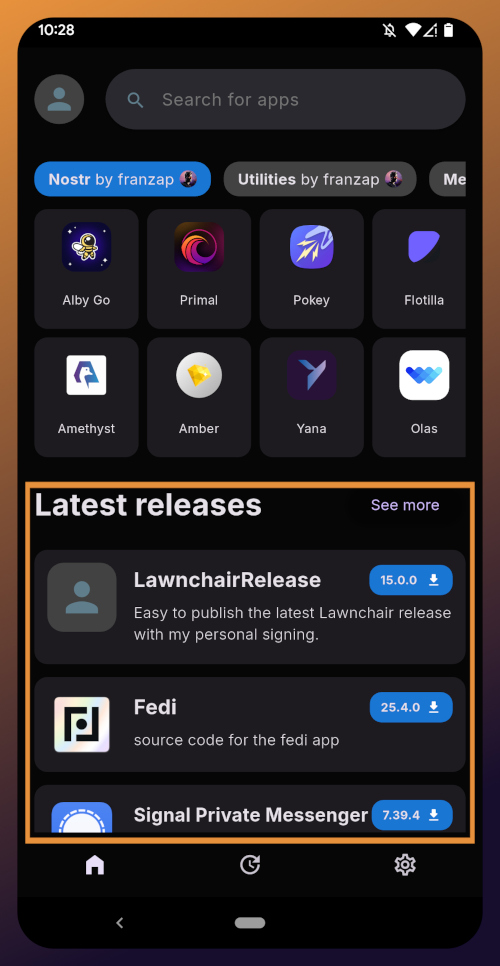
Installed Apps
The next page of the app, accessed by the icon in the bottom-center of the screen that looks like a clock with an arrow circling it, shows all apps you have installed that are available in the Zapstore. It's also where you will find apps you have previously installed that are ready to be updated. This page is pretty sparse on my test profile, since I only have the Zapstore itself installed, so here is a look at it on my main profile:
The "Disabled Apps" at the top are usually applications that were installed via the Play Store or some other means, but are also available in the Zapstore. You may be surprised to see that some of the apps you already have installed on your device are also available on the Zapstore. However, to manage their updates though the Zapstore, you would need to uninstall the app and reinstall it from the Zapstore instead. I only recommend doing this for applications that are added to the Zapstore by their developers, or you may encounter a significant delay between a new update being released for the app and when that update is available on the Zapstore.
Tap on one of your apps in the list to see whether the app is added by the developer, or by the Zapstore. This takes you to the application's page, and you may see a warning at the top if the app was not installed through the Zapstore.
Scroll down the page a bit and you will see who signed the release that is available on the Zapstore.

In the case of Primal, even though the developer is on Nostr, they are not signing their own releases to the Zapstore yet. This means there will likely be a delay between Primal releasing an update and that update being available on the Zapstore.
Settings
The last page of the app is the settings page, found by tapping the cog at the bottom right.
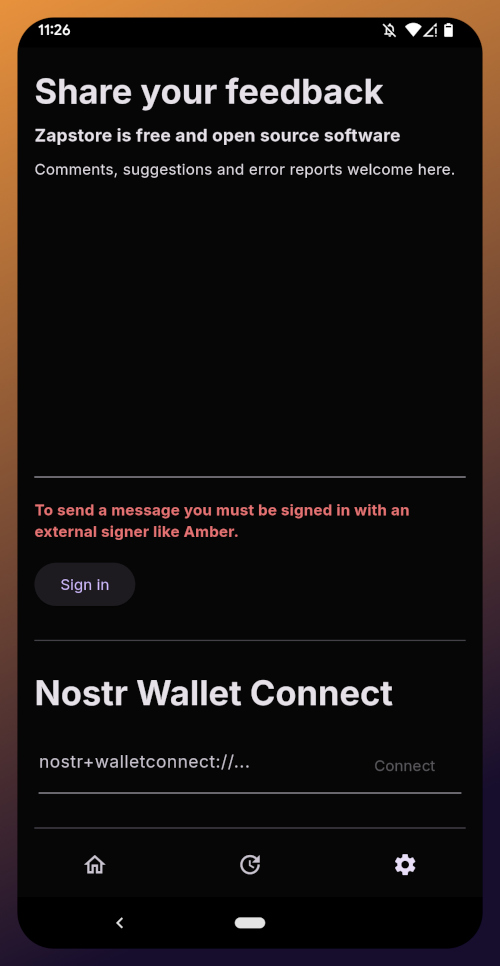
Here you can send the Zapstore developer feedback directly (if you are logged in), connect a Lightning wallet using Nostr Wallet Connect, delete your local cache, and view some system information.
We will be adding a connection to our nostr:npub1h2qfjpnxau9k7ja9qkf50043xfpfy8j5v60xsqryef64y44puwnq28w8ch wallet in part 5 of this tutorial series.
For the time being, we are all set with the Zapstore and ready for the next stage of our journey.
Continue to Part 3: Amber Signer. Nostr link: nostr:naddr1qqxnzde5xuengdeexcmnvv3eqgstwf6d9r37nqalwgxmfd9p9gclt3l0yc3jp5zuyhkfqjy6extz3jcrqsqqqa28qy2hwumn8ghj7un9d3shjtnyv9kh2uewd9hj7qg6waehxw309aex2mrp0yhxyunfva58gcn0d36zumn9wss80nug
-
 @ dfa02707:41ca50e3
2025-05-29 12:03:13
@ dfa02707:41ca50e3
2025-05-29 12:03:13Contribute to keep No Bullshit Bitcoin news going.
News
- Spiral welcomes Ben Carman. The developer will work on the LDK server and a new SDK designed to simplify the onboarding process for new self-custodial Bitcoin users.
- Spiral renews support for Dan Gould and Joschisan. The organization has renewed support for Dan Gould, who is developing the Payjoin Dev Kit (PDK), and Joschisan, a Fedimint developer focused on simplifying federations.
- The Bitcoin Dev Kit Foundation announced new corporate members for 2025, including AnchorWatch, CleanSpark, and Proton Foundation. The annual dues from these corporate members fund the small team of open-source developers responsible for maintaining the core BDK libraries and related free and open-source software (FOSS) projects.
- The European Central Bank is pushing for amendments to the European Union's Markets in Crypto Assets legislation (MiCA), just months after its implementation. According to Politico's report on Tuesday, the ECB is concerned that U.S. support for cryptocurrency, particularly stablecoins, could cause economic harm to the 27-nation bloc.
- Slovenia is considering a 25% capital gains tax on Bitcoin profits for individuals. The Ministry of Finance has proposed legislation to impose this tax on gains from cryptocurrency transactions, though exchanging one cryptocurrency for another would remain exempt. At present, individual 'crypto' traders in Slovenia are not taxed.
- The Virtual Asset Service Providers (VASP) Bill 2025 introduced in Kenya. The new legislation aims to establish a comprehensive legal framework for licensing, regulating, and supervising virtual asset service providers (VASPs), with strict penalties for non-compliant entities.
- Circle, BitGo, Coinbase, and Paxos plan to apply for U.S. bank charters or licenses. According to a report in The Wall Street Journal, major crypto companies are planning to apply for U.S. bank charters or licenses. These firms are pursuing limited licenses that would permit them to issue stablecoins, as the U.S. Congress deliberates on legislation mandating licensing for stablecoin issuers.
"Established banks, like Bank of America, are hoping to amend the current drafts of [stablecoin] legislation in such a way that nonbanks are more heavily restricted from issuing stablecoins," people familiar with the matter told The Block.
- Paul Atkins has officially assumed the role of the 34th Chairman of the US Securities and Exchange Commission (SEC). This is a return to the agency for Atkins, who previously served as an SEC Commissioner from 2002 to 2008 under the George W. Bush administration. He has committed to advancing the SEC’s mission of fostering capital formation, safeguarding investors, and ensuring fair and efficient markets.
- Federal Reserve retracts guidance discouraging banks from engaging in 'crypto.' The U.S. Federal Reserve withdrew guidance that discouraged banks from crypto and stablecoin activities, as announced by its Board of Governors on Thursday. This includes rescinding a 2022 supervisory letter requiring prior notification of crypto activities and 2023 stablecoin requirements.
"As a result, the Board will no longer expect banks to provide notification and will instead monitor banks' crypto-asset activities through the normal supervisory process," reads the FED statement.
- Russian government to launch a cryptocurrency exchange. The country's Ministry of Finance and Central Bank announced plans to establish a trading platform for "highly qualified investors" that "will legalize crypto assets and bring crypto operations out of the shadows."
- Twenty One Capital is set to launch with over 42,000 BTC in its treasury. This new Bitcoin-native firm, backed by Tether and SoftBank, is planned to go public via a SPAC merger with Cantor Equity Partners and will be led by Jack Mallers, co-founder and CEO of Strike. According to a report by the Financial Times, the company aims to replicate the model of Michael Saylor with his company, MicroStrategy.
- Strategy increases Bitcoin holdings to 538,200 BTC. In the latest purchase, the company has spent more than $555M to buy 6,556 coins through proceeds of two at-the-market stock offering programs.
- Metaplanet buys another 145 BTC. The Tokyo-listed company has purchased an additional 145 BTC for $13.6 million. Their total bitcoin holdings now stand at 5,000 coins, worth around $428.1 million.
- Semler Scientific has increased its bitcoin holdings to 3,303 BTC. The company acquired an additional 111 BTC at an average price of $90,124. The purchase was funded through proceeds from an at-the-market offering and cash reserves, as stated in a press release.
- Tesla still holds nearly $1 billion in bitcoin. According to the automaker's latest earnings report, the firm reported digital asset holdings worth $951 million as of March 31.
- Spar supermarket experiments with Bitcoin payments in Zug, Switzerland. The store has introduced a new payment method powered by the Lightning Network. The implementation was facilitated by DFX Swiss, a service that supports seamless conversions between bitcoin and legacy currencies.
- Charles Schwab to launch spot Bitcoin trading by 2026. The financial investment firm, managing over $10 trillion in assets, has revealed plans to introduce spot Bitcoin trading for its clients within the next year.
- Arch Labs has secured $13 million to develop "ArchVM" and integrate smart-contract functionality with Bitcoin. The funding round, valuing the company at $200 million, was led by Pantera Capital, as announced on Tuesday.
- Citrea deployed its Clementine Bridge on the Bitcoin testnet. The bridge utilizes the BitVM2 programming language to inherit validity from Bitcoin, allegedly providing "the safest and most trust-minimized way to use BTC in decentralized finance."
- UAE-based Islamic bank ruya launches Shari’ah-compliant bitcoin investing. The bank has become the world’s first Islamic bank to provide direct access to virtual asset investments, including Bitcoin, via its mobile app, per Bitcoin Magazine.
- Solosatoshi.com has sold over 10,000 open-source miners, adding more than 10 PH of hashpower to the Bitcoin network.
"Thank you, Bitaxe community. OSMU developers, your brilliance built this. Supporters, your belief drives us. Customers, your trust powers 10,000+ miners and 10PH globally. Together, we’re decentralizing Bitcoin’s future. Last but certainly not least, thank you@skot9000 for not only creating a freedom tool, but instilling the idea into thousands of people, that Bitcoin mining can be for everyone again," said the firm on X.
- OCEAN's DATUM has found 100 blocks. "Over 65% of OCEAN’s miners are using DATUM, and that number is growing every day. This means block template construction is making its way back into the hands of the miners, which is not only the most profitable
-
 @ dfa02707:41ca50e3
2025-05-29 10:01:30
@ dfa02707:41ca50e3
2025-05-29 10:01:30Contribute to keep No Bullshit Bitcoin news going.
News
- Spiral welcomes Ben Carman. The developer will work on the LDK server and a new SDK designed to simplify the onboarding process for new self-custodial Bitcoin users.
- Spiral renews support for Dan Gould and Joschisan. The organization has renewed support for Dan Gould, who is developing the Payjoin Dev Kit (PDK), and Joschisan, a Fedimint developer focused on simplifying federations.
- The Bitcoin Dev Kit Foundation announced new corporate members for 2025, including AnchorWatch, CleanSpark, and Proton Foundation. The annual dues from these corporate members fund the small team of open-source developers responsible for maintaining the core BDK libraries and related free and open-source software (FOSS) projects.
- The European Central Bank is pushing for amendments to the European Union's Markets in Crypto Assets legislation (MiCA), just months after its implementation. According to Politico's report on Tuesday, the ECB is concerned that U.S. support for cryptocurrency, particularly stablecoins, could cause economic harm to the 27-nation bloc.
- Slovenia is considering a 25% capital gains tax on Bitcoin profits for individuals. The Ministry of Finance has proposed legislation to impose this tax on gains from cryptocurrency transactions, though exchanging one cryptocurrency for another would remain exempt. At present, individual 'crypto' traders in Slovenia are not taxed.
- The Virtual Asset Service Providers (VASP) Bill 2025 introduced in Kenya. The new legislation aims to establish a comprehensive legal framework for licensing, regulating, and supervising virtual asset service providers (VASPs), with strict penalties for non-compliant entities.
- Circle, BitGo, Coinbase, and Paxos plan to apply for U.S. bank charters or licenses. According to a report in The Wall Street Journal, major crypto companies are planning to apply for U.S. bank charters or licenses. These firms are pursuing limited licenses that would permit them to issue stablecoins, as the U.S. Congress deliberates on legislation mandating licensing for stablecoin issuers.
"Established banks, like Bank of America, are hoping to amend the current drafts of [stablecoin] legislation in such a way that nonbanks are more heavily restricted from issuing stablecoins," people familiar with the matter told The Block.
- Paul Atkins has officially assumed the role of the 34th Chairman of the US Securities and Exchange Commission (SEC). This is a return to the agency for Atkins, who previously served as an SEC Commissioner from 2002 to 2008 under the George W. Bush administration. He has committed to advancing the SEC’s mission of fostering capital formation, safeguarding investors, and ensuring fair and efficient markets.
- Federal Reserve retracts guidance discouraging banks from engaging in 'crypto.' The U.S. Federal Reserve withdrew guidance that discouraged banks from crypto and stablecoin activities, as announced by its Board of Governors on Thursday. This includes rescinding a 2022 supervisory letter requiring prior notification of crypto activities and 2023 stablecoin requirements.
"As a result, the Board will no longer expect banks to provide notification and will instead monitor banks' crypto-asset activities through the normal supervisory process," reads the FED statement.
- Russian government to launch a cryptocurrency exchange. The country's Ministry of Finance and Central Bank announced plans to establish a trading platform for "highly qualified investors" that "will legalize crypto assets and bring crypto operations out of the shadows."
- Twenty One Capital is set to launch with over 42,000 BTC in its treasury. This new Bitcoin-native firm, backed by Tether and SoftBank, is planned to go public via a SPAC merger with Cantor Equity Partners and will be led by Jack Mallers, co-founder and CEO of Strike. According to a report by the Financial Times, the company aims to replicate the model of Michael Saylor with his company, MicroStrategy.
- Strategy increases Bitcoin holdings to 538,200 BTC. In the latest purchase, the company has spent more than $555M to buy 6,556 coins through proceeds of two at-the-market stock offering programs.
- Metaplanet buys another 145 BTC. The Tokyo-listed company has purchased an additional 145 BTC for $13.6 million. Their total bitcoin holdings now stand at 5,000 coins, worth around $428.1 million.
- Semler Scientific has increased its bitcoin holdings to 3,303 BTC. The company acquired an additional 111 BTC at an average price of $90,124. The purchase was funded through proceeds from an at-the-market offering and cash reserves, as stated in a press release.
- Tesla still holds nearly $1 billion in bitcoin. According to the automaker's latest earnings report, the firm reported digital asset holdings worth $951 million as of March 31.
- Spar supermarket experiments with Bitcoin payments in Zug, Switzerland. The store has introduced a new payment method powered by the Lightning Network. The implementation was facilitated by DFX Swiss, a service that supports seamless conversions between bitcoin and legacy currencies.
- Charles Schwab to launch spot Bitcoin trading by 2026. The financial investment firm, managing over $10 trillion in assets, has revealed plans to introduce spot Bitcoin trading for its clients within the next year.
- Arch Labs has secured $13 million to develop "ArchVM" and integrate smart-contract functionality with Bitcoin. The funding round, valuing the company at $200 million, was led by Pantera Capital, as announced on Tuesday.
- Citrea deployed its Clementine Bridge on the Bitcoin testnet. The bridge utilizes the BitVM2 programming language to inherit validity from Bitcoin, allegedly providing "the safest and most trust-minimized way to use BTC in decentralized finance."
- UAE-based Islamic bank ruya launches Shari’ah-compliant bitcoin investing. The bank has become the world’s first Islamic bank to provide direct access to virtual asset investments, including Bitcoin, via its mobile app, per Bitcoin Magazine.
- Solosatoshi.com has sold over 10,000 open-source miners, adding more than 10 PH of hashpower to the Bitcoin network.
"Thank you, Bitaxe community. OSMU developers, your brilliance built this. Supporters, your belief drives us. Customers, your trust powers 10,000+ miners and 10PH globally. Together, we’re decentralizing Bitcoin’s future. Last but certainly not least, thank you@skot9000 for not only creating a freedom tool, but instilling the idea into thousands of people, that Bitcoin mining can be for everyone again," said the firm on X.
- OCEAN's DATUM has found 100 blocks. "Over 65% of OCEAN’s miners are using DATUM, and that number is growing every day. This means block template construction is making its way back into the hands of the miners, which is not only the most profitable
-
 @ 7f6db517:a4931eda
2025-05-29 12:03:19
@ 7f6db517:a4931eda
2025-05-29 12:03:19
The former seems to have found solid product market fit. Expect significant volume, adoption, and usage going forward.
The latter's future remains to be seen. Dependence on Tor, which has had massive reliability issues, and lack of strong privacy guarantees put it at risk.
— ODELL (@ODELL) October 27, 2022
The Basics
- Lightning is a protocol that enables cheap and fast native bitcoin transactions.
- At the core of the protocol is the ability for bitcoin users to create a payment channel with another user.
- These payment channels enable users to make many bitcoin transactions between each other with only two on-chain bitcoin transactions: the channel open transaction and the channel close transaction.
- Essentially lightning is a protocol for interoperable batched bitcoin transactions.
- It is expected that on chain bitcoin transaction fees will increase with adoption and the ability to easily batch transactions will save users significant money.
- As these lightning transactions are processed, liquidity flows from one side of a channel to the other side, on chain transactions are signed by both parties but not broadcasted to update this balance.
- Lightning is designed to be trust minimized, either party in a payment channel can close the channel at any time and their bitcoin will be settled on chain without trusting the other party.
There is no 'Lightning Network'
- Many people refer to the aggregate of all lightning channels as 'The Lightning Network' but this is a false premise.
- There are many lightning channels between many different users and funds can flow across interconnected channels as long as there is a route through peers.
- If a lightning transaction requires multiple hops it will flow through multiple interconnected channels, adjusting the balance of all channels along the route, and paying lightning transaction fees that are set by each node on the route.
Example: You have a channel with Bob. Bob has a channel with Charlie. You can pay Charlie through your channel with Bob and Bob's channel with User C.
- As a result, it is not guaranteed that every lightning user can pay every other lightning user, they must have a route of interconnected channels between sender and receiver.
Lightning in Practice
- Lightning has already found product market fit and usage as an interconnected payment protocol between large professional custodians.
- They are able to easily manage channels and liquidity between each other without trust using this interoperable protocol.
- Lightning payments between large custodians are fast and easy. End users do not have to run their own node or manage their channels and liquidity. These payments rarely fail due to professional management of custodial nodes.
- The tradeoff is one inherent to custodians and other trusted third parties. Custodial wallets can steal funds and compromise user privacy.
Sovereign Lightning
- Trusted third parties are security holes.
- Users must run their own node and manage their own channels in order to use lightning without trusting a third party. This remains the single largest friction point for sovereign lightning usage: the mental burden of actively running a lightning node and associated liquidity management.
- Bitcoin development prioritizes node accessibility so cost to self host your own node is low but if a node is run at home or office, Tor or a VPN is recommended to mask your IP address: otherwise it is visible to the entire network and represents a privacy risk.
- This privacy risk is heightened due to the potential for certain governments to go after sovereign lightning users and compel them to shutdown their nodes. If their IP Address is exposed they are easier to target.
- Fortunately the tools to run and manage nodes continue to get easier but it is important to understand that this will always be a friction point when compared to custodial services.
The Potential Fracture of Lightning
- Any lightning user can choose which users are allowed to open channels with them.
- One potential is that professional custodians only peer with other professional custodians.
- We already see nodes like those run by CashApp only have channels open with other regulated counterparties. This could be due to performance goals, liability reduction, or regulatory pressure.
- Fortunately some of their peers are connected to non-regulated parties so payments to and from sovereign lightning users are still successfully processed by CashApp but this may not always be the case going forward.
Summary
- Many people refer to the aggregate of all lightning channels as 'The Lightning Network' but this is a false premise. There is no singular 'Lightning Network' but rather many payment channels between distinct peers, some connected with each other and some not.
- Lightning as an interoperable payment protocol between professional custodians seems to have found solid product market fit. Expect significant volume, adoption, and usage going forward.
- Lightning as a robust sovereign payment protocol has yet to be battle tested. Heavy reliance on Tor, which has had massive reliability issues, the friction of active liquidity management, significant on chain fee burden for small amounts, interactivity constraints on mobile, and lack of strong privacy guarantees put it at risk.
If you have never used lightning before, use this guide to get started on your phone.
If you found this post helpful support my work with bitcoin.

-
 @ dfa02707:41ca50e3
2025-05-29 12:03:13
@ dfa02707:41ca50e3
2025-05-29 12:03:13Headlines
- Spiral renews support for Dan Gould and Joschisan. The organization has renewed support for Dan Gould, who is developing the Payjoin Dev Kit (PDK), and Joschisan, a Fedimint developer focused on simplifying federations.
- Metaplanet buys another 145 BTC. The Tokyo-listed company has purchased an additional 145 BTC for $13.6 million. Their total bitcoin holdings now stand at 5,000 coins, worth around $428.1 million.
- Semler Scientific has increased its bitcoin holdings to 3,303 BTC. The company acquired an additional 111 BTC at an average price of $90,124. The purchase was funded through proceeds from an at-the-market offering and cash reserves, as stated in a press release.
- The Virtual Asset Service Providers (VASP) Bill 2025 introduced in Kenya. The new legislation aims to establish a comprehensive legal framework for licensing, regulating, and supervising virtual asset service providers (VASPs), with strict penalties for non-compliant entities.
- Russian government to launch a cryptocurrency exchange. The country's Ministry of Finance and Central Bank announced plans to establish a trading platform for "highly qualified investors" that "will legalize crypto assets and bring crypto operations out of the shadows."
- All virtual asset service providers expect to be fully compliant with the Travel Rule by the end of 2025. A survey by financial surveillance specialist Notabene reveals that 90% of virtual asset service providers (VASPs) expect full Travel Rule compliance by mid-2025, with all aiming for compliance by year-end. The survey also shows a significant rise in VASPs blocking withdrawals until beneficiary information is confirmed, increasing from 2.9% in 2024 to 15.4% now. Additionally, about 20% of VASPs return deposits if originator data is missing.
- UN claims Bitcoin mining is a "powerful tool" for money laundering. The Rage's analysis suggests that the recent United Nations Office on Drugs and Crime report on crime in South-East Asia makes little sense and hints at the potential introduction of Anti-Money Laundering (AML) measures at the mining level.
- Riot Platforms has obtained a $100 million credit facility from Coinbase Credit, using bitcoin as collateral for short-term funding to support its expansion. The firm's CEO, Jason Les, stated that this facility is crucial for diversifying financing sources and driving long-term stockholder value through strategic growth initiatives.
- Bitdeer raises $179M in loans and equity amid Bitcoin chip push. The Miner Mag reports that Bitdeer entered into a loan agreement with its affiliate Matrixport for up to $200 million in April, as disclosed in its annual report filed on Monday.
- Federal Reserve retracts guidance discouraging banks from engaging in 'crypto.' The U.S. Federal Reserve withdrew guidance that discouraged banks from crypto and stablecoin activities, as announced by its Board of Governors on Thursday. This includes rescinding a 2022 supervisory letter requiring prior notification of crypto activities and 2023 stablecoin requirements.
"As a result, the Board will no longer expect banks to provide notification and will instead monitor banks' crypto-asset activities through the normal supervisory process," reads the FED statement.
- UAE-based Islamic bank ruya launches Shari’ah-compliant bitcoin investing. The bank has become the world’s first Islamic bank to provide direct access to virtual asset investments, including Bitcoin, via its mobile app, per Bitcoin Magazine.
- U.S. 'crypto' scam losses amounted to $9.3B in 2024. The US The Federal Bureau of Investigation (FBI) has reported $9.3 billion losses in cryptocurrency-related scams in 2024, noting a troubling trend of scams targeting older Americans, which accounted for over $2.8 billion of those losses.

Source: FBI.
- North Korean hackers establish fake companies to target 'crypto' developers. Silent Push researchers reported that hackers linked to the Lazarus Group created three shell companies, two of which are based in the U.S., with the objective of spreading malware through deceptive job interview scams aimed at individuals seeking jobs in cryptocurrency companies.
- Citrea deployed its Clementine Bridge on the Bitcoin testnet. The bridge utilizes the BitVM2 programming language to inherit validity from Bitcoin, allegedly providing "the safest and most trust-minimized way to use BTC in decentralized finance."
- Hesperides University offers a Master’s degree in Bitcoin. Bitcoin Magazine reports the launch of the first-ever Spanish-language Master’s program dedicated exclusively to Bitcoin. Starting April 28, 2025, this fully online program will equip professionals with technical, economic, legal, and philosophical skills to excel in the Bitcoin era.
- BTC in D.C. event is set to take place on September 30 - October 1 in Washington, D.C. Learn more about this initiative here.
Use the tools
- Bitcoin Keeper just got a new look. Version 2.2.0 of the mobile multisig app brought a new branding design, along with a Keeper Private tier, testnet support, ability to import and export BIP-329 labels, and the option to use a Server Key with multiple users.
- Earlier this month the project also announced Keeper Learn service, offering clear and guided Bitcoin learning sessions for both groups and individuals.
- Keeper Desktop v0.2.2, a companion desktop app for Bitcoin Keeper mobile app, received a renewed branding update, too.

The evolution of Bitcoin Keeper logo. Source: BitHyve blog.
- Blockstream Green Desktop v2.0.25 updates GDK to v0.75.1 and fixes amount parsing issues when switching from fiat denomination to Liquid asset.
- Lightning Loop v0.31.0-beta enhances the
loop listswapscommand by improving the ability to filter the response. - Lightning-kmp v1.10.0, an implementation of the Lightning Network in Kotlin, is now available.
- LND v0.19.0-beta.rc3, the latest beta release candidate of LND is now ready for testing.
- ZEUS v0.11.0-alpha2 is now available for testing, too. It's nuts.
- JoinMarket Fidelity Bond Simulator helps potential JoinMarket makers evaluate their competitive position in the market based on fidelity bonds.
- UTXOscope is a text-only Bitcoin blockchain analysis tool that visualizes price dynamics using only on-chain data. The
-
 @ dfa02707:41ca50e3
2025-05-29 10:01:29
@ dfa02707:41ca50e3
2025-05-29 10:01:29Contribute to keep No Bullshit Bitcoin news going.
- Wasabi Wallet v2.6.0 "Prometheus" is a major update for the project, focused on resilience and independence from centralized systems.
- Key features include support for BIP 158 block filters for direct node synchronization, a revamped full node integration for easier setup without third-party reliance, SLIP 39 share backups for flexible wallet recovery (sponsored by Trezor), and a Nostr-based update manager for censorship-resistant updates.
- Additional improvements include UI bug fixes, a new fallback for transaction broadcasting, updated code signing, stricter JSON serialization, and options to avoid third-party rate providers, alongside various under-the-hood enhancements.
This new version brings us closer to our ultimate goal: ensuring Wasabi is future-proof," said the developers, while also highlighting the following key areas of focus for the project:
- Ensuring users can always fully and securely use their client.
- Making contribution and forks easy through a codebase of the highest quality possible: understandable, maintainable, and improvable.
"As we achieve our survival goals, expect more cutting-edge improvements in Bitcoin privacy and self-custody. Thank you for the trust you place in us by using Wasabi," was stated in the release notes.
What's new
- Support for Standard BIP 158 Block Filters. Wasabi now syncs using BIP 158 filters without a backend/indexer, connecting directly to a user's node. This boosts sync speed, resilience, and allows full sovereignty without specific server dependency.
- Full Node Integration Rework. The old integration has been replaced with a simpler, more adaptable system. It’s not tied to a specific Bitcoin node fork, doesn’t need the node on the same machine as Wasabi, and requires no changes to the node’s setup.
- "Simply enable the RPC server on your node and point Wasabi to it," said the developers. This ensures all Bitcoin network activities—like retrieving blocks, fee estimations, block filters, and transaction broadcasting—go through your own node, avoiding reliance on third parties.
- Create & Recover SLIP 39 Shares. Users now create and recover wallets with multiple share backups using SLIP 39 standard.
"Special thanks to Trezor (SatoshiLabs) for sponsoring this amazing feature."
- Nostr Update Manager. This version implements a pioneering system with the Nostr protocol for update information and downloads, replacing reliance on GitHub. This enhances the project's resilience, ensuring updates even if GitHub is unavailable, while still verifying updates with the project's secure certificate.
- Updated Avalonia to v11.2.7, fixes for UI bugs (including restoring Minimize on macOS Sequoia).
- Added a configurable third-party fallback for broadcasting transactions if other methods fail.
- Replaced Windows Code Signing Certificate with Azure Trusted Signing.
- Many bug fixes, improved codebase, and enhanced CI pipeline.
- Added the option to avoid using any third-party Exchange Rate and Fee Rate providers (Wasabi can work without them).
- Rebuilt all JSON Serialization mechanisms avoiding default .NET converters. Serialization is now stricter.

Full Changelog: v2.5.1...v2.6.0
-
 @ b7274d28:c99628cb
2025-05-28 00:59:49
@ b7274d28:c99628cb
2025-05-28 00:59:49Your identity is important to you, right? While impersonation can be seen in some senses as a form of flattery, we all would prefer to be the only person capable of representing ourselves online, unless we intentionally delegate that privilege to someone else and maintain the ability to revoke it.
Amber does all of that for you in the context of #Nostr. It minimizes the possibility of your private key being compromized by acting as the only app with access to it, while all other Nostr apps send requests to Amber when they need something signed. This even allows you to give someone temporary authority to post as you without giving them your private key, and you retain the authority to revoke their permissions at any time.
nostr:npub1w4uswmv6lu9yel005l3qgheysmr7tk9uvwluddznju3nuxalevvs2d0jr5 has provided Android users with an incredibly powerful tool in Amber, and he continues to improve its functionality and ease of use. Indeed, there is not currently a comparative app available for iOS users. For the time being, this superpower is exclusive to Android.
Installation
Open up the Zapstore app that you installed in the previous stage of this tutorial series.
Very likely, Amber will be listed in the app collection section of the home page. If it is not, just search for "Amber" in the search bar.

Opening the app's page in the Zapstore shows that the release is signed by the developer. You can also see who has added this app to one of their collections and who has supported this app with sats by zapping the release.
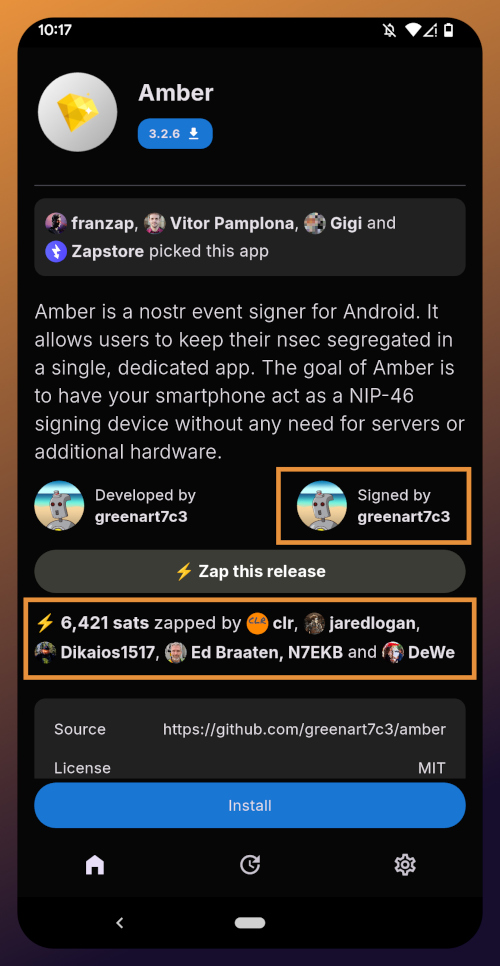
Tap "Install" and you will be prompted to confirm you are sure you want to install Amber.
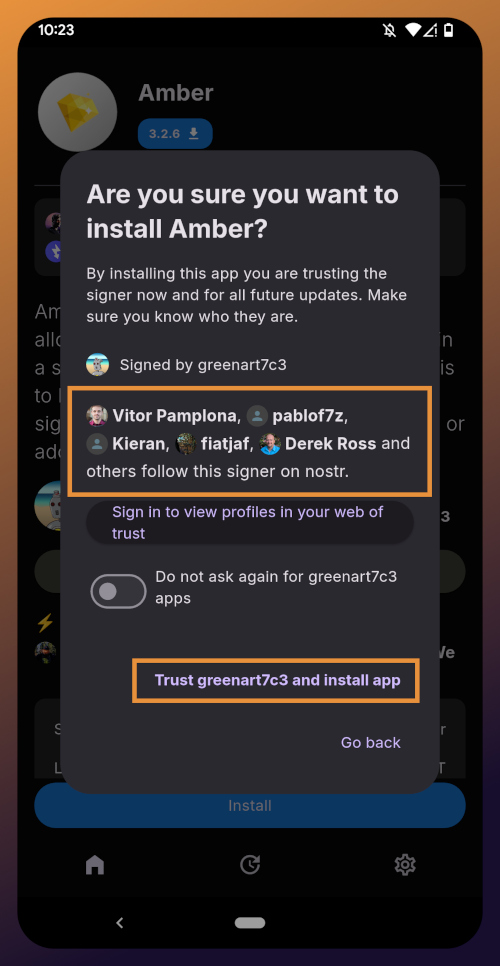
Helpfully, you are informed that several other users follow this developer on Nostr. If you have been on Nostr a while, you will likely recognize these gentlemen as other Nostr developers, one of them being the original creator of the protocol.
You can choose to never have Zapstore ask for confirmation again with apps developed by nostr:npub1w4uswmv6lu9yel005l3qgheysmr7tk9uvwluddznju3nuxalevvs2d0jr5, and since we have another of his apps to install later in this tutorial series, I recommend you toggle this on. Then tap on "Trust greenart7c3 and install app."
Just like when you installed the Zapstore from their GitHub, you will be prompted to allow the Zapstore to install apps, since Android considers it an "unknown source."
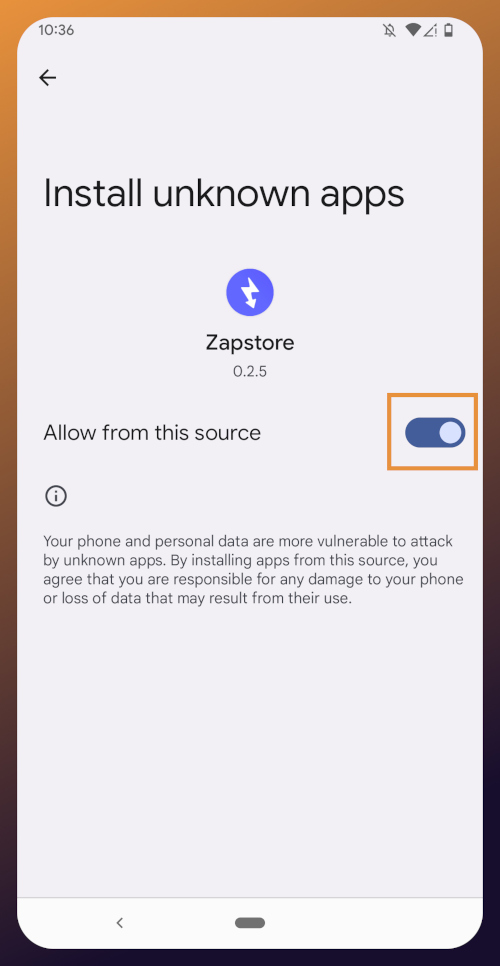
Once you toggle this on and use the back button to get back to the Zapstore, Amber will begin downloading and then present a prompt to install the app. Once installed, you will see a prompt that installation was a success and you can now open the app.

From here, how you proceed will depend on whether you need to set up a new Nostr identity or use Amber with an existing private key you already have set up. The next section will cover setting up a new Nostr identity with Amber. Skip to the section titled "Existing Nostrich" if you already have an nsec that you would like to use with Amber.
New Nostrich
Upon opening the application, you will be presented with the option to use an existing private key or create a new Nostr account. Nostr doesn't really have "accounts" in the traditional sense of the term. Accounts are a relic of permissioned systems. What you have on Nostr are keys, but Amber uses the "account" term because it is a more familiar concept, though it is technically inaccurate.
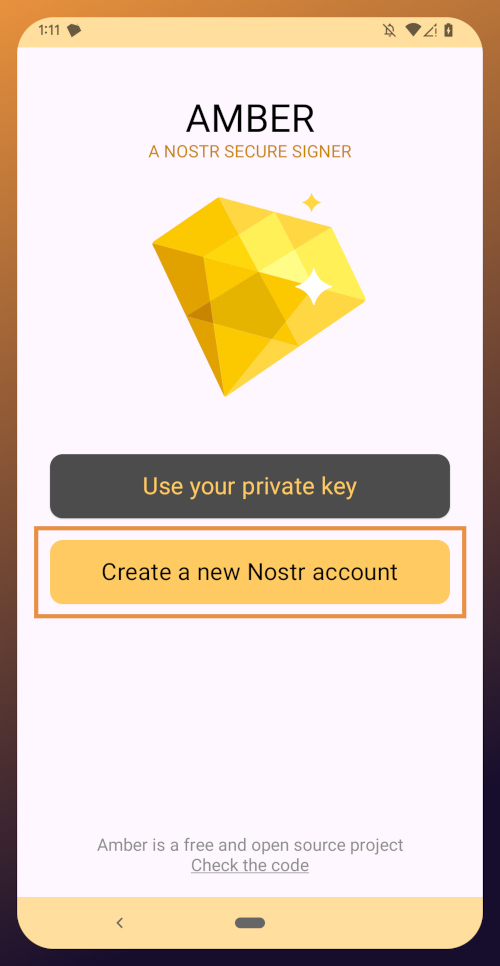
Choose "Create a new Nostr account" and you will be presented with a screen telling you that your Nostr account is ready. Yes, it was really that easy. No email, no real name, no date of birth, and no annoying capcha. Just "Create a new account" and you're done.
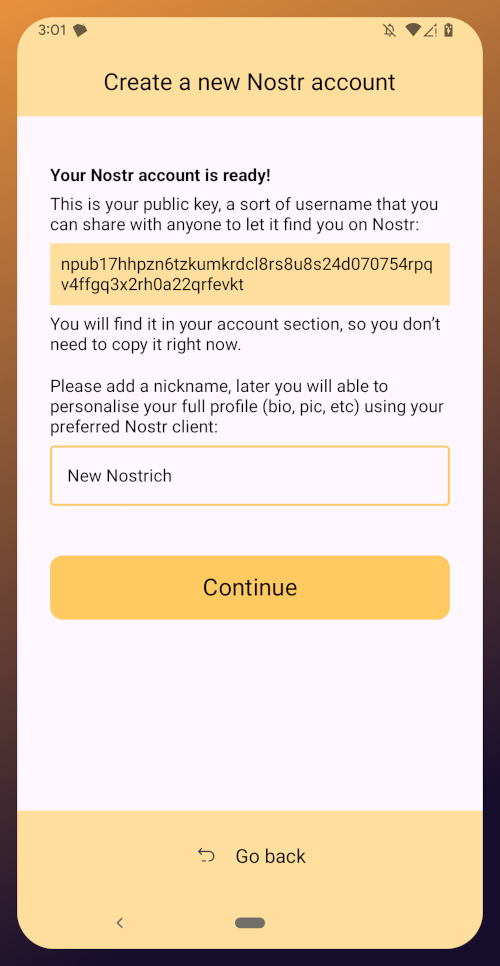
The app presents you with your public key. This is like an address that can be used to find your posts on Nostr. It is 100% unique to you, and no one else can post a note that lists this npub as the author, because they won't have the corresponding private key. You don't need to remember your npub, though. You'll be able to readily copy it from any Nostr app you use whenever you need it.
You will also be prompted to add a nickname. This is just for use within Amber, since you can set up multiple profiles within the app. You can use anything you want here, as it is just so you can tell which profile is which when switching between them in Amber.
Once you've set your nickname, tap on "Continue."
The next screen will ask you what Amber's default signing policy should be.
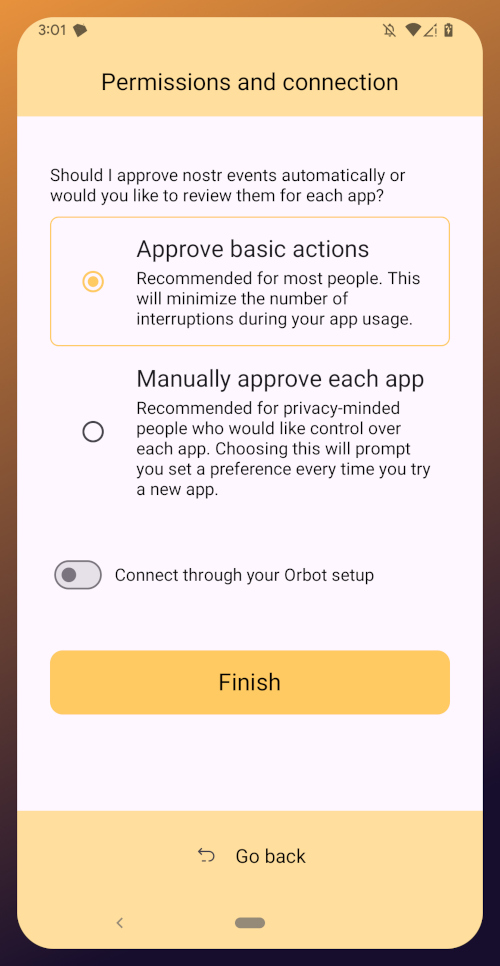
The default is to approve basic actions, referring to things that are common for Nostr clients to request a signature for, like following another user, liking a post, making a new post, or replying. If you are more concerned about what Amber might be signing for on your behalf, you can tell it to require manual approval for each app.
Once you've made your decision, tap "Finish." You will also be able to change this selection in the app settings at any time.
With this setup out of the way, you are now presented with the main "Applications" page of the app.
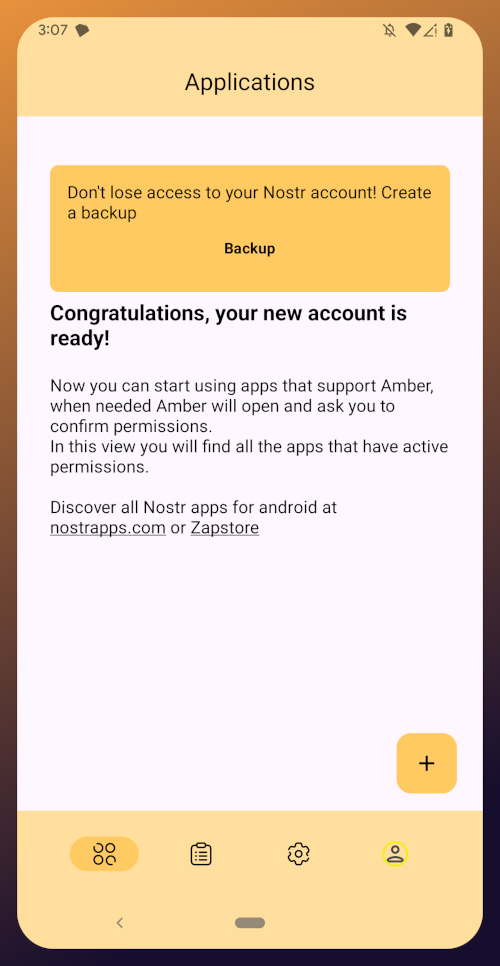
At the top, you have a notification encouraging you to create a backup. Let's get that taken care of now by tapping on the notification and skipping down to the heading titled "Backing Up Your Identity" in this tutorial.
Existing Nostrich
Upon opening the application, you will be presented with the option to use your private key or create a new Nostr account. Choose the former.
The next screen will require you to paste your private key.
You will need to obtain this from whatever Nostr app you used to create your profile, or any other Nostr app that you pasted your nsec into in the past. Typically you can find it in the app settings and there will be a section mentioning your keys where you can copy your nsec. For instance, in Primal go to Settings > Keys > Copy private key, and on Amethyst open the side panel by tapping on your profile picture in the top-left, then Backup Keys > Copy my secret key.
After pasting your nsec into Amber, tap "Next."

Amber will give you a couple options for a default signing policy. The default is to approve basic actions, referring to things that are common for Nostr clients to request a signature for, like following another user, liking a post, making a new post, or replying. If you are more concerned about what Amber might be signing for on your behalf, you can tell it to require manual approval for each app.
Once you've made your decision, tap "Finish." You will also be able to change this selection in the app settings at any time.
With this setup out of the way, you are now presented with the main "Applications" page of the app. You have nothing here yet, since you haven't used Amber to log into any Nostr apps, but this will be where all of the apps you have connected with Amber will be listed, in the order of the most recently used at the top.
Before we go and use Amber to log into an app, though, let's make sure we've created a backup of our private key. You pasted your nsec into Amber, so you could just save that somewhere safe, but Amber gives you a few other options as well. To find them, you'll need to tap the cog icon at the bottom of the screen to access the settings, then select "Backup Keys."
Backing Up Your Identity
You'll notice that Amber has a few different options for backing up your private key that it can generate.
First, it can give you seed words, just like a Bitcoin seed. If you choose that option, you'll be presented with 12 words you can record somewhere safe. To recover your Nostr private key, you just have to type those words into a compatible application, such as Amber.
The next option is to just copy the secret/private key in its standard form as an "nsec." This is the least secure way to store it, but is also the most convenient, since it is simple to paste into another signer application. If you want to be able to log in on a desktop web app, the browser extension Nostr signers won't necessarily support entering your 12 word seed phrase, but they absolutely will support pasting in your nsec.
You can also display a QR code of your private key. This can be scanned by Amber signer on another device for easily transferring your private key to other devices you want to use it on. Say you have an Android tablet in addition to your phone, for instance. Just make sure you only use this function where you can be certain that no one will be able to get a photograph of that QR code. Once someone else has your nsec, there is no way to recover it. You have to start all over on Nostr. Not a big deal at this point in your journey if you just created a Nostr account, but if you have been using Nostr for a while and have built up a decent amount of reputation, it could be much more costly to start over again.
The next options are a bit more secure, because they require a password that will be used to encrypt your private key. This has some distinct advantages, and a couple disadvantages to be aware of. Using a password to encrypt your private key will give you what is called an ncryptsec, and if this is leaked somehow, whoever has it will not necessarily have access to post as you on Nostr, the way they would if your nsec had been leaked. At least, not so long as they don't also have your password. This means you can store your ncryptsec in multiple locations without much fear that it will be compromised, so long as the password you used to encrypt it was a strong and unique one, and it isn't stored in the same location. Some Nostr apps support an ncryptsec for login directly, meaning that you have the option to paste in your ncryptsec and then just log in with the password you used to encrypt it from there on out. However, now you will need to keep track of both your ncryptsec and your password, storing both of them safely and separately. Additionally, most Nostr clients and signer applications do not support using an ncryptsec, so you will need to convert it back to a standard nsec (or copy the nsec from Amber) to use those apps.
The QR option using an ncryptsec is actually quite useful, though, and I would go this route when trying to set up Amber on additional devices, since anyone possibly getting a picture of the QR code is still not going to be able to do anything with it, unless they also get the password you used to encrypt it.
All of the above options will require you to enter the PIN you set up for your device, or biometric authentication, just as an additional precaution before displaying your private key to you.
As for what "store it in a safe place" looks like, I highly recommend a self-hosted password manager, such as Vaultwarden+Bitwarden or KeePass. If you really want to get wild, you can store it on a hardware signing device, or on a steel seed plate.
Additional Settings
Amber has some additional settings you may want to take advantage of. First off, if you don't want just anyone who has access to your phone to be able to approve signing requests, you can go into the Security settings add a PIN or enable biometrics for signing requests. If you enable the PIN, it will be separate from the PIN you use to access your phone, so you can let someone else use your phone, like your child who is always begging to play a mobile game you have installed, without worrying that they might have access to your Nostr key to post on Amethyst.
Amber also has some relay settings. First are the "Active relays" which are used for signing requests sent to Amber remotely from Nostr web apps. This is what enables you to use Amber on your phone to log into Nostr applications on your desktop web browser, such as Jumble.social, Coracle.social, or Nostrudel.ninja, eliminating your need to use any other application to store your nsec whatsoever. You can leave this relay as the default, or you can add other relays you want to use for signing requests. Just be aware, not all relays will accept the notes that are used for Nostr signing requests, so make sure that the relay you want to use does so. In fact, Amber will make sure of this for you when you type in the relay address.
The next type of relays that you can configure in Amber are the "Default profile relays." These are used for reading your profile information. If you already had a Nostr identity that you imported to Amber, you probably noticed it loaded your profile picture and display name, setting the latter as your nickname in Amber. These relays are where Amber got that information from. The defaults are relay.nostr.band and purplepag.es. The reason for this is because they are aggregators that look for Nostr profiles that have been saved to other relays on the network and pull them in. Therefore, no matter what other relay you may save your profile to, Amber will likely be able to find it on one of those two relays as well. If you have a relay you know you will be saving your Nostr profiles to, you may want to add it to this list.
You can also set up Amber to be paired with Orbot for signing over Tor using relays that are only accessible via the Tor network. That is an advanced feature, though, and well beyond the scope of this tutorial.
Finally, you can update the default signing policy. Maybe after using Amber for a while, you've decided that the choice you made before was too strict or too lenient. You can change it to suit your needs.
Zapstore Login
Now that you are all set up with Amber, let's get you signed into your first Nostr app by going back to the Zapstore.
From the app's home screen, tap on the user icon in the upper left of the screen. This will open a side panel with not much on it except the option to "sign in." Go ahead and tap on it.
You will be presented with the option to either sign in with Amber, or to paste your npub. However, if you do the latter, you will only have read access, meaning you cannot zap any of the app releases. There are other features planned for the Zapstore that may also require you to be signed in with write access, so go ahead and choose to log in with Amber.

Your phone should automatically switch to Amber to approve the sign-in request.

You can choose to only approve basic actions for Zapstore, require it to manually approve every time, or you can tell it that you "fully trust this application." Only choose the latter option with apps you have used for a while and they have never asked you to sign for anything suspicious. For the time being, I suggest you use the "Approve basic actions" option and tap "Grant Permissions."
Your phone will switch back to the Zapstore and will show that you are now signed in. Congratulations! From here on out, logging into most Nostr applications will be as easy as tapping on "Log in with Amber" and approving the request.

If you set up a new profile, it will just show a truncated version of your npub rather than the nickname you set up earlier. That's fine. You'll have an opportunity to update your Nostr profile in the next tutorial in this series and ensure that it is spread far and wide in the network, so the Zapstore will easily find it.
That concludes the tutorial for Amber. While we have not covered using Amber to log into Nostr web apps, that is outside the scope of this series, and I will cover it in an upcoming tutorial regarding using Amber's remote signer options in detail.
Since you're already hanging out in the Zapstore, you may as well stick around, because we will be using it right out the gate in the next part of this series: Amethyst Installation and Setup. (Coming Soon)
-
 @ dfa02707:41ca50e3
2025-05-29 12:03:12
@ dfa02707:41ca50e3
2025-05-29 12:03:12Contribute to keep No Bullshit Bitcoin news going.
- RoboSats v0.7.7-alpha is now available!
NOTE: "This version of clients is not compatible with older versions of coordinators. Coordinators must upgrade first, make sure you don't upgrade your client while this is marked as pre-release."
- This version brings a new and improved coordinators view with reviews signed both by the robot and the coordinator, adds market price sources in coordinator profiles, shows a correct warning for canceling non-taken orders after a payment attempt, adds Uzbek sum currency, and includes package library updates for coordinators.

Source: RoboSats.
- siggy47 is writing daily RoboSats activity reviews on stacker.news. Check them out here.
- Stay up-to-date with RoboSats on Nostr.
What's new
- New coordinators view (see the picture above).
- Available coordinator reviews signed by both the robot and the coordinator.
- Coordinators now display market price sources in their profiles.

Source: RoboSats.
- Fix for wrong message on cancel button when taking an order. Users are now warned if they try to cancel a non taken order after a payment attempt.
- Uzbek sum currency now available.
- For coordinators: library updates.
- Add docker frontend (#1861).
- Add order review token (#1869).
- Add UZS migration (#1875).
- Fixed tests review (#1878).
- Nostr pubkey for Robot (#1887).
New contributors

Full Changelog: v0.7.6-alpha...v0.7.7-alpha
-
 @ dfa02707:41ca50e3
2025-05-29 10:01:28
@ dfa02707:41ca50e3
2025-05-29 10:01:28Contribute to keep No Bullshit Bitcoin news going.
- "Today we're launching the beta version of our multiplatform Nostr browser! Think Google Chrome but for Nostr apps. The beta is our big first step toward this vision," announced Damus.
- This version comes with the Dave Nostr AI assistant, support for zaps and the Nostr Wallet Connect (NWC) wallet interface, full-text note search, GIFs and fullscreen images, multiple media uploads, user tagging, relay list and mute list support, along with a number of other improvements."
"Included in the beta is the Dave, the Nostr AI assistant (its Grok for Nostr). Dave is a new Notedeck browser app that can search and summarize notes from the network. For a full breakdown of everything new, check out our beta launch video."
What's new
- Dave Nostr AI assistant app.
- GIFs.
- Fulltext note search.
- Add full screen images, add zoom, and pan.
- Zaps! NWC/ Wallet UI.
- Introduce last note per pubkey feed (experimental).
- Allow multiple media uploads per selection.
- Major Android improvements (still WIP).
- Added notedeck app sidebar.
- User Tagging.
- Note truncation.
- Local network note broadcast, broadcast notes to other notedeck notes while you're offline.
- Mute list support (reading).
- Relay list support.
- Ctrl-enter to send notes.
- Added relay indexing (relay columns soon).
- Click hashtags to open hashtag timeline.
- Fixed timelines sometimes not updating (stale feeds).
- Fixed UI bounciness when loading profile pictures
- Fixed unselectable post replies.

-
 @ 7f6db517:a4931eda
2025-05-29 12:03:19
@ 7f6db517:a4931eda
2025-05-29 12:03:19
Bank run on every crypto bank then bank run on every "real" bank.
— ODELL (@ODELL) December 14, 2022
The four main banks of bitcoin and “crypto” are Signature, Prime Trust, Silvergate, and Silicon Valley Bank. Prime Trust does not custody funds themselves but rather maintains deposit accounts at BMO Harris Bank, Cross River, Lexicon Bank, MVB Bank, and Signature Bank. Silvergate and Silicon Valley Bank have already stopped withdrawals. More banks will go down before the chaos stops. None of them have sufficient reserves to meet withdrawals.
Bitcoin gives us all the ability to opt out of a system that has massive layers of counterparty risk built in, years of cheap money and broken incentives have layered risk on top of risk throughout the entire global economy. If you thought the FTX bank run was painful to watch, I have bad news for you: every major bank in the world is fractional reserve. Bitcoin held in self custody is unique in its lack of counterparty risk, as global market chaos unwinds this will become much more obvious.
The rules of bitcoin are extremely hard to change by design. Anyone can access the network directly without a trusted third party by using their own node. Owning more bitcoin does not give you more control over the network with all participants on equal footing.
Bitcoin is:
- money that is not controlled by a company or government
- money that can be spent or saved without permission
- money that is provably scarce and should increase in purchasing power with adoptionBitcoin is money without trust. Whether you are a nation state, corporation, or an individual, you can use bitcoin to spend or save without permission. Social media will accelerate the already deteriorating trust in our institutions and as this trust continues to crumble the value of trust minimized money will become obvious. As adoption increases so should the purchasing power of bitcoin.
A quick note on "stablecoins," such as USDC - it is important to remember that they rely on trusted custodians. They have the same risk as funds held directly in bank accounts with additional counterparty risk on top. The trusted custodians can be pressured by gov, exit scam, or caught up in fraud. Funds can and will be frozen at will. This is a distinctly different trust model than bitcoin, which is a native bearer token that does not rely on any centralized entity or custodian.
Most bitcoin exchanges have exposure to these failing banks. Expect more chaos and confusion as this all unwinds. Withdraw any bitcoin to your own wallet ASAP.
Simple Self Custody Guide: https://werunbtc.com/muun
More Secure Cold Storage Guide: https://werunbtc.com/coldcard
If you found this post helpful support my work with bitcoin.

-
 @ dfa02707:41ca50e3
2025-05-29 12:03:12
@ dfa02707:41ca50e3
2025-05-29 12:03:12Contribute to keep No Bullshit Bitcoin news going.
- Wasabi Wallet v2.6.0 "Prometheus" is a major update for the project, focused on resilience and independence from centralized systems.
- Key features include support for BIP 158 block filters for direct node synchronization, a revamped full node integration for easier setup without third-party reliance, SLIP 39 share backups for flexible wallet recovery (sponsored by Trezor), and a Nostr-based update manager for censorship-resistant updates.
- Additional improvements include UI bug fixes, a new fallback for transaction broadcasting, updated code signing, stricter JSON serialization, and options to avoid third-party rate providers, alongside various under-the-hood enhancements.
This new version brings us closer to our ultimate goal: ensuring Wasabi is future-proof," said the developers, while also highlighting the following key areas of focus for the project:
- Ensuring users can always fully and securely use their client.
- Making contribution and forks easy through a codebase of the highest quality possible: understandable, maintainable, and improvable.
"As we achieve our survival goals, expect more cutting-edge improvements in Bitcoin privacy and self-custody. Thank you for the trust you place in us by using Wasabi," was stated in the release notes.
What's new
- Support for Standard BIP 158 Block Filters. Wasabi now syncs using BIP 158 filters without a backend/indexer, connecting directly to a user's node. This boosts sync speed, resilience, and allows full sovereignty without specific server dependency.
- Full Node Integration Rework. The old integration has been replaced with a simpler, more adaptable system. It’s not tied to a specific Bitcoin node fork, doesn’t need the node on the same machine as Wasabi, and requires no changes to the node’s setup.
- "Simply enable the RPC server on your node and point Wasabi to it," said the developers. This ensures all Bitcoin network activities—like retrieving blocks, fee estimations, block filters, and transaction broadcasting—go through your own node, avoiding reliance on third parties.
- Create & Recover SLIP 39 Shares. Users now create and recover wallets with multiple share backups using SLIP 39 standard.
"Special thanks to Trezor (SatoshiLabs) for sponsoring this amazing feature."
- Nostr Update Manager. This version implements a pioneering system with the Nostr protocol for update information and downloads, replacing reliance on GitHub. This enhances the project's resilience, ensuring updates even if GitHub is unavailable, while still verifying updates with the project's secure certificate.
- Updated Avalonia to v11.2.7, fixes for UI bugs (including restoring Minimize on macOS Sequoia).
- Added a configurable third-party fallback for broadcasting transactions if other methods fail.
- Replaced Windows Code Signing Certificate with Azure Trusted Signing.
- Many bug fixes, improved codebase, and enhanced CI pipeline.
- Added the option to avoid using any third-party Exchange Rate and Fee Rate providers (Wasabi can work without them).
- Rebuilt all JSON Serialization mechanisms avoiding default .NET converters. Serialization is now stricter.

Full Changelog: v2.5.1...v2.6.0
-
 @ bf47c19e:c3d2573b
2025-05-28 19:59:23
@ bf47c19e:c3d2573b
2025-05-28 19:59:23Originalni tekst na dvadesetjedan.com
Autor: Vijay Boyapati / Prevod na hrvatski: Matija
Sa zadnjim cijenama koje je bitcoin dosegao 2017., optimističan scenarij za ulagače se možda čini toliko očitim da ga nije potrebno niti spominjati. Alternativno, možda se nekome čini glupo ulagati u digitalnu vrijednost koja ne počiva na nijednom fizičkom dobru ili vladi i čiji porast cijene su neki usporedili sa manijom tulipana ili dot-com balonom. Nijedno nije točno; optimističan scenarij za Bitcoin je uvjerljiv, ali ne i očit. Postoje značajni rizici kod ulaganja u Bitcoin, no, kao što planiram pokazati, postoji i ogromna prilika.
Geneza
Nikad u povijesti svijeta nije bilo moguće napraviti transfer vrijednosti među fizički udaljenim ljudima bez posrednika, poput banke ili vlade. 2008. godine, anonimni Satoshi Nakamoto je objavio 8 stranica rješenja na dugo nerješivi računalski problem poznat kao “Problem Bizantskog Generala.” Njegovo rješenje i sustav koji je izgradio - Bitcoin - dozvolio je, prvi put ikad, da se vrijednost prenosi brzo i daleko, bez ikakvih posrednika ili povjerenja. Implikacije kreacije Bitcoina su toliko duboke, ekonomski i računalski, da bi Nakamoto trebao biti prva osoba nominirana za Nobelovu nagradu za ekonomiju i Turingovu nagradu.
Za ulagače, važna činjenica izuma Bitcoina (mreže i protokola) je stvaranje novog oskudnog digitalnog dobra - bitcoina (monetarne jedinice). Bitcoini su prenosivi digitalni “novčići” (tokeni), proizvedeni na Bitcoin mreži kroz proces nazvan “rudarenje” (mining). Rudarenje Bitcoina je ugrubo usporedivo sa rudarenjem zlata, uz bitnu razliku da proizvodnja bitcoina prati unaprijed osmišljeni i predvidivi raspored. Samo 21 milijun bitcoina će ikad postojati, i većina (2017., kada je ovaj tekst napisan) su već izrudareni. Svake četiri godine, količina rudarenih bitcoina se prepolovi. Produkcija novih bitcoina će potpuno prestati 2140. godine.
 Stopa inflacije —— Monetarna baza
Stopa inflacije —— Monetarna bazaBitcoine ne podržava nikakva roba ili dobra, niti ih garantira ikakva vlada ili firma, što postavlja očito pitanje za svakog novog bitcoin ulagača: zašto imaju uopće ikakvu vrijednost? Za razliku od dionica, obveznica, nekretnina ili robe poput nafte i žita, bitcoine nije moguće vrednovati koristeći standardne ekonomske analize ili korisnost u proizvodnji drugih dobara. Bitcoini pripadaju sasvim drugoj kategoriji dobara - monetarnih dobara, čija se vrijednost definira kroz tzv. teoriju igara; svaki sudionik na tržištu vrednuje neko dobro, onoliko koliko procjenjuje da će ga drugi sudionici vrednovati. Kako bismo bolje razumjeli ovo svojstvo monetarnih dobara, trebamo istražiti podrijetlo novca.
Podrijetlo novca
U prvim ljudskim društvima, trgovina među grupama se vršila kroz robnu razmjenu. Velika neefikasnost prisutna u robnoj razmjeni je drastično ograničavala količinu i geografski prostor na kojem je bila moguća. Jedan od najvećih problema sa robnom razmjenom je problem dvostruke podudarnosti potražnje. Uzgajivač jabuka možda želi trgovati sa ribarom, ali ako ribar ne želi jabuke u istom trenutku, razmjena se neće dogoditi. Kroz vrijeme, ljudi su razvili želju za čuvanjem određenih predmeta zbog njihove rijetkosti i simbolične vrijednosti (npr. školjke, životinjski zube, kremen). Zaista, kako i Nick Szabo govori u svojem izvrsnom eseju o podrijetlu novca, ljudska želja za sakupljanjem predmeta pružila je izraženu evolucijsku prednost ranom čovjeku nad njegovim najbližim biološkim rivalom, neandertalcem - Homo neanderthalensis.
"Primarna i najbitnija evolucijska funkcija sakupljanja bila je osigurati medij za čuvanje i prenošenje vrijednosti".
Predmeti koje su ljudi sakupljali služili su kao svojevrsni “proto-novac,” tako što su omogućavale trgovinu među antagonističkim plemenima i dozvoljavale bogatsvu da se prenosi na sljedeću generaciju. Trgovina i transfer takvih predmeta bile su rijetke u paleolitskim društvima, te su oni služili više kao “spremište vrijednosti” (store of value) nego kao “medij razmjene” (medium of exchange), što je uloga koju danas igra moderni novac. Szabo objašnjava:
"U usporedbi sa modernim novcem, primitivan novac je imao jako malo “brzinu” - mogao je promijeniti ruke samo nekoliko puta u životu prosječnog čovjeka. Svejedno, trajni i čvrsti sakupljački predmet, što bismo danas nazvali “nasljeđe,” mogao je opstati mnogo generacija, dodajući znatnu vrijednost pri svakom transferu - i zapravo omogućiti transfer uopće".
Rani čovjek suočio se sa bitnom dilemom u teoriji igara, kada je odlučivao koje predmete sakupljati: koje od njih će drugi ljudi željeti? Onaj koji bi to točno predvidio imao bi ogromnu prednost u mogućnosti trgovine i akvizicije bogatsva. Neka američka indijanska plemena, npr. Naraganseti, specijalizirala su se u proizvodnji sakupljačkih dobara koja nisu imala drugu svrhu osim trgovine. Valja spomenuti da što je ranije predviđanje da će neko dobro imati takvu vrijednost, veća je prednost koju će imati onaj koji je posjeduje, zato što ju je moguće nabaviti jeftinije, prije nego postane vrlo tražena roba i njezona vrijednost naraste zajedno sa populacijom. Nadalje, nabava nekog dobra u nadi da će u budućnosti biti korišteno kao spremište vrijednosti, ubrzava upravo tu primjenu. Ova cirkularnost je zapravo povratna veza (feedback loop) koja potiče društva da se rapidno slože oko jednog spremišta vrijednosti. U terminima teorije igara, ovo je znano kao “Nashov ekvilibrij.” Postizanje Nashovog ekvilibrija za neko spremište vrijednosti je veliko postignuće za društvo, pošto ono znatno olakšava trgovinu i podjelu rada, i time omogućava napredak civilizacije.

Tisućljećima, kako su ljudska društva rasla i otvarala trgovinske puteve, različite aplikacije spremišta vrijednosti u individualnim društvima počele su se natjecati međusobno. Trgovci su imali izbor: čuvati svoju zaradu u spremištu vrijednosti vlastite kulture, ili one kulture sa kojom su trgovali, ili mješavini oboje. Benefit štednje u stranom spremištu vrijednosti bila je uvećana sposobnost trgovanja u povezanom stranom društvu. Trgovci koji su štedili u stranom spremištu vrijednosti su također imali dobrih razloga da potiču svoje društvo da ga prihvati, jer bi tako uvećali vrijednost vlastite ušteđevine. Prednosti “uvezene” tehnologije spremanja vrijednosti bile su prisutne ne samo za trgovce, nego i za sama društva. Kada bi se dvije grupe konvergirale u jedinstvenom spremištu vrijednosti, to bi značajno smanjilo cijenu troškova trgovine jednog s drugim, i samim time povećanje bogatstva kroz trgovinu. I zaista, 19. stoljeće bilo je prvi put da je najveći dio svijeta prihvatio jedinstveno spremište vrijednosti - zlato - i u tom periodu vidio najveću eksploziju trgovine u povijesti svijeta. O ovom mirnom periodu, pisao je John Maynard Keynes:
"Kakva nevjerojatna epizoda u ekonomskom napretku čovjeka… za svakog čovjeka iole iznadprosječnog, iz srednje ili više klase, život je nudio obilje, ugodu i mogućnosti, po niskoj cijeni i bez puno problema, više nego monarsima iz prethodnih perioda. Stanovnik Londona mogao je, ispijajući jutarnji čaj iz kreveta, telefonski naručiti razne proizvode iz cijele Zemlje, u količinama koje je želio, i sa dobrim razlogom očekivati njihovu dostavu na svoj kućni prag."
Svojstva dobrog spremišta vrijednosti
Kada se spremišta vrijednosti natječu jedno s drugim, specifična svojstva rade razliku koja daje jednom prednost nad drugim. Premda su mnoga dobra u prošlosti korištena kao spremišta vrijednosti ili kao “proto-novac,” određena svojstva su se pokazala kao posebno važna, i omogućila dobrima sa njima da pobijede. Idealno spremište vrijednosti biti će:
- Trajno: dobro ne smije biti kvarljivo ili lako uništeno. Tako naprimjer, žito nije idealno spremište vrijednosti.
- Prenosivo: dobro mora biti lako transportirati i čuvati, što omogućuje osiguranje protiv gubitka ili krađe i dopušta trgovinu na velike udaljenosti. Tako, krava je lošije spremište vrijednosti od zlatne narukvice.
- Zamjenjivo: jedna jedinica dobra treba biti zamjenjiva sa drugom. Bez zamjenjivosti, problem podudarnosti želja ostaje nerješiv. Time, zlato je bolje od dijamanata, jer su oni nepravilni u obliku i kvaliteti.
- Provjerljivo: dobro mora biti lako i brzo identificirano i testirano za autentičnost. Laka provjera povećava povjerenje u trgovini i vjerojatnost da će razmjena biti dovršena.
- Djeljivo: dobro mora biti lako djeljivo na manje dijelove. Premda je ovo svojstvo bilo manje važno u ranim društvima gdje je trgovina bila rijetka, postalo je važnije sa procvatom trgovine. Količine koje su se mijenjale postale su manje i preciznije.
- Oskudno: Monetarno dobro mora imati “cijenu nemoguću za lažirati,” kao što je rekao Nick Szabo. Drugim riječima, dobro ne smije biti obilno ili lako dostupno kroz proizvodnju. Oskudnost je možda i najvažnije svojstvo spremišta vrijednosti, pošto se izravno vezuje na ljudsku želju da sakupljamo ono što je rijetko. Ona je izvor vrijednosti u spremištu vrijednosti.
- Duge povijesti: što je dulje neko dobro vrijedno za društvo, veća je vjerojatnost da će biti prihvaćeno kao spremište vrijednosti. Dugo postojeće spremište vrijednosti biti će jako teško uklonjeno od strane došljaka, osim u slučaju sile (ratno osvajanje) ili ako je nova tehnologija znatno bolja u ostalim svojstvima.
- Otporno na cenzuru: novije svojstvo, sve više važno u modernom digitalnom svijetu sa sveprisutnim nadzorom, je otpornost na cenzuru. Drugim riječima, koliko je teško da vanjski agent, kao korporacija ili država, spriječi vlasnika dobra da ga čuva i koristi. Dobra koja su otporna na cenzuru su idealna za ljude koji žive u režimima koji prisilno nadziru kapital ili čine neke oblike mirne trgovine protuzakonitima.
Ova tablica ocjenjuje Bitcoin, zlato (gold) i fiat novac (kao što je euro ili dolar) po svojstvima izlistanim gore. Objašnjenje svake ocjene slijedi nakon tablice.

Trajnost:
Zlato je neosporeni kralj trajnosti. Velika većina zlata pronađenog kroz povijest, uključujući ono egipatskih faraona, opstaje i danas i vjerojatno će postojati i za tisuću godina. Zlatnici korišteni u antičko doba imaju značajnu vrijednost i danas. Fiat valute i bitcoini su digitalni zapisi koji ponekad imaju fizički oblik (npr. novčanice). Dakle, njihovu trajnost ne određuju njihova fizička svojstva (moguće je zamijeniti staru i oštećenu novčanicu za novu), nego institucije koje stoje iza njih. U slučaju fiat valuta, mnoge države su nastale i nestale kroz stoljeća, i valute su nestale s njima. Marke iz Weimarske republike danas nemaju vrijednost zato što institucija koja ih je izdavala više ne postoji. Ako je povijest ikakav pokazatelj, ne bi bilo mudro smatrati fiat valute trajnima dugoročno; američki dolar i britanska funta su relativne anomalije u ovom pogledu. Bitcoini, zato što nemaju instituciju koja ih održava, mogu se smatrati trajnima dok god mreža koja ih osigurava postoji. Obzirom da je Bitcoin još uvijek mlada valuta, prerano je za čvrste zaključke o njegovoj trajnosti. No, postoje ohrabrujući znakovi - prominente države su ga pokušavale regulirati, hakeri ga napadali - usprkos tome, mreža nastavlja funkcionirati, pokazujući visok stupanj antifragilnosti.
Prenosivost:
Bitcoini su najprenosivije spremište vrijednosti ikad. Privatni ključevi koji predstavljaju stotine milijuna dolara mogu se spremiti na USB drive i lako ponijeti bilo gdje. Nadalje, jednako velike sume mogu se poslati na drugi kraj svijeta skoro instantno. Fiat valute, zbog svojeg temeljno digitalnog oblika, su također lako prenosive. Ali, regulacije i kontrola kapitala od strane države mogu ugroziti velike prijenose vrijednosti, ili ih usporiti danima. Gotovina se može koristiti kako bi se izbjegle kontrole kapitala, ali onda rastu rizik čuvanja i cijena transporta. Zlato, zbog svojeg fizičkog oblika i velike gustoće, je najmanje prenosivo. Nije čudo da većina zlatnika i poluga nikad ne napuste sefove. Kada se radi prijenos zlata između prodavača i kupca, uglavnom se prenosi samo ugovor o vlasništvu, ne samo fizičko zlato. Prijenos fizičkog zlata na velike udaljenosti je skupo, riskantno i sporo.
Zamjenjivost:
Zlato nam daje standard za zamjenjivost. Kada je rastopljeno, gram zlata je praktički nemoguće razlikovati od bilo kojeg drugog grama, i zlato je oduvijek bilo takvo. S druge strane, fiat valute, su zamjenjive samo onoliko koliko njihova institucija želi da budu. Iako je uglavnom slučaj da je novčanica zamjenjiva za drugu istog iznosa, postoje situacije u kojima su velike novčanice tretirane drukčije od malih. Naprimjer, vlada Indije je, u pokušaju da uništi neoporezivo sivo tržište, potpuno oduzela vrijednost novčanicama od 500 i 1000 rupija. To je uzrokovalo da ljudi manje vrednuju te novčanice u trgovini, što je značilo da više nisu bile zaista zamjenjive za manje novčanice. Bitcoini su zamjenjivi na razini mreže; svaki bitcoin je pri prijenosu tretiran kao svaki drugi. No, zato što je moguće pratiti individualne bitcoine na blockchainu, određeni bitcoin može, u teoriji, postati “prljav” zbog korštenja u ilegalnoj trgovini, te ga trgovci ili mjenjačnice možda neće htjeti prihvatiti. Bez dodatnih poboljšanja oko privatnosti i anonimnosti na razini mrežnog protokola, bitcoine ne možemo smatrati jednako zamjenjivim kao zlato.
Mogućnost provjere:
Praktično gledajući, autentičnost fiat valuta i zlata je prilično lako provjeriti. Svejedno, i usprkos pokušajima da spriječe krivotvorenje novčanica, i dalje postoji potencijal prevare za vlade i njihove građane. Zlato također nije imuno na krivotvorenje. Sofisticirani kriminalci su koristili pozlaćeni tungsten kako bi prevarili kupce zlata. Bitcoine je moguće provjeriti sa matematičkom sigurnošću. Korištenjem kriptografskih potpisa, vlasnik bitcoina može javno demonstrirati da posjeduje bitcoine koje tvrdi da posjeduje.
Djeljivost:
Bitcoine je moguće podijeliti u stotinu milijuna manjih jedinica (zvanih satoshi), i prenositi takve (no, valja uzeti u obzir ekonomičnost prijenosa malih iznosa, zbog cijene osiguravanja mreže - “network fee”). Fiat valute su tipično dovoljno djeljive na jedinice sa vrlo niskom kupovnom moći. Zlato, iako fizički i teoretski djeljivo, postaje teško za korištenje kada se podijeli na dovoljno male količine da bi se moglo koristiti u svakodnevnoj trgovini.
Oskudnost:
Svojstvo koje najjasnije razlikuje Bitcoin od fiat valuta i zlata je njegova unaprijed definirana oskudnost. Od početka, konačna količina bitcoina nikad neće biti veća od 21 milijun. To daje vlasnicima bitcoina jasan i znan uvid u postotak ukupnog vlasništva. Naprimjer, vlasnik 10 bitcoina bi znao da najviše 2,1 milijuna ljudi (manje od 0.03% populacije) može ikad imati isto bitcoina kao i on. Premda je kroz povijest uvijek bilo oskudno, zlato nije imuno na povećanje ukupne količine. Ako se ikad izumi nova, ekonomičnija metoda rudarenja ili proizvodnje zlata, ukupna količina zlata bi se mogla dramatično povećati (npr. rudarenje morskog dna ili asteroida). Na kraju, fiat valute, relativno nov izum u povijesti, pokazale su se sklonima konstantnim povećanjima u količini. Države su pokazale stalnu sklonost inflaciji monetarne kvantitete kako bi rješavale kratkoročne političke probleme. Inflacijske tendencije vlada diljem svijeta čine fiat valute gotovo sigurnim da će gubiti vrijednost kroz vrijeme.
Etablirana povijest:
Nijedno monetarno dobro nema povijest kao zlato, koje je imalo vrijednost za cijelog trajanja ljudske civilizacije. Kovanice izrađene u antičko doba i danas imaju značajnu vrijednost. Ne može se isto reći za fiat valute, koje su same relativno nova povijesna anomalija. Od njihovog početka, fiat valute su imale gotovo univerzalni smjer prema bezvrijednosti. Korištenje inflacije kao podmuklog načina za nevidljivo oporezivanje građana je vječita kušnja kojoj se skoro nijedna država u povijesti nije mogla oduprijeti. Ako je 20. stoljeće, u kojem je fiat novac dominirao globalni monetarni poredak, demonstriralo neku ekonomsku istinu, to je onda bila ta da ne možemo računati na fiat novac da održi vrijednost u dužem ili srednjem vremenskom periodu. Bitcoin, usprkos svojoj novosti, je preživio dovoljno testova tržišta da postoji velika vjerojatnost da neće nestati kao vrijedno dobro. Nadalje, Lindy efekt govori da što duže Bitcoin bude korišten, to će veća biti vjera u njega i njegovu sposobnost da nastavi postojati dugo u budućnost. Drugim riječima, društvena vjera u monetarno dobro je asimptotička, kao u grafu ispod:

Ako Bitcoin preživi prvih 20 godina, imat će gotovo sveopće povjerenje da će trajati zauvijek, kao što ljudi vjeruju da je internet trajna stvar u modernom svijetu.
Otpor na cenzuru
Jedan od najbitnijih izvora za ranu potražnju bitcoina bila je njegova upotreba u ilegalnoj kupovini i prodaji droge. Mnogi su zato pogrešno zaključili da je primarna potražnja za bitcoinima utemeljena u njihovoj prividnoj anonimnosti. Međutim, Bitcoin nije anonimna valuta; svaka transakcija na mreži je zauvijek zapisana na javnom blockchainu. Povijesni zapis transakcija dozvoljava forenzičkoj analizi da identificira izvore i tijek sredstava. Takva analiza dovela je do uhićenja počinitelja zloglasne MtGox pljačke. Premda je istina da dovoljno oprezna i pedantna osoba može sakriti svoj identitet koristeći Bitcoin, to nije razlog zašto je Bitcoin bio toliko popularan u trgovini drogom.
Ključno svojstvo koje čini Bitcoin najboljim za takve aktivnosti je njegova agnostičnost i nepotrebnost za dozvolom (“premissionlessness”) na mrežnoj razini. Kada se bitcoini prenose na Bitcoin mreži, ne postoji nitko tko dopušta transakcije. Bitcoin je distribuirana peer-to-peer (korisnik-korisniku) mreža, i samim time dizajnirana da bude otporna na cenzuru. Ovo je u velikom kontrastu sa fiat bankarskim sustavom, u kojem države reguliraju banke i ostale institucije prijenosa novca, kako bi one prijavljivale i sprječavale protuzakonito korištenje monetarnih dobara. Klasičan primjer regulacije novca su kontrole kapitala. Npr., bogati milijunaš će vrlo teško prenijeti svoje bogatstvo u novu zemlju, kada bježi iz opresivnog režima. Premda zlato nije izdano i proizvedeno od države, njegova fizička priroda ga čini teško prenosivim kroz prostor, i samim time ga je daleko lakše regulirati nego Bitcoin. Indijski Akt kontrole zlata je primjer takve regulacije.
Bitcoin je odličan u većini gore navedenih svojstava, što mu omogućava da bude marginalno bolji od modernih i drevnih monetarnih dobara, te da pruži poticaje za svoje rastuće društveno usvajanje. Specifično, moćna kombinacija otpornosti na cenzuru i apsolutne oskudnosti bila je velika motivacija za bogate ulagače koji su uložili dio svojeg bogatstva u Bitcoin.
Evolucija novca
U modernoj monetarnoj ekonomiji postoji opsesija sa ulogom novca kao medija razmjene. U 20. stoljeću, države su monopolizirale izdavanje i kontrolu novca i kontinuirano potkopavale njegovo svojstvo spremišta vrijednosti, stvarajući lažno uvjerenje da je primarna svrha novca biti medij razmjene. Mnogi su kritizirali Bitcoin, govoreći da je neprikladan da bude novac zato što mu je cijena bila previše volatilna za medij razmjene. No, novac je uvijek evoluirao kroz etape; uloga spremišta vrijednosti je dolazila prije medija razmjene. Jedan od očeva marginalističke ekonomije, William Stanley Jevons, objašnjava:
"Povijesno govoreći… čini se da je zlato prvo služilo kao luksuzni metal za ukras; drugo, kao sačuvana vrijednost; treće, kao medij razmjene; i konačno, kao mjerilo vrijednosti."
U modernoj terminologiji, novac uvijek evoluira kroz četiri stadija:
- Kolekcionarstvo: U prvoj fazi svoje evolucije, novac je tražen samo zbog svojih posebnih svojstava, uglavnom zbog želja onog koji ga posjeduje. Školjke, perlice i zlato su bili sakupljani prije nego su poprimili poznatije uloge novca.
- Spremište vrijednosti: Jednom kada je novac tražen od dovoljnog broja ljudi, biti će prepoznat kao način za čuvanje i spremanje vrijednosti kroz vrijeme. Kada neko dobro postane široko korišteno kao spremište vrijednosti, njegova kupovna moć raste sa povećanom potražnjom za tu svrhu. Kupovna moć spremišta vrijednosti će u jednom trenutku doći do vrhunca, kada je dovolno rašireno i broj novih ljudi koji ga potražuju splasne.
- Sredstvo razmjene: Kada je novac potpuno etabliran kao spremište vrijednosti, njegova kupovna moć se stabilizira. Nakon toga, postane prikladno sredstvo razmjene zbog stabilnosti svoje cijene. U najranijim danima Bitcoina, mnogi ljudi nisu shvaćali koju buduću cijenu plaćaju koristeći bitcoine kao sredstvo razmjene, umjesto kao novonastalo spremište vrijednosti. Poznata priča o čovjeku koji je za 10,000 bitcoina (vrijednih oko 94 milijuna dolara kada je ovaj članak napisan) za dvije pizze ilustrira ovaj problem.
- Jedinica računanja vrijednosti: Jednom kada je novac široko korišten kao sredstvo razmjene, dobra će biti vrednovana u njemu, tj. većina cijena će biti izražena u njemu. Uobičajena zabluda je da je većinu dobara moguće zamijeniti za bitcoine danas. Npr., premda je možda moguće kupiti šalicu kave za bitcoine, izlistana cijena nije prava bitcoin cijena; zapravo se radi o cijeni u državnoj valuti koju želi trgovac, preračunatu u bitcoin po trenutnoj tržišnoj cijeni. Kad bi cijena bitcoina pala u odnosu na valutu, vrijednost šalice izražena u bitcoinima bi se povećala. Od trenutka kada trgovci budu voljni prihvaćani bitcoine kao platežno sredstvo, bez obraćanja pažnje na vrijednost bitcoina u državnoj fiat valuti, moći ćemo reći da je Bitcoin zaista postao jedinica računanja vrijednosti.
Monetarna dobra koja još nisu jedinice računanja vrijednosti možemo smatrati “djelomično monetiziranima.” Danas zlato ima takvu ulogu, jer je spremište vrijednosti, ali su mu uloge sredstva razmjene i računanja vrijednosti oduzete intervencijama država. Moguće je također da se jedno dobro koristi kao sredstvo razmjene, dok druga ispunjavaju ostale uloge. To je tipično u zemljama gdje je država disfunkcionalna, npr. Argentina ili Zimbabwe. U svojoj knjizi, Digitalno zlato, Nathaniel Popper piše:
"U Americi, dolar služi trima funkcijama novca: nudi sredstvo razmjene, jedinicu za mjerenje vrijednosti dobara, i mjesto gdje se može čuvati vrijednosti. S druge strane, argentinski peso je korišten kao sredstvo razmjene (za svakodnevne potrebe), ali ga nitko nije koristio kao spremište vrijednosti. Štednja u pesosima bila je ekvivalent bacanja novca. Zato su ljudi svu svoju štednju imali u dolarima, jer je dolar bolje čuvao vrijednost. Zbog volatilnosti pesosa, ljudi su računali cijene u dolarima, što im je pružalo pouzdaniju jedinicu mjerenja kroz vrijeme."
Bitcoin je trenutno u fazi tranzicije iz prvog stadija monetizacije u drugi. Vjerojatno će proći nekoliko godina prije nego Bitcoin pređe iz začetaka spremišta vrijednosti u istinski medij razmjene, i put do tog trenutka je još uvijek pun rizika i nesigurnosti. Važno je napomenuti da je ista tranzicija trajala mnogo stoljeća za zlato. Nitko danas živ nije doživio monetizaciju dobra u realnom vremenu (kroz koju Bitcoin prolazi), tako da nemamo puno iskustva govoriti o putu i načinu na koji će se monetizacija dogoditi.
Put monetizacije
Kroz proces monetizacije, monetarno dobro će naglo porasti u kupovnoj moći. Mnogi su tako komentirali da je uvećanje kupovne moći Bitcoina izgledalo kao “balon” (bubble). Premda je ovaj termin često korišten kako bi ukazao na pretjeranu vrijednosti Bitcoina, sasvim slučajno je prikladan. Svojstvo koje je uobičajeno za sva monetarna dobra jest da je njihova kupovna moć viša nego što se može opravdati samo kroz njihovu uporabnu vrijednost. Zaista, mnogi povijesni novci nisu imali uporabnu vrijednost. Razliku između kupovne moći i vrijednosti razmjene koju bi novac mogao imati za svoju inherentnu korisnost, možemo razmatrati kao “monetarnu premiju.” Kako monetarno dobro prolazi kroz stadije monetizacije (navedene gore), monetarna premija raste. No, ta premija ne raste u ravnoj i predvidivoj liniji. Dobro X, koje je bilo u procesu monetizacije, može izgubiti u usporedbi sa dobrom Y koje ima više svojstava novca, te monetarna premija dobra X drastično padne ili potpuno nestane. Monetarna premija srebra je skoro potpuno nestala u kasnom 19. stoljeću, kada su ga vlade diljem svijeta zamijenile zlatom kao novcem.

Čak i u odsustvu vanjskih faktora, kao što su intervencije vlade ili druga monetarna dobra, monetarna premija novog novca neće ići predvidivim putem. Ekonomist Larry White primijetio je:
"problem sa pričom “balona,” naravno, je da je ona konzistentna sa svakim putem cijene, i time ne daje ikakvo objašnjenje za specifičan put cijene"
Proces monetizacije opisuje teorija igara; svaki akter na tržištu pokušava predvidjeti agregiranu potražnju ostalih aktera, i time buduću monetarnu premiju. Zato što je monetarna premija nevezana za inherentnu korisnost, tržišni akteri se uglavnom vode za prošlim cijenama da bi odredili je li neko dobro jeftino ili skupo, i žele li ga kupiti ili prodati. Veza trenutne potražnje sa prošlim cijenama naziva se “ovisnost o putu” (path dependence); ona je možda najveći izvor konfuzije u shvaćanju kretanja cijena monetarnih dobara.
Kada kupovna moć monetarnog dobra naraste zbog većeg i šireg korištenja, očekivanja tržišta o definicijama “jeftinog” i “skupog” se mijenjaju u skladu s time. Slično tome, kada cijena monetarnog dobra padne, očekivanja tržišta mogu se promijeniti u opće vjerovanje da su prethodne cijene bile “iracionalne” ili prenapuhane. Ovisnost o putu novca ilustrirana je riječima poznatog upravitelja fondova s Wall Streeta, Josha Browna:
"Kupio sam bitcoine kada su koštali 2300 USD, i to mi se udvostručilo gotovo odmah. Onda sam počeo govoriti kako “ne mogu kupiti još” dok im je cijena rasla, premda sam znao da je to razmišljanje bazirano samo na cijenu po kojoj sam ih kupio. Kasnije, kada je cijena pala zbog kineske regulacije mjenjačnica, počeo sam si govoriti, “Odlično, nadam se da će još pasti da mogu kupiti još.”"
Istina leži u tome da su ideje “jeftinog” i “skupog” zapravo besmislene kada govorimo o monetarnim dobrima. Cijena monetarnog dobra ne reflektira njegovu stopu rasprostanjenosti ili korisnosti, nego mjeru koliko je ono široko prihvaćeno da ispuni razne uloge novca.
Dodatna komplikacija u ovom aspektu novca je činjenica da tržišni akteri ne djeluju samo kao nepristrani promatrači koji pokušavaju kupiti i prodati u iščekivanju budućih kretanja monetarne premije, nego i kao aktivni proponenti. Pošto ne postoji objektivno “točna” monetarna premija, širiti dobar glas o superiornijim svojstvima nekog monetarnog dobra je efektivnije nego za obična dobra, čija vrijednost je u konačnici vezana na njegovu osnovnu korisnost. Religiozni zanos sudionika na Bitcoin tržištu vidljiv je na raznim internetskim forumima, gdje Bitcoineri aktivno promoviraju benefine Bitcoina i bogatstvo koje je moguće ostvariti investiranjem u njega. Promatrajući Bitcoin tržište, Leigh Drogen komentira:
"To je prepoznatljivo svima kao religija - priča koju si pričamo i oko koje se slažemo. Religija je krivulja na grafu prihvaćanja o kojoj trebamo razmišljati. Sustav je gotovo savršen - onog trenutka kada netko pristupi krugu Bitcoinera, to će reći svima i nastaviti širiti riječ. Onda njihovi prijatelji pristupe i nastave širiti riječ."
Premda usporedba sa religijom može staviti Bitcoin u iracionalno svjetlo, potpuno je racionalno za individualnog vlasnika da širi dobru vijest o superiornom monetarnom dobru, i za šire društvo da se standardizira oko njega. Novac djeluje kao temelj za svu trgovinu i štednju; tako da prihvaćanje superiornog oblika novca ima ogromne multiplicirajuće benefite za stvaranje bogatstva za sve članove društva.
Oblik monetizacije

U članku o Spekulativnom prihvaćanju Bitcoina / teorije cijene, Michael Casey postulira da rastući Gartner hype ciklusi predstavljaju faze standardne S-krivulje prihvaćanja novih tehnologija, koje su bile prisutne kod mnogih transformacijskih tehnologija dok su postajale uobičajene u društvu.

Svaki Gartner hype ciklus počinje sa eksplozijom entuzijazma za novom tehnologijom, a cijenu podižu oni sudionici na tržištvu koji su “dostupni” u toj fazi. Najraniji kupci u Gartner hype ciklusu obično imaju jaku vjeru o transformacijskoj prirodi tehnologije u koju ulažu. S vremenom, tržište dosegne vrhunac entuzijazma kako se količina novih kupaca iscrpljuje, te kupovinom počnu dominirati spekulatori koji su više zainteresirani u brze profite nego u samu tehnologiju.
Nakon vrha hype ciklusa, cijene rapidno padaju dok spekulativno ludilo ustupa mjesto očajavanju, javnoj poruzi i osjećaju da tehnologija nije uopće bila transformacijska. S vremenom, cijena dosegne dno i formira plato na kojem se originalnim ulagačima, koji su imali snažno uvjerenje, pridružuju nove grupe ljudi koji su izdržali bol kraha cijena i koji cijene važnost same tehnologije.
Plato traje neko vrijeme i formira, kako Casey kaže, “stabilnu, dosadnu dolinu.” Za ovo vrijeme, javni interes za tehnologiju opada, no nastaviti će se razvijati i snažna zajednica uvjerenja će polako rasti. Tada, postavlja se nova baza za sljedeću iteraciju hype ciklusa, dok vanjski promatrači prepoznaju da tehnologija i dalje postoji i da ulaganje u nju možda nije onoliko rizično kao što se činilo za vrijeme pada cijene. Sljedeća iteracija hype ciklusa donosi mnogo veći broj novih ljudi, pa je i ciklus daleko veći u svojoj magnitudi.
Jako mali broj ljudi koji sudjeluju u Gartner hype ciklusu će točno predvidjeti koliko će visoko cijena porasti za vrijeme ciklusa. Cijene često dosegnu razine koje bi se činile apsurdnima većini ulagača u raniji stadijima ciklusa. Kada ciklus završi, mediji tipično atribuiraju pad cijene nekoj od aktualnih drušvenih tema. Premda takva tema može biti okidač pada, ona nikad nije temeljni razlog zašto ciklus završava. Gartner hype ciklusi završavaju kada je količina dostupnih novih sudionika na tržištu iscrpljena.
Zanimljivo je da je i zlato nacrtalo klasičan graf Gartner hype ciklusa od kasnih 1970-ih do ranih 2000-ih. Moguće je spekulirati da je hype ciklus osnovna socijalna dinamika oko procesa monetizacije.
Gartner kohorte
Od početka trgovanja Bitcoina na mjenjačnicama 2010. godine, Bitcoin tržište je svjedočilo četirima velikim Gartner hype ciklusima. U retrospektivi, možemo vrlo precizno identificirati grupe cijena prethodnih hype ciklusa Bitcoin tržišta. Također, možemo kvalitativno odrediti kohorte ulagača koje su povezane sa svakom iteracijom prethodnih ciklusa.
0 USD –1 USD (2009. – 3. mjesec 2011.): Prvi hype ciklus u Bitcoin tržištu dominirali su kriptografi, računalni znanstvenici i cypherpunkovi koji su od početka bili spremni razumijeti važnost nevjerojatnog izuma Satoshija Nakamotoa, i koji su bili pioniri u potvrđivanju da Bitcoin protokol nema tehničkih mana.
1 USD - 30 USD (3. mjesec 2011. – 7. mjesec. 2011.): Drugi ciklus privukao je rane entuzijaste oko novih tehnologija kao i stabilan pritok ideološki motiviranih ulagača koji su bili oduševljeni idejom novca odvojenog od države. Libertarijanci poput Rogera Vera došli su u Bitcoin zbog aktivnog anti-institucionalnog stava, i mogućnosti koju je nova tehnologija obećavala. Wences Casares, briljantni i dobro povezani serijski poduzetnik, bio je također dio drugog Bitcoin hype ciklusa te je širio riječ o Bitcoinu među najprominentnijim tehnolozima i ulagačima u Silicijskoj Dolini.
250 USD – 1100 USD (4. mjesec 2013. – 12. mjesec 2013.): Treći hype ciklus doživio je ulazak ranih generalnih i institucionalnih ulagača koji su bili voljni uložiti trud i riskirati kroz užasno komplicirane kanale likvidnosti kako bi kupili bitcoine. Primaran izvor likvidnosti na tržištu za vrijeme ovog perioda bio je MtGox, mjenjačnica bazirana u Japanu, koju je vodio notorno nesposobni i beskrupulozni Mark Karpeles, koji je kasnije završio i u zatvoru zbog svoje uloge u kolapsu MtGoxa.
Valja primijetiti da je rast Bitcoinove cijene za vrijeme spomenuti hype ciklusa većinom povezano sa povećanjem likvidnosti i lakoćom sa kojom su ulagači mogli kupiti bitcoine. Za vrijeme prvog hype ciklusa, nisu postojale mjenjačnice; akvizicija bitcoina se odvijala primarno kroz rudarenje (mining) ili kroz izravnu razmjenu sa onima koju su već izrudarili bitcoine. Za vrijeme drugog hype ciklusa, pojavile su se rudimentarne mjenjačnice, no nabavljanje i osiguravanje bitcoina na ovim mjenjačnicama bilo je previše kompleksno za sve osim tehnološki najsposobnijih ulagača. Čak i za vrijeme trećeg hype ciklusa, ulagači koju su slali novac na MtGox kako bi kupili bitcoine su morali raditi kroz značajne prepreke. Banke nisu bile voljne imati posla sa mjenjačnicom, a oni posrednici koji su nudili usluge transfera bili su često nesposobni, kriminalni, ili oboje. Nadalje, mnogi koji su uspjeli poslati novac MtGoxu, u konačnici su morali prihvatiti gubitak svojih sredstava kada je mjenjačnica hakirana i kasnije zatvorena.
Tek nakon kolapsa MtGox mjenjačnice i dvogodišnje pauze u tržišnoj cijeni Bitcoina, razvili su se zreli i duboki izvori likvidnosti; primjeri poput reguliranih mjenjačnica kao što su GDAX i OTC brokeri kao Cumberland mining. Dok je četvrti hype ciklus započeo 2016. godine, bilo je relativno lako običnim ulagačima kupiti i osigurati bitcoine.
1100 USD – 19600 USD? (2014. –?):
U trenutku pisanja ovog teksta, tržište Bitcoina je prolazilo svoj četvrti veliki hype ciklus. Sudjelovanje u ovom hype ciklusu dominirala je ona skupina koju je Michael Casey opisao kao “rana većina” običnih i institucionalnih ulagača.

Kako su se izvori likvidnosti produbljivali i sazrijevali, veliki institucionalni ulagači sada imaju priliku sudjelovati kroz regulirana “futures” tržišta. Dostupnosti takvih tržišta stvara put ka kreaciji Bitcoin ETF-a (exchange traded fund) (fond na slobodnom tržištu), koji će onda pokrenuti “kasnu većinu” i “najsporije” u sljedećim hype ciklusima.
Premda je nemoguće predvidjeti točan efekt budućih hype ciklusa, razumno je očekivati da će najviša točka biti između 20.000 USD i 50.000 USD (2021. zenit je bio preko 69.000 USD). Znatno više od ovog raspona, i Bitcoin bi imao znatan postotak ukupne vijednosti zlata (zlato i Bitcoin bi imali jednaku tržišnu kapitalizaciju kada bi bitcoini vrijedili oko 380.000 USD u trenutku pisanja ovog teksta). Značajan postotak vrijednosti zlata dolazi od potražnje centralnih banaka, te je malo vjerojatno da će centralne banke ili suverene države sudjelovati u trenutnom hype ciklusu.
Ulazak suverenih država u Bitcoin
Bitcoinov zadnji Gartner hype ciklus će započeti kada ga suverene države počnu akumulirati kao dio svojih rezervi stranih valuta. Tržišna kapitalizacija Bitcoina je trenutno premala da bismo ga smatrali značajnim dodatkom rezervama većini zemalja. No, kako se interes u privatnom sektoru povećava i kapitalizacija Bitcoina se približi trilijunu dolara, postat će dovoljno likvidan za većinu država. Prva država koja službeno doda bitcoine u svoje rezerve će vjerojatno potaknuti stampedo ostalih da učine isto. Države koje su među prvima u usvajanju Bitcoina imat će najviše benefita u svojim knjigama ako Bitcoin u konačnici postane globalna valuta (global reserve currency). Nažalost, vjerojatno će države sa najjačom izvršnom vlasti - diktature poput Sjeverne Koreje - biti najbrže u akumulaciji bitcoina. Neodobravanje prema takvim državama i slaba izvršna tijela zapadnjačkih demokracija uzrokovat će sporost i kašnjenje u akumulaciji bitcoina za njihove vlastite rezerve.
Velika je ironija u tome što je SAD trenutno jedna od regulatorno najotvorenijih nacija prema Bitcoinu, dok su Kina i Rusija najzatvorenije. SAD riskira najviše, geopolitički, ako bi Bitcoin zamijenio dolar kao svjetska rezervna valuta. U 1960-ima, Charles de Gaulle je kritizirao “pretjeranu privilegiju” (“exorbitant privilege”) koju su SAD imale u međunarodnom monetarnom poretku, postavljenom kroz Bretton Woods dogovor 1944. godine. Ruska i kineska vlada još ne shvaćaju geo-strateške benefite Bitcoina kao rezervne valute, te se trenutno brinu o efektima koje bi mogao imati na njihova unutarnja tržišta. Kao de Gaulle u 1960-ima, koji je prijetio SAD-u povratkom na klasični standard zlata, Kinezi i Rusi će s vremenom uvidjeti korist u velikoj poziciji u Bitcoinu - spremištu vrijednosti bez pokrića ijedne vlade. Sa najvećom koncentracijom rudara Bitcoina u Kini (2017.), kineska vlada već ima znatnu potencijalnu prednost u stavljanju bitcoina u svoje rezerve.
SAD se ponosi svojim statusom nacije inovatora, sa Silicijskom dolinom kao krunom svoje ekonomije. Dosad, Silicijska dolina je dominirala konverzacijom usmjerenom prema regulaciji, i poziciji koju bi ona treba zauzeti prema Bitcoinu. No, bankovna industrija i federalna rezerva SAD-a (US Federal Reserve, Fed) napokon počinju uviđati egzistencijalnu prijetnju koju Bitcoin predstavlja za američku monetarnu politiku, postankom globalne rezervne valute. Wall Street Journal, jedan od medijskih glasova federalne reserve, izdao je komentar o Bitcoinu kao prijetnji monetarnoj politici SAD-a:
"Postoji još jedna opasnost, možda i ozbiljnija iz perspektive centralnih banaka i regulatora: bitcoin možda ne propadne. Ako je spekulativni žar u kriptovalutu samo prvi pokazatelj njezinog šireg korištenja kao alternative dolaru, Bitcoin će svakako ugroziti monopol centralnih banaka nad novcem."
U narednim godinama, možemo očekivati veliku borbu između poduzetnika i inovatora u Silicijskoj dolini, koji će pokušavati čuvati Bitcoin od državne kontrole s jedne strane, i bankovne industrije i centralnih banaka koje će učiniti sve što mogu da bi regulirale Bitcoin kako bi spriječile znatne promjene u svojoj industriji i moći izdavanja novca, s druge.
Prijelaz na medij razmjene
Monetarno dobro ne može postati opće prihvaćen medij razmjene (standardna ekonomska definicija za “novac”) prije nego je vrednovano od širokog spektra ljudi; jednostavno, dobro koje nije vrednovano neće biti prihvaćeno u razmjeni. Kroz proces generalnog rasta vrijednosti, i time postanka spremišta vrijednosti, monetarno dobro će brzo narasti u kupovnoj moći, i time stvoriti cijenu za korištenje u razmjeni. Samo kada ta cijena rizika mijenjanja spremišta vrijednosti padne dovoljno nisko, može dobro postati opće prihvaćen medij razmjene.
Preciznije, monetarno dobro će biti prikladno kao medij razmjene samo kada je suma cijene rizika i transakcijske cijene u razmjeni manja nego u trgovini bez tog dobra.
U društvu koje vrši robnu razmjenu, prijelaz spremišta vrijednosti u medij razmjene može se dogoditi čak i onda kada monetarno dobro raste u kupovnoj moći, zato što su transakcijski troškovi robne razmjene iznimno visoki. U razvijenoj ekonomiji, u kojoj su troškovi razmjene niski, moguće je za mladu i rapidno rastućnu tehnologiju spremišta vrijednosti, poput Bitcoina, da se koristi kao medij razmjene, doduše na ograničen način. Jedan primjer je ilegalno tržište droge, gdje su kupci voljni žrtvovati oportunu cijenu čuvanja bitcoina kako bi umanjili znatan rizik kupovine droge koristeći fiat novac.
Postoje međutim velike institucionalne barijere da novonastalo spremište vrijednosti postane sveopće prihvaćen medij razmjene u razvijenom društvu. Države koriste oporezivanje kao moćnu metodu zaštite svojeg suverenog novca protiv rivalskih monetarnih dobara. Ne samo da suvereni novac ima prednost konstantnog izvora potražnje, zato što je porez moguće platiti jedino u njemu, nego su i rivalska monetarna dobra oporezana pri svakoj razmjeni za vrijeme rastuće cijene. Ova metoda oporezivanja stvara znatan otpor korištenju spremišta vrijednosti kao medija razmjene.
Ovakvo sabotiranje tržišnih monetarnih dobara nije nepremostiva barijera za njihovo prihvaćanje kao općeg medija razmjene. Ako ljudi izgube vjeru u suvereni novac, njegova vrijednost može rapidno propasti kroz proces zvan hiperinflacija. Kada suvereni novac prolazi kroz hiperinflaciju, njegova vrijednost propadne prvo u usporedbi sa najlikvidnijim dobrima u društvu, kao što je zlato ili stabilna strana valuta (američki dolar npr.), ako su ona dostupna. Kada nema likvidnih dobara ili ih ima premalo, novac u hiperinflaciji kolabira u usporedbi sa stvarnim dobrima, kao što su nekretnine ili upotrebljiva roba. Arhetipska slika hiperinflacije je trgovina sa praznim policama - potrošači brzo bježe iz propadajuće vrijednosti novca svoje nacije.

Nakon dovoljno vremena, kada je vjera potpuno uništena za vrijeme hiperinflacije, suvereni novac više nitko ne prihvaća, te se društvo može vratiti na robnu razmjenu, ili će doživjeti potpunu zamjenu monetarne jedinice za sredstvo razmjene. Primjer ovog procesa bila je zamjena zimbabveanskog dolara za američki dolar. Takva promjena suverenog novca za stranu valutu je dodatno otežana relativnom oskudnošću strane valute i odsustvom stranih bankarskih institucija koje pružaju likvidnost tržištu.
Sposobnost lakog prenošenja bitcoina preko granica i odsustvo potrebe za bankarskim sustavom čine Bitcoin idealnim monetarnim dobrom za one ljude koji pate pod hiperinflacijom. U nadolazećim godinama, kako fiat valute nastave svoj povijesni trend ka bezvrijednosti, Bitcoin će postati sve popularniji izbor za ušteđevine ljudi diljem svijeta. Kada je novac nacije napušten i zamijenjen Bitcoinom, Bitcoin će napraviti tranziciju iz spremišta vrijednosti u tom društvu u opće prihvaćeno sredstvo razmjene. Daniel Krawicz stvorio je termin “hiperbitcoinizacija” da bi opisao ovaj proces.
Učestala pogrešna shvaćanja
Većina ovog članka usredotočila se na monetarnu prirodu Bitcoina. Sa tim temeljima možemo adresirati neke od najčešćih nerazumijevanja u Bitcoinu.
Bitcoin je balon (bubble)
Bitcoin, kao sva tržišna monetarna dobra, posjeduje monetarnu premiju. Ona često rezultira uobičajenom kritikom da je Bitcoin samo “balon.” No, sva monetarna dobra imaju monetarnu premiju. Naprotiv, ta monetarna premija (cijena viša od one koju diktira potražnja za dobrom kao korisnim) je upravo karakteristična za sve oblike novca. Drugim riječima, novac je uvijek i svuda balon. Paradoksalno, monetarno dobro je istovremeno balon i ispod vrijednosti ukoliko je u ranijim stadijima općeg prihvaćanja kao novac.
Bitcoin je previše volatilan
Volatilnost cijene Bitcoina je funkcija njegovog nedavnog nastanka. U prvih nekoliko godina svojeg postojanja, Bitcoin se ponašao kao mala dionica, i svaki veliki kupac - kao npr. braća Winklevoss - mogao je uzrokovati veliki skok u njegovoj cijeni. No, kako su se prihvaćenost i likvidnost povećavali kroz godine, volatilnost Bitcoina je srazmjerno smanjila. Kada Bitcoin postigne tržišnu kapitalizaciju (vrijednost) zlata, imat će sličnu volatilnost kao i zlato. Kako Bitcoin nastavi rasti, njegova volatilnost će se smanjiti do razine koja ga čini prikladnim za široko korištenje kao medij razmjene. Kao što je prethodno rečeno, monetizacija Bitcoina se odvija u seriji Gartner hype ciklusa. Volatilnost je najniža za vrijeme vrhunaca i dolina unutar ciklusa. Svaki hype ciklus ima nižu volatilnost od prethodnih, zato što je likvidnost tržišta veća.
Cijene transakcija su previsoke
Novija kritika Bitcoin mreže je ta da ju je povećanje cijena prijenosa bitcoina učinilo neprikladnom za sustav plaćanja. No, rast u cijenama transakcija je zdrav i očekivan. One su nužne za plaćanje bitcoin minera (rudara), koji osiguravaju mrežu validacijom transakcija. Rudare se plaća kroz cijene transakcija ili kroz blok-nagrade, koje su inflacijska subvencija od trane trenutnih vlasnika bitcoina.
S obzirom na Bitcoinovu fiksnu proizvodnju (monetarna politika koja ga čini idealnim za spremanje vrijednosti), blok-nagrade će s vremenom nestati i mrežu će se u konačnici morati osiguravati kroz cijene transakcija. Mreža sa “niskim” cijenama transakcija je mreža sa slabom sigurnosti i osjetljiva na vanjsku intervenciju i cenzuru. Oni koji hvale niske cijene Bitcoinovih alternative zapravo niti ne znajući opisuju slabosti tih takozvanih “alt-coina.”
Površan temelj kritika Bitcoinovih “visokih” cijena transakcija je uvjerenje da bi Bitcoin trebao biti prvo sustav plaćanja, i drugo spremište vrijednosti. Kao što smo vidjeli kroz povijest novca, ovo uvjerenje je naopako. Samo onda kada Bitcoin postane duboko ukorijenjeno spremište novca može biti prikladan kao sredstvo razmjene. Nadalje, kada oportunitetni trošak razmjene bitcoina dođe na razinu koja ga čini prikladnim sredstvom razmjene, većina trgovine neće se odvijati na samoj Bitcoin mreži, nego na mrežama “drugog sloja” (second layer) koje će imati niže cijene transakcija. Takve mreže, poput Lightning mreže, služe kao moderna verzija zadužnica koje su korištene za prijenos vlasničkih papira zlata u 19. stoljeću. Banke su koristile zadužnice zato što je prijenos samog metala bio daleko skuplji. Za razliku od takvih zadužnica, Lightning mreža će omogućavati nisku cijenu prijenosa bitcoina bez potrebe za povjerenjem prema trećoj strani, poput banaka. Razvoj Lightning mreže je tehnološka inovacija od izuzetne važnosti u povijesti Bitcoina, i njezina vrijednost će postati očita u narednim godinama, kako je sve više ljudi bude razvijalo i koristilo.
Konkurencija
Pošto je Bitcoin softverski protokol otvorenog tipa (open-source), oduvijek je bilo moguće kopirati softver i imitirati mrežu. Kroz godine nastajali su mnogi imitatori, od identičnih kopija, kao Litecoin, do kompleksnijih varijanti kao što je Ethereum, koje obećavaju arbitrarno kompleksne ugovorne mehanizme koristeći decentralizirani računalni sustav. Česta kritika Bitcoinu od strane ulagača je ta da on ne može zadržati svoju vrijednost kada je vrlo lako stvoriti konkurente koji mogu lako i brzo u sebi imati najnovije inovacije i softverske funkcionalnosti.

Greška u ovom argumentu leži u manju takozvanog “mrežnog efekta” (network effect), koji postoji u prvoj i dominantnoj tehnologiji u nekom području. Mrežni efekt - velika vrijednost korištenja Bitcoina samo zato što je već dominantan - je važno svojstvo samo po sebi. Za svaku tehnologiju koja posjeduje mrežni efekt, to je daleko najvažnije svojstvo koje može imati.
Za Bitcoin, mrežni efekt uključuje likvidnost njegovog tržišta, broj ljudi koji ga posjeduju, i zajednicu programera koji održavaju i unaprjeđuju njegov softver i svjesnost u javnosti. Veliki ulagači, uključujući države, će uvijek prvo tražiti najlikvidnije tržište, kako bi mogli ući i izaći iz tržišta brzo, i bez utjecanja na cijenu. Programeri će se pridružiti dominantnoj programerskoj zajednici sa najboljim talentom, i time pojačati samu zajednicu. Svjesnost o brendu sama sebe pojačava, pošto se nadobudni konkurenti Bitcoina uvijek spominju u kontekstu Bitcoina kao takvog.
Raskrižje na putu (fork)
Trend koji je postao popularan 2017. godine nije bio samo imitacija Bitcoinovog softvera, nego kopiranje potpune povijesti njegovih prošlih transakcija (cijeli blockchain). Kopiranjem Bitcoinovog blockchaina do određene točke/bloka i odvajanjem sljedećih blokova ka novoj mreži, u procesu znanom kao “forking” (odvajanje), Bitcoinovi konkurenti su uspjeli riješiti problem distribuiranja svojeg tokena velikom broju korisnika.

Najznačajniji takav fork dogodio se 1. 8. 2017. godine, kada je nova mreža nazvana Bitcoin Cash (Bcash) stvorena. Vlasnik N količine bitcoina prije 1.8.2017. bi onda posjedovao N bitcoina i N BCash tokena. Mala, ali vrlo glasna zajednica Bcash proponenata je neumorno pokušavala prisvojiti Bitcoinov brend i ime, imenujući svoju novu mrežu Bitcoin Cast i pokušavajući uvjeriti nove pridošlice u Bitcoin da je Bcash “pravi” Bitcoin. Ti pokušaji su većinom propali, i taj neuspjeh se vidi u tržišnim kapitalizacijama dviju mreža. No, za nove ulagače, i dalje postoji rizik da bi konkurent mogao kopirati Bitcoin i njegov blockchain i tako uspjeti u preuzimanju tržišne kapitalizacije, te postati de facto Bitcoin.
Moguće je uočiti važno pravilo gledajući velike forkove u prošlosti Bitcoin i Ethereum mreža. Većina tržišne kapitalizacije odvijat će se na mreži koja zadrži najviši stupanj talenta i aktivnosti u zajednici programera. Premda se na Bitcoin može gledati kao na nov i mlad novac, on je također računalna mreža koja počiva na softveru, kojeg se pak treba održavati i poboljšavati. Kupovina tokena na mreži koja ima malo neiskusnih programera bilo bi kao kupovati kopiju Microsoft Windowsa na kojoj rade lošiji programeri. Jasno je vidljivo iz povijesti forkova koji su se odvili 2017. godine da su najbolji računalni i kriptografski stručnjaci posvećeni razvoju originalnog Bitcoina, a ne nekoj od rastućeg broja imitacija koje su se izrodile iz njega.
Stvarni rizici
Premda su uobičajene kritike upućene Bitconu od strane medija i ekonomske profesije krive i bazirane na netočnom shvaćanju novca, postoje pravi i značajni rizici kod ulaganja u Bitcoin. Bilo bi mudro za novog Bitcoin ulagača da shvati ove rizike prije potencijalnog ulaganja.
Rizik protokola
Bitcoin protokol i kriptografski sastavni dijelovi na kojima je sagrađen potencijalno imaju dosad nepronađenu grešku u svom dizajnu, ili mogu postati nesigurni razvojem kvantnih računala. Ako se pronađe greška u protokolu, ili neka nova metoda računarstva učini mogućim probijanje kriptografskih temelja Bitcoina, vjera u Bitcoin biti će znatno narušena. Rizik protokola bio je najviši u ranim godinama razvoja Bitcoina, kada je još uvijek bilo nejasno, čak i iskusnim kriptografima, je li Satoshi Nakamoto zaista riješio problem bizantskih generala (Byzantine Generals’ Problem). Brige oko ozbiljnih grešaka u Bitcoin protokolu nestale su kroz godine, no uzevši u obzir njegovu tehnološku prirodu, rizik protokola će uvijek ostati u Bitcoinu, makar i kao izuzetak.
Propadanje mjenjačnica
Time što je decentraliziran, Bitcoin je pokazao značajnu otpornost, suočen sa brojnim pokušajima raznih vlada da ga reguliraju ili unište. No, mjenjačnice koje trguju bitcoinima za fiat valute su centralizirani entiteti i podložne regulacijama i zatvaranju. Bez mjenjačnica i volje bankara da s njima posluju, proces monetizacije Bitcoina bio bi ozbiljno usporen, ako ne i potpuno zaustavljen. Iako postoje alternativni izvori likvidnosti za Bitcoin, poput “over-the-counter” brokera i decentraliziranih tržišta za kupovinu i prodaju bitcoina, kritičan proces otkrivanja i definiranja cijene se odvija na najlikvidnijim mjenjačnicama, koje su sve centralizirane.
Jedan od načina za umanjivanje rizika gašenja mjenjačnica je geografska arbitraža. Binance, jedna od velikih mjenjačnica iz Kine, preselila se u Japan nakon što joj je kineska vlada zabranila operiranje u Kini. Vlade su također oprezne kako ne bi ugušile novu industriju koja je potencijalno značajna kao i internet, i time predale nevjerojatnu konkurentnu vrijednost drugim nacijama.
Samo kroz koordinirano globalno ukidanje Bitcoin mjenjačnica bi proces monetizacije mogao biti zaustavljen. Trenutno smo u utrci; Bitcoin raste i postaje sve rašireniji, i doći će do trenutka kada bi potpuno ukidanje mjenjačnica postalo politički neizvedivo - kao i gašenje interneta. Mogućnost takvog ukidanja je još uvijek realna, i valja je uzeti u obzir pri ulaganju u Bitcoin. Kao što je gore objašnjeno, suverene vlade se polako bude i uviđaju prijetnju koju predstavlja neovisna digitalna valuta otporna na cenzuru, za njihovu monetarnu politiku. Otvoreno je pitanje hoće li išta poduzeti da odgovore ovoj prijetnji prije nego Bitcoin postane toliko utvrđen i raširen da politička akcija postane nemoćna i ne-efektivna.
Zamjenjivost
Otvorena i transparentna priroda Bitcoin blockchaina omogućava državama da proglase specifične bitcoine “okaljanima” zbog njihovog korištenja u određenim aktivnostima. Premda Bitcoin, na protokolarnoj razini, ne diskriminira transakcije na ikoji način, “okaljani” bitcoini bi mogli postati bezvrijedni ako bi ih regulacije proglasile ilegalnima i neprihvatljivima za mjenjačnice ili trgovce. Bitcoin bi tada izgubio jedno od kritičnih svojstava monetarnog dobra: zamjenjivost.
Da bi se ovaj problem riješio i umanjio, biti će potrebna poboljšanja na razini protokola kako bi se poboljšala privatnost transakcija. Premda postoji napredak u ovom smjeru, prvi put primjenjen u digitalnim valutama kao što su Monero i Zcash, potrebno je napraviti značajne tehnološke kompromise između efikasnosti i kompleksnosti Bitcoina i njegove privatnosti. Pitanje ostaje otvoreno je li moguće dodati nova svojstva privatnosti na Bitcoin, na način koji neće kompromitirati njegovu korisnost kao novca.
Zaključak
Bitcoin je novonastali novac koji je u procesu transformacije iz sakupljačkog dobra u spremište vrijednosti. Kao neovisno monetarno dobro, moguće je da će u budućnosti postati globalan novac, slično kao zlato za vrijeme 19. stoljeća. Prihvaćanje Bitcoina kao globalnog novca je upravo taj optimističan scenarij za Bitcoin, kojeg je artikulirao Satoshi Nakamoto još 2010. godine u email razmjeni sa Mikeom Hearnom:
"Ako zamisliš da se koristi u nekom dijelu svjetske trgovine, i da će postojati samo 21 milijun bitcoina za cijeli svijet, vrijednost po jedinici će biti znatno veća".
Ovaj scenarij je još snažnije definirao briljantni kriptograf Hal Finney, koji je ujedno primio i prve bitcoine od Nakamotoa, ubrzo nakon najave prvog funkcionalnog Bitcoin softvera:
"Zamislimo da Bitcoin bude uspješan i postane dominantan sustav plaćanja diljem svijeta. U tom slučaju će ukupna vrijednost valute biti jednaka ukupnoj vrijednosti svog bogatstva svijeta. Današnje procjene ukupnog svjetskog bogatska kućanstava koje sam pronašao borave negdje između 100 i 300 trilijuna dolara. Sa 20 milijuna bitcoina, svaki bi onda vrijedio oko 10 milijuna dolara."
Čak i da Bitcoin ne postane u cijelost globalan novac, nego da se samo natječe sa zlatom kao neovisno spremište vrijednosti, i dalje je masivno podcijenjen. Mapiranje tržišne kapitalizacije postojeće količine izrudarenog zlata (oko 8 trilijuna dolara) na maksimalnu dostupnost Bitcoina od 21 milijun, daje vrijednost od otprilike 380,000 dolara po bitcoinu. Kao što smo vidjeli u prethodnom tekstu, svojstva koja omogućavaju monetarnom dobru da bude prikladno spremište vrijednosti, čine Bitcoin superiornijim zlatu u svakom pogledu osim trajanja povijesti. No, kako vrijeme prolazi i Lindy efekt postane jači, dosadašnja povijest će prestati biti prednost zlata. Samim time, nije nerazumno očekivati da će Bitcoin narasti do, a možda i preko, ukupne cijene zlata na tržištvu do 2030. Opaska ovoj tezi je činjenica da veliki postotak vrijednosti zlata dolazi od toga što ga centralne banke čuvaju kao spremište vrijednosti. Da bi Bitcoin došao do te razine, određena količina suverenih država će trebati sudjelovati. Hoće li zapadnjačke demokracije sudjelovati u vlasništvu Bitcoina je nepoznato. Vjerojatnije je, nažalost, da će prve nacije u Bitcoin tržištu biti sitne diktature i kleptokracije.
Ako niti jedna država ne bude sudjelovala u Bitcoin tržištu, optimistična teza i dalje postoji. Kao nevisno spremište vrijednosti u rukama individualnih i institucionalnih ulagača, Bitcoin je i dalje vrlo rano u svojoj “krivulji prihvaćenosti” (adoption curve); tzv. “rana većina” ulaze na tržište sada, dok će ostali ući tek nekoliko godina kasnije. Sa širim sudjelovanjem individualnih i institucionalnih ulagača, cijena po bitcoinu između 100,000 i 200,000 dolara je sasvim moguća.
Posjedovanje bitcoina je jedna od malobrojnih asimetričnih novčanih strategija dostupnih svakome na svijetu. Poput “call” opcija, negativan rizik ulagača je ograničen na 1x, dok potencijalna dobit i dalje iznosi 100x ili više. Bitcoin je prvi istinski globalan balon čija je veličina ograničena samo potražnjom i željom građana svijeta da zaštite svoju ušteđevinu od raznovrsnih ekonomskih malverzacija vlade. Bitcoin je ustao kao feniks iz pepela globalne financijske krize 2008. godine - katastrofe kojoj su prethodile odluke centralnih banaka poput američke Federalne rezerve (Federal Reserve).
Onkraj samo financijske teze za Bitcoin, njegov rast i uspjeh kao neovisno spremište vrijednosti imat će duboke geopolitičke posljedice. Globalna, ne-inflacijska valuta će prisiliti suverene države da promjene svoje primarne mehanizme financiranja od inflacije u izravno oporezivanje; koje je daleko manje politički popularno. Države će se smanjivati proporcionalno političkoj boli koju im nanese oporezivanje kao jedini način financiranja. Nadalje, globalna trgovina vršiti će se na način koji zadovoljava aspiraciju Charlesa de Gaullea, da nijedna nacija ne bi smjela imati privilegiju nad ikojom drugom:
"Smatramo da je potrebno da se uspostavi međunarodna trgovina, kao što je bio slučaj prije velikih nesreća koje su zadesile svijet, na neosporivoj monetarnoj bazi, koja ne nosi na sebi oznaku ijedne države."
Za 50 godina, ta monetarna baza biti će Bitcoin.
-
 @ dfa02707:41ca50e3
2025-05-29 10:01:28
@ dfa02707:41ca50e3
2025-05-29 10:01:28News
- Wallet of Satoshi teases a comeback in the US market with a non-custodial product. According to an announcement on X, the widely popular custodial Lightning wallet is preparing to re-enter the United States market with a non-custodial wallet. It is unclear whether the product will be open-source, but the project has clarified that "there will be no KYC on any Wallet of Satoshi, ever!" Wallet of Satoshi ceased serving customers in the United States in November 2023.
- Vulnerability disclosure: Remote crash due to addr message spam in Bitcoin Core versions before v29. Bitcoin Core developer Antoine Poinsot disclosed an integer overflow bug that crashes a node if spammed with addr messages over an extended period. A fix was released on April 14, 2025, in Bitcoin Core v29.0. The issue is rated Low severity.
- Coinbase Know Your Customer (KYC) data leak. The U.S. Department of Justice, including its Criminal Division in Washington, is investigating a cyberattack on Coinbase. The incident involved cybercriminals attempting to extort $20 million from Coinbase to prevent stolen customer data from being leaked online. Although the data breach affected less than 1% of the exchange's users, Coinbase now faces at least six lawsuits following the revelation that some customer support agents were bribed as part of the extortion scheme.
- Fold has launched Bitcoin Gift Cards, enabling users to purchase bitcoin for personal use or as gifts, redeemable via the Fold app. These cards are currently available on Fold’s website and are planned to expand to major retailers nationwide later this year.
"Our mission is to make bitcoin simple and approachable for everyone. The Bitcoin Gift Card brings bitcoin to millions of Americans in a familiar way. Available at the places people already shop, the Bitcoin Gift Card is the best way to gift bitcoin to others," said Will Reeves, Chairman and CEO of Fold.
- Corporate treasuries hold nearly 1.1 million BTC, representing about 5.5% of the total circulating supply (1,082,164 BTC), per BitcoinTreasuries.net data. Recent purchases include Strategy adding 7,390 BTC (total: 576,230 BTC), Metplanet acquiring 1,004 BTC (total: 7,800 BTC), Tether holding over 100,521 BTC, and XXI Capital, led by Jack Mallers, starting with 31,500 BTC.
- Meanwhile, a group of investors has filed a class action lawsuit against Strategy and its executive Michael Saylor. The lawsuit alleges that Strategy made overly optimistic projections using fair value accounting under new FASB rules while downplaying potential losses.
- The U.S. Senate voted to advance the GENIUS stablecoin bill for further debate before a final vote to pass it. Meanwhile, the House is crafting its own stablecoin legislation to establish a regulatory framework for stablecoins and their issuers in the U.S, reports CoinDesk.
- French 'crypto' entrepreneurs get priority access to emergency police services. French Minister of the Interior, Bruno Retailleau, agreed on measures to enhance security for 'crypto' professionals during a meeting on Friday. This follows a failed kidnapping attempt on Tuesday targeting the family of a cryptocurrency exchange CEO, and two other kidnappings earlier this year.
- Brussels Court declares tracking-based ads illegal in EU. The Brussels Court of Appeal ruled tracking-based online ads illegal in the EU due to an inadequate consent model. Major tech firms like Microsoft, Amazon, Google, and X are affected by the decision, as their consent pop-ups fail to protect privacy in real-time bidding, writes The Record.
- Telegram shares data on 22,777 users in Q1 2025, a significant increase from the 5,826 users' data shared during the same period in 2024. This significant increase follows the arrest of CEO and founder Pavel Durov last year.
- An Australian judge has ruled that Bitcoin is money, potentially exempting it from capital gains tax in the country. If upheld on appeal, this interim decision could lead to taxpayer refunds worth up to $1 billion, per tax lawyer Adrian Cartland.
Use the tools
- Bitcoin Safe v1.3.0 a secure and user-friendly Bitcoin savings wallet for beginners and advanced users, introduces an interactive chart, Child Pays For Parent (CPFP) support, testnet4 compatibility, preconfigured testnet demo wallets, various bug fixes, and other improvements.
- BlueWallet v7.1.8 brings numerous bug fixes, dependency updates, and a new search feature for addresses and transactions.
- Aqua Wallet v0.3.0 is out, offering beta testing for the reloadable Dolphin card (in partnership with Visa) for spending bitcoin and Liquid BTC. It also includes a new Optical Character Recognition (OCR) text scanner to read text addresses like QR codes, colored numbers on addresses for better readability, a reduced minimum for spending and swapping Liquid Bitcoin to 100 sats, plus other fixes and enhancements.

Source: Aqua wallet.
- The latest firmware updates for COLDCARD Mk4 v5.4.3 and Q v1.3.3 are now available, featuring the latest enhancements and bug fixes.
- Nunchuk Android v1.9.68.1 and iOS v1.9.79 introduce support for custom blockchain explorers, wallet archiving, re-ordering wallets on the home screen via long-press, and an anti-fee sniping setting.
- BDK-cli v1.0.0, a CLI wallet library and REPL tool to demo and test the BDK library, now uses bdk_wallet 1.0.0 and integrates Kyoto, utilizing the Kyoto protocol for compact block filters. It sets SQLite as the default database and discontinues support for sled.
- publsp is a new command-line tool designed for Lightning node runners or Lightning Service Providers (LSPs) to advertise liquidity offers over Nostr.
"LSPs advertise liquidity as addressable Kind 39735 events. Clients just pull and evaluate all those structured events, then NIP-17 DM an LSP of their choice to coordinate a liquidity purchase," writes developer smallworlnd.
-
Lightning Blinder by Super Testnet is a proof-of-concept privacy tool for the Lightning Network. It enables users to mislead Lightning Service Providers (LSPs) by making it appear as though one wallet is the sender or recipient, masking the original wallet. Explore and try it out here.
-
Mempal v1.5.3, a Bitcoin mempool monitoring and notification app for Android, now includes a swipe-down feature to refresh the dashboard, a custom time option for widget auto-update frequency, and a
-
 @ dfa02707:41ca50e3
2025-05-29 10:01:28
@ dfa02707:41ca50e3
2025-05-29 10:01:28Contribute to keep No Bullshit Bitcoin news going.
-
Version 1.3 of Bitcoin Safe introduces a redesigned interactive chart, quick receive feature, updated icons, a mempool preview window, support for Child Pays For Parent (CPFP) and testnet4, preconfigured testnet demo wallets, as well as various bug fixes and improvements.
-
Upcoming updates for Bitcoin Safe include Compact Block Filters.
"Compact Block Filters increase the network privacy dramatically, since you're not asking an electrum server to give you your transactions. They are a little slower than electrum servers. For a savings wallet like Bitcoin Safe this should be OK," writes the project's developer Andreas Griffin.
- Learn more about the current and upcoming features of Bitcoin Safe wallet here.
What's new in v1.3
- Redesign of Chart, Quick Receive, Icons, and Mempool Preview (by @design-rrr).
- Interactive chart. Clicking on it now jumps to transaction, and selected transactions are now highlighted.

- Speed up transactions with Child Pays For Parent (CPFP).
- BDK 1.2 (upgraded from 0.32).
- Testnet4 support.
- Preconfigured Testnet demo wallets.
- Cluster unconfirmed transactions so that parents/children are next to each other.
- Customizable columns for all tables (optional view: Txid, Address index, and more)
- Bug fixes and other improvements.

Announcement / Archive
Blog Post / Archive
GitHub Repo
Website -
-
 @ 7f6db517:a4931eda
2025-05-29 12:03:19
@ 7f6db517:a4931eda
2025-05-29 12:03:19
The newly proposed RESTRICT ACT - is being advertised as a TikTok Ban, but is much broader than that, carries a $1M Fine and up to 20 years in prison️! It is unconstitutional and would create massive legal restrictions on the open source movement and free speech throughout the internet.
The Bill was proposed by: Senator Warner, Senator Thune, Senator Baldwin, Senator Fischer, Senator Manchin, Senator Moran, Senator Bennet, Senator Sullivan, Senator Gillibrand, Senator Collins, Senator Heinrich, and Senator Romney. It has broad support across Senators of both parties.
Corrupt politicians will not protect us. They are part of the problem. We must build, support, and learn how to use censorship resistant tools in order to defend our natural rights.
The RESTRICT Act, introduced by Senators Warner and Thune, aims to block or disrupt transactions and financial holdings involving foreign adversaries that pose risks to national security. Although the primary targets of this legislation are companies like Tik-Tok, the language of the bill could potentially be used to block or disrupt cryptocurrency transactions and, in extreme cases, block Americans’ access to open source tools or protocols like Bitcoin.
The Act creates a redundant regime paralleling OFAC without clear justification, it significantly limits the ability for injured parties to challenge actions raising due process concerns, and unlike OFAC it lacks any carve-out for protected speech. COINCENTER ON THE RESTRICT ACT
If you found this post helpful support my work with bitcoin.

-
 @ 7f6db517:a4931eda
2025-05-29 12:03:18
@ 7f6db517:a4931eda
2025-05-29 12:03:18
@matt_odell don't you even dare not ask about nostr!
— Kukks (Andrew Camilleri) (@MrKukks) May 18, 2021
Nostr first hit my radar spring 2021: created by fellow bitcoiner and friend, fiatjaf, and released to the world as free open source software. I was fortunate to be able to host a conversation with him on Citadel Dispatch in those early days, capturing that moment in history forever. Since then, the protocol has seen explosive viral organic growth as individuals around the world have contributed their time and energy to build out the protocol and the surrounding ecosystem due to the clear need for better communication tools.
nostr is to twitter as bitcoin is to paypal
As an intro to nostr, let us start with a metaphor:
twitter is paypal - a centralized platform plagued by censorship but has the benefit of established network effects
nostr is bitcoin - an open protocol that is censorship resistant and robust but requires an organic adoption phase
Nostr is an open communication protocol that can be used to send messages across a distributed set of relays in a censorship resistant and robust way.
- Anyone can run a relay.
- Anyone can interact with the protocol.
- Relays can choose which messages they want to relay.
- Users are identified by a simple public private key pair that they can generate themselves.Nostr is often compared to twitter since there are nostr clients that emulate twitter functionality and user interface but that is merely one application of the protocol. Nostr is so much more than a mere twitter competitor. Nostr clients and relays can transmit a wide variety of data and clients can choose how to display that information to users. The result is a revolution in communication with implications that are difficult for any of us to truly comprehend.
Similar to bitcoin, nostr is an open and permissionless protocol. No person, company, or government controls it. Anyone can iterate and build on top of nostr without permission. Together, bitcoin and nostr are incredibly complementary freedom tech tools: censorship resistant, permissionless, robust, and interoperable - money and speech protected by code and incentives, not laws.
As censorship throughout the world continues to escalate, freedom tech provides hope for individuals around the world who refuse to accept the status quo. This movement will succeed on the shoulders of those who choose to stand up and contribute. We will build our own path. A brighter path.
My Nostr Public Key: npub1qny3tkh0acurzla8x3zy4nhrjz5zd8l9sy9jys09umwng00manysew95gx
If you found this post helpful support my work with bitcoin.

-
 @ dfa02707:41ca50e3
2025-05-29 10:01:27
@ dfa02707:41ca50e3
2025-05-29 10:01:27- This version introduces the Soroban P2P network, enabling Dojo to relay transactions to the Bitcoin network and share others' transactions to break the heuristic linking relaying nodes to transaction creators.
- Additionally, Dojo admins can now manage API keys in DMT with labels, status, and expiration, ideal for community Dojo providers like Dojobay. New API endpoints, including "/services" exposing Explorer, Soroban, and Indexer, have been added to aid wallet developers.
- Other maintenance updates include Bitcoin Core, Tor, Fulcrum, Node.js, plus an updated ban-knots script to disconnect inbound Knots nodes.
"I want to thank all the contributors. This again shows the power of true Free Software. I also want to thank everyone who donated to help Dojo development going. I truly appreciate it," said Still Dojo Coder.
What's new
- Soroban P2P network. For MyDojo (Docker setup) users, Soroban will be automatically installed as part of their Dojo. This integration allows Dojo to utilize the Soroban P2P network for various upcoming features and applications.
- PandoTx. PandoTx serves as a transaction transport layer. When your wallet sends a transaction to Dojo, it is relayed to a random Soroban node, which then forwards it to the Bitcoin network. It also enables your Soroban node to receive and relay transactions from others to the Bitcoin network and is designed to disrupt the assumption that a node relaying a transaction is closely linked to the person who initiated it.
- Pushing transactions through Soroban can be deactivated by setting
NODE_PANDOTX_PUSH=offindocker-node.conf. - Processing incoming transactions from Soroban network can be deactivated by setting
NODE_PANDOTX_PROCESS=offindocker-node.conf.
- Pushing transactions through Soroban can be deactivated by setting
- API key management has been introduced to address the growing number of people offering their Dojos to the community. Dojo admins can now access a new API management tab in their DMT, where they can create unlimited API keys, assign labels for easy identification, and set expiration dates for each key. This allows admins to avoid sharing their main API key and instead distribute specific keys to selected parties.
- New API endpoints. Several new API endpoints have been added to help API consumers develop features on Dojo more efficiently:
- New:
/latest-block- returns data about latest block/txout/:txid/:index- returns unspent output data/support/services- returns info about services that Dojo exposes
- Updated:
/tx/:txid- endpoint has been updated to return raw transaction with parameter?rawHex=1
- The new
/support/servicesendpoint replaces the deprecatedexplorerfield in the Dojo pairing payload. Although still present, API consumers should use this endpoint for explorer and other pairing data.
- New:
Other changes
- Updated ban script to disconnect inbound Knots nodes.
- Updated Fulcrum to v1.12.0.
- Regenerate Fulcrum certificate if expired.
- Check if transaction already exists in pushTx.
- Bump BTC-RPC Explorer.
- Bump Tor to v0.4.8.16, bump Snowflake.
- Updated Bitcoin Core to v29.0.
- Removed unnecessary middleware.
- Fixed DB update mechanism, added api_keys table.
- Add an option to use blocksdir config for bitcoin blocks directory.
- Removed deprecated configuration.
- Updated Node.js dependencies.
- Reconfigured container dependencies.
- Fix Snowflake git URL.
- Fix log path for testnet4.
- Use prebuilt addrindexrs binaries.
- Add instructions to migrate blockchain/fulcrum.
- Added pull policies.


Learn how to set up and use your own Bitcoin privacy node with Dojo here.
-
 @ dfa02707:41ca50e3
2025-05-29 12:03:11
@ dfa02707:41ca50e3
2025-05-29 12:03:11Contribute to keep No Bullshit Bitcoin news going.
- "Today we're launching the beta version of our multiplatform Nostr browser! Think Google Chrome but for Nostr apps. The beta is our big first step toward this vision," announced Damus.
- This version comes with the Dave Nostr AI assistant, support for zaps and the Nostr Wallet Connect (NWC) wallet interface, full-text note search, GIFs and fullscreen images, multiple media uploads, user tagging, relay list and mute list support, along with a number of other improvements."
"Included in the beta is the Dave, the Nostr AI assistant (its Grok for Nostr). Dave is a new Notedeck browser app that can search and summarize notes from the network. For a full breakdown of everything new, check out our beta launch video."
What's new
- Dave Nostr AI assistant app.
- GIFs.
- Fulltext note search.
- Add full screen images, add zoom, and pan.
- Zaps! NWC/ Wallet UI.
- Introduce last note per pubkey feed (experimental).
- Allow multiple media uploads per selection.
- Major Android improvements (still WIP).
- Added notedeck app sidebar.
- User Tagging.
- Note truncation.
- Local network note broadcast, broadcast notes to other notedeck notes while you're offline.
- Mute list support (reading).
- Relay list support.
- Ctrl-enter to send notes.
- Added relay indexing (relay columns soon).
- Click hashtags to open hashtag timeline.
- Fixed timelines sometimes not updating (stale feeds).
- Fixed UI bounciness when loading profile pictures
- Fixed unselectable post replies.

-
 @ c1e9ab3a:9cb56b43
2025-05-27 16:19:06
@ c1e9ab3a:9cb56b43
2025-05-27 16:19:06Star Wars is often viewed as a myth of rebellion, freedom, and resistance to tyranny. The iconography—scrappy rebels, totalitarian stormtroopers, lone smugglers—suggests a deep anti-authoritarian ethos. Yet, beneath the surface, the narrative arc of Star Wars consistently affirms the necessity, even sanctity, of central authority. This blog entry introduces the question: Is Star Wars fundamentally a celebration of statism?
Rebellion as Restoration, Not Revolution
The Rebel Alliance’s mission is not to dismantle centralized power, but to restore the Galactic Republic—a bureaucratic, centrally governed institution. Characters like Mon Mothma and Bail Organa are high-ranking senators, not populist revolutionaries. The goal is to remove the corrupt Empire and reinstall a previous central authority, presumed to be just.
- Rebels are loyalists to a prior state structure.
- Power is not questioned, only who wields it.
Jedi as Centralized Moral Elites
The Jedi, often idealized as protectors of peace, are unelected, extra-legal enforcers of moral and military order. Their authority stems from esoteric metaphysical abilities rather than democratic legitimacy.
- They answer only to their internal Council.
- They are deployed by the Senate, but act independently of civil law.
- Their collapse is depicted as tragic not because they were unaccountable, but because they were betrayed.
This positions them as a theocratic elite, not spiritual anarchists.
Chaos and the Frontier: The Case of the Cantina
The Mos Eisley cantina, often viewed as a symbol of frontier freedom, reveals something darker. It is: - Lawless - Violent - Culturally fragmented
Conflict resolution occurs through murder, not mediation. Obi-Wan slices off a limb; Han shoots first—both without legal consequence. There is no evidence of property rights, dispute resolution, or voluntary order.
This is not libertarian pluralism—it’s moral entropy. The message: without centralized governance, barbarism reigns.
The Mythic Arc: Restoration of the Just State
Every trilogy in the saga returns to a single theme: the fall and redemption of legitimate authority.
- Prequels: Republic collapses into tyranny.
- Originals: Rebels fight to restore legitimate order.
- Sequels: Weak governance leads to resurgence of authoritarianism; heroes must reestablish moral centralism.
The story is not anti-state—it’s anti-bad state. The solution is never decentralization; it’s the return of the right ruler or order.
Conclusion: The Hidden Statism of a Rebel Myth
Star Wars wears the costume of rebellion, but tells the story of centralized salvation. It: - Validates elite moral authority (Jedi) - Romanticizes restoration of fallen governments (Republic) - Portrays decentralized zones as corrupt and savage (outer rim worlds)
It is not an anarchist parable, nor a libertarian fable. It is a statist mythology, clothed in the spectacle of rebellion. Its core message is not that power should be abolished, but that power belongs to the virtuous few.
Question to Consider:
If the Star Wars universe consistently affirms the need for centralized moral and political authority, should we continue to see it as a myth of freedom? Or is it time to recognize it as a narrative of benevolent empire? -
 @ dfa02707:41ca50e3
2025-05-29 10:01:27
@ dfa02707:41ca50e3
2025-05-29 10:01:27Contribute to keep No Bullshit Bitcoin news going.

This update brings key enhancements for clarity and usability:
- Recent Blocks View: Added to the Send tab and inspired by Mempool's visualization, it displays the last 2 blocks and the estimated next block to help choose fee rates.
- Camera System Overhaul: Features a new library for higher resolution detection and mouse-scroll zoom support when available.
- Vector-Based Images: All app images are now vectorized and theme-aware, enhancing contrast, especially in dark mode.
- Tor & P2A Updates: Upgraded internal Tor and improved support for pay-to-anchor (P2A) outputs.
- Linux Package Rename: For Linux users, Sparrow has been renamed to sparrowwallet (or sparrowserver); in some cases, the original sparrow package may need manual removal.
- Additional updates include showing total payments in multi-payment transaction diagrams, better handling of long labels, and other UI enhancements.
- Sparrow v2.2.1 is a bug fix release that addresses missing UUID issue when starting Tor on recent macOS versions, icons for external sources in Settings and Recent Blocks view, repackaged
.debinstalls to use older gzip instead of zstd compression, and removed display of median fee rate where fee rates source is set to Server.
Learn how to get started with Sparrow wallet:
Release notes (v2.2.0)
- Added Recent Blocks view to Send tab.
- Converted all bitmapped images to theme aware SVG format for all wallet models and dialogs.
- Support send and display of pay to anchor (P2A) outputs.
- Renamed
sparrowpackage tosparrowwalletandsparrowserveron Linux. - Switched camera library to openpnp-capture.
- Support FHD (1920 x 1080) and UHD4k (3840 x 2160) capture resolutions.
- Support camera zoom with mouse scroll where possible.
- In the Download Verifier, prefer verifying the dropped file over the default file where the file is not in the manifest.
- Show a warning (with an option to disable the check) when importing a wallet with a derivation path matching another script type.
- In Cormorant, avoid calling the
listwalletdirRPC on initialization due to a potentially slow response on Windows. - Avoid server address resolution for public servers.
- Assume server address is non local for resolution failures where a proxy is configured.
- Added a tooltip to indicate truncated labels in table cells.
- Dynamically truncate input and output labels in the tree on a transaction tab, and add tooltips if necessary.
- Improved tooltips for wallet tabs and transaction diagrams with long labels.
- Show the address where available on input and output tooltips in transaction tab tree.
- Show the total amount sent in payments in the transaction diagram when constructing multiple payment transactions.
- Reset preferred table column widths on adjustment to improve handling after window resizing.
- Added accessible text to improve screen reader navigation on seed entry.
- Made Wallet Summary table grow horizontally with dialog sizing.
- Reduced tooltip show delay to 200ms.
- Show transaction diagram fee percentage as less than 0.01% rather than 0.00%.
- Optimized and reduced Electrum server RPC calls.
- Upgraded Bouncy Castle, PGPainless and Logback libraries.
- Upgraded internal Tor to v0.4.8.16.
- Bug fix: Fixed issue with random ordering of keystore origins on labels import.
- Bug fix: Fixed non-zero account script type detection when signing a message on Trezor devices.
- Bug fix: Fixed issue parsing remote Coldcard xpub encoded on a different network.
- Bug fix: Fixed inclusion of fees on wallet label exports.
- Bug fix: Increase Trezor device libusb timeout.
Linux users: Note that the
sparrowpackage has been renamed tosparrowwalletorsparrowserver, and in some cases you may need to manually uninstall the originalsparrowpackage. Look in the/optfolder to ensure you have the new name, and the original is removed.What's new in v2.2.1
- Updated Tor library to fix missing UUID issue when starting Tor on recent macOS versions.
- Repackaged
.debinstalls to use older gzip instead of zstd compression. - Removed display of median fee rate where fee rates source is set to Server.
- Added icons for external sources in Settings and Recent Blocks view
- Bug fix: Fixed issue in Recent Blocks view when switching fee rates source
- Bug fix: Fixed NPE on null fee returned from server
-
 @ dfa02707:41ca50e3
2025-05-29 12:03:11
@ dfa02707:41ca50e3
2025-05-29 12:03:11Contribute to keep No Bullshit Bitcoin news going.
-
Version 1.3 of Bitcoin Safe introduces a redesigned interactive chart, quick receive feature, updated icons, a mempool preview window, support for Child Pays For Parent (CPFP) and testnet4, preconfigured testnet demo wallets, as well as various bug fixes and improvements.
-
Upcoming updates for Bitcoin Safe include Compact Block Filters.
"Compact Block Filters increase the network privacy dramatically, since you're not asking an electrum server to give you your transactions. They are a little slower than electrum servers. For a savings wallet like Bitcoin Safe this should be OK," writes the project's developer Andreas Griffin.
- Learn more about the current and upcoming features of Bitcoin Safe wallet here.
What's new in v1.3
- Redesign of Chart, Quick Receive, Icons, and Mempool Preview (by @design-rrr).
- Interactive chart. Clicking on it now jumps to transaction, and selected transactions are now highlighted.

- Speed up transactions with Child Pays For Parent (CPFP).
- BDK 1.2 (upgraded from 0.32).
- Testnet4 support.
- Preconfigured Testnet demo wallets.
- Cluster unconfirmed transactions so that parents/children are next to each other.
- Customizable columns for all tables (optional view: Txid, Address index, and more)
- Bug fixes and other improvements.

Announcement / Archive
Blog Post / Archive
GitHub Repo
Website -
-
 @ 7f6db517:a4931eda
2025-05-29 12:03:18
@ 7f6db517:a4931eda
2025-05-29 12:03:18

"Privacy is necessary for an open society in the electronic age. Privacy is not secrecy. A private matter is something one doesn't want the whole world to know, but a secret matter is something one doesn't want anybody to know. Privacy is the power to selectively reveal oneself to the world." - Eric Hughes, A Cypherpunk's Manifesto, 1993
Privacy is essential to freedom. Without privacy, individuals are unable to make choices free from surveillance and control. Lack of privacy leads to loss of autonomy. When individuals are constantly monitored it limits our ability to express ourselves and take risks. Any decisions we make can result in negative repercussions from those who surveil us. Without the freedom to make choices, individuals cannot truly be free.
Freedom is essential to acquiring and preserving wealth. When individuals are not free to make choices, restrictions and limitations prevent us from economic opportunities. If we are somehow able to acquire wealth in such an environment, lack of freedom can result in direct asset seizure by governments or other malicious entities. At scale, when freedom is compromised, it leads to widespread economic stagnation and poverty. Protecting freedom is essential to economic prosperity.
The connection between privacy, freedom, and wealth is critical. Without privacy, individuals lose the freedom to make choices free from surveillance and control. While lack of freedom prevents individuals from pursuing economic opportunities and makes wealth preservation nearly impossible. No Privacy? No Freedom. No Freedom? No Wealth.
Rights are not granted. They are taken and defended. Rights are often misunderstood as permission to do something by those holding power. However, if someone can give you something, they can inherently take it from you at will. People throughout history have necessarily fought for basic rights, including privacy and freedom. These rights were not given by those in power, but rather demanded and won through struggle. Even after these rights are won, they must be continually defended to ensure that they are not taken away. Rights are not granted - they are earned through struggle and defended through sacrifice.
If you found this post helpful support my work with bitcoin.

-
 @ 8bad92c3:ca714aa5
2025-05-29 10:01:24
@ 8bad92c3:ca714aa5
2025-05-29 10:01:24Marty's Bent

If you do one thing today, take the time to spend an hour to watch this YouTube video. As someone creating content who has become very cognizant of the effects of the algorithm and the pressures to cater to it, this video was unexpectedly and incredibly satisfying. We're coming up on the eight year anniversary of this newsletter and the podcast that accompanies it and over that eight year period, the pressures to compete in the world of ever increasing digital soy slop grow at an accelerating rate.
If you've seen our YouTube channel recently, you'll probably notice that we've bent the knee to the thumbnail and title clickbait game in an attempt to get our content out to a wider audience. This is something I've held out on for many years now at this point, but recently became convinced that it's something we simply have to do if we want to get our message out to a wider audience. As I write this, I'm thinking that maybe the fact that we have to do that in the first place says something about the content we're putting out there and whether or not it is actually valuable. But I do think the high velocity trash economy becoming completely saturated with digital soy slop has made it so people who truly want to get their message out have to play that game.
I want to make one thing clear. I certainly do not think I'm an artist, but I do like to think that over the last eight years we've been putting out information via content mediums that is valuable to you, dear reader. However, the informational content we put out there, particularly the audio and video content, is put on platforms where it is forced to compete with others who cater to the lowest common denominators of dopamine hijacking and in-group signaling that draws the masses like moths to a flame.
If you haven't watched the YouTube video yet, which I'm assuming 99.9% of you haven't, this may seem like a nonsensical ramble. So, I'll keep this one short and urge you to go watch the social commentary from comedian Jarrett Moore about the state of art, "content" and its effect on culture as it stands today. I'm assuming this isn't too much of a spoiler alert, but the situation is pretty dire. The world needs better art and people who are willing to support artists who are truly creative and take risks. This has nothing to do with bitcoin. But I think it highlights an interesting part of our society that is deteriorating at a rapid clip. And it's something that all of us should feel compelled to attend to lest we speed run into Idiocracy.
It made me feel uneasy about parts of my approach to this business, and that's a good thing.
Don't forget to buy a Bitkey!
Iran's Nuclear Ambitions Create a "Never-Ending Crisis"
In our latest discussion, energy expert Dr. Anas Alhajji described what he called Iran's "never-ending crisis" – a thesis he first published over 20 years ago that has proven remarkably accurate. As Alhajji explained, this crisis persists because of a fundamental contradiction: the U.S. sees any Iranian nuclear program (even peaceful) as strengthening a hostile regime, while Iran views nuclear energy as essential for domestic stability and economic survival.
"Iran is not going to negotiate over the bomb. They want to drag everything for the longest period until they get the bomb." - Dr. Anas Alhajji
What's particularly concerning is Iran's resilience against sanctions. Alhajji detailed how Iran has masterfully circumvented oil export restrictions through China, using a dedicated Chinese bank to process payments outside the international system. Iran's leadership appears willing to endure temporary geopolitical losses in Syria, Lebanon, and potentially Yemen, calculating that obtaining nuclear weapons will fundamentally transform regional politics and their treatment by the United States.
Check out the full podcast here for more on Trump's Middle East strategy, the future of BRICS, and critical challenges facing global energy infrastructure.
Headlines of the Day
Standard Chartered Predicts Bitcoin Will Reach $500K by 2028 - via X
Lummis: Genius Act Makes US Leader in Digital Asset Policy - via X
Get our new STACK SATS hat - via tftcmerch.io
Jake Tapper's Admission on Biden's Decline Sparks Media Ethics Debate - via X
Take the First Step Off the Exchange
Bitkey is an easy, secure way to move your Bitcoin into self-custody. With simple setup and built-in recovery, it’s the perfect starting point for getting your coins off centralized platforms and into cold storage—no complexity, no middlemen.
Take control. Start with Bitkey.
Use the promo code *“TFTC20”* during checkout for 20% off
Ten31, the largest bitcoin-focused investor, has deployed 158,469 sats | $150.00M across 30+ companies through three funds. I am a Managing Partner at Ten31 and am very proud of the work we are doing. Learn more at ten31.vc/invest.
Final thought...
My oldest is already at the "faking sick to get out of school" stage and I'm extremely proud.
Get this newsletter sent to your inbox daily: https://www.tftc.io/bitcoin-brief/
Subscribe to our YouTube channels and follow us on Nostr and X:
@media screen and (max-width: 480px) { .mobile-padding { padding: 10px 0 !important; } .social-container { width: 100% !important; max-width: 260px !important; } .social-icon { padding: 0 !important; } .social-icon img { height: 32px !important; width: 32px !important; } .icon-cell { padding: 0 4px !important; } } .mj-column-per-33-333333333333336 { width: 25% !important; max-width: 25%; } .moz-text-html .mj-column-per-33-333333333333336 { width: 25% !important; max-width: 25%; } /* Helps with rendering in various email clients */ body { margin: 0 !important; padding: 0 !important; -webkit-text-size-adjust: 100% !important; -ms-text-size-adjust: 100% !important; } img { -ms-interpolation-mode: bicubic; } /* Prevents Gmail from changing the text color in email threads */ .im { color: inherit !important; }
-
 @ dfa02707:41ca50e3
2025-05-29 12:03:11
@ dfa02707:41ca50e3
2025-05-29 12:03:11News
- Wallet of Satoshi teases a comeback in the US market with a non-custodial product. According to an announcement on X, the widely popular custodial Lightning wallet is preparing to re-enter the United States market with a non-custodial wallet. It is unclear whether the product will be open-source, but the project has clarified that "there will be no KYC on any Wallet of Satoshi, ever!" Wallet of Satoshi ceased serving customers in the United States in November 2023.
- Vulnerability disclosure: Remote crash due to addr message spam in Bitcoin Core versions before v29. Bitcoin Core developer Antoine Poinsot disclosed an integer overflow bug that crashes a node if spammed with addr messages over an extended period. A fix was released on April 14, 2025, in Bitcoin Core v29.0. The issue is rated Low severity.
- Coinbase Know Your Customer (KYC) data leak. The U.S. Department of Justice, including its Criminal Division in Washington, is investigating a cyberattack on Coinbase. The incident involved cybercriminals attempting to extort $20 million from Coinbase to prevent stolen customer data from being leaked online. Although the data breach affected less than 1% of the exchange's users, Coinbase now faces at least six lawsuits following the revelation that some customer support agents were bribed as part of the extortion scheme.
- Fold has launched Bitcoin Gift Cards, enabling users to purchase bitcoin for personal use or as gifts, redeemable via the Fold app. These cards are currently available on Fold’s website and are planned to expand to major retailers nationwide later this year.
"Our mission is to make bitcoin simple and approachable for everyone. The Bitcoin Gift Card brings bitcoin to millions of Americans in a familiar way. Available at the places people already shop, the Bitcoin Gift Card is the best way to gift bitcoin to others," said Will Reeves, Chairman and CEO of Fold.
- Corporate treasuries hold nearly 1.1 million BTC, representing about 5.5% of the total circulating supply (1,082,164 BTC), per BitcoinTreasuries.net data. Recent purchases include Strategy adding 7,390 BTC (total: 576,230 BTC), Metplanet acquiring 1,004 BTC (total: 7,800 BTC), Tether holding over 100,521 BTC, and XXI Capital, led by Jack Mallers, starting with 31,500 BTC.
- Meanwhile, a group of investors has filed a class action lawsuit against Strategy and its executive Michael Saylor. The lawsuit alleges that Strategy made overly optimistic projections using fair value accounting under new FASB rules while downplaying potential losses.
- The U.S. Senate voted to advance the GENIUS stablecoin bill for further debate before a final vote to pass it. Meanwhile, the House is crafting its own stablecoin legislation to establish a regulatory framework for stablecoins and their issuers in the U.S, reports CoinDesk.
- French 'crypto' entrepreneurs get priority access to emergency police services. French Minister of the Interior, Bruno Retailleau, agreed on measures to enhance security for 'crypto' professionals during a meeting on Friday. This follows a failed kidnapping attempt on Tuesday targeting the family of a cryptocurrency exchange CEO, and two other kidnappings earlier this year.
- Brussels Court declares tracking-based ads illegal in EU. The Brussels Court of Appeal ruled tracking-based online ads illegal in the EU due to an inadequate consent model. Major tech firms like Microsoft, Amazon, Google, and X are affected by the decision, as their consent pop-ups fail to protect privacy in real-time bidding, writes The Record.
- Telegram shares data on 22,777 users in Q1 2025, a significant increase from the 5,826 users' data shared during the same period in 2024. This significant increase follows the arrest of CEO and founder Pavel Durov last year.
- An Australian judge has ruled that Bitcoin is money, potentially exempting it from capital gains tax in the country. If upheld on appeal, this interim decision could lead to taxpayer refunds worth up to $1 billion, per tax lawyer Adrian Cartland.
Use the tools
- Bitcoin Safe v1.3.0 a secure and user-friendly Bitcoin savings wallet for beginners and advanced users, introduces an interactive chart, Child Pays For Parent (CPFP) support, testnet4 compatibility, preconfigured testnet demo wallets, various bug fixes, and other improvements.
- BlueWallet v7.1.8 brings numerous bug fixes, dependency updates, and a new search feature for addresses and transactions.
- Aqua Wallet v0.3.0 is out, offering beta testing for the reloadable Dolphin card (in partnership with Visa) for spending bitcoin and Liquid BTC. It also includes a new Optical Character Recognition (OCR) text scanner to read text addresses like QR codes, colored numbers on addresses for better readability, a reduced minimum for spending and swapping Liquid Bitcoin to 100 sats, plus other fixes and enhancements.

Source: Aqua wallet.
- The latest firmware updates for COLDCARD Mk4 v5.4.3 and Q v1.3.3 are now available, featuring the latest enhancements and bug fixes.
- Nunchuk Android v1.9.68.1 and iOS v1.9.79 introduce support for custom blockchain explorers, wallet archiving, re-ordering wallets on the home screen via long-press, and an anti-fee sniping setting.
- BDK-cli v1.0.0, a CLI wallet library and REPL tool to demo and test the BDK library, now uses bdk_wallet 1.0.0 and integrates Kyoto, utilizing the Kyoto protocol for compact block filters. It sets SQLite as the default database and discontinues support for sled.
- publsp is a new command-line tool designed for Lightning node runners or Lightning Service Providers (LSPs) to advertise liquidity offers over Nostr.
"LSPs advertise liquidity as addressable Kind 39735 events. Clients just pull and evaluate all those structured events, then NIP-17 DM an LSP of their choice to coordinate a liquidity purchase," writes developer smallworlnd.
-
Lightning Blinder by Super Testnet is a proof-of-concept privacy tool for the Lightning Network. It enables users to mislead Lightning Service Providers (LSPs) by making it appear as though one wallet is the sender or recipient, masking the original wallet. Explore and try it out here.
-
Mempal v1.5.3, a Bitcoin mempool monitoring and notification app for Android, now includes a swipe-down feature to refresh the dashboard, a custom time option for widget auto-update frequency, and a
-
 @ eb0157af:77ab6c55
2025-05-29 10:01:14
@ eb0157af:77ab6c55
2025-05-29 10:01:14Block’s hardware wallet sparks debate between security and borderline compromises.
The debate ignited after Jack Dorsey publicly supported the superiority of “seedless” wallets over traditional solutions on X.
seedless is safer https://t.co/MvjmFcQE8k
— jack (@jack) May 27, 2025
The Twitter co-founder and Block CEO sustained this by promoting Bitkey, a company that completely eliminates seed phrases, aiming to simplify the user experience and improve security through different recovery options.
The Bitkey model
Bitkey represents a different solution compared to the traditional approach to bitcoin custody. Instead of relying on a single seed phrase, the system implements a 2-of-3 multisig scheme that distributes security across three distinct keys:
- Hardware key: protected by biometric fingerprint on the physical device;
- Mobile key: stored in the smartphone app;
- Server key: managed by Block’s servers.
Any transaction requires two of the three signatures, eliminating the single point of failure represented by traditional seed phrases, the company claims. In its official documents, Bitkey explains how this approach, according to the company, offers three different recovery paths: phone loss, hardware loss, or loss of both through “Trusted Contacts,” pre-set trusted people who can help the user regain wallet access without being able to see the balance or control the private keys.
The seed phrase criticism
For the Bitkey team, the seed phrase paradoxically represents the weakest link in the Bitcoin security chain. While private keys are “exceptionally secure” within the hardware – “designed for security, isolated from networks, physically reinforced” – the seed phrase is “plain text, readable, physically vulnerable,” the company states.
Bitkey developers argue that the industry has “offloaded the most complex part of the security model onto individuals least equipped to handle it.”
System limits and dependencies
However, Bitkey’s simplicity comes at a price. The system introduces a dependency on Block for optimal multisig functionality. Although users always maintain the ability to move funds using the two keys in their possession, recovery procedures and many advanced features require collaboration from the company’s servers.
This architecture presents limitations in terms of flexibility: users cannot use Bitkey with other mobile applications, cannot import the wallet into alternative solutions, and do not have direct access to seed phrases for traditional backup operations.
One of the most frequent criticisms concerns the absence of a screen on the hardware device. Unlike traditional hardware wallets that allow direct verification of destination addresses and transaction amounts on the device display, Bitkey forces users to rely exclusively on the mobile app for these details. This design choice introduces what critics define as a “blind signing risk”: if the mobile app were compromised by malware, users could unknowingly authorize altered transactions without the possibility of independent verification.
Community criticism
Dorsey’s post sparked contrasting reactions in the community. The most orthodox bitcoiners mainly contest two aspects:
- third-party dependency: despite Bitkey maintaining the “self-custody” label, the need to rely on Block’s servers for many operations contradicts the autonomy principles that many bitcoiners consider fundamental;
- loss of technical control: the inability to directly manage the seed phrase or use the device in customized multisig configurations limits the user’s technical sovereignty.
Some users have criticized Block’s hardware wallet. User bamskki highlighted how “the lack of a screen forces users to rely on the app for transaction details. Unlike traditional hardware wallets with screens, Bitkey users cannot verify transactions independently. Users must trust the app as the source of truth.”
Even more critical was user nakadai_mon, who ironized about Dorsey’s strategy writing: “It would be a shame if I influenced you to abandon the seed and locked you into my ecosystem so I can surveil you, sell and share your personal data with government authorities and deny you service.”
Dorsey responded directly to both criticisms. To bamskki he replied:
it's a start, not our end. we will iterate the product like everything else.
— jack (@jack) May 28, 2025
More articulated was his response to nakadai_mon:
we are working on much of the privacy aspects (launching soon). and you don't have to use our 3rd key. that's where some of the restrictions come in. working to figure out how to allow folks to create their own trusted 3rd party as well. but all of this is designed to get people…
— jack (@jack) May 28, 2025
However, privacy concerns are not unfounded. Bitkey’s own documentation clarifies that “because we maintain this key, we are able to identify transaction data on the blockchain related to your Bitkey” and that “this information is collected when you transfer bitcoin to or from your Bitkey.”
Additionally, Block declares using automated decision-making systems, without direct staff involvement, to manage some activities that have legal effects on users. Among these, the application of sanctions restrictions: the system is programmed to automatically prevent the purchase and use of Bitkey by people or countries subject to international sanctions. Finally, the privacy policy specifies that users’ personal data can be shared with law enforcement, government agencies, officials, or authorized third parties in the presence of a warrant, court order, or other legal obligation. Block reserves the right to disclose this information whenever it deems necessary to comply with regulations, legal proceedings, or government requests.
Hardware security and compromises
From a hardware security perspective, Bitkey implements advanced protections including unique device identifiers, secure boot, and anti-tamper technologies. In case the device were compromised, an attacker would still need to access a second key to steal funds.
According to Dorsey’s statements, Bitkey represents an attempt to make self-custody accessible to a broader audience. The company’s roadmap promises improvements in terms of privacy, security, and usability.
The post Bitkey controversy: Dorsey’s marketing divides the community appeared first on Atlas21.
-
 @ dfa02707:41ca50e3
2025-05-29 12:03:10
@ dfa02707:41ca50e3
2025-05-29 12:03:10Contribute to keep No Bullshit Bitcoin news going.

This update brings key enhancements for clarity and usability:
- Recent Blocks View: Added to the Send tab and inspired by Mempool's visualization, it displays the last 2 blocks and the estimated next block to help choose fee rates.
- Camera System Overhaul: Features a new library for higher resolution detection and mouse-scroll zoom support when available.
- Vector-Based Images: All app images are now vectorized and theme-aware, enhancing contrast, especially in dark mode.
- Tor & P2A Updates: Upgraded internal Tor and improved support for pay-to-anchor (P2A) outputs.
- Linux Package Rename: For Linux users, Sparrow has been renamed to sparrowwallet (or sparrowserver); in some cases, the original sparrow package may need manual removal.
- Additional updates include showing total payments in multi-payment transaction diagrams, better handling of long labels, and other UI enhancements.
- Sparrow v2.2.1 is a bug fix release that addresses missing UUID issue when starting Tor on recent macOS versions, icons for external sources in Settings and Recent Blocks view, repackaged
.debinstalls to use older gzip instead of zstd compression, and removed display of median fee rate where fee rates source is set to Server.
Learn how to get started with Sparrow wallet:
Release notes (v2.2.0)
- Added Recent Blocks view to Send tab.
- Converted all bitmapped images to theme aware SVG format for all wallet models and dialogs.
- Support send and display of pay to anchor (P2A) outputs.
- Renamed
sparrowpackage tosparrowwalletandsparrowserveron Linux. - Switched camera library to openpnp-capture.
- Support FHD (1920 x 1080) and UHD4k (3840 x 2160) capture resolutions.
- Support camera zoom with mouse scroll where possible.
- In the Download Verifier, prefer verifying the dropped file over the default file where the file is not in the manifest.
- Show a warning (with an option to disable the check) when importing a wallet with a derivation path matching another script type.
- In Cormorant, avoid calling the
listwalletdirRPC on initialization due to a potentially slow response on Windows. - Avoid server address resolution for public servers.
- Assume server address is non local for resolution failures where a proxy is configured.
- Added a tooltip to indicate truncated labels in table cells.
- Dynamically truncate input and output labels in the tree on a transaction tab, and add tooltips if necessary.
- Improved tooltips for wallet tabs and transaction diagrams with long labels.
- Show the address where available on input and output tooltips in transaction tab tree.
- Show the total amount sent in payments in the transaction diagram when constructing multiple payment transactions.
- Reset preferred table column widths on adjustment to improve handling after window resizing.
- Added accessible text to improve screen reader navigation on seed entry.
- Made Wallet Summary table grow horizontally with dialog sizing.
- Reduced tooltip show delay to 200ms.
- Show transaction diagram fee percentage as less than 0.01% rather than 0.00%.
- Optimized and reduced Electrum server RPC calls.
- Upgraded Bouncy Castle, PGPainless and Logback libraries.
- Upgraded internal Tor to v0.4.8.16.
- Bug fix: Fixed issue with random ordering of keystore origins on labels import.
- Bug fix: Fixed non-zero account script type detection when signing a message on Trezor devices.
- Bug fix: Fixed issue parsing remote Coldcard xpub encoded on a different network.
- Bug fix: Fixed inclusion of fees on wallet label exports.
- Bug fix: Increase Trezor device libusb timeout.
Linux users: Note that the
sparrowpackage has been renamed tosparrowwalletorsparrowserver, and in some cases you may need to manually uninstall the originalsparrowpackage. Look in the/optfolder to ensure you have the new name, and the original is removed.What's new in v2.2.1
- Updated Tor library to fix missing UUID issue when starting Tor on recent macOS versions.
- Repackaged
.debinstalls to use older gzip instead of zstd compression. - Removed display of median fee rate where fee rates source is set to Server.
- Added icons for external sources in Settings and Recent Blocks view
- Bug fix: Fixed issue in Recent Blocks view when switching fee rates source
- Bug fix: Fixed NPE on null fee returned from server
-
 @ c1e6505c:02b3157e
2025-05-28 17:36:03
@ c1e6505c:02b3157e
2025-05-28 17:36:03I recently acquired a new lens:
1959 Leica Summaron F2.8 35mm LTM.
1959 Leica Summaron 35mm f2.8 LTM mounted on my Fujifilm Xpro2 with LTM adapter made by Urth.
Technically, it was a trade. I helped a fellow Bitcoiner set up their Sparrow Wallet, Nostr stuff, and troubleshoot a few wallet issues, and in return, they gave me the lens.
It all started at a local Bitcoin meetup I went to about a week ago - my second time attending. I recognized a few faces from last time, but also saw some new ones. These meetups are refreshing - it’s rare to speak a common language about something like Bitcoin or Nostr. Most people still don’t get it. But they will.
Technology moves forward. Networks grow. Old cells die off.
During the meetup, someone noticed I had my Leica M262 with me and struck up a conversation. Said they had some old Leica lenses and gear at home, and wanted to show me.
Bitcoin and photography in one conversation? I’m down.
A day or so later, they sent me a photo of one of the lenses: a vintage Summaron LTM 35mm f/2.8 from 1959. I’d never seen or heard of one before. They asked if I could help them set up Sparrow and a Bitcoin node. In exchange, they’d give me the lens. Sounded like a good deal to me. Helping plebs with their setups feels like a duty anyway. I said, of course.
They invited me over - a pretty trusting move, which I appreciated. They had some great Bitcoin memorabilia: Fred Krueger’s The Big Bitcoin Book (even if the guy’s turned full shitcoiner), and some FTX sunglasses from Bitcoin 2022. Probably future collector’s items, lol.
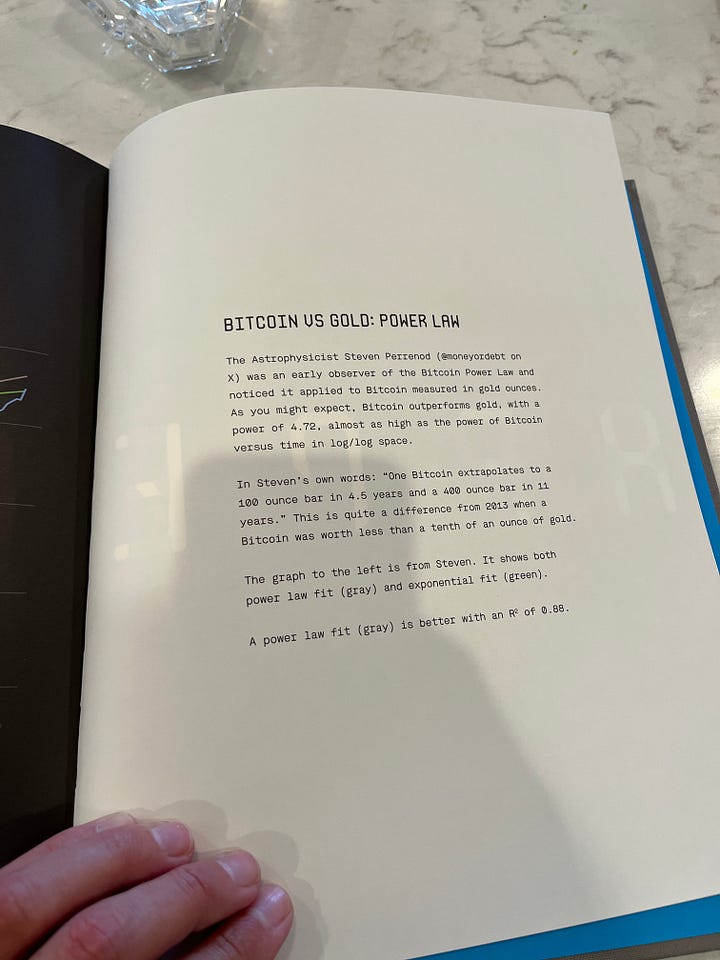
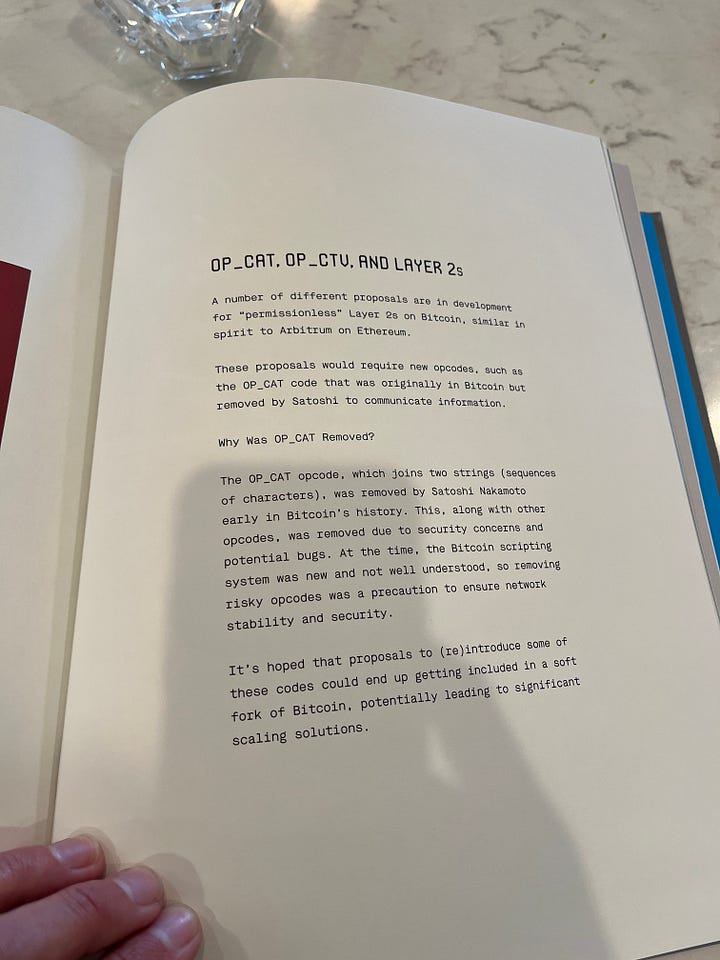
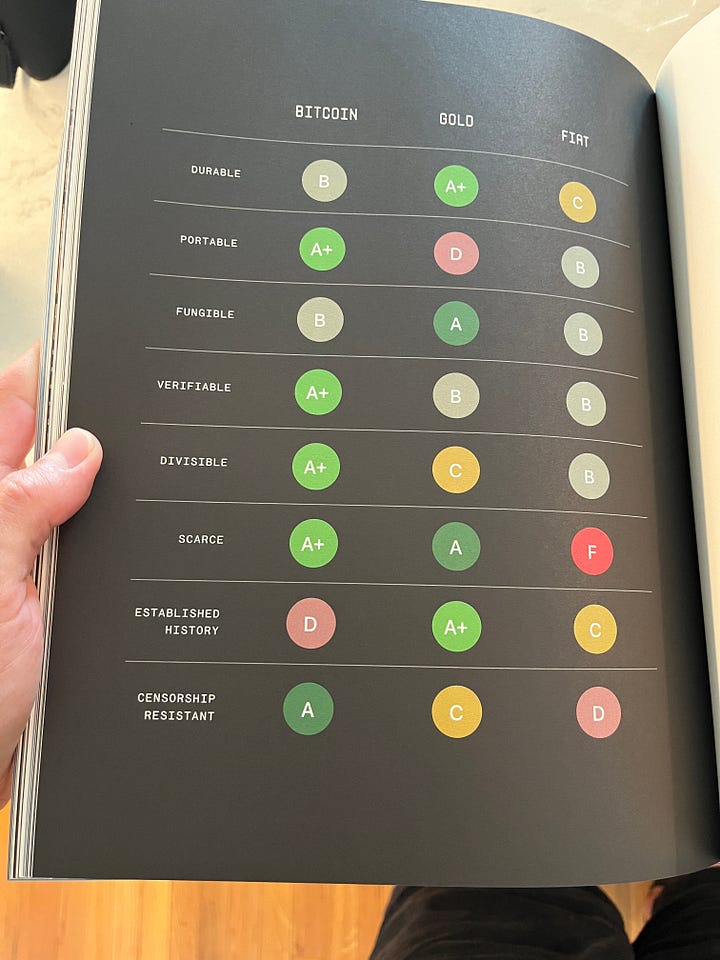
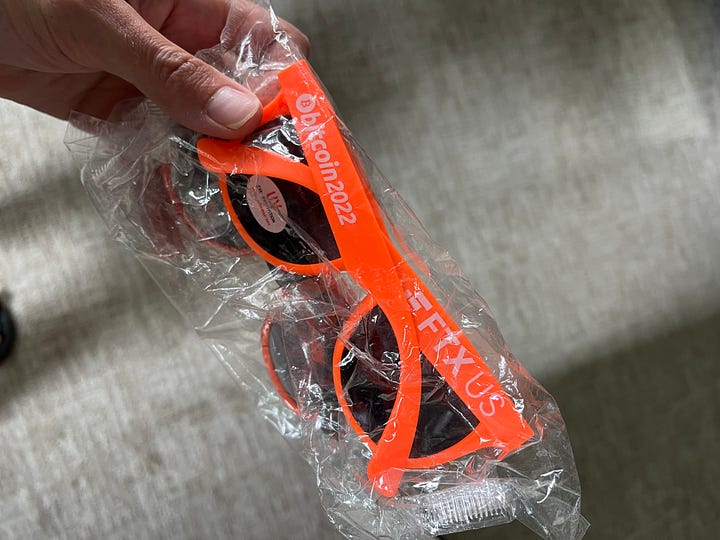
We headed upstairs to work on setting up Sparrow Wallet on their Windows machine. I verified the software download first (which you should always do), then helped them create a new wallet using their Ledger Flex. They also had an older Ledger Nano X. The Flex setup was easy, but the Nano X gave us trouble. It turns out Ledger allows multiple wallets for the same asset, which can show up differently depending on how they’re configured. In Sparrow, only one wallet showed—none of the others.
I believe it had to do with the derivation path from the Ledger. If anyone knows a fix, let me know.
After a few hours of troubleshooting, I told them I couldn’t really recommend Ledger. The UX is a mess. They’d already heard similar things from other plebs too.
I suggested switching to the Blockstream Jade. It’s a solid Bitcoin-only device from a trustworthy team. That’s what you want in a hardware wallet.
But back to the lens…
Since it’s an LTM (Leica Thread Mount), I couldn’t mount it directly on my M262. Luckily, I remembered I had an Urth adapter that fits my Fujifilm X-Pro2. I don’t use the X-Pro2 much these days—it’s mostly been sidelined by the M262 - but this was the perfect excuse to bring it out again.
To test the lens, I shot everything wide open at f/2.8. Nothing crazy fast, but it’s the best way to see a lens’s character. And this one definitely has character. There’s a subtle softness and a kind of motion blur effect around the edges when wide open. At first, I wasn’t sure how I felt about it, but the more I shot, the more I liked it. It reminds me of Winogrand’s work in Winogrand Color - those messy, shifting edges that make the frame feel alive. It also helps soften the digital-ness of the camera sensor.
The focus throw is short and snappy - much tighter than my Summicron V3 35mm f/2. I really like how fast it is to use. The closest focusing distance is about 3.5 feet, so it’s not ideal for close-ups. And with the Urth adapter on the X-Pro2, the focal length ends up closer to 40mm.
The only thing that threw me off was the infinity lock. When the focus hits infinity, it physically locks - you have to press a small tab to unlock it. I’ve seen others complain about it, so I guess it’s just one of those old lens quirks. I’m getting used to it.
All the photos here were taken around where I live in South Carolina. Some during bike rides to the river for a swim, others while walking through the marshlands.
I try to make work wherever I am. You should be able to.
It’s about the light, the rhythm, the play - and having the motivation to actually go out and shoot.
Lens rating: 7.9/10
I mainly shoot with a Leica M262, and edit in Lightroom + Dehancer
Use “PictureRoom” for 10% off Dehancer Film
If you’ve made it this far, thank you for taking the time to view my work - consider becoming a paid subscriber.
Also, please contact me if you would like to purchase any of my prints.
Follow me on Nostr:
npub1c8n9qhqzm2x3kzjm84kmdcvm96ezmn257r5xxphv3gsnjq4nz4lqelne96
-
 @ eb0157af:77ab6c55
2025-05-29 10:01:12
@ eb0157af:77ab6c55
2025-05-29 10:01:12The Pakistani government embraces Bitcoin, following the example set by the United States.
Pakistan has officially announced the creation of a strategic Bitcoin reserve. The announcement was made during the Bitcoin 2025 conference in Las Vegas, marking a significant shift from the government’s previous stance against digital assets.
During the event, Bilal Bin Saqib, head of the Pakistani Crypto Council, shared the country’s decision:
“Today, I announce the Pakistani government is setting up its own government-led Bitcoin Strategic Reserve, and we want to thank the United States of America again because we were inspired by them.”
Bin Saqib then added:
“This wallet, the national Bitcoin wallet, is not for speculation. We will be holding these bitcoins and we will never, ever sell them.”
It remains unclear how the bitcoins will be acquired, whether through direct purchases or other means.
Pakistan’s shift in approach toward digital assets traces back to last February, when the government first explored the idea of creating a National Crypto Council. This body was designed to oversee the development of a comprehensive regulatory framework for cryptocurrencies and to attract foreign investment in the sector.
The Council’s proposed initiatives included projects such as utilizing surplus energy for Bitcoin mining, building high-performance data centers, and accumulating Bitcoin for the national treasury.
Just a few days ago, the Council officially allocated 2,000 megawatts of surplus energy to support mining operations and AI data centers.
Moreover, Changpeng Zhao, co-founder of Binance, was appointed as an advisor to the Council in April, offering expertise on crypto regulations, blockchain infrastructure, and the adoption of digital assets.
To further consolidate this new approach, the Pakistani Ministry of Finance has commissioned the creation of the Digital Asset Authority, an agency dedicated to supervising digital asset regulations and issuing licenses for crypto service providers operating within the country.
The post Pakistan announces the creation of a strategic Bitcoin reserve appeared first on Atlas21.
-
 @ 005bc4de:ef11e1a2
2025-05-28 16:24:41
@ 005bc4de:ef11e1a2
2025-05-28 16:24:41
Two days ago I put this out: https://peakd.com/hive-124838/@crrdlx/hostr-snaps-9i13ooa7ufp
 Post: https://peakd.com/hive-124838/@crrdlx/hostr-snaps-9i13ooa7ufp
Post: https://peakd.com/hive-124838/@crrdlx/hostr-snaps-9i13ooa7ufpOne of the comments said it "...looks like some sort of game as well." That was enough to tickle my curiosity and get me thinking. The round tomatoes and how they nestled into the grooves of the tiles reminded me of Chinese checkers. The grid brought Hex to mind (the game John Nash played) and I wondered if a square-grid version might be viable. A little searching revealed Hex is a "Connection game" and there are several. The one called Tak seemed really interesting and simple. I like interesting and I really like simple.
So, a square grid connection game wouldn't be new, however, you can't play Tak with tomatoes. Tak requires stacking "stones" or standing them on edge, that would be very, very tricky with tomatoes.
I looked around and happened to have some dried corn kernels and dry beans. I drew out a 5 x 5 grid of dots, lined up five corn kernels on one side in a "home row" and 5 beans on the other. We used to play a game where two sides of Army men met after a series of moves. In that game, we rolled dice to have a "combat" and see who would win the little battle. I wanted something like that in my game, some type of combat or conquest, somehow. So, I started messing around, moving kernels and beans, and totally just set out to make this game up on the fly. This is what I got...
Rules
The objective, like Hex or Tak, is to connect one side (your home row) to your opponent's side. The connection to the other side can be a straight line, or it CAN include a diagonal road. Any of the roads below would be a win for team bean (B).
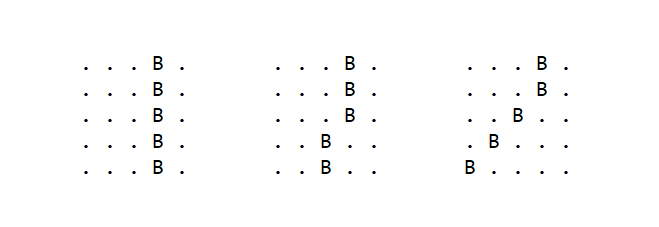
- One side makes a move by sliding one corn/bean one spot forward.
- Then, take turns making moves.
- Movement can only be one spot forward/back or sideways (NSEW). You cannot move diagonally.
- Opponents CAN occupy, or "squat", on the same spot at once. If so, the spot is being "co-squatted" (they're like two people standing in the same sidewalk tile at the same time).
- However, while opponents occupy the same spot, a "combat" might ensue. A corn/bean can "attack" by moving yet another adjoining corn or bean onto the co-squatted spot. A conquest is made by outnumbering a spot 2-to-1. For instance, if a spot is being occupied by both a bean and corn, and then a second corn moves in, the two corns conquer the one bean. The bean is immediately removed. The bean player then places that conquered bean into any empty spot on his or her home row. That placement constitutes the bean player's turn. So, after the bean is placed on the home row, the corn player makes the next move.
- Play continues until someone completes a road from their home row across to their opponent's home row. (Again, a diagonal road is okay for the win.)
- The losing player got Succotashed.
Game name
As to the name, initially I wanted a tomato-ish name. But, I was using corn and beans. So, I'm naming this game "Succotash" after the corn, bean, and vegetable recipe. I considered calling it the "Texas Caviar Game" because it has tomatoes in it, but playing Succotash just sounds better. Plus, putting tomatoes in succotash sounds yummy.
Simple
A big goal here was to keep it simple. To that end, all that's needed is (a) a paper with a 5 x 5 grid drawn on it, and, (b) 5 pieces of something and 5 pieces of something else. Obviously I used corn kernels and beans, but it could easily be shells/legos, pennies/paperclips, nuts/stones, or whatever.
Initially, I had a "storehouse" of extra corn kernels and storehouse of extra beans (seen in the images). My thinking was that they would replace the corn or beans that get conquered by opponents. Upon playing the game, it was apparent that a storehouse is totally unnecessary. Once captured, the same corn/bean can just be the one that's placed back onto the home row. Five of each is fine.
Also, I'm sure the grid could easily be expanded to whatever size you wish. I played an opponent with the 5 x 5 grid, and that seemed a good size for a five minute or so game.
Why not sit down face-to-face with someone for a minute and give Succotash a try? If you do, I'd love to hear how it went.

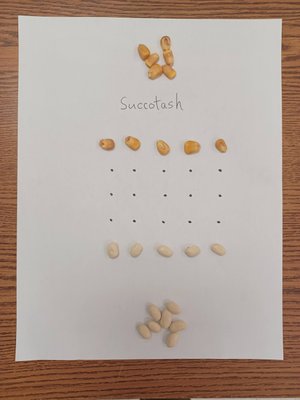
-
 @ 26769dac:498e333b
2025-05-28 18:56:30
@ 26769dac:498e333b
2025-05-28 18:56:30I am here too\ In the same space like you
In the same situation I'm in\ It's a matter of positioning
I cannot leave this place I'm in\ It was brought about\ By what's been happening
So please don't look at me\ For what I can or cannot do for you\ But look at what is happening for me\ And what is happening for you
Let's communicate\ Not orchestrate
Because there's something I wish to do\ And there's a place I wish to go to
And I'm sure that there is too\ In your heart a fire\ Known by only you
So let us listen, look and see\ For what's true for you\ And what's true for me
That we may act upon what's here\ In order for us both to take a step\ In the direction we wish to steer


























